With the Galaxy Note 20 launch just a week away, all eyes will be on what upgrades Samsung brings to the table. While the chipset might remain unchanged, there might be a silver lining. While Samsung flagship like the Note series and the S series are powered by Snapdragon chipsets in the US and European markets, they come with Exynos chipset in Asian markets such as India. It often tends to lose out on the performance front against Qualcomm Snapdragon counterparts. However, a new leak suggests some good news in this regard. Samsung Galaxy Note 20 release date, price, news and leaks Upcoming smartphones in India: Specs, launch date, price (Image credit: Samsung/WinFuture) According to a tweet by Anthony, a Youtuber, Samsung Galaxy Note 20 will continue to be powered by the Exynos 990 chipset, but with major improvements in terms of the performance and efficiency. These optimizations should bring it closer to the Snapdragon 865 series. He even suggested that it is almost li...
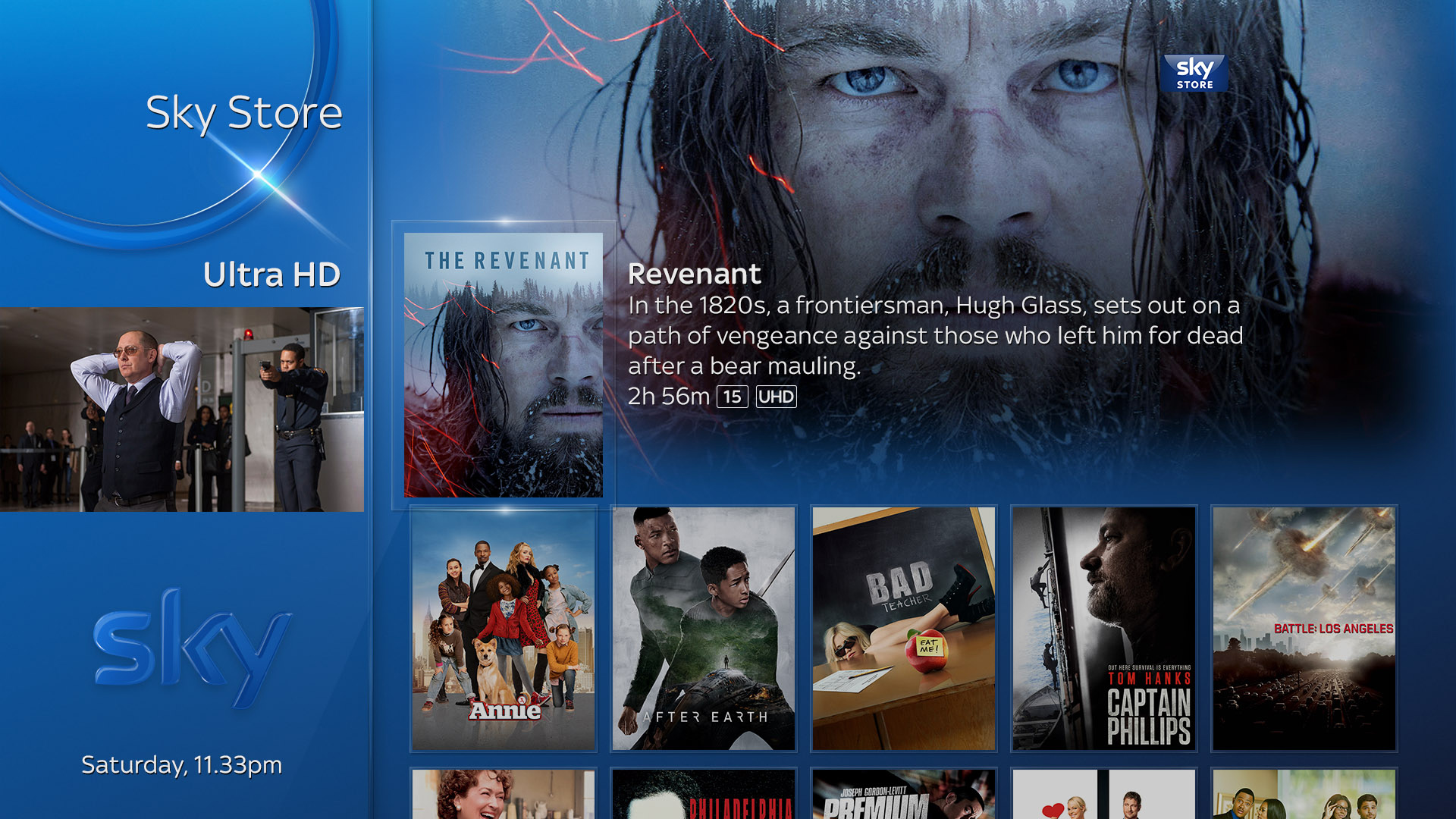
The best Sky Q 4K movies and TV to watch
You’ve got the 4K TV, you’ve coughed up for a Sky Q UHD-ready premium set-top box, and now you’re looking for something great to show off all those pixels with.
Great news! If you’ve signed up for Sky’s 2TB Sky Q box with a Sky Q multiscreen subscription, you’re good to go, getting access to the suite of 4K films and TV shows Sky is currently curating. It’s usually a £34 a month deal (including rental of the box), but is currently down to £32 a month.
There’s a growing selection of top-notch films on the service, with the library growing all the time, and Sky pumping more and more money into presenting its own original programming in 4K too. Note you’ll have to download 4K content in advance of watching it, rather than streaming it – so if you’ve got a slower broadband connection, you may want to get some of these downloading well in advance of settling down to watch them. Depending on the film and length, they can be many gigabytes in size.
So, without further ado, let’s kick off with the best 4K films on Sky Q right now. Click through for a few quick TV show selections, too.
What a surprisingly-excellent sequel this was! Where the first film took the found-footage genre to new sci-fi fuelled heights, 10 Cloverfield Lane dials it right back for a laser-focused thriller, set in an emergency bunker. John Goodman is frighteningly good as the bunker’s oppressive overseer, fearing an unknown outside danger. You’ll be biting your nails throughout, with every micro-expression revealed in 4K.
Steven Spielberg takes on the heart-wrenching tale of the slave ship La Amistad in this historical drama from 1997. Following a revolt by the slaves in 1839, a group of Mende tribesmen took control of the ship of their captors, before being recaptured and facing trial at the Supreme Court in 1841. An all-star cast, including Anthony Hopkins, Morgan Freeman and a young Matthew McConaughey give the subject matter the gravitas it deserves, with the painstakingly recreated historical setting looking great in 4K.
A superhero film with dick jokes. Give the people what they wanted, Deadpool certainly did. While it’s perhaps not as refined as the finest of the Marvel flicks (it’s a Fox production) it’s certainly one of the funnier, in a toilet-humor sort of way. The first full length flick centered on the ‘Merc with the mouth’, it’s a gory, zany action flick, with showstopping set pieces to really show your UHD TV off with.
You can’t handle the truth! Or the amount of pixels this 4K remaster of the 1992 courtroom drama is going to push into your eyeballs. Jack Nicholson is on top form making even the always-great-if-an-easy-target-for-ridicule Tom Cruise pale in comparison. It’s a solid 4K overhaul, too (even if a courtroom isn’t the most visually-arresting of settings).
It’s as cheesy as a mouse’s bank vault, but there’s still something heart-warming about Tom Hanks as the loveable, simple, straight talking man ambling his way from one life-changing adventure to another. Pure popcorn fodder, the era-spanning scenes make for a lovely 4K watch.
It was unfairly boycotted by some more closed-minded corners of the internet, but the all-female reboot of the Ghostbusters franchise wasn’t half bad. What it lacked in belly-laugh concentration it made up for with heart, spruced-up special effects and the always-excellent Kristen Wiig. The furore around the casting overshadowed the film sadly, and it’d be good to see the franchise one day continue. For now though, this colorful comedy horror makes a great showcase subject for Sky Q’s 4K abilities.
Francis Ford Coppola’s mafia trilogy, often imitated, never bettered. Except for maybe that third film, which is a bit of a mess to be honest. But forget that! The first two films in the Corleone saga are fantastic, showing how trust and family bonds can be built and broken over the course of a life in crime. A solid 4K remastering lets the films shine like the day they were first screened.
If you’ve never seen a Sergio Leone ‘Spaghetti’ western, then you’ve never really ever seen a western. Harsh, brooding and uncompromising, he brought the grit and the sweat to a genre that had never previously cared about the dubious morality of of the old West. The Good, the Bad and the Ugly, starring Clint Eastwood, is a re-imagining of the Kurosawa classic Yojimbo, with a wandering stranger dangerously playing two rival families off each other for financial gain. It’s a striking film (Leone being the master of the super-close-up) and is a great showcase for your Sky Q box.
One of the finest comedies of all time, Groundhog Day is one of the finest comedies of all time. One of the finest comedies of all time, Groundhog Day sees Bill Murray forced to live the same day over and over again in a quest to live the perfect 24 hours in what’s one of the finest comedies of all time. It looks great in 4K, and is one of the finest comedies of all time.
Show me the money! Or the 4K pixels, whatever is easiest. Perhaps the defining Tom Cruise film? It’s either this or Top Gun, but Jerry Maguire shows him at the height of his Hollywood star power. Starring a the eponymous sports agent struggling to make it on his own, it’s a bit of a schmaltzy romance by the end, if an eminently quotable one. A great 4K feel-good flick.
One of the all-time greats, and one of the films that everyone should see at least once in their lifetimes. Ideally, you’d watch it first on the biggest, most luxurious cinema screen you can to get the full epic experience. But a giant 4K screen will make a great alternative. Mind-bogglingly ambitious, beautiful to watch and featuring a career-best performance from Peter O’Toole it’s a masterpiece, expertly telling of T.E Lawrence’s time in the Arabian peninsula during World War I.
It defined the look of the future for a generation, and is a tentpole of modern sci-fi. And, thanks to some clever direction from Steven Spielberg, its visual effects hold up well under the added scrutiny of 4K pixel pushing. It’s a great thriller too, with future cop Tom Cruise on the run for a predicted crime he didn’t commit – and that hasn’t been committed yet.
Like baseball? Love spreadsheets? Then you’re going to adore Moneyball. Brad Pitt takes a struggling team to the top of the table with a little help from algorithm whizz Jonah Hill, crunching the numbers to find baseball’s most undervalued players. It revolutionised sports management, and makes for a pretty compelling (Oscar-winning) movie, too. It looks crisp in 4K, even if it’s not a visual dazzler full of UHD show-stopping set pieces. Other than Brad Pitt’s lovely face, of course.
What’s it take to win an Oscar? If you’re Leonardo DiCaprio, you need to grow a beard, crawl through a frozen wilderness, dribble a bit and eat raw offal. You can’t say he didn’t earn it! It’s a visceral performance, but far from the best thing about The Revenant – it’s beautifully shot, with the early frontiersman days of the United States brought to life with shocking, realism and sweeping landscapes. It looks phenomenal in 4K.
The franchise devolved into meaningless action-tripe after this first film (and don’t get us started on the remake) but the first RoboCop juggles many, many tonal plates gleefully. Horrifically, satirically violent, the story of a brutalised cop reborn as a cybernetic crime fighter is both a great action film and sharp social satire that holds up surprisingly well today.
The ultimate sports film? It’s certainly the king of the training montage. Stallone wrote and starred in this modern fable of the down-on-his luck boxer fighting to be a big-time contender and, along with First Blood, remains the highlight of his career. If you don’t want to go out and tackle your nearest flight of steps at full speed after watching it then, well, you probably need to check your pulse instead.
As harrowing a thriller as there’s ever been, The Silence of the Lambs is a stone-cold classic. Jodie Foster’s is brilliant as an inexperienced, go-getting FBI agent on the hunt for a murderous kidnapper, while Anthony Hopkins - even though he only get 16 minutes’ screen time - gives perhaps his most affecting performance in a storied career as cannibal killer Hannibal Lecter. It’s a tense nail-biter, and you may prefer to watch through your fingers than in the crystal clear glory of a 4K presentation.
Forget Homecoming – Sam Raimi’s Spider-Man films are still the best realisation of the web-slinger. Well, so long as you forget the third one, and that was a mess because of studio intervention.
I digress.
Peter Parker’s first-fully realised wall-crawling adventure, despite some ageing CGI, still looks great today. Tobey Maguire gives ol’ Spidey lots of heart, Willem Dafoe chews up the scenery as the Green Goblin, and Raimi directs with a true love (and understanding) of what makes comic book heroes so wonderful and inspiring.
Before he got his hands on the Star Wars franchise, JJ Abrams gave Star Trek a makeover by...essentially turning it into Star Wars. It divided some purists, but the Abrams reboot was inarguably a riotously fun affair. Playing into the franchise lore while still bringing its own modern sensibilities to the table, the bickering crew of the Enterprise are shown out on their maiden voyage of discovery. It looks great, and even JJ’s signature, overused lens flare is more palatable in 4K.
It’s not just movies being pushed out in 4K by Sky these days. Its original programming is also getting an Ultra HD revamp, with its big-budget Sky Atlantic shows regularly being broadcast in 4K now. It’s a small selection for the time being, but expect it to grow over time. Up next is the best of the bunch.
It sounds like an awful idea for a show, sending two comics on a road trip around Spain, focussing on their elaborate meals. But The Trip to… series, pitting the wits of Steve Coogan and Rob Brydon against each other as they attempt ever-more outlandish celebrity interviews is a hilarious watch, absolutely nailing the faux-autobiographical style seen elsewhere in Curb Your Enthusiasm. The beautiful Spanish landscape shines in 4K – you’ll be jealous that you’re not holidaying alongside them.
This is a fantastically weird show from Italian auteur Paolo Sorrentino. Wonderfully shot, Jude Law plays the titular ‘young Pope’, bringing drastic changes to the top level of the Catholic church while hiding skeletons in his own closet.
Sky’s latest big release sees a tragically driven cop (Tim Roth) take on the growing criminal presence in a rockie mountain town. It’s a gritty, hard-boiled thriller, and well worth a look if you’re after a meaty 4K TV drama.
Finally, if you're a sports fan, Sky is increasingly making sure that its Sky Sports output is broadcast in 4K.
If you pick up a compatible channel package, you'll be able to watch Premier League football, Formula 1 racing, cricket and more in the top-notch full 4K resolution that Sky Q offers.
Great news! If you’ve signed up for Sky’s 2TB Sky Q box with a Sky Q multiscreen subscription, you’re good to go, getting access to the suite of 4K films and TV shows Sky is currently curating. It’s usually a £34 a month deal (including rental of the box), but is currently down to £32 a month.
There’s a growing selection of top-notch films on the service, with the library growing all the time, and Sky pumping more and more money into presenting its own original programming in 4K too. Note you’ll have to download 4K content in advance of watching it, rather than streaming it – so if you’ve got a slower broadband connection, you may want to get some of these downloading well in advance of settling down to watch them. Depending on the film and length, they can be many gigabytes in size.
So, without further ado, let’s kick off with the best 4K films on Sky Q right now. Click through for a few quick TV show selections, too.
What a surprisingly-excellent sequel this was! Where the first film took the found-footage genre to new sci-fi fuelled heights, 10 Cloverfield Lane dials it right back for a laser-focused thriller, set in an emergency bunker. John Goodman is frighteningly good as the bunker’s oppressive overseer, fearing an unknown outside danger. You’ll be biting your nails throughout, with every micro-expression revealed in 4K.
Steven Spielberg takes on the heart-wrenching tale of the slave ship La Amistad in this historical drama from 1997. Following a revolt by the slaves in 1839, a group of Mende tribesmen took control of the ship of their captors, before being recaptured and facing trial at the Supreme Court in 1841. An all-star cast, including Anthony Hopkins, Morgan Freeman and a young Matthew McConaughey give the subject matter the gravitas it deserves, with the painstakingly recreated historical setting looking great in 4K.
A superhero film with dick jokes. Give the people what they wanted, Deadpool certainly did. While it’s perhaps not as refined as the finest of the Marvel flicks (it’s a Fox production) it’s certainly one of the funnier, in a toilet-humor sort of way. The first full length flick centered on the ‘Merc with the mouth’, it’s a gory, zany action flick, with showstopping set pieces to really show your UHD TV off with.
You can’t handle the truth! Or the amount of pixels this 4K remaster of the 1992 courtroom drama is going to push into your eyeballs. Jack Nicholson is on top form making even the always-great-if-an-easy-target-for-ridicule Tom Cruise pale in comparison. It’s a solid 4K overhaul, too (even if a courtroom isn’t the most visually-arresting of settings).
It’s as cheesy as a mouse’s bank vault, but there’s still something heart-warming about Tom Hanks as the loveable, simple, straight talking man ambling his way from one life-changing adventure to another. Pure popcorn fodder, the era-spanning scenes make for a lovely 4K watch.
It was unfairly boycotted by some more closed-minded corners of the internet, but the all-female reboot of the Ghostbusters franchise wasn’t half bad. What it lacked in belly-laugh concentration it made up for with heart, spruced-up special effects and the always-excellent Kristen Wiig. The furore around the casting overshadowed the film sadly, and it’d be good to see the franchise one day continue. For now though, this colorful comedy horror makes a great showcase subject for Sky Q’s 4K abilities.
Francis Ford Coppola’s mafia trilogy, often imitated, never bettered. Except for maybe that third film, which is a bit of a mess to be honest. But forget that! The first two films in the Corleone saga are fantastic, showing how trust and family bonds can be built and broken over the course of a life in crime. A solid 4K remastering lets the films shine like the day they were first screened.
If you’ve never seen a Sergio Leone ‘Spaghetti’ western, then you’ve never really ever seen a western. Harsh, brooding and uncompromising, he brought the grit and the sweat to a genre that had never previously cared about the dubious morality of of the old West. The Good, the Bad and the Ugly, starring Clint Eastwood, is a re-imagining of the Kurosawa classic Yojimbo, with a wandering stranger dangerously playing two rival families off each other for financial gain. It’s a striking film (Leone being the master of the super-close-up) and is a great showcase for your Sky Q box.
One of the finest comedies of all time, Groundhog Day is one of the finest comedies of all time. One of the finest comedies of all time, Groundhog Day sees Bill Murray forced to live the same day over and over again in a quest to live the perfect 24 hours in what’s one of the finest comedies of all time. It looks great in 4K, and is one of the finest comedies of all time.
Show me the money! Or the 4K pixels, whatever is easiest. Perhaps the defining Tom Cruise film? It’s either this or Top Gun, but Jerry Maguire shows him at the height of his Hollywood star power. Starring a the eponymous sports agent struggling to make it on his own, it’s a bit of a schmaltzy romance by the end, if an eminently quotable one. A great 4K feel-good flick.
One of the all-time greats, and one of the films that everyone should see at least once in their lifetimes. Ideally, you’d watch it first on the biggest, most luxurious cinema screen you can to get the full epic experience. But a giant 4K screen will make a great alternative. Mind-bogglingly ambitious, beautiful to watch and featuring a career-best performance from Peter O’Toole it’s a masterpiece, expertly telling of T.E Lawrence’s time in the Arabian peninsula during World War I.
It defined the look of the future for a generation, and is a tentpole of modern sci-fi. And, thanks to some clever direction from Steven Spielberg, its visual effects hold up well under the added scrutiny of 4K pixel pushing. It’s a great thriller too, with future cop Tom Cruise on the run for a predicted crime he didn’t commit – and that hasn’t been committed yet.
Like baseball? Love spreadsheets? Then you’re going to adore Moneyball. Brad Pitt takes a struggling team to the top of the table with a little help from algorithm whizz Jonah Hill, crunching the numbers to find baseball’s most undervalued players. It revolutionised sports management, and makes for a pretty compelling (Oscar-winning) movie, too. It looks crisp in 4K, even if it’s not a visual dazzler full of UHD show-stopping set pieces. Other than Brad Pitt’s lovely face, of course.
What’s it take to win an Oscar? If you’re Leonardo DiCaprio, you need to grow a beard, crawl through a frozen wilderness, dribble a bit and eat raw offal. You can’t say he didn’t earn it! It’s a visceral performance, but far from the best thing about The Revenant – it’s beautifully shot, with the early frontiersman days of the United States brought to life with shocking, realism and sweeping landscapes. It looks phenomenal in 4K.
The franchise devolved into meaningless action-tripe after this first film (and don’t get us started on the remake) but the first RoboCop juggles many, many tonal plates gleefully. Horrifically, satirically violent, the story of a brutalised cop reborn as a cybernetic crime fighter is both a great action film and sharp social satire that holds up surprisingly well today.
The ultimate sports film? It’s certainly the king of the training montage. Stallone wrote and starred in this modern fable of the down-on-his luck boxer fighting to be a big-time contender and, along with First Blood, remains the highlight of his career. If you don’t want to go out and tackle your nearest flight of steps at full speed after watching it then, well, you probably need to check your pulse instead.
As harrowing a thriller as there’s ever been, The Silence of the Lambs is a stone-cold classic. Jodie Foster’s is brilliant as an inexperienced, go-getting FBI agent on the hunt for a murderous kidnapper, while Anthony Hopkins - even though he only get 16 minutes’ screen time - gives perhaps his most affecting performance in a storied career as cannibal killer Hannibal Lecter. It’s a tense nail-biter, and you may prefer to watch through your fingers than in the crystal clear glory of a 4K presentation.
Forget Homecoming – Sam Raimi’s Spider-Man films are still the best realisation of the web-slinger. Well, so long as you forget the third one, and that was a mess because of studio intervention.
I digress.
Peter Parker’s first-fully realised wall-crawling adventure, despite some ageing CGI, still looks great today. Tobey Maguire gives ol’ Spidey lots of heart, Willem Dafoe chews up the scenery as the Green Goblin, and Raimi directs with a true love (and understanding) of what makes comic book heroes so wonderful and inspiring.
Before he got his hands on the Star Wars franchise, JJ Abrams gave Star Trek a makeover by...essentially turning it into Star Wars. It divided some purists, but the Abrams reboot was inarguably a riotously fun affair. Playing into the franchise lore while still bringing its own modern sensibilities to the table, the bickering crew of the Enterprise are shown out on their maiden voyage of discovery. It looks great, and even JJ’s signature, overused lens flare is more palatable in 4K.
It’s not just movies being pushed out in 4K by Sky these days. Its original programming is also getting an Ultra HD revamp, with its big-budget Sky Atlantic shows regularly being broadcast in 4K now. It’s a small selection for the time being, but expect it to grow over time. Up next is the best of the bunch.
It sounds like an awful idea for a show, sending two comics on a road trip around Spain, focussing on their elaborate meals. But The Trip to… series, pitting the wits of Steve Coogan and Rob Brydon against each other as they attempt ever-more outlandish celebrity interviews is a hilarious watch, absolutely nailing the faux-autobiographical style seen elsewhere in Curb Your Enthusiasm. The beautiful Spanish landscape shines in 4K – you’ll be jealous that you’re not holidaying alongside them.
This is a fantastically weird show from Italian auteur Paolo Sorrentino. Wonderfully shot, Jude Law plays the titular ‘young Pope’, bringing drastic changes to the top level of the Catholic church while hiding skeletons in his own closet.
Sky’s latest big release sees a tragically driven cop (Tim Roth) take on the growing criminal presence in a rockie mountain town. It’s a gritty, hard-boiled thriller, and well worth a look if you’re after a meaty 4K TV drama.
Finally, if you're a sports fan, Sky is increasingly making sure that its Sky Sports output is broadcast in 4K.
If you pick up a compatible channel package, you'll be able to watch Premier League football, Formula 1 racing, cricket and more in the top-notch full 4K resolution that Sky Q offers.
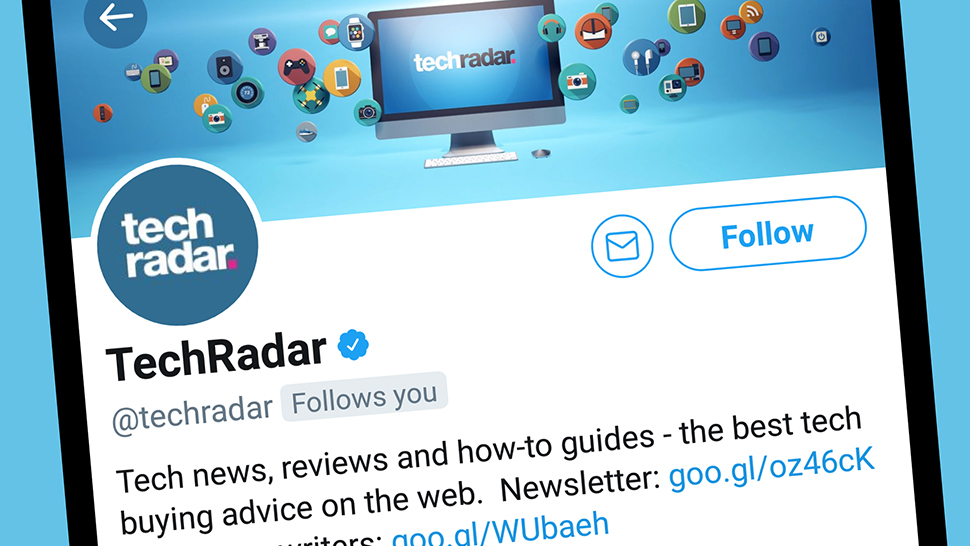
Twitter promises to get "more aggressive" in tackling online harassment
You don't usually have to wait too long for some kind of controversy to erupt on Twitter, and most of the time it revolves around the issues of abuse and harassment online - hence this week's #WomenBoycottTwitter protest.
Now Twitter CEO Jack Dorsey has taken to the online platform that he runs to tell users that "a more aggressive stance" is going to be taken in the future. While details are a little thin on the ground, he's promising more information next week.
"We see voices being silenced on Twitter every day," says Dorsey. "We've been working to counteract this for the past two years. We prioritized this in 2016. We updated our policies and increased the size of our teams. It wasn't enough."
Top priority
Twitter is often accused of a slow and haphazard response to hate speech, online abuse and persistent trolling, but Dorsey insists these issues continue to be the "top priority" for the Twitter team in 2017.
The new rules heading towards Twitter focus on "unwanted sexual advances, non-consensual nudity, hate symbols, violent groups, and tweets that glorify violence" according to Dorsey. The changes, whatever they happen to involve, are going to be rolling out in the next few weeks.
With Twitter so useful for everything from breaking news to tracking deals, let's hope the platform can sort out its persistent harassment and free speech issues and get back on track - even if it is becoming more like Facebook all the time.
Here's how to get a good laptop deal this Black Friday
Now Twitter CEO Jack Dorsey has taken to the online platform that he runs to tell users that "a more aggressive stance" is going to be taken in the future. While details are a little thin on the ground, he's promising more information next week.
"We see voices being silenced on Twitter every day," says Dorsey. "We've been working to counteract this for the past two years. We prioritized this in 2016. We updated our policies and increased the size of our teams. It wasn't enough."
Top priority
Twitter is often accused of a slow and haphazard response to hate speech, online abuse and persistent trolling, but Dorsey insists these issues continue to be the "top priority" for the Twitter team in 2017.
The new rules heading towards Twitter focus on "unwanted sexual advances, non-consensual nudity, hate symbols, violent groups, and tweets that glorify violence" according to Dorsey. The changes, whatever they happen to involve, are going to be rolling out in the next few weeks.
With Twitter so useful for everything from breaking news to tracking deals, let's hope the platform can sort out its persistent harassment and free speech issues and get back on track - even if it is becoming more like Facebook all the time.
Here's how to get a good laptop deal this Black Friday

Are VPN services legal?
It’s clear that VPNs are becoming increasingly popular at a rate of knots, so we figured maybe it was time to take a step back, and look at the legality of these services.
While VPNs have historically conjured up images of a hoodie-wearing hacker at the local coffee shop, evading authorities while on the move with his or her laptop, the truth is most VPN users do not fit this stereotype. In fact, VPNs are commonly employed for corporate use, allowing employees to access resources when away from the office (working from home springs to mind).
Whenever we use the internet, a digital trail of cookie crumbs is left behind. The ISP can certainly see and track a user online, and know which websites have been visited, or trace other internet activities.
There are some protective security measures in place, such as SSL, for occasions when a user visits a secure website and needs to enter their credit card or other financial information – in order to keep such sensitive data hidden from the ISP. However, generally speaking, using the internet without a VPN certainly leaves the user’s activities less than private, and indeed fairly public and exposed.
So it’s no wonder that so many folks are turning to the best VPN providers out there to keep their online activity hidden from their ISP (or other parties). A VPN service cloaks the user’s identity by sending encrypted data to another server first, one which is sometimes located outside the user’s home country, making it much more difficult to track and find the user.
Don’t forget there are 7 good reasons why a VPN isn't enough

Waving the ban stick
In fact, VPNs work so well that the services have caused a handful of countries to take a hard line against VPN usage.
The countries that ban VPN usage, with potential prison time for offenders, include:
BelarusChinaIraqOmanTurkeyUnited Arab Emirates
Additionally, the following countries restrict VPNs as part of overall internet censorship, and limit their availability to a short list of approved VPN services:
IranNorth KoreaRussiaTurkmenistan
Finally, Saudi Arabia is a special case, as using a VPN is legal, but authorities have blocked over 400,000 websites. Previously, Saudi Arabia had blocked VoIP services such as Skype and WhatsApp, which in turn supported the Saudi Arabian telecommunication firms’ traditionally high prices on phone calls.
This made it difficult for Saudis to communicate beyond the borders of their country – although some folks tried to get round the block using a VPN. However, that’s no longer necessary, because in a recent development last month, the VoIP ban was lifted as the new crown prince wishes to foster business in the country.
So, these exceptions aside, for those of us who live anywhere else, using a VPN is 100% completely legal. And with multiple governments across the globe becoming increasingly interested in tracking online activity, there has been a surge in demand for the security (data encryption) and privacy that a VPN provides.
A VPN is also useful to get around geographic restrictions (geo-blocking), and to avoid censorship, as well as generally promoting the free flow of ideas and information which is effectively the very heartbeat of the internet.
We’ve debunked 6 common myths concerning VPNs Criminal enterprise
What a VPN shouldn’t be used for is a licence to engage in criminal activity, not just from a moral standpoint, but also due to the fact that nobody is completely anonymous when online – even when using a VPN service.
Should you break the law while using a VPN, do not count on the provider maintaining your anonymity, because then the company would effectively become your ‘partner in crime’. As we saw only earlier this week, the FBI brought in a cyber-stalker with some of the evidence against the man provided by a VPN service.
Many VPN providers will declare that they keep ‘no logs’ at all on user activities, but the reality is that the vast majority will keep at least some kind of basic information (albeit very little), as this is often necessary for running aspects of the service like, for example, monitoring how many devices are connected (as VPNs often have limits in this respect).
The type of logs, and time period they are kept for, will vary a great deal from service to service, so it’s always a good idea to find a VPN firm’s privacy policy on the website (you might have to hunt for it), and read it carefully to see the exact details of any data which is logged.

For example, Hotspot Shield’s policy (a VPN run by AnchorFree) states that it will “protect ourselves or others from fraudulent, abusive, or unlawful uses or activity” (as shown in the above image).
While it isn’t hard to imagine the kind of illegal activities that would cause a VPN to turn over your data to the authorities, the list would certainly include:
Child pornographyFraudIllegal downloading and streamingHackingTheft
Engaging in any of these activities will (and should) attract the attention of the authorities. Checking the small print of a VPN will inevitably reveal that it will respond to lawful requests for information. In other words, if the company gets a subpeona from law enforcement, it will most certainly comply, as any business must abide by the laws of the country that it’s based in.

Privacy protection
However, always remember that some VPNs will protect your privacy better than others. One of the main things to look for here is when combing through the privacy policy, make sure that there’s a ‘no log’ policy which clearly states that no record of an individual user’s web history or activity is kept, so there can be nothing to hand over to any third-party in this respect.
Another strategy VPN providers use to promote anonymity is a shared IP address, meaning that several users all share a single IP address, so nobody can figure out which of the users went where online. Finally, when it comes to paying for these VPN services, while a credit card is convenient, it is hardly anonymous, so some services accept cryptocurrency (like Bitcoin) as payment – which gives you a far better level of anonymity.
Overall, with the exception of the handful of countries listed above, VPNs are totally legal. They are a useful tool that allows citizens to keep their online activity private, for students to connect to schools or university campuses online, and for businesses to maintain secure access to online services for remote-working staff members.
In short, VPNs are highly useful services when it comes to keeping the internet private, and surfing data away from the prying eyes of ISPs or governments.
Check out the best VPN services of 2017 and visit thebestvpnfor.me to get the best VPN deals on the market
While VPNs have historically conjured up images of a hoodie-wearing hacker at the local coffee shop, evading authorities while on the move with his or her laptop, the truth is most VPN users do not fit this stereotype. In fact, VPNs are commonly employed for corporate use, allowing employees to access resources when away from the office (working from home springs to mind).
Whenever we use the internet, a digital trail of cookie crumbs is left behind. The ISP can certainly see and track a user online, and know which websites have been visited, or trace other internet activities.
There are some protective security measures in place, such as SSL, for occasions when a user visits a secure website and needs to enter their credit card or other financial information – in order to keep such sensitive data hidden from the ISP. However, generally speaking, using the internet without a VPN certainly leaves the user’s activities less than private, and indeed fairly public and exposed.
So it’s no wonder that so many folks are turning to the best VPN providers out there to keep their online activity hidden from their ISP (or other parties). A VPN service cloaks the user’s identity by sending encrypted data to another server first, one which is sometimes located outside the user’s home country, making it much more difficult to track and find the user.
Don’t forget there are 7 good reasons why a VPN isn't enough

Waving the ban stick
In fact, VPNs work so well that the services have caused a handful of countries to take a hard line against VPN usage.
The countries that ban VPN usage, with potential prison time for offenders, include:
BelarusChinaIraqOmanTurkeyUnited Arab Emirates
Additionally, the following countries restrict VPNs as part of overall internet censorship, and limit their availability to a short list of approved VPN services:
IranNorth KoreaRussiaTurkmenistan
Finally, Saudi Arabia is a special case, as using a VPN is legal, but authorities have blocked over 400,000 websites. Previously, Saudi Arabia had blocked VoIP services such as Skype and WhatsApp, which in turn supported the Saudi Arabian telecommunication firms’ traditionally high prices on phone calls.
This made it difficult for Saudis to communicate beyond the borders of their country – although some folks tried to get round the block using a VPN. However, that’s no longer necessary, because in a recent development last month, the VoIP ban was lifted as the new crown prince wishes to foster business in the country.
So, these exceptions aside, for those of us who live anywhere else, using a VPN is 100% completely legal. And with multiple governments across the globe becoming increasingly interested in tracking online activity, there has been a surge in demand for the security (data encryption) and privacy that a VPN provides.
A VPN is also useful to get around geographic restrictions (geo-blocking), and to avoid censorship, as well as generally promoting the free flow of ideas and information which is effectively the very heartbeat of the internet.
We’ve debunked 6 common myths concerning VPNs Criminal enterprise
What a VPN shouldn’t be used for is a licence to engage in criminal activity, not just from a moral standpoint, but also due to the fact that nobody is completely anonymous when online – even when using a VPN service.
Should you break the law while using a VPN, do not count on the provider maintaining your anonymity, because then the company would effectively become your ‘partner in crime’. As we saw only earlier this week, the FBI brought in a cyber-stalker with some of the evidence against the man provided by a VPN service.
Many VPN providers will declare that they keep ‘no logs’ at all on user activities, but the reality is that the vast majority will keep at least some kind of basic information (albeit very little), as this is often necessary for running aspects of the service like, for example, monitoring how many devices are connected (as VPNs often have limits in this respect).
The type of logs, and time period they are kept for, will vary a great deal from service to service, so it’s always a good idea to find a VPN firm’s privacy policy on the website (you might have to hunt for it), and read it carefully to see the exact details of any data which is logged.

For example, Hotspot Shield’s policy (a VPN run by AnchorFree) states that it will “protect ourselves or others from fraudulent, abusive, or unlawful uses or activity” (as shown in the above image).
While it isn’t hard to imagine the kind of illegal activities that would cause a VPN to turn over your data to the authorities, the list would certainly include:
Child pornographyFraudIllegal downloading and streamingHackingTheft
Engaging in any of these activities will (and should) attract the attention of the authorities. Checking the small print of a VPN will inevitably reveal that it will respond to lawful requests for information. In other words, if the company gets a subpeona from law enforcement, it will most certainly comply, as any business must abide by the laws of the country that it’s based in.

Privacy protection
However, always remember that some VPNs will protect your privacy better than others. One of the main things to look for here is when combing through the privacy policy, make sure that there’s a ‘no log’ policy which clearly states that no record of an individual user’s web history or activity is kept, so there can be nothing to hand over to any third-party in this respect.
Another strategy VPN providers use to promote anonymity is a shared IP address, meaning that several users all share a single IP address, so nobody can figure out which of the users went where online. Finally, when it comes to paying for these VPN services, while a credit card is convenient, it is hardly anonymous, so some services accept cryptocurrency (like Bitcoin) as payment – which gives you a far better level of anonymity.
Overall, with the exception of the handful of countries listed above, VPNs are totally legal. They are a useful tool that allows citizens to keep their online activity private, for students to connect to schools or university campuses online, and for businesses to maintain secure access to online services for remote-working staff members.
In short, VPNs are highly useful services when it comes to keeping the internet private, and surfing data away from the prying eyes of ISPs or governments.
Check out the best VPN services of 2017 and visit thebestvpnfor.me to get the best VPN deals on the market
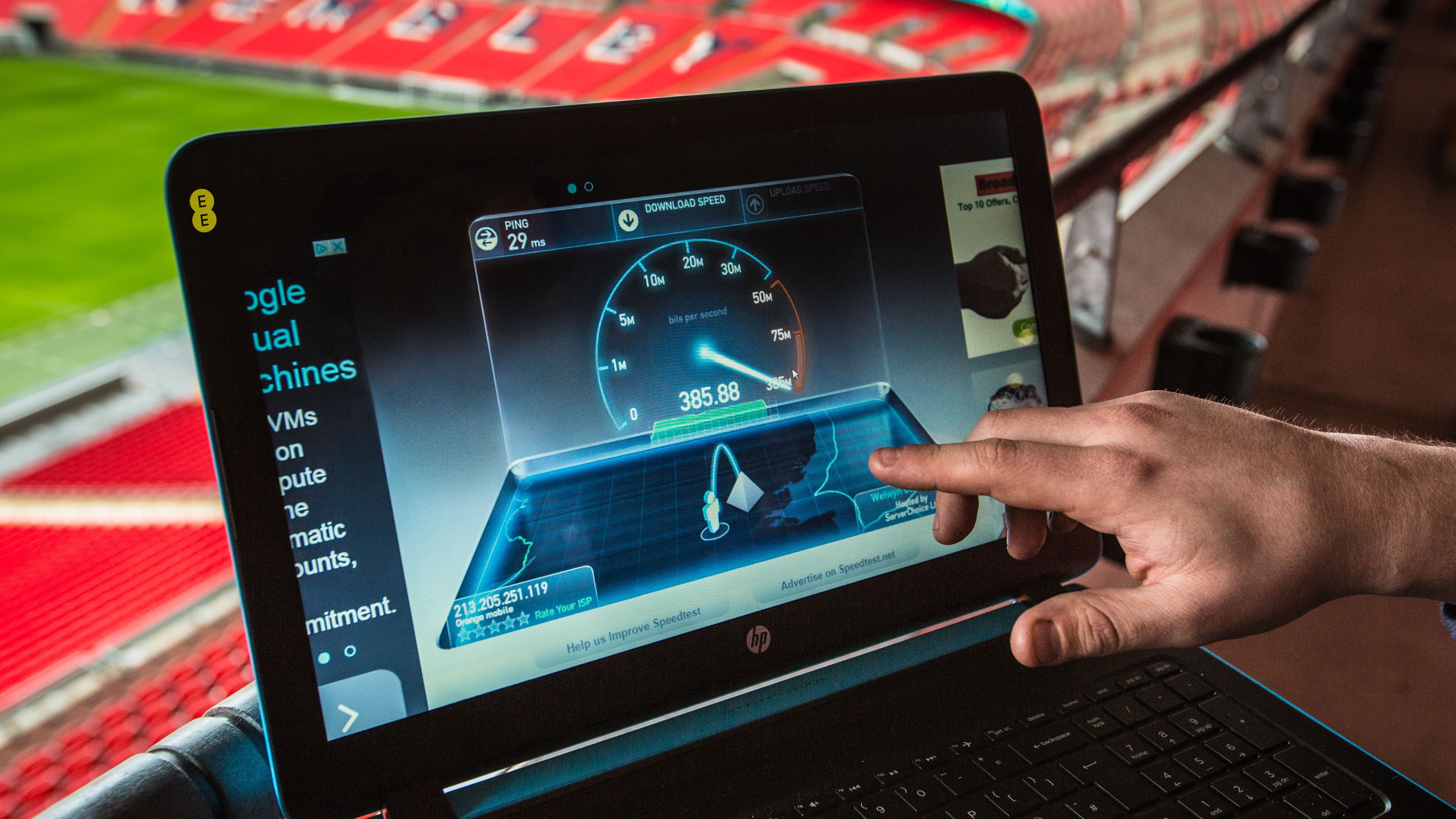
Thanks to Qualcomm® Snapdragon™, bad connectivity in crowds is set to become a thing of the past
Picture the scene: you are at your favourite football match, your team has just scored and you want to upload your thoughts, and some video, to social media.
But you can’t - not because you have lost your phone in all the excitement and cheering but because there are thousands of others trying to do the same thing, clogging up the network and slowing down connectivity to a speed akin to the dodgy defender who just let the goal in.
This is a familiar tale to anyone who has gone to a stadium in the last few years but that is all set to change thanks to Qualcomm Snapdragon and advancements in Gigabit LTE.
New technologies, such as the fantastic-sounding 4x4 MIMO, are making sure that a number of current handsets are getting the best out their connection, even when the network is beginning to buckle.
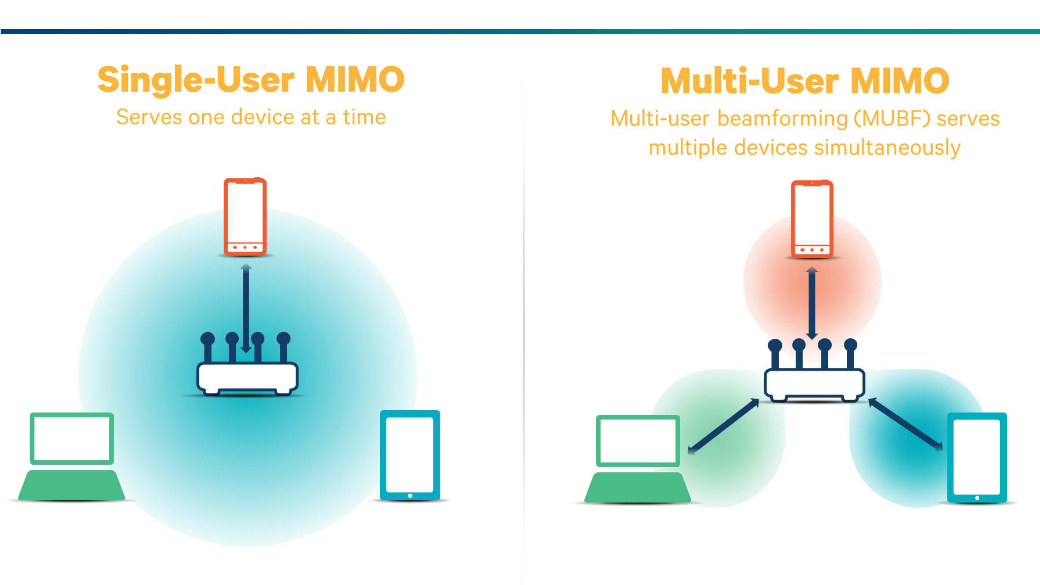
The idea behind 4x4 MIMO is actually quite a simple one, even if the technology behind it is brilliantly complex. In simplest terms, 4x4 MIMO (which stands for multiple input, multiple output) opens up more ‘lanes’ for your data to flow through allowing for quicker download and upload speeds.
4x4 MIMO technology allows for four independent spatial streams to be used by a compatible phone at once, speeding up data transfer.
The Samsung Galaxy S7 was the first 4x4 MIMO-enabled smartphones but since its release there have been a few more - including the Samsung Galaxy S8 range, the HTC U11, the Huawei P10 Plus and the Xperia XZ Premium.
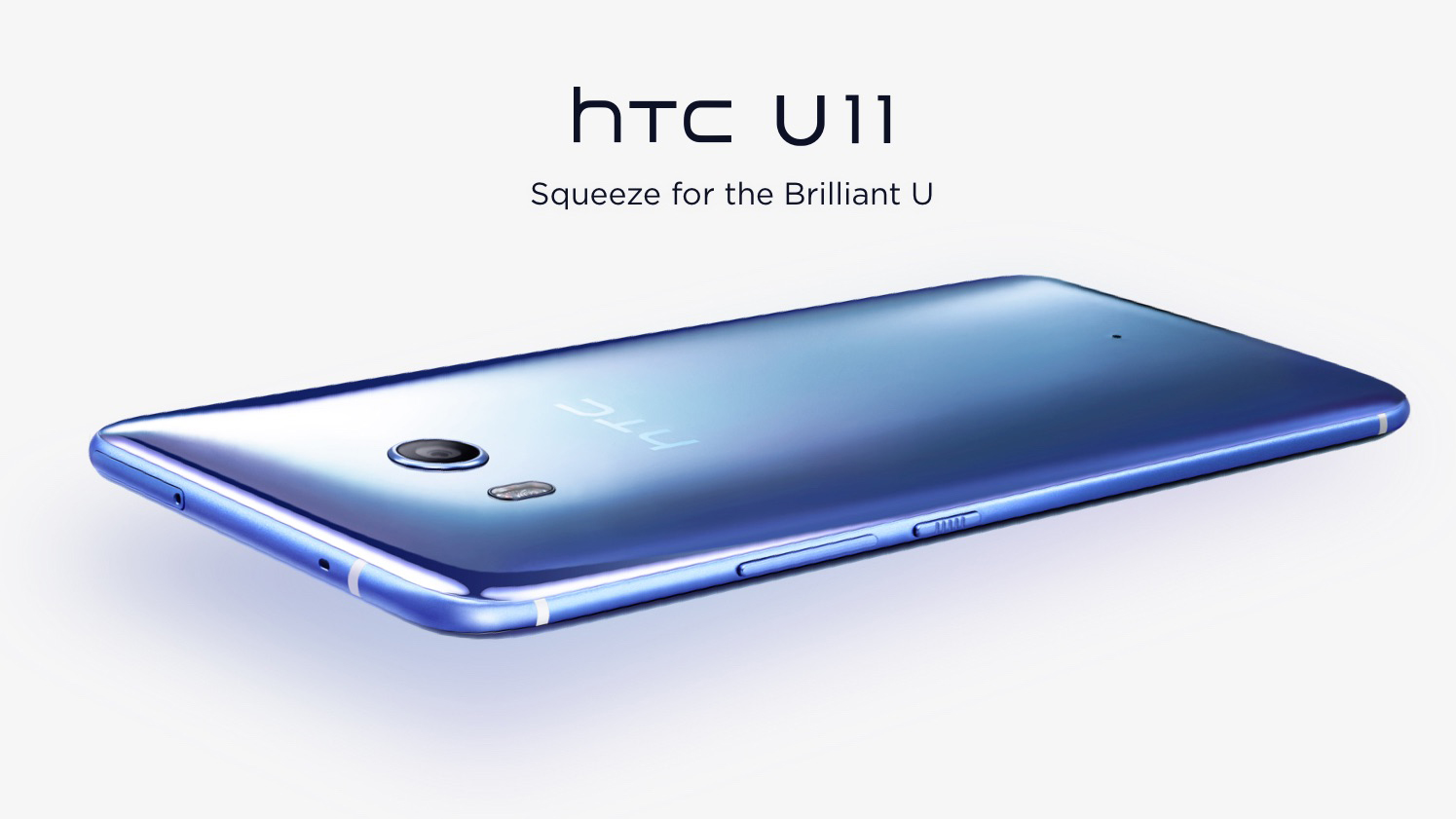
In fact, it was the XZ Premium that was used in a recent test at Wembley Stadium to try out Gigabit LTE speeds in a real-world situation and the results were jaw dropping. In conjunction with EE, and testing the might of Qualcomm® Snapdragon™ 835 Mobile Platform, they managed to demonstrate live upload speeds of 110Mbps and download speeds of 750Mbps.
To put that into context: that’s twice as fast as the fastest broadband provider in the UK.
These speeds may seem ridiculously fast for use in a stadium but the technology is needed to withstand what the future holds. We may currently be trying to upload the odd picture to Facebook, but our phones are now much more capable of that.
We have the ability to shoot 4K footage in HDR so why shouldn’t we have the ability to film what’s going on in a stadium in that quality and upload it in a few seconds?
Now, multiply that by thousands as it shouldn’t just be one person that has that ability, but everyone in the stadium. That could mean up to 100,000 people uploading footage in the highest quality at the same time.
A stadium’s infrastructure needs to be able to handle this - and that is why Qualcomm Snapdragon is investing so much in its chip technology and beyond to make sure the next time you are at a football match, your experience is a winning one.
But you can’t - not because you have lost your phone in all the excitement and cheering but because there are thousands of others trying to do the same thing, clogging up the network and slowing down connectivity to a speed akin to the dodgy defender who just let the goal in.
This is a familiar tale to anyone who has gone to a stadium in the last few years but that is all set to change thanks to Qualcomm Snapdragon and advancements in Gigabit LTE.
New technologies, such as the fantastic-sounding 4x4 MIMO, are making sure that a number of current handsets are getting the best out their connection, even when the network is beginning to buckle.

The idea behind 4x4 MIMO is actually quite a simple one, even if the technology behind it is brilliantly complex. In simplest terms, 4x4 MIMO (which stands for multiple input, multiple output) opens up more ‘lanes’ for your data to flow through allowing for quicker download and upload speeds.
4x4 MIMO technology allows for four independent spatial streams to be used by a compatible phone at once, speeding up data transfer.
The Samsung Galaxy S7 was the first 4x4 MIMO-enabled smartphones but since its release there have been a few more - including the Samsung Galaxy S8 range, the HTC U11, the Huawei P10 Plus and the Xperia XZ Premium.

In fact, it was the XZ Premium that was used in a recent test at Wembley Stadium to try out Gigabit LTE speeds in a real-world situation and the results were jaw dropping. In conjunction with EE, and testing the might of Qualcomm® Snapdragon™ 835 Mobile Platform, they managed to demonstrate live upload speeds of 110Mbps and download speeds of 750Mbps.
To put that into context: that’s twice as fast as the fastest broadband provider in the UK.
These speeds may seem ridiculously fast for use in a stadium but the technology is needed to withstand what the future holds. We may currently be trying to upload the odd picture to Facebook, but our phones are now much more capable of that.
We have the ability to shoot 4K footage in HDR so why shouldn’t we have the ability to film what’s going on in a stadium in that quality and upload it in a few seconds?
Now, multiply that by thousands as it shouldn’t just be one person that has that ability, but everyone in the stadium. That could mean up to 100,000 people uploading footage in the highest quality at the same time.
A stadium’s infrastructure needs to be able to handle this - and that is why Qualcomm Snapdragon is investing so much in its chip technology and beyond to make sure the next time you are at a football match, your experience is a winning one.

Augmented reality is ready for the big time - but it needs one more thing
It’s easy to be apathetic about augmented reality. It’s been around for a long time in demonstrations and lodged into bits of apps, but never been anything close to a reason to actually buy a phone.
That’s about to change - and it could potentially revolutionize entertainment and the way we learn. In the space of two months both Apple and Google unleashed the ability to create augmented reality apps on their mobile platforms, giving developers the tools to start using the camera on phones to enhance the world around with information and games.
While both Android and iOS devices now have the power to run AR apps, Apple is making the biggest noise about it.
CEO Tim Cook told The Sun the potential of AR is: “like it was in 2008 when the App Store opened. The first apps rolled off and people said these are not very interesting.
“People will say that about AR and you can bet sometime after that they will wake up and say I cannot believe I can live without it.”
With the CEO putting out messages like that, it’s hard to not think Apple really believes this could be the biggest shift in how we use our phones in nearly a decade.
The best AR apps on the market right now A developer's dream
Developers are excited about the possibility as well - where usually creating a new form of entertainment requires a revolutionary platform, with the launch of the software tools suddenly they have access to millions of devices able to run the games and apps.
“I’ve worked in AR for a long time, and I really like the fact that you can just...create stuff” said Dave Ranyard, Founder and CEO of VR and AR development studio Dream Reality Interactive.
“The things that’s amazing with [ARKit] is you’ve literally got this full 3D environment. Where previously you needed a console and loads of other stuff, this is a great opportunity - it’s great to have all these iOS devices [to publish to].
Like apps, this is crucial: if there's nobody using a smartphone platform, nobody will make apps for it.
Without apps, the users won't come - it's the fate that befell Windows Phone. But with AR, the situation is reversed: loads of potential users, and now simple tools to get coding for it.
“We wouldn't have been able to touch this before [ARKit was announced]. If you even wanted to consider AR you had to work out how to do things like plane detection and for three guys in a room trying to make games, that’s huge,” said Travis Ryan, founder of Dumpling Designs studio and creator of AR title Smash Tanks!
“You’re investing all that tech into solving those problems, where the real problems you want be solving is how you actually make good games out of it.”
"We took the heavy lifting and put it in the operating system and now the developer can focus on their passions - the board game, the space app and so on,” Cook told The Sun, something many other developers really appreciated.
You point your phone and it tells you about that thing. What’s easier than that?
Craig Wareham, Augmentra CEO
Augmentra is a development studio that makes ViewRanger, a title that combines AR with real world imagery to let hikers know where they’re going, and what they’re seeing on the landscape.
“We’re a small, early stage company in Cambridge and we spent a couple of years trying to build our own AR technology to do that sort of labelling,” Augmentra CEO Craig Wareham told us.
“What’s exciting now is that Apple comes along with ARKit and it catapults everything forward. We’re able to now put more information more easily and more accurately into the environment, so we can concentrate on our app and users and not the AR tech.”

Ikea is bringing AR into the home to help you choose new furniture Pokemon Gone
Most people will have seen augmented reality in some form or another - the most popular being Pokemon Go, which overlaid catching pocket monsters on the real world through the phone camera.
However, it wasn't a great advert for AR, because it actually made the game harder, taxing the phone’s memory and making the flicks and spins needed trickier.
But of all the demonstrated titles we saw, the idea was to actually move in 3D space, getting closer and further away from the focal point to learn more about it, with the real world enhancing the app rather than getting in the way.
What's impressive is that within six weeks of ARKit being unleashed developers already had titles available to download - thanks to the simplicity Apple's platform offers.
Using augmented reality glasses can slow down your reaction times
While it's far, far too early to proclaim AR as the next shift in the way we use our phones, it's hard not to see it progressing from 'potential cool thing' to genuinely impressive way to interact with the world, giving us a lens to see it anew.
Where we once were told that we could see information about the sports we're watching live just by holding up our camera, now that's a reality... within months of Apple launching its platform.
Like the name, AR isn't going to change the way we use apps or play games - it's going to augment the experience.
Where you might sit back on the daily commute and play a few levels of Candy Crush, you could go home to your family, clear the kitchen table and try and smash the tanks of your offspring while moving around to get the optimum angle.
The way to think about AR is that it’s a platform - it’s like the internet.
Craig Wareham
In terms of education, it's easy to see AR being a big winner there as well - it takes the digital world but makes it more interactive and encourages curiosity, the 'what's over there, what happens if I move this?' mentality that many worry is being reduced by the sedentary lifestyle using our phones encourages.
“The way to think about AR is that it’s a platform - it’s like the internet. You know it’s going to be used in all sorts of way, and I’ve no doubt it’ll touch on every aspect of our leisure and working lives,” added Wareham. “It’s usable by everybody - young or old, it won’t matter.”
EyePhones
But there's still a slight issue - holding the phone up in front of your face still feels weird. The space to prod is small, even with phablets, but tablets are cumbersome to carry around.
The idea that you can watch a movie played out in 3D on your dining table is amazing, but you'll soon tire of holding a device out.
Throughout all the demonstrations, it became clearer and clearer where the watershed moment lies with AR: a pair of glasses that enhances everything you're looking at. Think the best spy gear from films of years gone by and you're not far off.
Playing a game or watching a film around a table? A tap on the side of the glasses will change the normal view into something extraordinary, or flick up information on the world around you.
Want to know how far away your train is? How many goals that soccer player has scored? You'll be able to call the information up with ease.
This sounds fanciful, but it's definitely something Apple's interested in exploring. The brand has been constantly documented as researching into this area, and all the efforts on show to us would instantly be improved by wearing glasses instead of holding up a phone or tablet.
You wouldn't even need a special controller to make this work, as it's possible to have the glasses recognise your hand in space as an interactive object.
But let's not get ahead of ourselves - such devices are a long way from reality, with only Google Glass and some other minor efforts making it out of the labs.
Tech for 'quality' AR glasses not ready yet, says Cook
Glass was never intended as anything other than a trial, but it's somehow been used as proof that AR is going to be for the geeks - which is very likely why Apple isn't launching such hardware any time soon.
“There are rumours and stuff about companies working on [AR glasses]– we obviously don’t talk about what we’re working on,” he told The Independent.
"Today I can tell you the technology itself doesn’t exist to do that in a quality way. The display technology required, as well as putting enough stuff around your face – there’s huge challenges with that," he added.
Of course, it's a long way from certain that AR will ever take off. Even if hundreds or thousands of developers start knocking out augmented reality titles, it doesn't mean consumers will want them. Playing an AR game is active, where leaning back and tapping away at mindless titles is a guilty habit of so many.
But - just as the success of the Nintendo Wii showed that it's possible to shift the way people play console games, a shift is eminently possible if impressive and creative titles start to emerge. And with so many potential users walking around with the necessary devices in their pocket, it won't take much to kick off that movement.
5 new apps making use of ARKit If you want to try out AR, keep an eye out for a powerful but cheap phone during Black Friday 2017Want to know what the best phone is right now? We've got the list for you!
That’s about to change - and it could potentially revolutionize entertainment and the way we learn. In the space of two months both Apple and Google unleashed the ability to create augmented reality apps on their mobile platforms, giving developers the tools to start using the camera on phones to enhance the world around with information and games.
While both Android and iOS devices now have the power to run AR apps, Apple is making the biggest noise about it.
CEO Tim Cook told The Sun the potential of AR is: “like it was in 2008 when the App Store opened. The first apps rolled off and people said these are not very interesting.
“People will say that about AR and you can bet sometime after that they will wake up and say I cannot believe I can live without it.”
With the CEO putting out messages like that, it’s hard to not think Apple really believes this could be the biggest shift in how we use our phones in nearly a decade.
The best AR apps on the market right now A developer's dream
Developers are excited about the possibility as well - where usually creating a new form of entertainment requires a revolutionary platform, with the launch of the software tools suddenly they have access to millions of devices able to run the games and apps.
“I’ve worked in AR for a long time, and I really like the fact that you can just...create stuff” said Dave Ranyard, Founder and CEO of VR and AR development studio Dream Reality Interactive.
“The things that’s amazing with [ARKit] is you’ve literally got this full 3D environment. Where previously you needed a console and loads of other stuff, this is a great opportunity - it’s great to have all these iOS devices [to publish to].
Like apps, this is crucial: if there's nobody using a smartphone platform, nobody will make apps for it.
Without apps, the users won't come - it's the fate that befell Windows Phone. But with AR, the situation is reversed: loads of potential users, and now simple tools to get coding for it.
“We wouldn't have been able to touch this before [ARKit was announced]. If you even wanted to consider AR you had to work out how to do things like plane detection and for three guys in a room trying to make games, that’s huge,” said Travis Ryan, founder of Dumpling Designs studio and creator of AR title Smash Tanks!
“You’re investing all that tech into solving those problems, where the real problems you want be solving is how you actually make good games out of it.”
"We took the heavy lifting and put it in the operating system and now the developer can focus on their passions - the board game, the space app and so on,” Cook told The Sun, something many other developers really appreciated.
You point your phone and it tells you about that thing. What’s easier than that?
Craig Wareham, Augmentra CEO
Augmentra is a development studio that makes ViewRanger, a title that combines AR with real world imagery to let hikers know where they’re going, and what they’re seeing on the landscape.
“We’re a small, early stage company in Cambridge and we spent a couple of years trying to build our own AR technology to do that sort of labelling,” Augmentra CEO Craig Wareham told us.
“What’s exciting now is that Apple comes along with ARKit and it catapults everything forward. We’re able to now put more information more easily and more accurately into the environment, so we can concentrate on our app and users and not the AR tech.”

Ikea is bringing AR into the home to help you choose new furniture Pokemon Gone
Most people will have seen augmented reality in some form or another - the most popular being Pokemon Go, which overlaid catching pocket monsters on the real world through the phone camera.
However, it wasn't a great advert for AR, because it actually made the game harder, taxing the phone’s memory and making the flicks and spins needed trickier.
But of all the demonstrated titles we saw, the idea was to actually move in 3D space, getting closer and further away from the focal point to learn more about it, with the real world enhancing the app rather than getting in the way.
What's impressive is that within six weeks of ARKit being unleashed developers already had titles available to download - thanks to the simplicity Apple's platform offers.
Using augmented reality glasses can slow down your reaction times
While it's far, far too early to proclaim AR as the next shift in the way we use our phones, it's hard not to see it progressing from 'potential cool thing' to genuinely impressive way to interact with the world, giving us a lens to see it anew.
Where we once were told that we could see information about the sports we're watching live just by holding up our camera, now that's a reality... within months of Apple launching its platform.
Like the name, AR isn't going to change the way we use apps or play games - it's going to augment the experience.
Where you might sit back on the daily commute and play a few levels of Candy Crush, you could go home to your family, clear the kitchen table and try and smash the tanks of your offspring while moving around to get the optimum angle.
The way to think about AR is that it’s a platform - it’s like the internet.
Craig Wareham
In terms of education, it's easy to see AR being a big winner there as well - it takes the digital world but makes it more interactive and encourages curiosity, the 'what's over there, what happens if I move this?' mentality that many worry is being reduced by the sedentary lifestyle using our phones encourages.
“The way to think about AR is that it’s a platform - it’s like the internet. You know it’s going to be used in all sorts of way, and I’ve no doubt it’ll touch on every aspect of our leisure and working lives,” added Wareham. “It’s usable by everybody - young or old, it won’t matter.”
EyePhones
But there's still a slight issue - holding the phone up in front of your face still feels weird. The space to prod is small, even with phablets, but tablets are cumbersome to carry around.
The idea that you can watch a movie played out in 3D on your dining table is amazing, but you'll soon tire of holding a device out.
Throughout all the demonstrations, it became clearer and clearer where the watershed moment lies with AR: a pair of glasses that enhances everything you're looking at. Think the best spy gear from films of years gone by and you're not far off.
Playing a game or watching a film around a table? A tap on the side of the glasses will change the normal view into something extraordinary, or flick up information on the world around you.
Want to know how far away your train is? How many goals that soccer player has scored? You'll be able to call the information up with ease.
This sounds fanciful, but it's definitely something Apple's interested in exploring. The brand has been constantly documented as researching into this area, and all the efforts on show to us would instantly be improved by wearing glasses instead of holding up a phone or tablet.
You wouldn't even need a special controller to make this work, as it's possible to have the glasses recognise your hand in space as an interactive object.
But let's not get ahead of ourselves - such devices are a long way from reality, with only Google Glass and some other minor efforts making it out of the labs.
Tech for 'quality' AR glasses not ready yet, says Cook
Glass was never intended as anything other than a trial, but it's somehow been used as proof that AR is going to be for the geeks - which is very likely why Apple isn't launching such hardware any time soon.
“There are rumours and stuff about companies working on [AR glasses]– we obviously don’t talk about what we’re working on,” he told The Independent.
"Today I can tell you the technology itself doesn’t exist to do that in a quality way. The display technology required, as well as putting enough stuff around your face – there’s huge challenges with that," he added.
Of course, it's a long way from certain that AR will ever take off. Even if hundreds or thousands of developers start knocking out augmented reality titles, it doesn't mean consumers will want them. Playing an AR game is active, where leaning back and tapping away at mindless titles is a guilty habit of so many.
But - just as the success of the Nintendo Wii showed that it's possible to shift the way people play console games, a shift is eminently possible if impressive and creative titles start to emerge. And with so many potential users walking around with the necessary devices in their pocket, it won't take much to kick off that movement.
5 new apps making use of ARKit If you want to try out AR, keep an eye out for a powerful but cheap phone during Black Friday 2017Want to know what the best phone is right now? We've got the list for you!
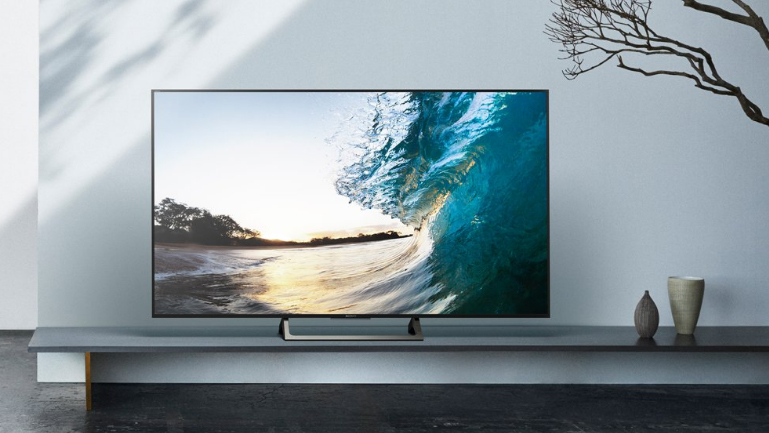
Best 55-inch 4K TVs of 2017: the best medium-sized screens for any budget
When you’re looking for the best 55-inch 4K TVs in 2017, you’ll need to look for one that really strikes a balance between size, price, and all the high-end tech that’s in style right now. With winter around the corner and the temperatures start to chill things out, sending us all scrambling back indoors, we’ll turn to our TVs more and more. If your current TV is starting to get older, the free-falling cost of 4K HDR TVs may make today the best time to find a replacement.
TVs of this size are popular, and that results in TV companies paying plenty of attention, boasting all the best features and screen technology. That means there will almost always be a 55-inch TV that easily caters to all of your specific needs, particularly if you want to get on the 4K train.
From LCD, LED, OLED and QLED, you’ll find just about every type of display technology at 55 inches coming from television manufacturers like Sony, Samsung, LG and Panasonic. Even better, they offer 55-inch TVs loaded with new smart features.
Here are our recommendations for the best 55-inch 4K TVs you can buy today, with all the details you need to know about what makes them worth buying.
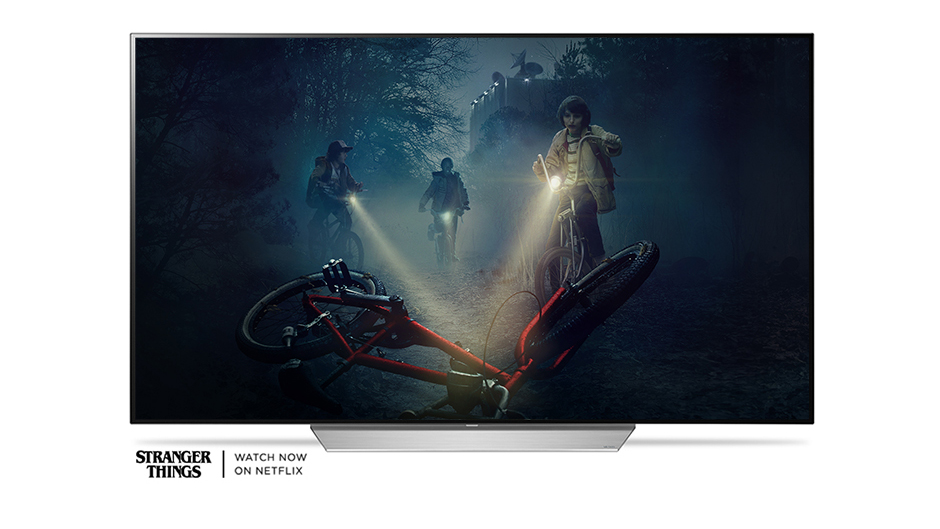
The LG OLED C7 is the clear winner of the best 55 inch 4K TV game – available in a 55-inch iteration as well as a 65-inch. It's at the top because it delivers better brightness and light control than last year’s C6 (something that up until now, we thought impossible), making it a high dynamic range performer that doesn't sacrifice OLED’s class-leading standard dynamic range capabilities. It delivers these new beautiful picture capabilities at a price that finally makes OLED a financially viable alternative to top-end LCD sets making it, beyond a doubt, one of 2017’s most desirable TVs.
There are other OLEDs worth considering this year (see: Sony's A1E OLED or LG's B7 and W7) but when we think about just how much LG's OLED C7 offers for its price, there's just no panel from 2017 that can top it.
Read the full review: LG OLED55C7

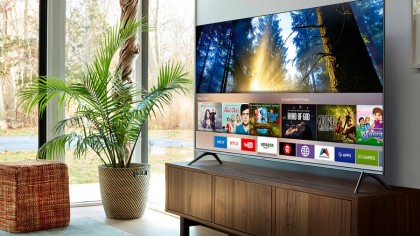
While LCDs haven't quite achieved the same black levels as their OLED rivals, the Sony X900E's HDR performance comes stunningly close.
This is possible because of the set's direct LED backlight, which allows it to achieve a level of brightness uniformity that edge-lit displays just can’t reach.
And with the fantastic detail and motion handling, the Sony BRAVIA XBR-55X900E (called the KD-55XE90 in the UK) maintains an unbelievably balance between price and performance for mid-range 4K TVs and is well worth considering ... even if its Android TV interface can feel a little clunky, and its remote a little flimsy.
Read the full review of the 65-inch version: Sony BRAVIA XBR-65X900E

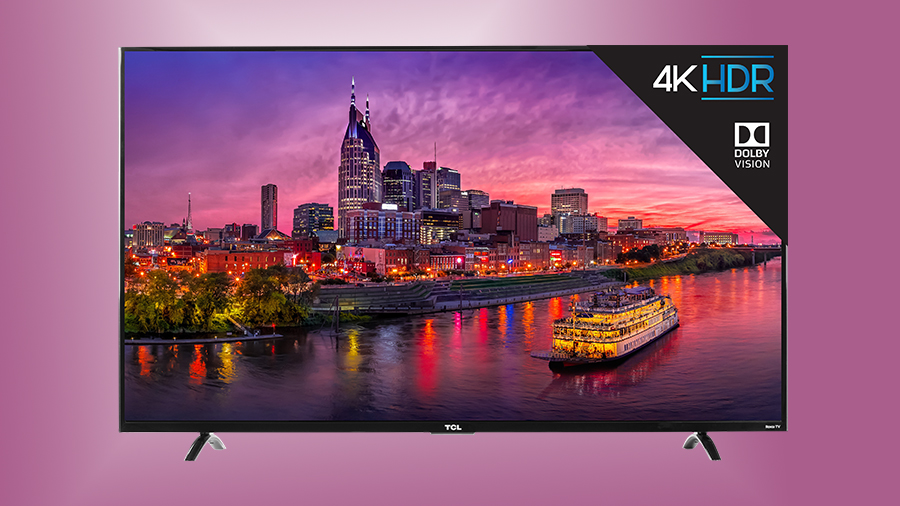
For years TV manufacturers have been trying tirelessly to find a way to bring a great performing Television at an affordable price, and so far they’ve been unsuccessful. Until now.
TCL’s P-Series 55P607 does just that – it packs amazing technology under the hood, including support for Dolby Vision and WCG, in an affordable package and the price will only continue to drop once the seasonal sales start in November.
If you like your TVs bright, colorful and well-stocked with the latest display technologies, the TCL P-Series 55P607 should be at the top of your list.
Read the full review: TCL P-Series (55P607)

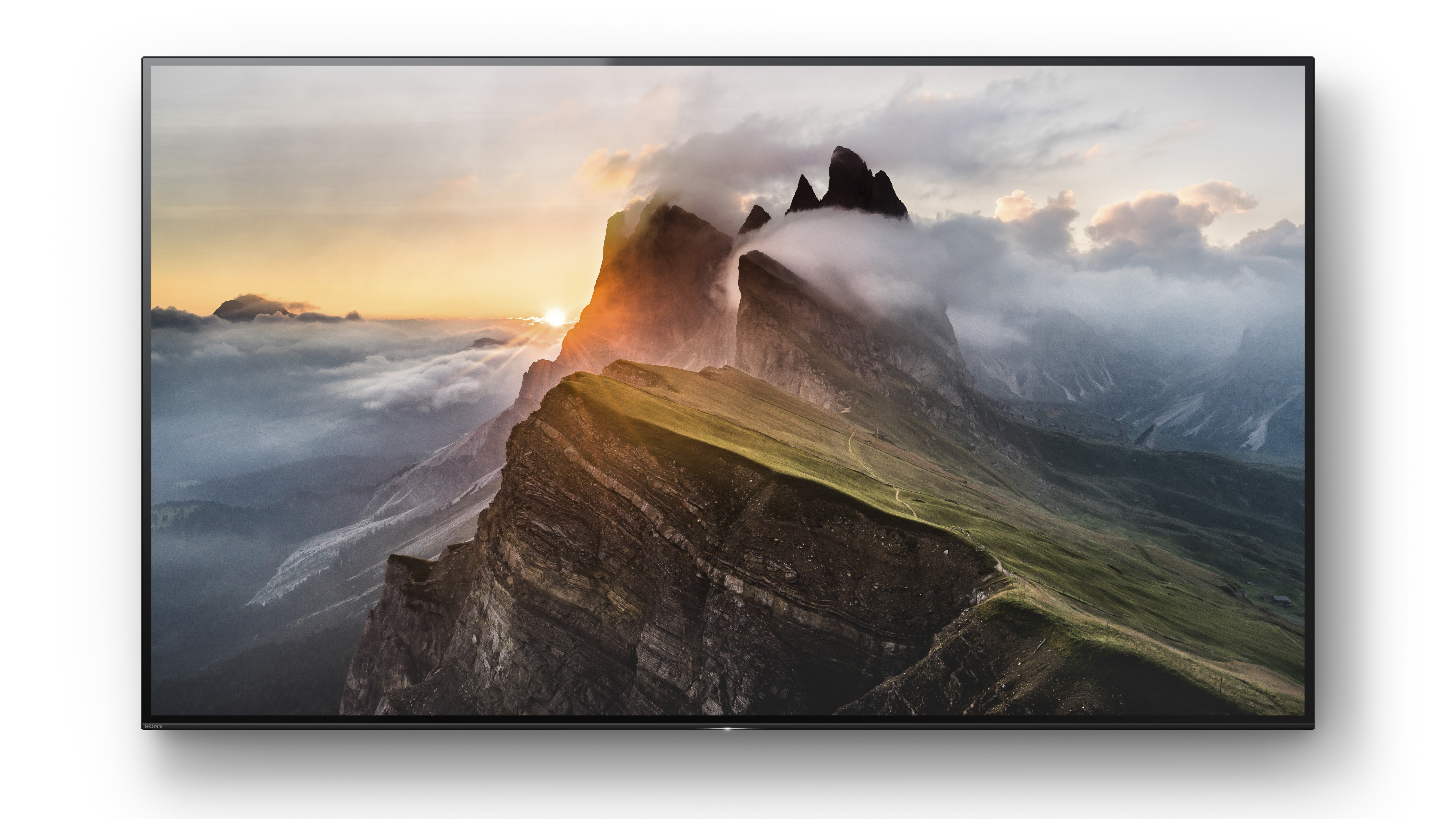
If you have the money to bankroll them, the 55A1E – and the A1E OLED series overall – are crowd pleasers in just about every way. Their ‘picture only’ design has been beautifully realized, managing to be simultaneously subtle and dramatic. Their vibrating screen delivers a far more powerful and effective sound performance than we’d ever thought possible.
The real stars of the show here, though, are the A1’s exquisitely detailed, contrast-rich and colorful pictures. These prove emphatically what we’ve long suspected: More brands using OLED technology can only lead to good things.
Read the full review: Sony Bravia OLED A1E

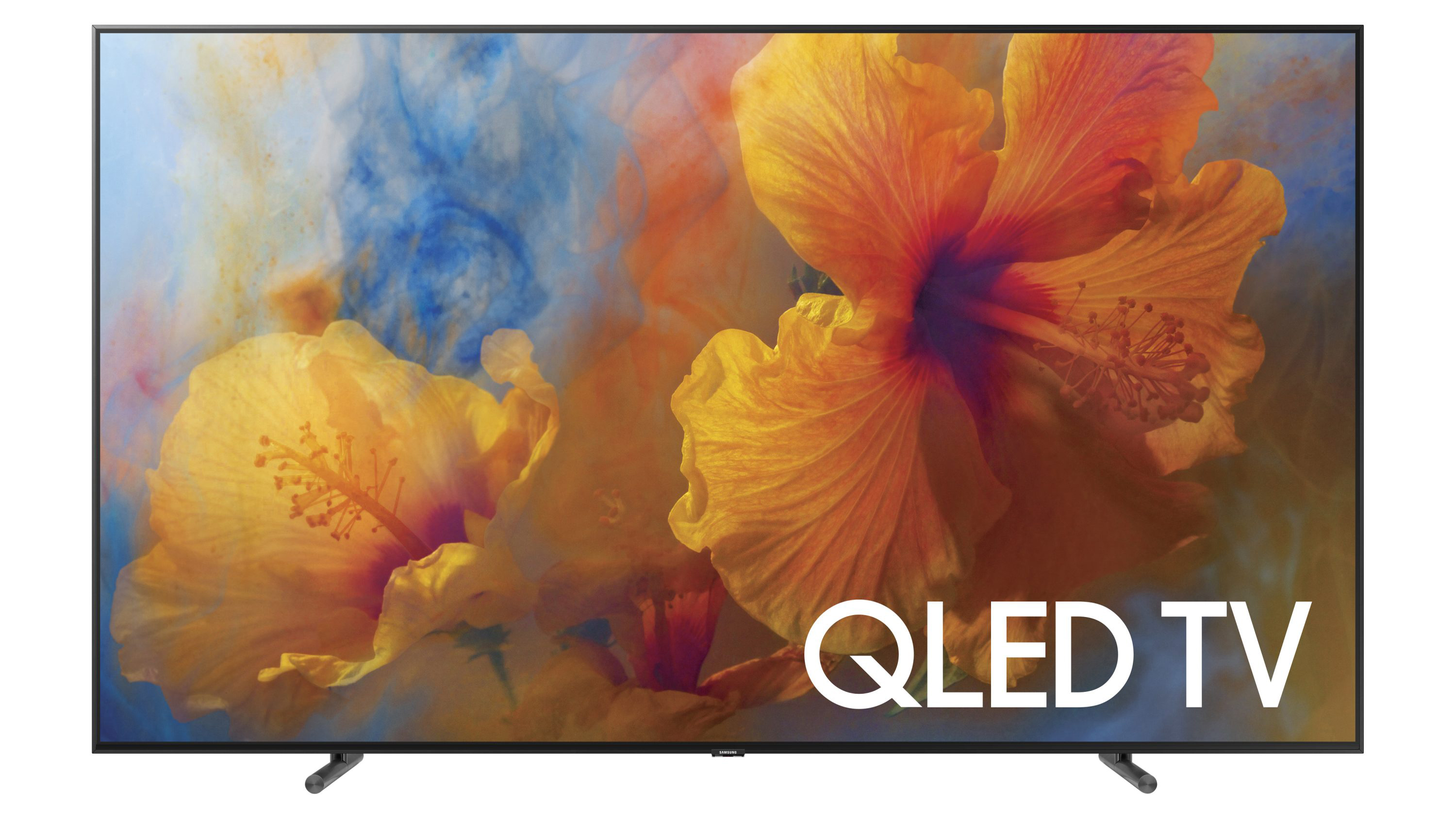
Samsung was the first brand to introduce an HDR-compatible screen way back in 2015, but it's not been resting on its haunches ever since.
It's latest flagship, the QN55Q9F (QE55Q9FAM in the UK), is a perfect example of this. It ups the brightness to 1500 nits, 50% higher than the level required for UHD Premium certification, making it one of the brightest TV we've ever tested.
Outside of an impressive-sounding number this brightness has a real impact on the set's image quality. Detail is preserved in even the brightest areas of the image, and colors are exceptionally vivid and bright. That means even non-HDR content looks fantastic thanks to Samsung's SDR upscaling technology.
No TV is perfect, and the Q9F can occasionally suffer from some backlight clouding around bright objects and some settings cause color striping in HDR colors, but in all other respects this is the best television around at the moment.
Read the full review: Samsung Q9F QLED TV

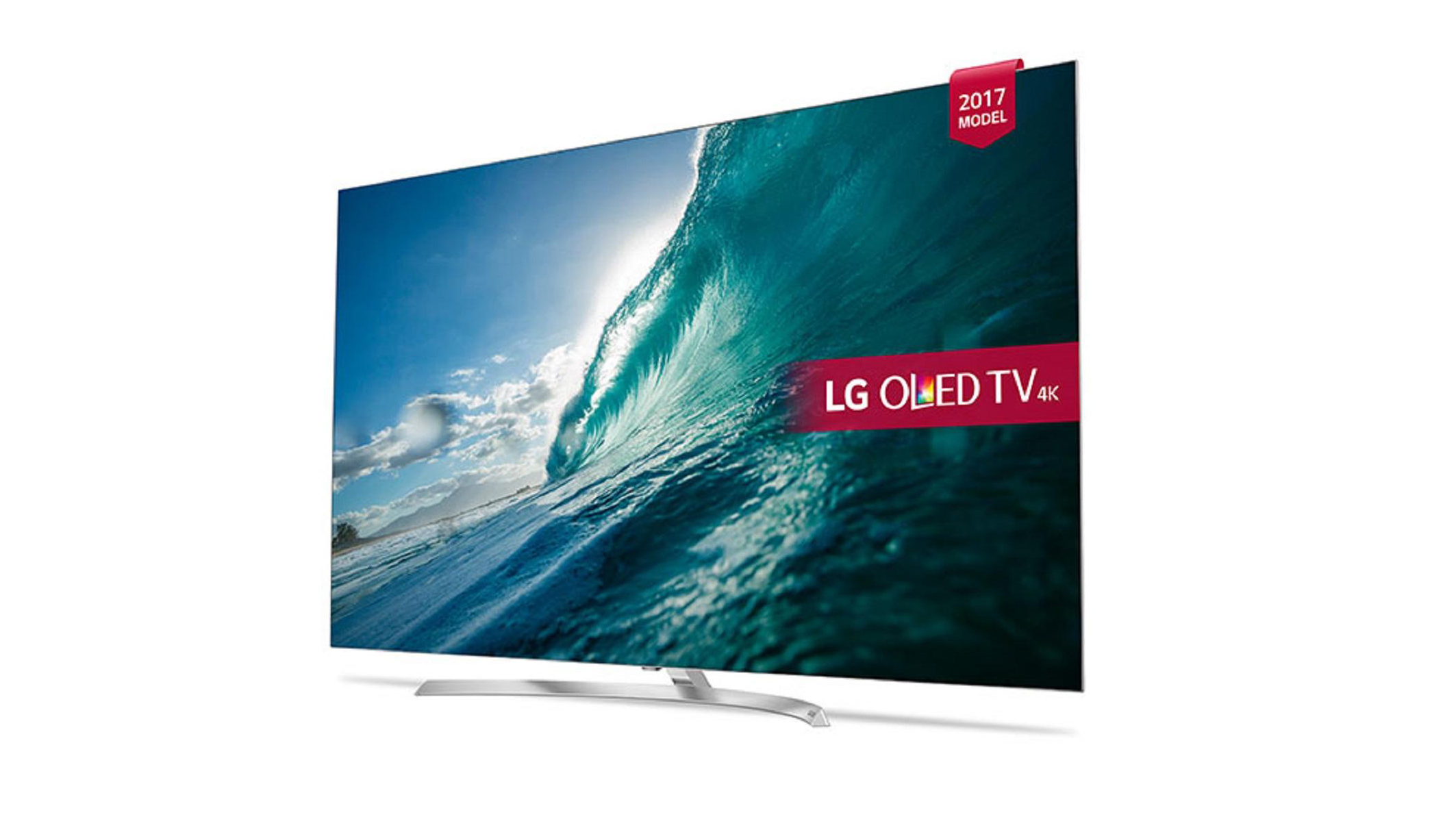
LG's 'B' line of OLEDs has consistently offered a great entry point into the display technology without compromising on what makes it so exciting.
And the B7 series is no different.
Contained within the TVs is exactly the same panel that's powering the more expensive C7, E7 and yes even the W7 LG televisions, which means an exceptional bump over last year's OLED panels at a much lower price.
So where has LG saved the money? In a word, sound. The B7's downward firing speakers are the worst all the company's OLED TVs. Not only that, but the set is also currently unable to pass Dolby Atmos to an external sound system over HDMI (although a firmware update to fix this is on the way).
If however, you're content to put up with a standard surround sound experience, then the B7 is a fantastic entryway into a piece of TV tech that still feels futuristic in 2017.
Read the full review: LG OLED55C7

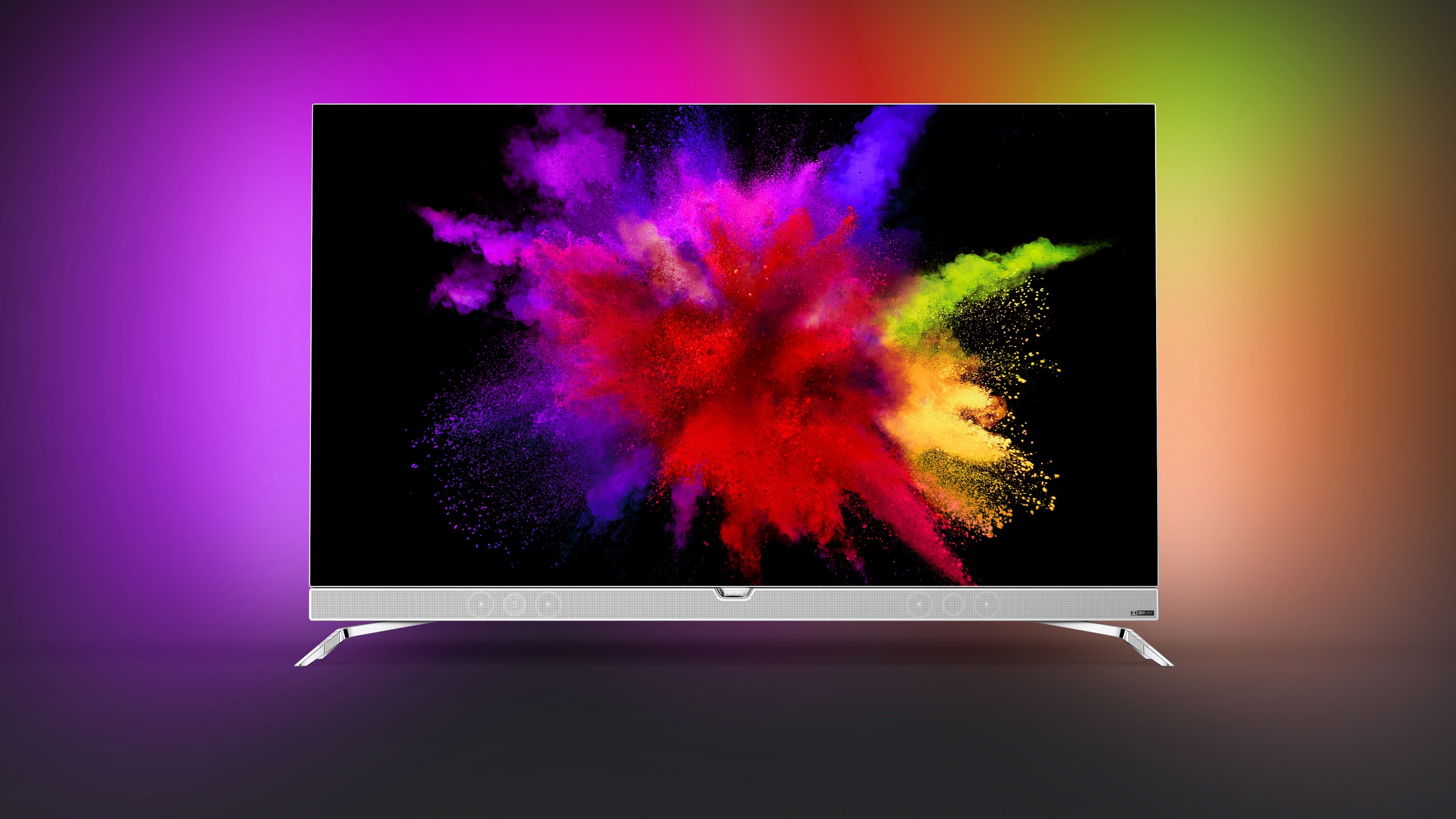
AV enthusiasts living in the UK have it good. Not only do you have access to great OLEDs from Sony and LG, but Philips and Panasonic each have their own line of infinite contrast screens that are exclusive to your neck of the woods.
Of them, one of our favourites is the Philips 55POS901F: a gorgeous looking 55-inch TV built around an OLED panel. The screen makes a stunning first impression thanks to the radiance of its three-sided Ambilight system and the gleaming metallic purity of its bodywork.
It’s much more than just a pretty face, though.
By the time you’ve added to the 55POS901F’s heady 4K HDR picture mix OLED’s ability to be watched from wider angles than current LCD TVs without losing colour and contrast, you have on your hands one of the best TVs on the market, even in the especially competitive 55-inch screen space.
Read the full review: Philips 55POS901F

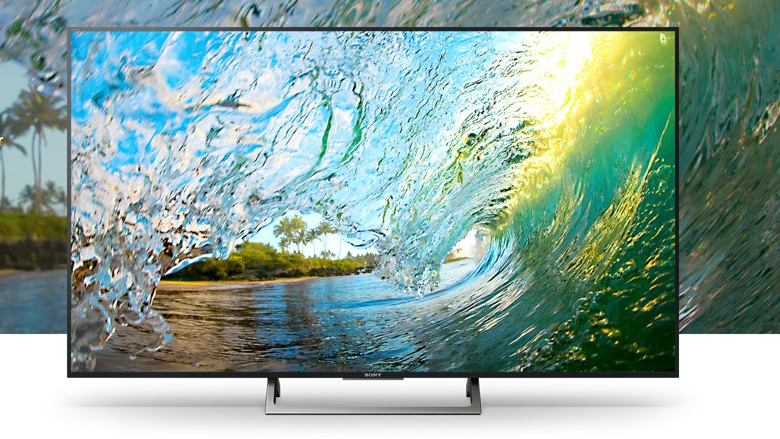
By introducing its exceptional X1 video processor further down its TV range than ever before and being brave enough to dial down the brightness a bit to deliver a more even, immersive backlight experience, Sony's struck mid-range gold with the XBR-X850E (KD-55XE8596 in the UK).
While it's not the brightest or most colorful TV on the list, the simple fact is that few TVs we’ve seen in recent times have balanced price, contrast, brightness and color quite so all-round effectively as Sony's mid-range hero.
All that said, US customers will have to upgrade to Sony's 65-inch iteration of the X850E if they want the mid-range price break, while UK residents get to happily enjoy this one in the smaller 55-inch size.
Read the full review: Sony XBR-55X850E
Best movies on Netflix UKBest shows on Netflix
TVs of this size are popular, and that results in TV companies paying plenty of attention, boasting all the best features and screen technology. That means there will almost always be a 55-inch TV that easily caters to all of your specific needs, particularly if you want to get on the 4K train.
From LCD, LED, OLED and QLED, you’ll find just about every type of display technology at 55 inches coming from television manufacturers like Sony, Samsung, LG and Panasonic. Even better, they offer 55-inch TVs loaded with new smart features.
Here are our recommendations for the best 55-inch 4K TVs you can buy today, with all the details you need to know about what makes them worth buying.

The LG OLED C7 is the clear winner of the best 55 inch 4K TV game – available in a 55-inch iteration as well as a 65-inch. It's at the top because it delivers better brightness and light control than last year’s C6 (something that up until now, we thought impossible), making it a high dynamic range performer that doesn't sacrifice OLED’s class-leading standard dynamic range capabilities. It delivers these new beautiful picture capabilities at a price that finally makes OLED a financially viable alternative to top-end LCD sets making it, beyond a doubt, one of 2017’s most desirable TVs.
There are other OLEDs worth considering this year (see: Sony's A1E OLED or LG's B7 and W7) but when we think about just how much LG's OLED C7 offers for its price, there's just no panel from 2017 that can top it.
Read the full review: LG OLED55C7


While LCDs haven't quite achieved the same black levels as their OLED rivals, the Sony X900E's HDR performance comes stunningly close.
This is possible because of the set's direct LED backlight, which allows it to achieve a level of brightness uniformity that edge-lit displays just can’t reach.
And with the fantastic detail and motion handling, the Sony BRAVIA XBR-55X900E (called the KD-55XE90 in the UK) maintains an unbelievably balance between price and performance for mid-range 4K TVs and is well worth considering ... even if its Android TV interface can feel a little clunky, and its remote a little flimsy.
Read the full review of the 65-inch version: Sony BRAVIA XBR-65X900E


For years TV manufacturers have been trying tirelessly to find a way to bring a great performing Television at an affordable price, and so far they’ve been unsuccessful. Until now.
TCL’s P-Series 55P607 does just that – it packs amazing technology under the hood, including support for Dolby Vision and WCG, in an affordable package and the price will only continue to drop once the seasonal sales start in November.
If you like your TVs bright, colorful and well-stocked with the latest display technologies, the TCL P-Series 55P607 should be at the top of your list.
Read the full review: TCL P-Series (55P607)


If you have the money to bankroll them, the 55A1E – and the A1E OLED series overall – are crowd pleasers in just about every way. Their ‘picture only’ design has been beautifully realized, managing to be simultaneously subtle and dramatic. Their vibrating screen delivers a far more powerful and effective sound performance than we’d ever thought possible.
The real stars of the show here, though, are the A1’s exquisitely detailed, contrast-rich and colorful pictures. These prove emphatically what we’ve long suspected: More brands using OLED technology can only lead to good things.
Read the full review: Sony Bravia OLED A1E


Samsung was the first brand to introduce an HDR-compatible screen way back in 2015, but it's not been resting on its haunches ever since.
It's latest flagship, the QN55Q9F (QE55Q9FAM in the UK), is a perfect example of this. It ups the brightness to 1500 nits, 50% higher than the level required for UHD Premium certification, making it one of the brightest TV we've ever tested.
Outside of an impressive-sounding number this brightness has a real impact on the set's image quality. Detail is preserved in even the brightest areas of the image, and colors are exceptionally vivid and bright. That means even non-HDR content looks fantastic thanks to Samsung's SDR upscaling technology.
No TV is perfect, and the Q9F can occasionally suffer from some backlight clouding around bright objects and some settings cause color striping in HDR colors, but in all other respects this is the best television around at the moment.
Read the full review: Samsung Q9F QLED TV


LG's 'B' line of OLEDs has consistently offered a great entry point into the display technology without compromising on what makes it so exciting.
And the B7 series is no different.
Contained within the TVs is exactly the same panel that's powering the more expensive C7, E7 and yes even the W7 LG televisions, which means an exceptional bump over last year's OLED panels at a much lower price.
So where has LG saved the money? In a word, sound. The B7's downward firing speakers are the worst all the company's OLED TVs. Not only that, but the set is also currently unable to pass Dolby Atmos to an external sound system over HDMI (although a firmware update to fix this is on the way).
If however, you're content to put up with a standard surround sound experience, then the B7 is a fantastic entryway into a piece of TV tech that still feels futuristic in 2017.
Read the full review: LG OLED55C7


AV enthusiasts living in the UK have it good. Not only do you have access to great OLEDs from Sony and LG, but Philips and Panasonic each have their own line of infinite contrast screens that are exclusive to your neck of the woods.
Of them, one of our favourites is the Philips 55POS901F: a gorgeous looking 55-inch TV built around an OLED panel. The screen makes a stunning first impression thanks to the radiance of its three-sided Ambilight system and the gleaming metallic purity of its bodywork.
It’s much more than just a pretty face, though.
By the time you’ve added to the 55POS901F’s heady 4K HDR picture mix OLED’s ability to be watched from wider angles than current LCD TVs without losing colour and contrast, you have on your hands one of the best TVs on the market, even in the especially competitive 55-inch screen space.
Read the full review: Philips 55POS901F


By introducing its exceptional X1 video processor further down its TV range than ever before and being brave enough to dial down the brightness a bit to deliver a more even, immersive backlight experience, Sony's struck mid-range gold with the XBR-X850E (KD-55XE8596 in the UK).
While it's not the brightest or most colorful TV on the list, the simple fact is that few TVs we’ve seen in recent times have balanced price, contrast, brightness and color quite so all-round effectively as Sony's mid-range hero.
All that said, US customers will have to upgrade to Sony's 65-inch iteration of the X850E if they want the mid-range price break, while UK residents get to happily enjoy this one in the smaller 55-inch size.
Read the full review: Sony XBR-55X850E
Best movies on Netflix UKBest shows on Netflix
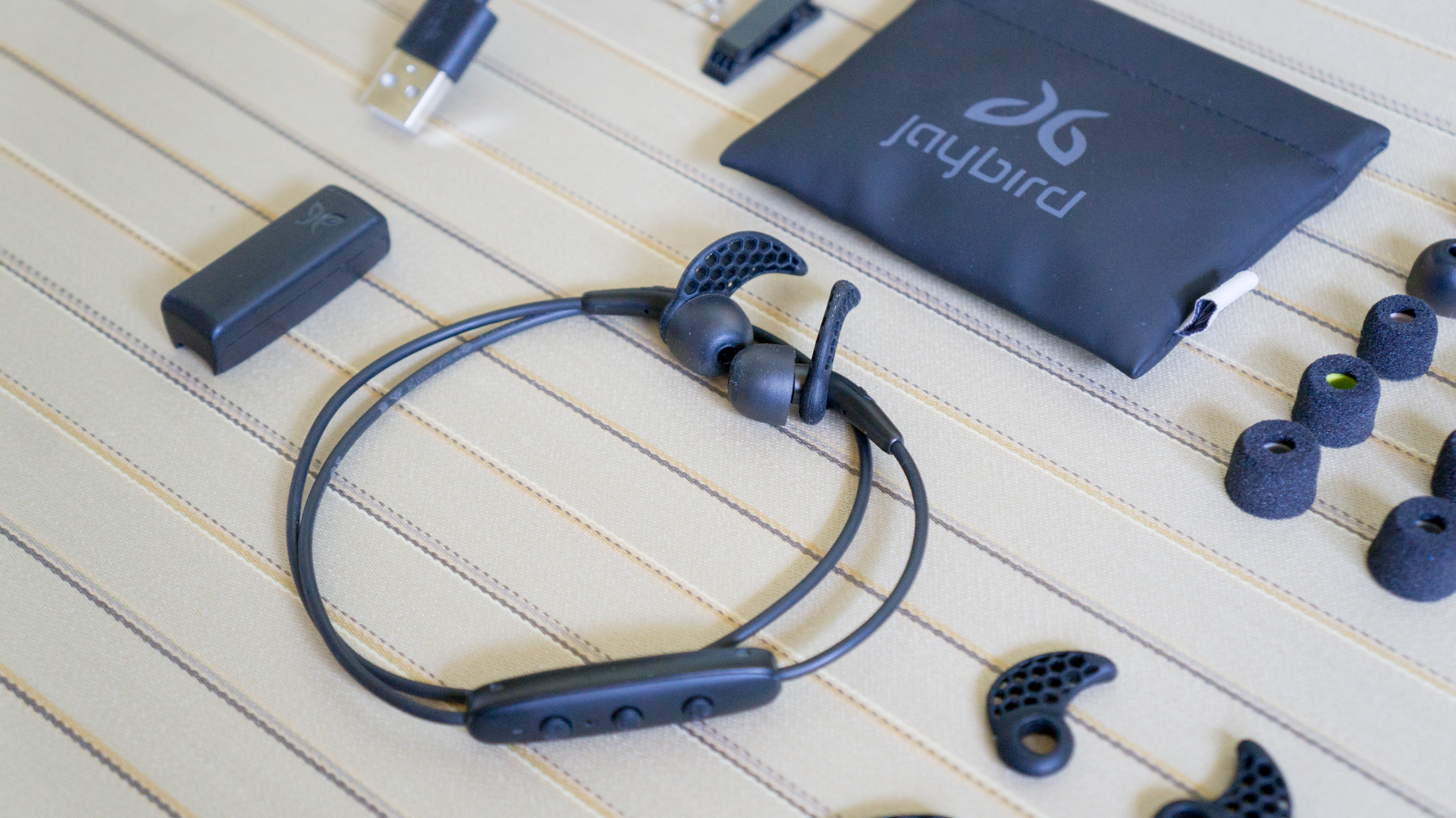
The best Bluetooth earbuds: top wireless earbuds available today
Bluetooth and wireless earbuds have been a choice for music lovers who don’t want to get tangled up for a while now. But, due to their high cost, sound quality and battery life – they’ve not always been the best choice for everyone.
Thankfully, the best Bluetooth earbuds have been quickly getting better and better, offering advancements in all the areas that once made them less appealing than their wired cousins. The best headphone manufacturers are now doing great work to make wireless earbuds last longer, sound better and more affordable.
Newer and better wireless earbuds, like Apple’s anticipated AirPods 2, are coming out all the time. And Apple’s foray into the wireless earbuds world, as always, has inspired other manufacturers keep improving their products so they have a competitive chance against Apple’s famously high standards. Jaybird’s Run True Wireless Sport earbuds are a recent release that could be the AirPods for runners, and could very well end up on this list in the near future.
Unfortunately, with the ever expanding market for wireless earbuds, it can be challenging to find a pair that balances cost and quality. But we’ve culled through the Bluetooth earbuds that are out in the wild to boil the list down to something more manageable. So, whether you’re an audiophile or just economical, these are the earbuds for anyone who never wants a doorknob to rip out their earbuds again.
1. Jaybird X2
2. Optoma NuForce BE Sport3
3. Beats X
4. Bose QuietControl 30
5. Apple AirPods
6. Jabra Elite Sport
7. Jaybird Freedom Wireless
8. Moto Surround
9. Beats Powerbeats2 Wireless
10. Plantronics BackBeat Fit
Not looking for in-ear earbuds? Here's our list of the best wireless headphones!
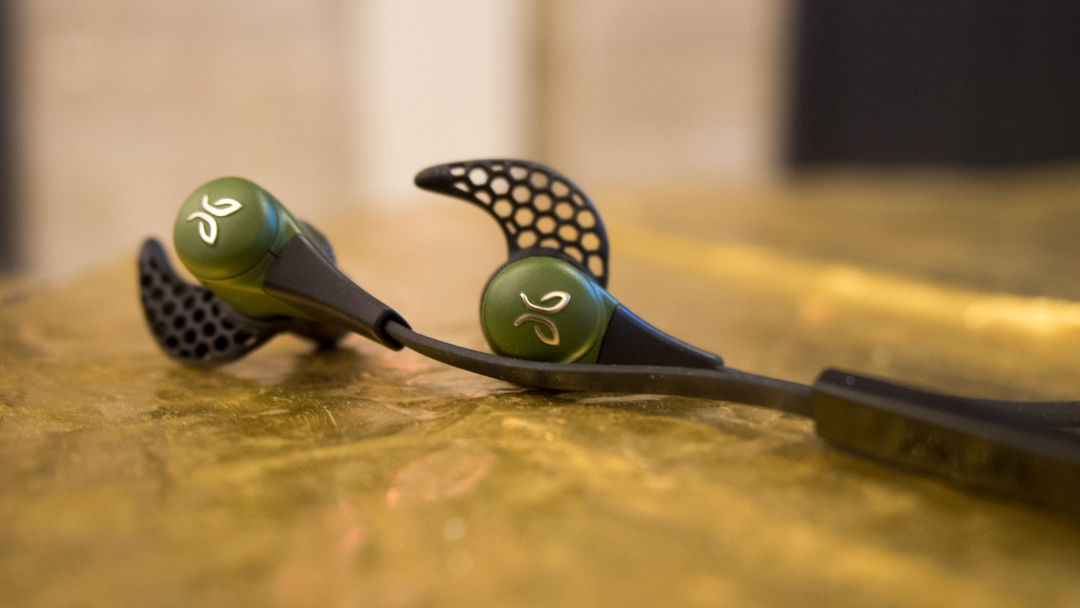
The Jaybird X2 are truly at the top of their class, possessing the holy trinity of above average battery life, ease of use and, most importantly, fantastic sound performance, a feat that their competition has a hard time achieving. Even if you're not necessarily looking for a pair of headphones to take to the gym, the features that make the X2s great for fitness use, like hearty sound performance and above average battery life, translate perfectly into a set of wireless in-ear headphones that are just as great for everyday use.
Read the full review: Jaybird X2
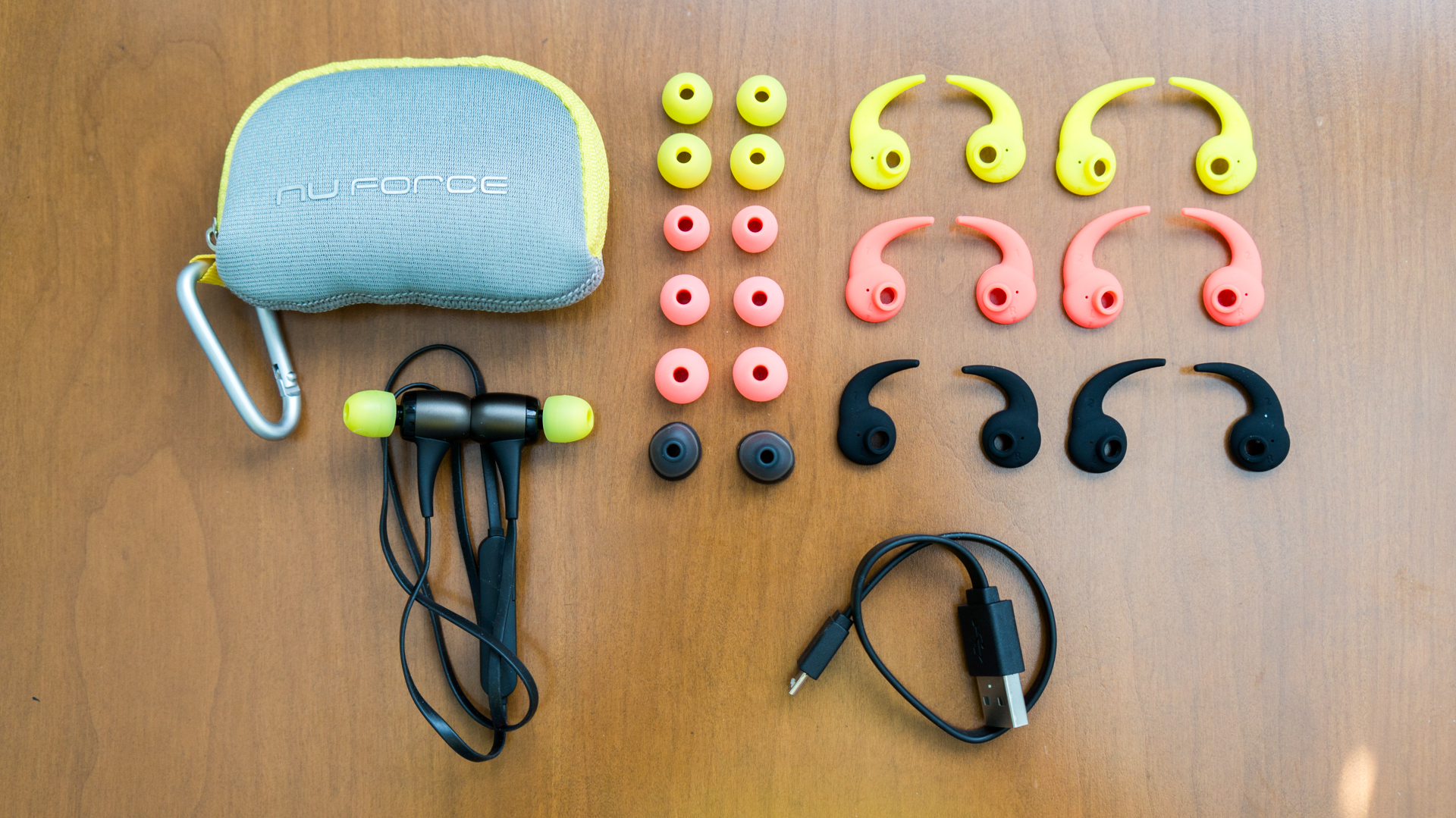
NuForce have really crafted something special here with the BE Sport3 earbuds. They're an unbelievable value for a pair of wireless earbuds that sound great, last all day, have an extremely durable build and sublime noise isolation. They might not be the most dynamic or solid headphones, but NuForce shows us that the future of wireless earbuds is a bright one.
Read the full review: Optoma NuForce BE Sport3

The Powerbeats aren't the only wireless in-ear headphones made by Dr. Dre. The Beats X headphones have all the features you'd expect out of the workout earphones with an even better audio performance and comfortable design.
It has a few problems of its own – including poor noise isolation and a lack of fidelity – but if you’re looking for a no-fuss pair of earbuds that charge in 5 minutes and don’t mind dropping some cash on them, the Beats X are for you.
Read the full review: Beats X

Life is full of trade-offs, and it's the same with the Bose QuietControl 30s. On the plus side you get a level of noise cancellation that’s on a par with the brand's over-ear headphones, but the compromise here is on sound quality, which is simply not as good as that of other in-ear or over-ear headphones we’ve tried.
Read the full review: Bose QuietControl 30

There’s lots to like about the AirPods, including their sound quality and how seamlessly they pair with your device. But, despite some positives, we just can't give the AirPods the top spot on our list. At the end of the day, their lack of in-line remote means that there are easier headphones to use while out and about, and Siri isn’t a good enough replacement. They might not fall out as easily as we once feared, but they don’t feel secure enough for their price or strong enough in the performance category to make up for their faux-pas. Maybe Apple’s AirPods 2 can fix these shortcomings in the near future. That said, diehard Apple fans will not be disappointed by Apple’s first wireless earbuds.
Read the full review: Apple AirPods
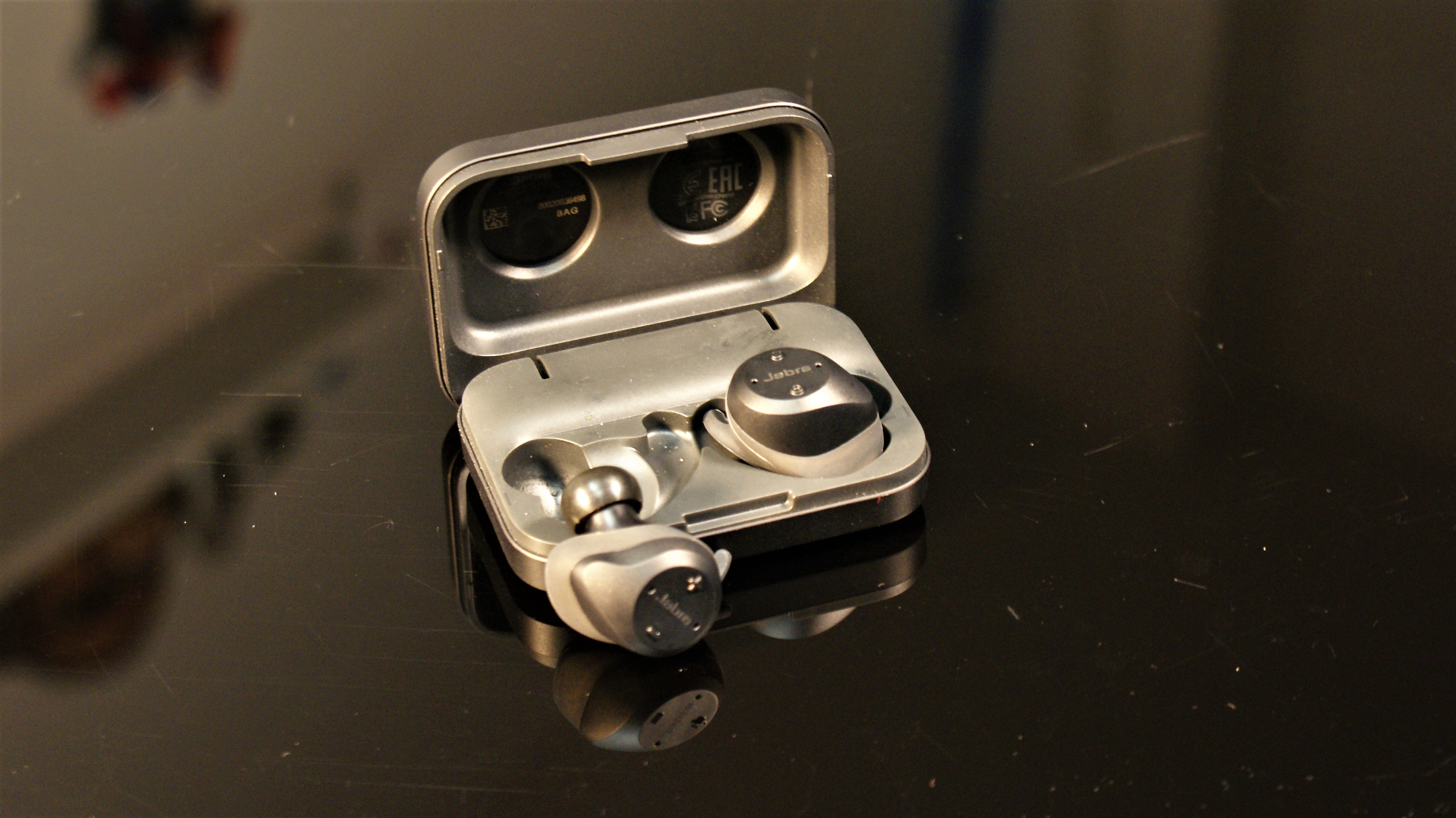
The Jabra Elite Sport headphones are a very powerful proposition, and can do a wide variety of things to help everyone from the novice to the practiced fitness enthusiast. That said, they’re also competent Bluetooth buds for use around town, with a long-enough battery life and good sound quality.
However, issues with the slightly iffy heart rate data at times, and the still-not-quite-automated-enough cross training still grate. Overall, they're good enough, but a touch more expensive than they need to be.
Read the full review: Jabra Elite Sport
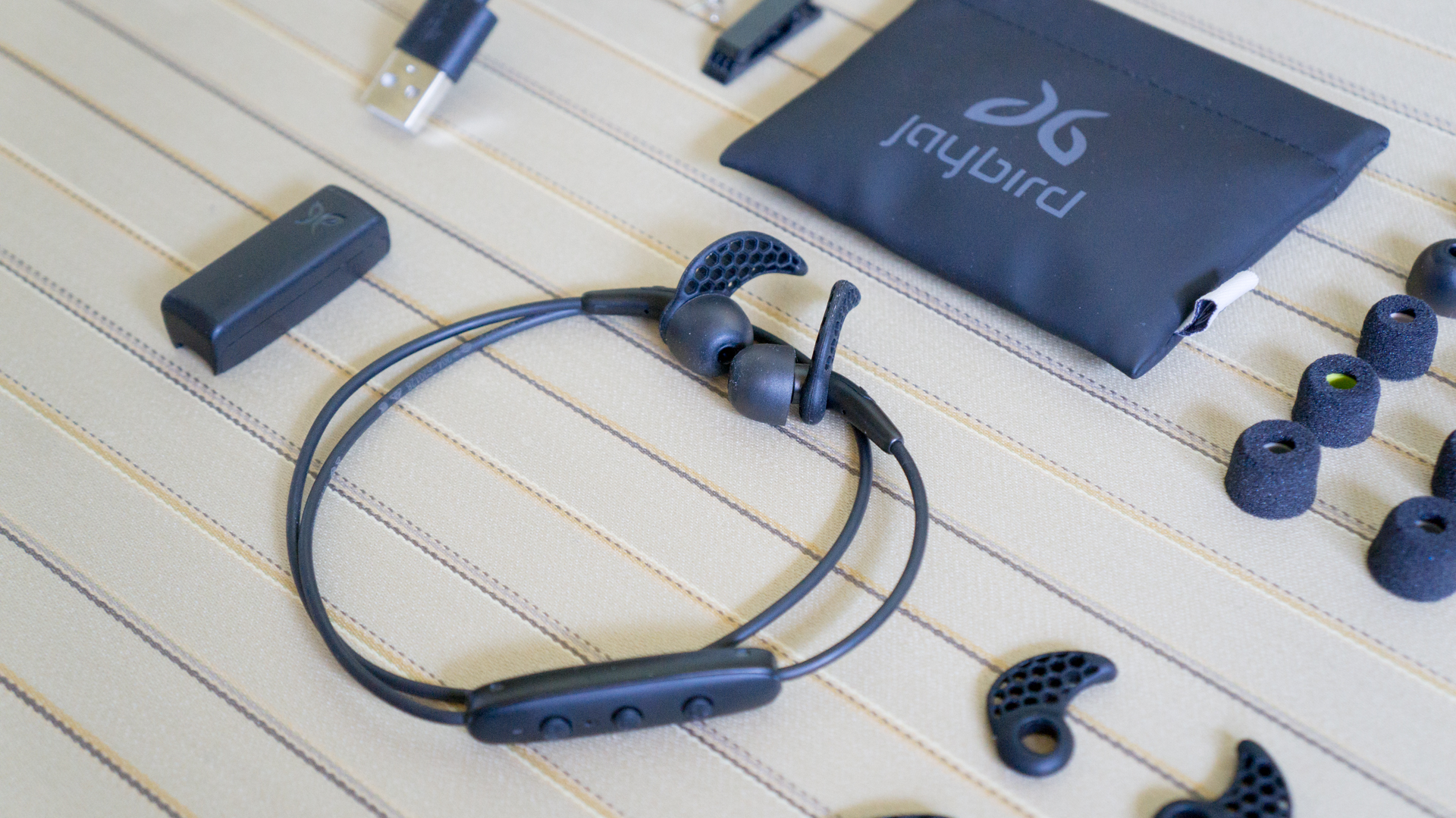
If you're looking for something stylish and don't mind compromising slightly on sound quality, the Jaybird Freedom Wireless is probably your best bet. Comfort and design are definitely high points for the Freedoms, and we especially liked being able to bring the EQ settings we setup on our phone wherever we went. Unfortunately, though, mediocre sound quality and a short battery life keep them from winning top marks.
Read the full review: Jaybird Freedom Wireless
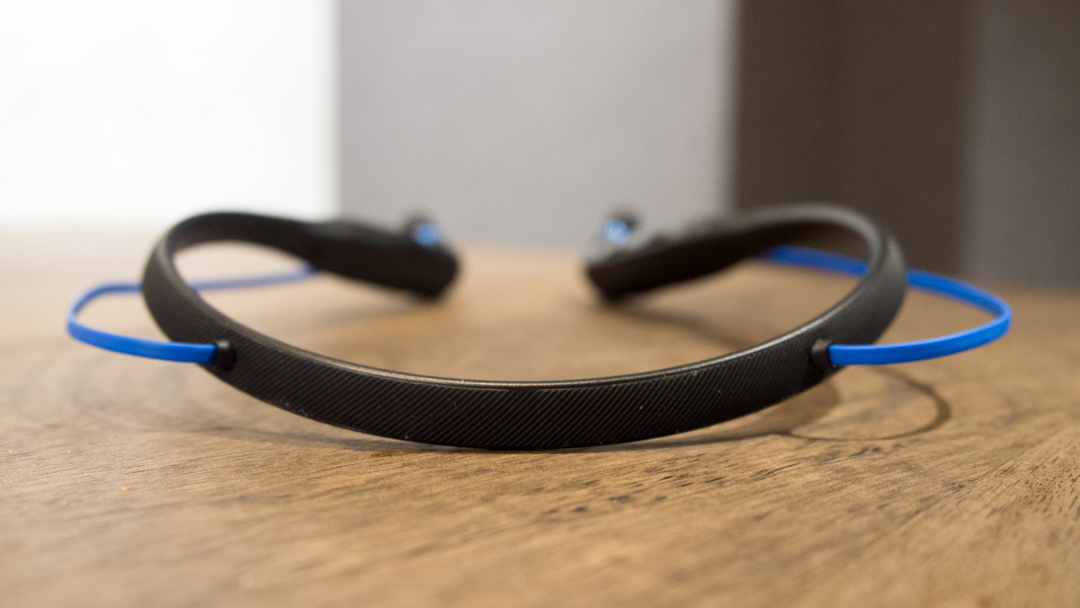
If you don't mind rocking the band, the Moto Surround hits all the high notes in terms of price, performance and battery life. In our tests, the Moto Surround survived 12 hours in between charges and displayed real skill in outputting bass, mid and treble in equal amounts. You can appreciate the balanced sound signature while your wallet appreciates the price.
Read the full review: Moto Surround
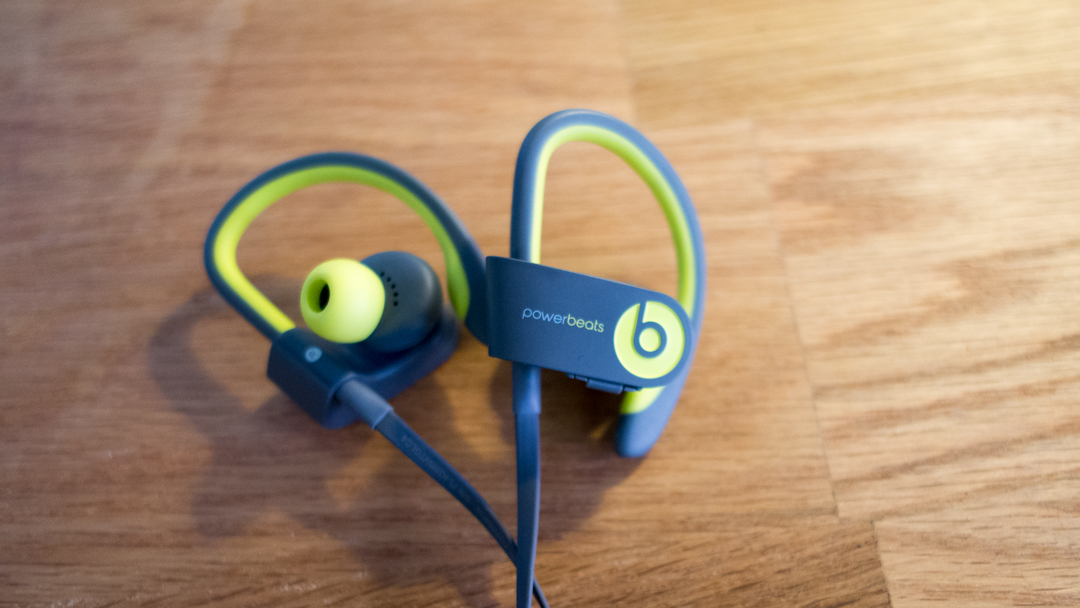
Beats have always had a spot at the gym, but the Powerbeats2 shrink the giant iconic cans down to a more manageable earbud size. The Powerbeats2, like the larger over-ear Beats, specialize in dropping the bass, which is just what the doctor ordered for listening during a workout. That said, the Powerbeats leave a lot to be desired in the comfort and battery departments.
Read the full review: Beats Powerbeats2 Wireless

While they're a bit older now, the Plantronics BackBeat Fit deliver outstandingly long battery life and beautiful audio bursting with a full spectrum of sound alongside an excellent, durable design. The downside to these guys is that the constant bobbing of the cord that wraps around the back of your neck isn't very comfortable and it's been known to randomly disconnect in the middle of a set. If you can deal with a few caveats, though, Plantronics' BackBeat Fit is a stellar gym companion.
Read the full review: Plantronics BackBeat Fit
Did we miss one? Let us know in the comments below!
Thankfully, the best Bluetooth earbuds have been quickly getting better and better, offering advancements in all the areas that once made them less appealing than their wired cousins. The best headphone manufacturers are now doing great work to make wireless earbuds last longer, sound better and more affordable.
Newer and better wireless earbuds, like Apple’s anticipated AirPods 2, are coming out all the time. And Apple’s foray into the wireless earbuds world, as always, has inspired other manufacturers keep improving their products so they have a competitive chance against Apple’s famously high standards. Jaybird’s Run True Wireless Sport earbuds are a recent release that could be the AirPods for runners, and could very well end up on this list in the near future.
Unfortunately, with the ever expanding market for wireless earbuds, it can be challenging to find a pair that balances cost and quality. But we’ve culled through the Bluetooth earbuds that are out in the wild to boil the list down to something more manageable. So, whether you’re an audiophile or just economical, these are the earbuds for anyone who never wants a doorknob to rip out their earbuds again.
1. Jaybird X2
2. Optoma NuForce BE Sport3
3. Beats X
4. Bose QuietControl 30
5. Apple AirPods
6. Jabra Elite Sport
7. Jaybird Freedom Wireless
8. Moto Surround
9. Beats Powerbeats2 Wireless
10. Plantronics BackBeat Fit
Not looking for in-ear earbuds? Here's our list of the best wireless headphones!

The Jaybird X2 are truly at the top of their class, possessing the holy trinity of above average battery life, ease of use and, most importantly, fantastic sound performance, a feat that their competition has a hard time achieving. Even if you're not necessarily looking for a pair of headphones to take to the gym, the features that make the X2s great for fitness use, like hearty sound performance and above average battery life, translate perfectly into a set of wireless in-ear headphones that are just as great for everyday use.
Read the full review: Jaybird X2

NuForce have really crafted something special here with the BE Sport3 earbuds. They're an unbelievable value for a pair of wireless earbuds that sound great, last all day, have an extremely durable build and sublime noise isolation. They might not be the most dynamic or solid headphones, but NuForce shows us that the future of wireless earbuds is a bright one.
Read the full review: Optoma NuForce BE Sport3

The Powerbeats aren't the only wireless in-ear headphones made by Dr. Dre. The Beats X headphones have all the features you'd expect out of the workout earphones with an even better audio performance and comfortable design.
It has a few problems of its own – including poor noise isolation and a lack of fidelity – but if you’re looking for a no-fuss pair of earbuds that charge in 5 minutes and don’t mind dropping some cash on them, the Beats X are for you.
Read the full review: Beats X

Life is full of trade-offs, and it's the same with the Bose QuietControl 30s. On the plus side you get a level of noise cancellation that’s on a par with the brand's over-ear headphones, but the compromise here is on sound quality, which is simply not as good as that of other in-ear or over-ear headphones we’ve tried.
Read the full review: Bose QuietControl 30

There’s lots to like about the AirPods, including their sound quality and how seamlessly they pair with your device. But, despite some positives, we just can't give the AirPods the top spot on our list. At the end of the day, their lack of in-line remote means that there are easier headphones to use while out and about, and Siri isn’t a good enough replacement. They might not fall out as easily as we once feared, but they don’t feel secure enough for their price or strong enough in the performance category to make up for their faux-pas. Maybe Apple’s AirPods 2 can fix these shortcomings in the near future. That said, diehard Apple fans will not be disappointed by Apple’s first wireless earbuds.
Read the full review: Apple AirPods

The Jabra Elite Sport headphones are a very powerful proposition, and can do a wide variety of things to help everyone from the novice to the practiced fitness enthusiast. That said, they’re also competent Bluetooth buds for use around town, with a long-enough battery life and good sound quality.
However, issues with the slightly iffy heart rate data at times, and the still-not-quite-automated-enough cross training still grate. Overall, they're good enough, but a touch more expensive than they need to be.
Read the full review: Jabra Elite Sport

If you're looking for something stylish and don't mind compromising slightly on sound quality, the Jaybird Freedom Wireless is probably your best bet. Comfort and design are definitely high points for the Freedoms, and we especially liked being able to bring the EQ settings we setup on our phone wherever we went. Unfortunately, though, mediocre sound quality and a short battery life keep them from winning top marks.
Read the full review: Jaybird Freedom Wireless

If you don't mind rocking the band, the Moto Surround hits all the high notes in terms of price, performance and battery life. In our tests, the Moto Surround survived 12 hours in between charges and displayed real skill in outputting bass, mid and treble in equal amounts. You can appreciate the balanced sound signature while your wallet appreciates the price.
Read the full review: Moto Surround

Beats have always had a spot at the gym, but the Powerbeats2 shrink the giant iconic cans down to a more manageable earbud size. The Powerbeats2, like the larger over-ear Beats, specialize in dropping the bass, which is just what the doctor ordered for listening during a workout. That said, the Powerbeats leave a lot to be desired in the comfort and battery departments.
Read the full review: Beats Powerbeats2 Wireless

While they're a bit older now, the Plantronics BackBeat Fit deliver outstandingly long battery life and beautiful audio bursting with a full spectrum of sound alongside an excellent, durable design. The downside to these guys is that the constant bobbing of the cord that wraps around the back of your neck isn't very comfortable and it's been known to randomly disconnect in the middle of a set. If you can deal with a few caveats, though, Plantronics' BackBeat Fit is a stellar gym companion.
Read the full review: Plantronics BackBeat Fit
Did we miss one? Let us know in the comments below!

Best PC cases 2017: top cases for your desktop computer
If you’re planning to begin building a computer, finding the best PC case is probably the last thing that you’re thinking about. So, why wouldn’t you settle for a PC case that’s cheap and wobbly instead. Well, when that chassis eventually breaks, moving all of your myriad PC parts over to a new case will probably drive you out of your mind.
That’s why, before you start even thinking about the best graphics card for your new rig, you should begin with one of the best PC cases on the market right now. And, luckily, we here at TechRadar have went ahead and found all the best PC cases for you. Whether you’re planning on using your new PC to play games, make art, watch movies or just write like us, we’ve sorted through every PC case we could get our hands on to bring you only the very best PC cases that you can find.
We know, this sounds just a little bit too good to be true, you can feel it deep in your gut. Don’t confuse hunger for suspicion, though, as we’ve rounded up 8 unique PC cases for you – each in separate categories – that feature an array of airtight reasons for why they should be the case to house your beloved PC components. What’s better, these cases won’t hurt your wallet either, as they pursue value just as much as function.
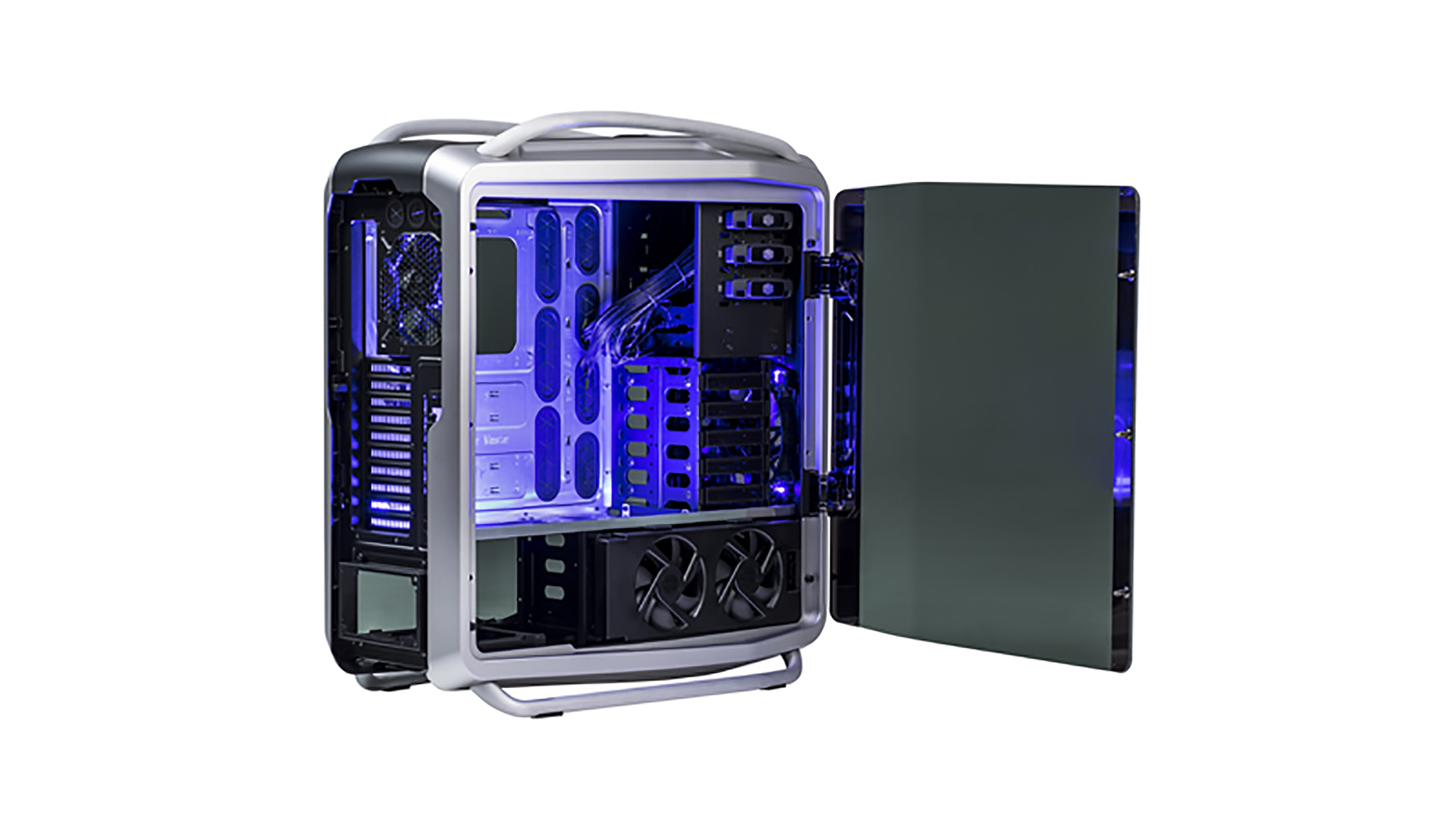
Some of you might be thinking that this list might already be out of date by including this familiar case, we don’t blame you for your suspicion. The Cooler Master Cosmos II 25th Anniversary Edition was designed to mimic the 2012 case of its namesake to – of course– celebrate its 25th Anniversary. The 2017 edition optimizes HDD installations with its trademark X-Dock, and its tempered glass side panel looks beautiful while illuminated by its blue LEDs.
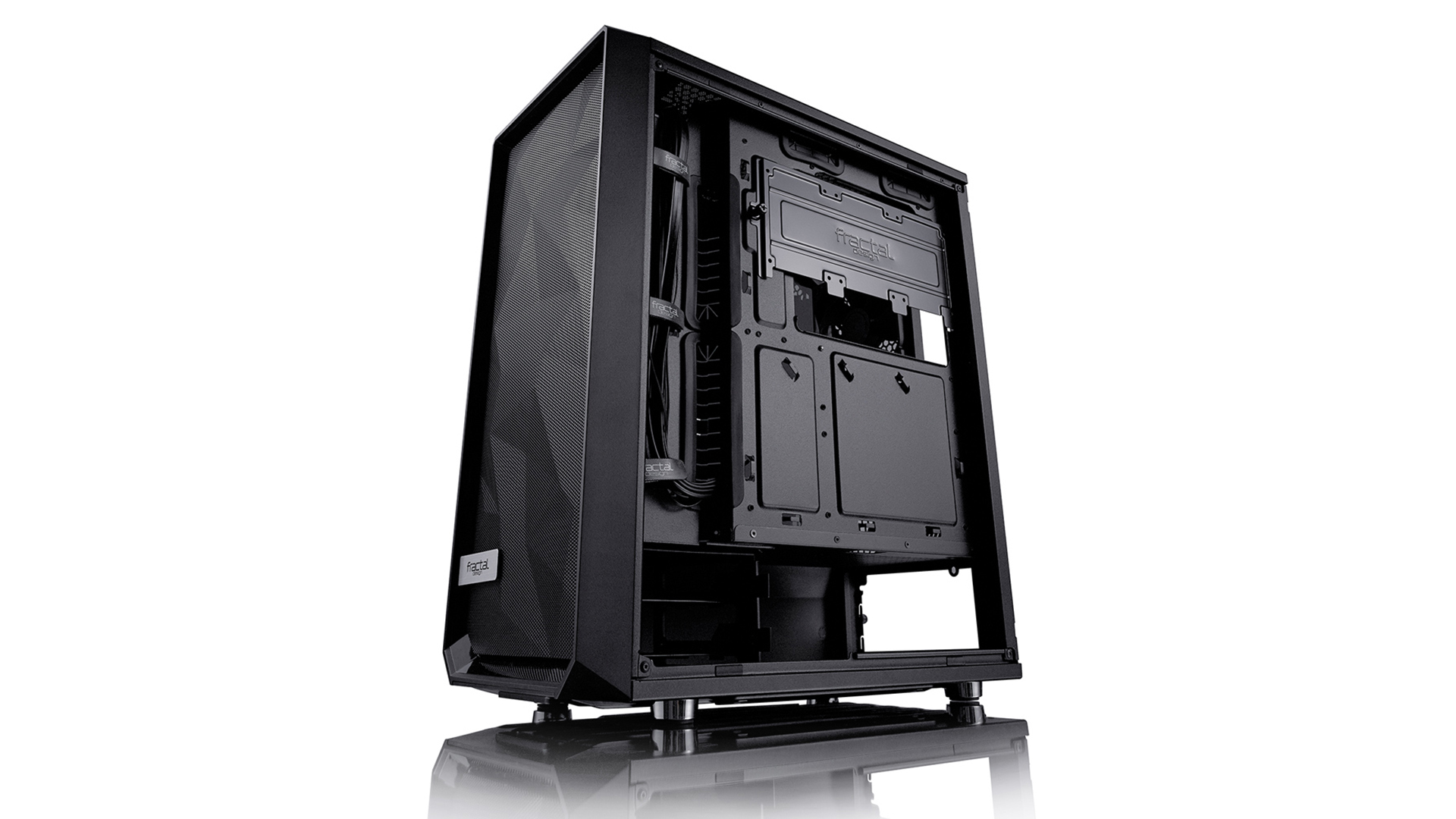
There are very few PC cases that look anything like Fractal Design’s Meshify-C. It’s even rare to see a chassis that even vaguely resembles it.. Given that the entire front of the case is made of mesh material sectioned off into many polygonal shapes, the Meshify-C has a unique aesthetic, and it does so without compromising on function. With two fans pre-installed, interior cooling is (forgive us) a breeze, even if the Meshify-C is held back by a number of obstacles.
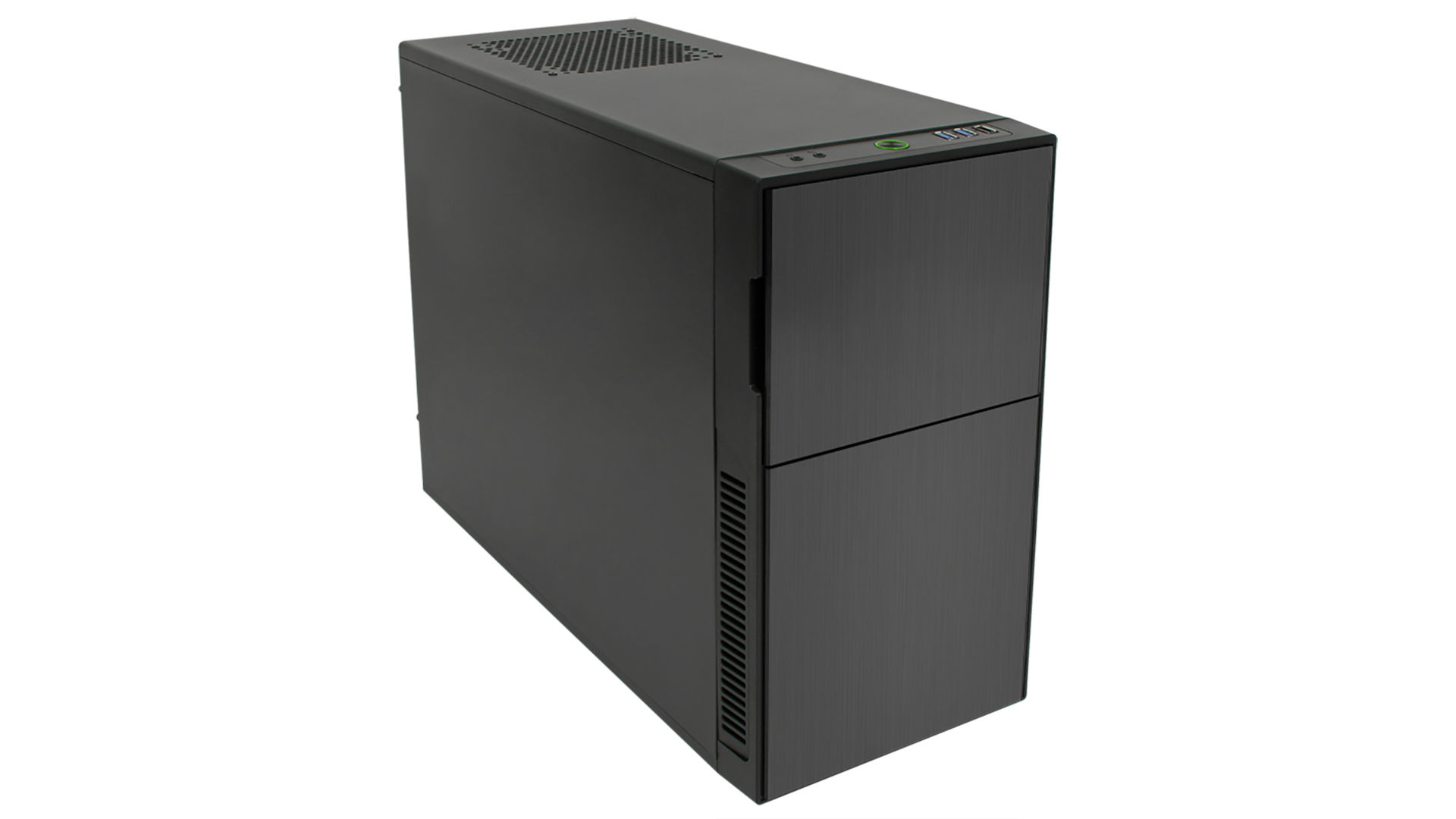
Nanoxia Deep Silence 4, as it’s name suggests, was crafted with the sole purpose of being quiet as a mouse. This silence-focused case is a well-balanced Micro ATX case that’s affordably priced and even accommodates some of the biggest, most powerful graphics cards with its spacious interior. The fact that you’ll rarely hear it go above 30 decibels is just icing on the very taciturn cake.
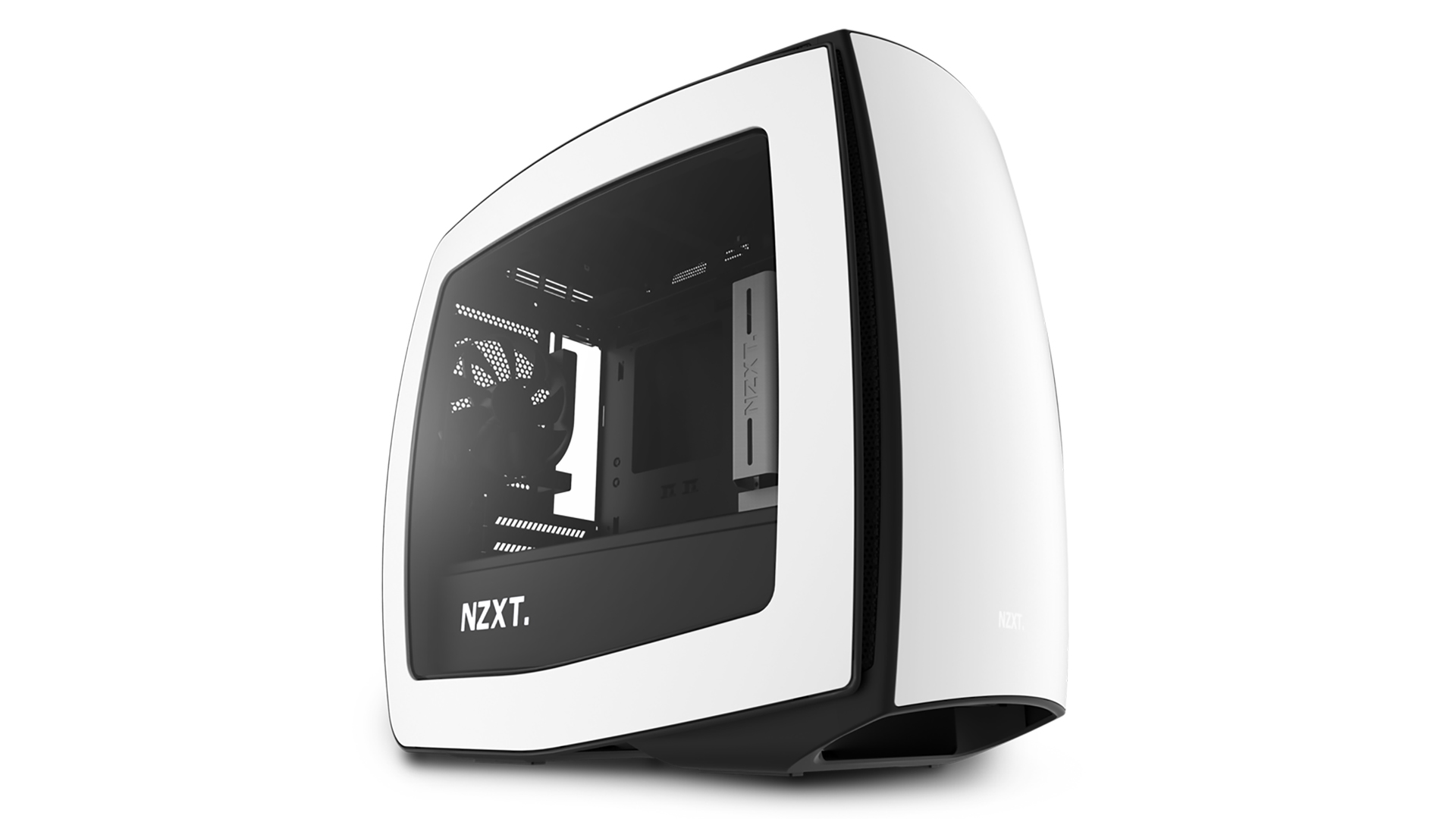
Micro ATX may have been here longer, but Mini-ITX tech is getting to the point where it’s finally competitive for PC power users and gamers alike. The problem that Mini ITX shells still need to overcome, though, is the restraints they inevitably place on cooling and power solutions. Fortunately, the NZXT Manta was tailored for your beefier components as well as tiny motherboards. The nearly full-size design may put some people off, but we find that it’s more than acceptable for this bubble-shaped titan of a case.
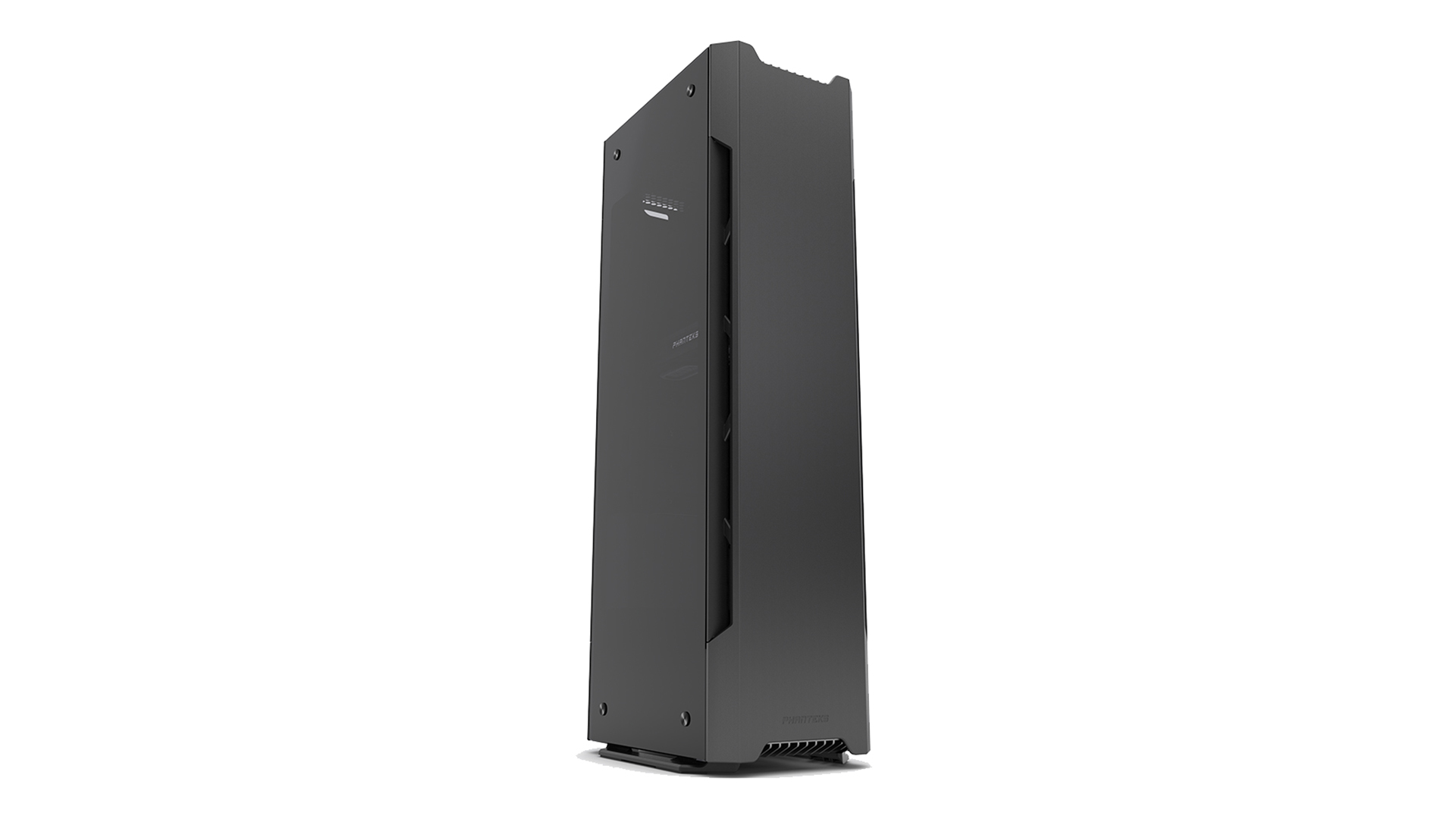
When you first look at it, the Phanteks Evolv Shift X appears more like a sound bar than a PC case, but this helps it vanish into any living area or studio setup. It’s flexible to the point that it looks natural placed under a TV just as it does atop a desk, next to an equally high-end monitor. It may only be compatible with Mini-ITX mobos, which seems crazy given its size but the Phanteks Evolv Shift X offers tons of space for components and liquid-cooled loops. If this case is a little too large for your preference, there’s also the more manageable and smaller Phanteks Evolv Shift.
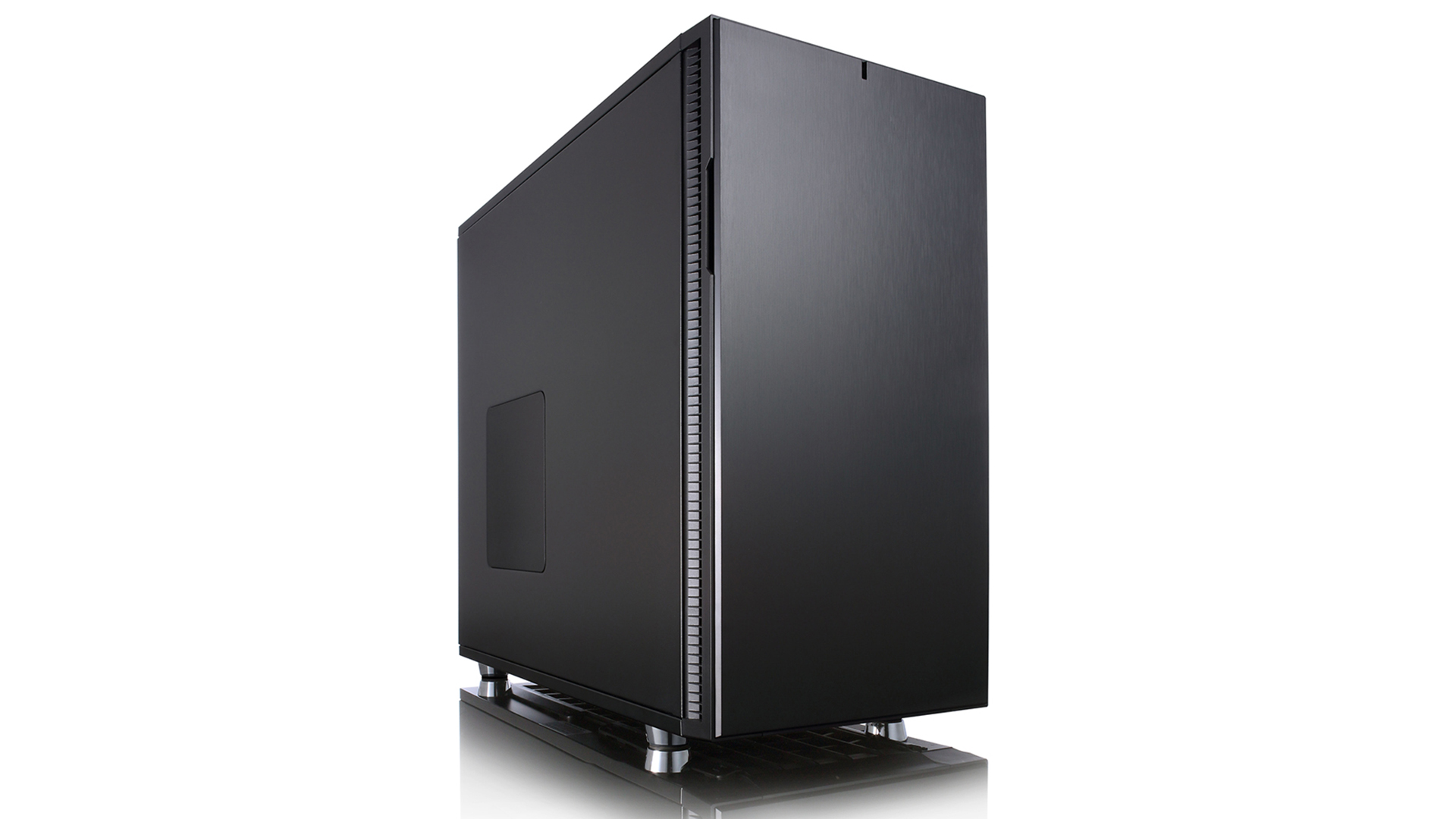
Fractal Design has scored a second entry on this list, and they deserve it. The Define R5 is yet another mid-tower case exhibiting a beautiful style. The metallic and blue LED-lit face of the case is simple, yet elegant, and is accompanied by noise dampening materials throughout its interior. In spite of the detachable ModuVent panels and drive trays not being tool-lessly accessible, the Fractal Design Define R5 is otherwise painless to build a computer inside of. Not only that, but it’s not as expensive as you would expect from a PC case with such a pretentious name either.

Even if you’re trying to avoid spending a fortune on your build, it’s probably not a great idea to not settle for the absolute cheapest PC case you can find. For the most part, cheap cases don’t really incorporate proper ventilation and airflow, not to mention you’ll end up buying your own fans and cable management supplies. The Corsair Carbide Spec-04, on the other hand, shows up even some of the more expensive cases. It does so with rubberized feet, an included LED fan and tons of room to spare for additional fans and components.
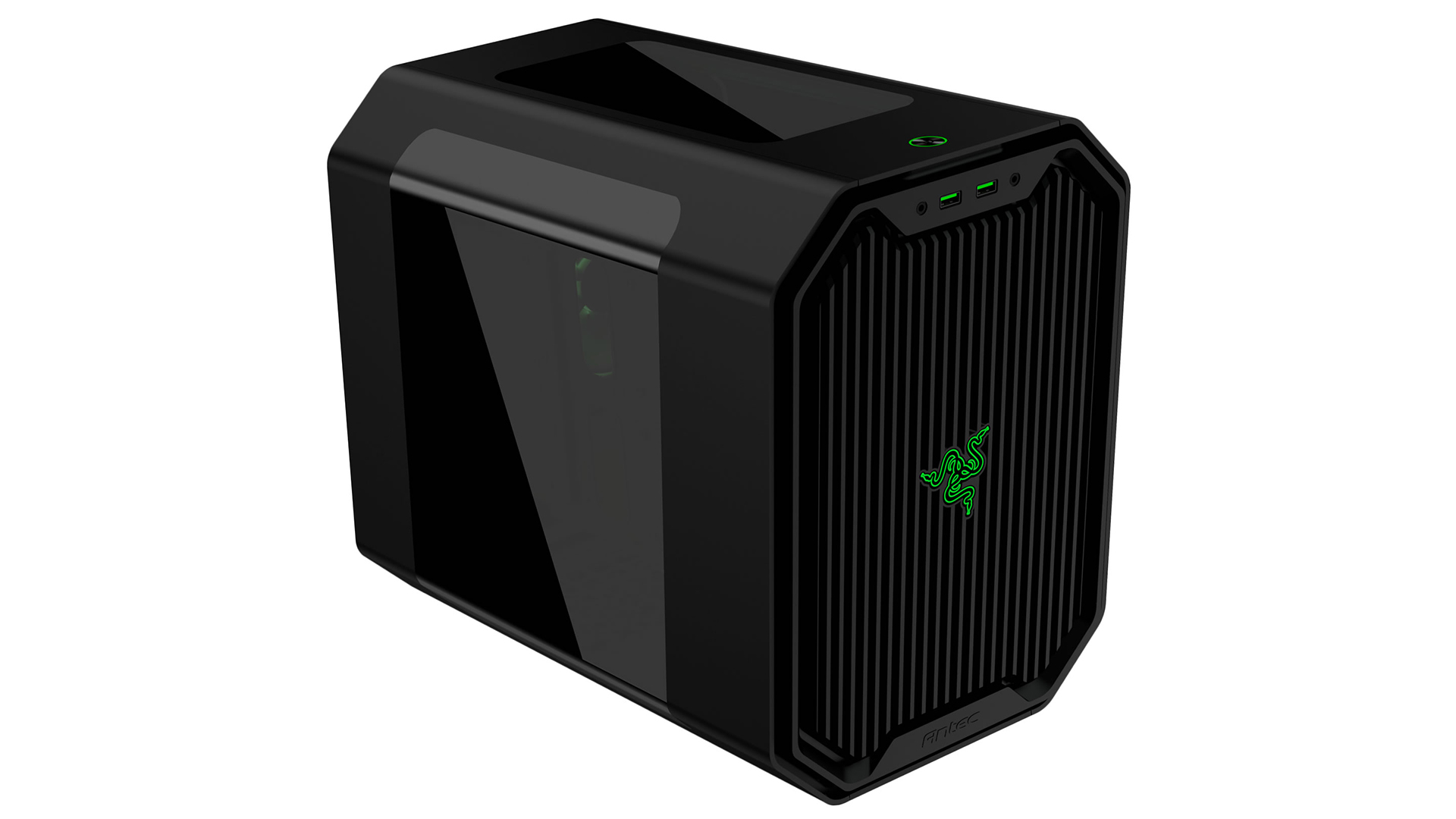
This case is for the Razer fans out there. While the green snake-adorned company doesn’t manufacture its own PCs, it has partnered with several OEMs in the past to add its signature green-infused flare to a handful of desktop PC cases. This includes the Antec Cube, a small form factor chassis that supports Mini-ITX motherboards and is shaped like an italic font (but backwards). Complete with lots of space, either for an initial build or future expansion, the Antec Cube is also compact enough to travel with.
While you’re at it, we've found the best gaming mouse you can buyNot into gaming? The best mouse of 2017 is multi-purpose
That’s why, before you start even thinking about the best graphics card for your new rig, you should begin with one of the best PC cases on the market right now. And, luckily, we here at TechRadar have went ahead and found all the best PC cases for you. Whether you’re planning on using your new PC to play games, make art, watch movies or just write like us, we’ve sorted through every PC case we could get our hands on to bring you only the very best PC cases that you can find.
We know, this sounds just a little bit too good to be true, you can feel it deep in your gut. Don’t confuse hunger for suspicion, though, as we’ve rounded up 8 unique PC cases for you – each in separate categories – that feature an array of airtight reasons for why they should be the case to house your beloved PC components. What’s better, these cases won’t hurt your wallet either, as they pursue value just as much as function.

Some of you might be thinking that this list might already be out of date by including this familiar case, we don’t blame you for your suspicion. The Cooler Master Cosmos II 25th Anniversary Edition was designed to mimic the 2012 case of its namesake to – of course– celebrate its 25th Anniversary. The 2017 edition optimizes HDD installations with its trademark X-Dock, and its tempered glass side panel looks beautiful while illuminated by its blue LEDs.

There are very few PC cases that look anything like Fractal Design’s Meshify-C. It’s even rare to see a chassis that even vaguely resembles it.. Given that the entire front of the case is made of mesh material sectioned off into many polygonal shapes, the Meshify-C has a unique aesthetic, and it does so without compromising on function. With two fans pre-installed, interior cooling is (forgive us) a breeze, even if the Meshify-C is held back by a number of obstacles.

Nanoxia Deep Silence 4, as it’s name suggests, was crafted with the sole purpose of being quiet as a mouse. This silence-focused case is a well-balanced Micro ATX case that’s affordably priced and even accommodates some of the biggest, most powerful graphics cards with its spacious interior. The fact that you’ll rarely hear it go above 30 decibels is just icing on the very taciturn cake.

Micro ATX may have been here longer, but Mini-ITX tech is getting to the point where it’s finally competitive for PC power users and gamers alike. The problem that Mini ITX shells still need to overcome, though, is the restraints they inevitably place on cooling and power solutions. Fortunately, the NZXT Manta was tailored for your beefier components as well as tiny motherboards. The nearly full-size design may put some people off, but we find that it’s more than acceptable for this bubble-shaped titan of a case.

When you first look at it, the Phanteks Evolv Shift X appears more like a sound bar than a PC case, but this helps it vanish into any living area or studio setup. It’s flexible to the point that it looks natural placed under a TV just as it does atop a desk, next to an equally high-end monitor. It may only be compatible with Mini-ITX mobos, which seems crazy given its size but the Phanteks Evolv Shift X offers tons of space for components and liquid-cooled loops. If this case is a little too large for your preference, there’s also the more manageable and smaller Phanteks Evolv Shift.

Fractal Design has scored a second entry on this list, and they deserve it. The Define R5 is yet another mid-tower case exhibiting a beautiful style. The metallic and blue LED-lit face of the case is simple, yet elegant, and is accompanied by noise dampening materials throughout its interior. In spite of the detachable ModuVent panels and drive trays not being tool-lessly accessible, the Fractal Design Define R5 is otherwise painless to build a computer inside of. Not only that, but it’s not as expensive as you would expect from a PC case with such a pretentious name either.

Even if you’re trying to avoid spending a fortune on your build, it’s probably not a great idea to not settle for the absolute cheapest PC case you can find. For the most part, cheap cases don’t really incorporate proper ventilation and airflow, not to mention you’ll end up buying your own fans and cable management supplies. The Corsair Carbide Spec-04, on the other hand, shows up even some of the more expensive cases. It does so with rubberized feet, an included LED fan and tons of room to spare for additional fans and components.

This case is for the Razer fans out there. While the green snake-adorned company doesn’t manufacture its own PCs, it has partnered with several OEMs in the past to add its signature green-infused flare to a handful of desktop PC cases. This includes the Antec Cube, a small form factor chassis that supports Mini-ITX motherboards and is shaped like an italic font (but backwards). Complete with lots of space, either for an initial build or future expansion, the Antec Cube is also compact enough to travel with.
While you’re at it, we've found the best gaming mouse you can buyNot into gaming? The best mouse of 2017 is multi-purpose
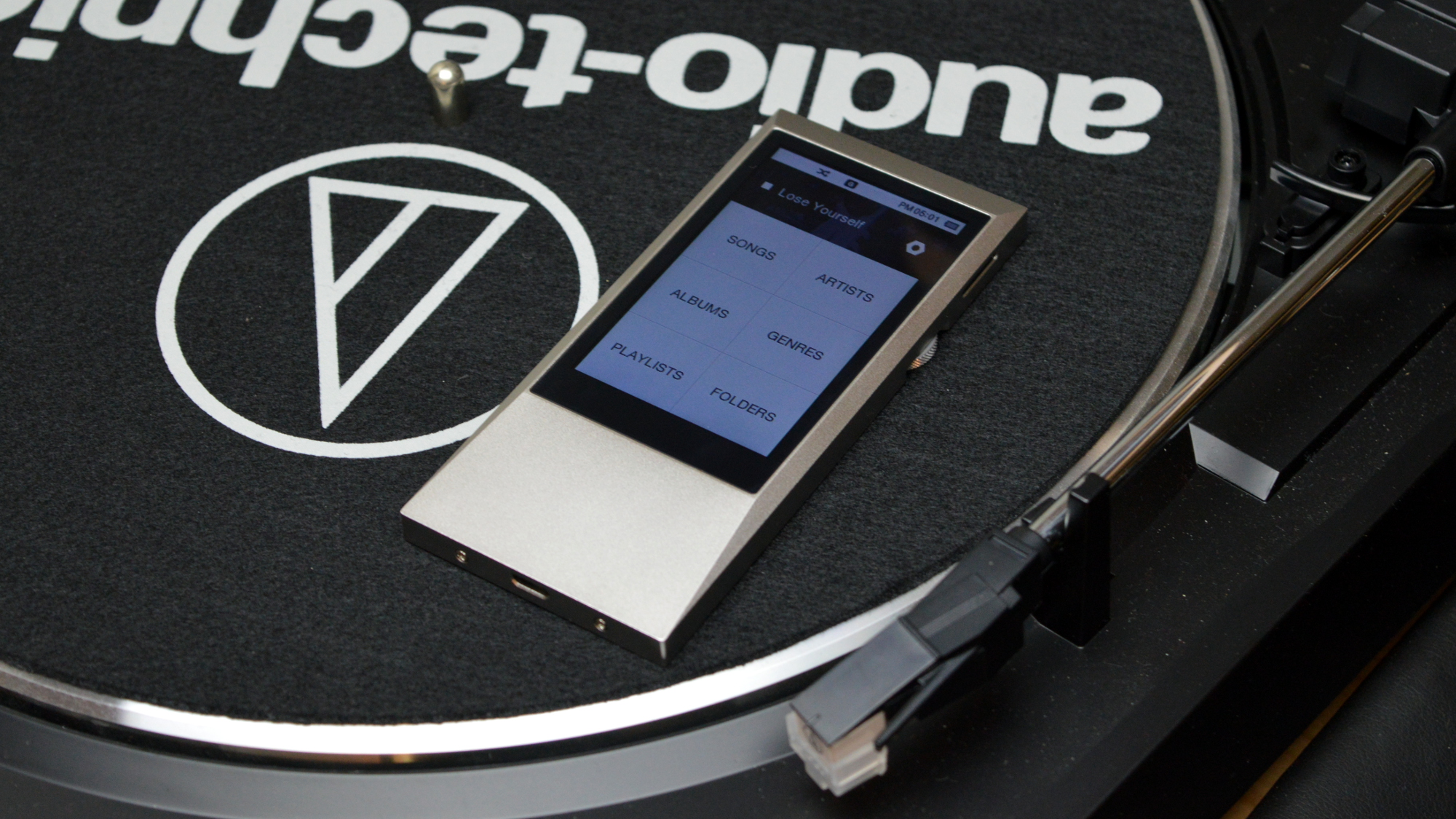
Best MP3 Players: TechRadar's guide to the best portable music players
Best MP3 Player: Welcome to our guide to the best portable MP3 players.
Way back in 1964, Bob Dylan sang a line that still rings true today, “the times, they are a-changin’.”
These days, simple MP3 players are just not at the top of the portable music listening world like they used to be. Today, the smartphone is the most popular listening device, and with good reason. Even unlocked smartphones simply have the ability to save you a ton of space without having to carry an MP3 player, phone and camera as separate devices.
MP3 players still absolutely have a purpose, however. A lot of people actually love the things for their rugged durability and their unparalleled sound fidelity. That’s not to mention the biggest audience for the best MP3 players – audiophiles (aspiring or otherwise).
Why would you want to get an MP3 player if you already have a smartphone though? It’s actually pretty simple, phones have to make some compromises in order to include all the features that customers demand, so they simply can’t support the same level of audio fidelity (The exception being the LG V20). smartphones also have limited and expensive storage, and while music streaming services somewhat fix that issue, most streaming platforms are still limited to offering relatively low fidelity audio. Audiophile-grade MP3 players, though, are built to include high quality DACs, guaranteeing that you can always get a sublime music listening experience.
Though, if you are an audiophile (even if you’re still on the way to becoming one), it’s imperative to keep in mind that the device, like an MP3 player, is only one part in a long series. You’ll also need to think about what audio codec your library is in, and you will obviously also need an amazing set of headphones, (high-fidelity DACs will mean nothing if you’re using a $10 pair of earbuds),you can check out the best ones here: Best Headphones 2017.
What MP3 players does TechRadar recommend?
So, what should you be considering if you’re thinking about buying an MP3 player? The most important thing you’ll need to take into account is what audio codec your music library is in.
If you’re using iTunes, your music library is probably in Apple’s AAC codec – and, luckily, most MP3 players support that codec. If you’re an audiophile though, you’ll likely need support for FLAC, WAV and ALAC, hi-fi lossless audio formats that don’t use the compression methods used on lossy codecs like AAC and MP3.
You’ll also need to consider how large your music collection is and then how much storage you’ll need. This is especially the case when you’re using codecs like FLAC, which just devour space. Often MP3 players also have an included microSD card slot, which allows you to expand upon the included storage as your library expands – but normally only up to a certain size, normally around 512GB.
Here's the best part though: unlike smartphones, MP3 players are built to last, so there’s no need to go on an sisyphean two-year upgrade-cycle like you might with a smartphone. This means it’s probably in your best interests to take some time and find the one that’s right for you, as you will probably be using it for a few years to come.
We’ve arranged our list of the best MP3 players by use case. Looking for portability? Check. What about something with enough space to archive your entire library? Easy! Here are some of the best MP3 players on the market right now.
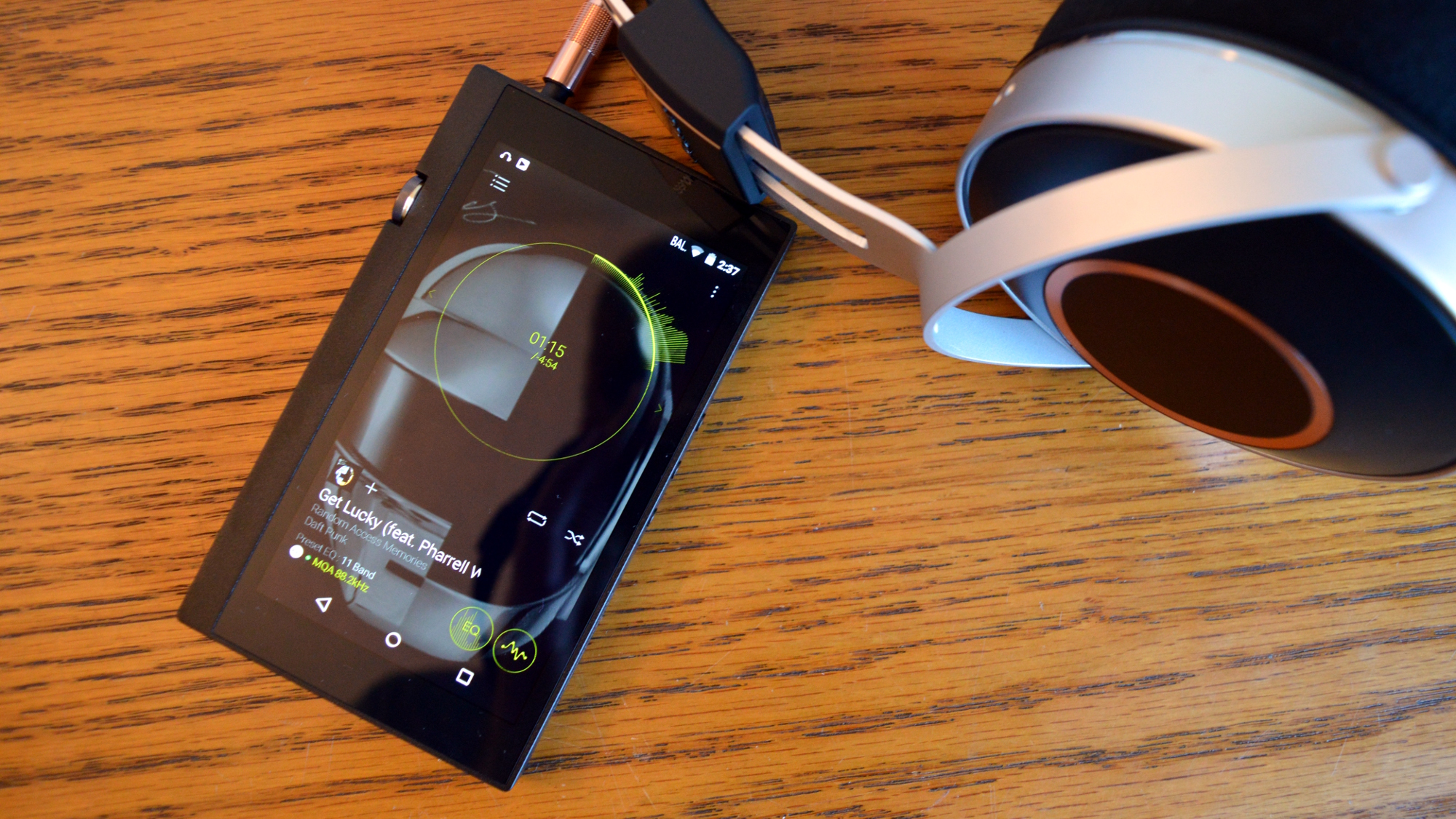
Onkyo has been a well-known and esteemed name in audio for years, and for good reason. The Onkyo DP-X1A may not be the most compact player on this list, but it is the best all-around, offering huge customizability, an intuitive interface, and an fantastic sound quality.
Let’s start with the design, which is pretty nice. In general, the DP-X1A looks a little bit like a phone, but much thicker, and is completely optimized for audio use. How so? Well, for starters, it has two audio ports – one headphone jack and one balanced output for those interested in a cleaner and overall better quality sound. Additionally, the device has an easy-to-use volume wheel, as well as physical playback buttons and two microSD card slots for those with a sizable collection of music.
It’s a very nice setup, and while it may take you a minute or two to get accustomed to the button placement, once it clicks it’ll feel as natural as breathing.
Then there’s the software and interface, which again, is simple to use.
The player is built with a full version of Android 5.1, complete with features like Wi-Fi connectivity and the Google Play Store. Which results in an MP3 Player that is to Android what the iPod Touch is to iOS.
Unlike the iPod, however, the Onkyo DP-X1A is built for super-high-quality audio – but the overall experience of owning a player that can go far beyond simply playing music is the same. The Android experience is pretty stock, though there is an Onkyo-built music app, which gives more control over things like EQ, DSP features, and so on.
Then there’s the sound quality, which is an absolute dream.It supports a range of music formats, including FLAC, OGG, WAV, MP3, ALAC, and more. In terms of hardware, the device has two chipsets, one to power the overall device, and one to handle the DAC and amplifier – resulting in a noise-free experience.
We tested the player with multiple pairs of headphones across multiple price ranges, and were stunned with the clarity and exceptional quality of the audio. There’s a reason the Onkyo DP-X1A sits atop this list – it’s a beast in the portable audio world.
Read our full review: Onkyo DP-X1A Digital Audio Player
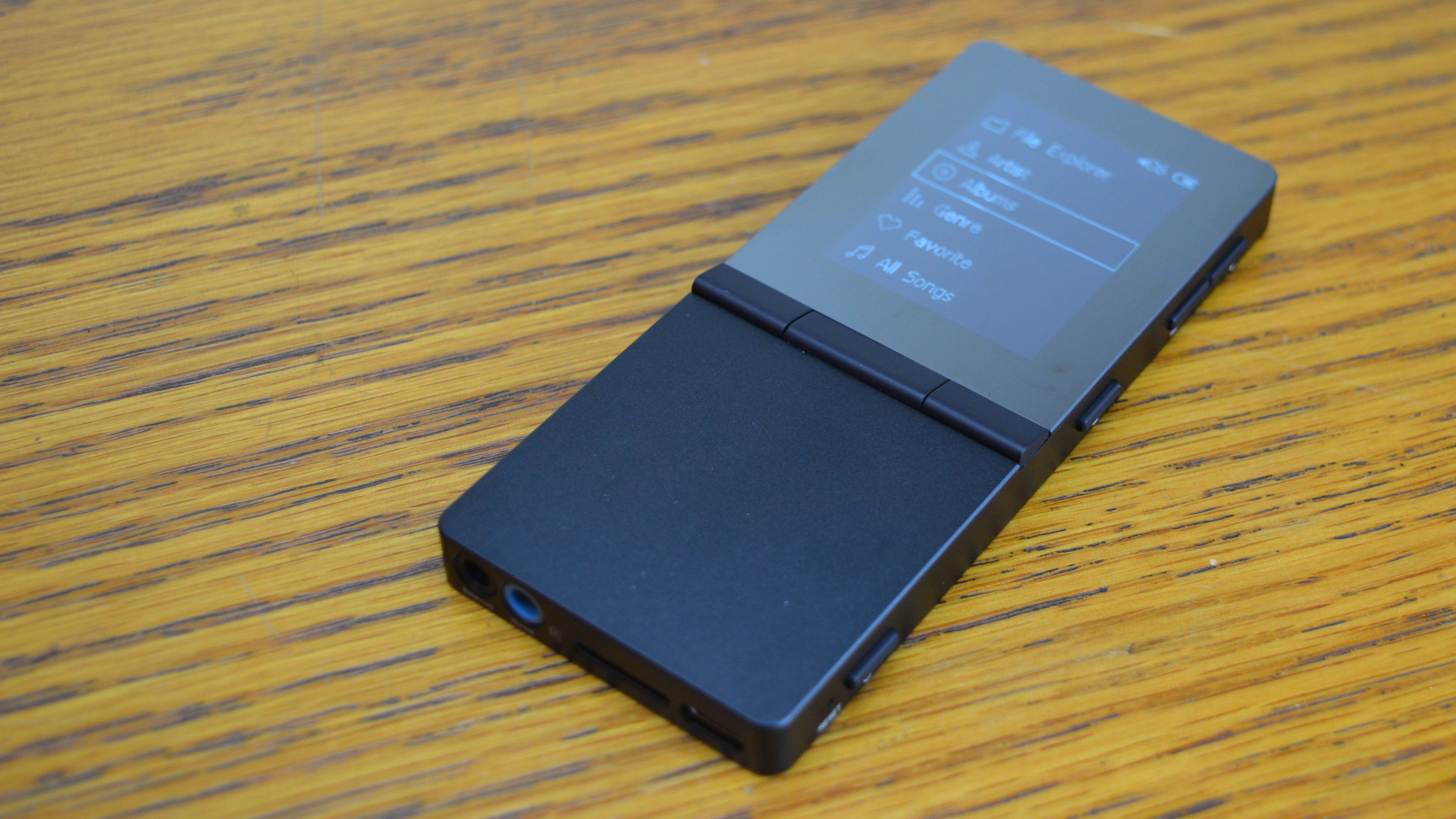
HiFiMan is perhaps best known for its headphones, but it makes some pretty great MP3 players, too. For an example, look no further than the SuperMini.
The SuperMini, as the name suggests, is a little smaller than most of the other players on this list, but that doesn’t seem to come at a huge cost – it’ll still deliver excellent audio quality and it’s pretty easy to use, too.
The device, which has a price tag of $399 (£400, AU$399), doesn’t have any onboard storage – you’ll have to buy a microSD card separately. It does, however, support a pretty huge range of audio formats, including FLAC, DSD, WAV, MP3, and AIFF, and audio with a sample rate of up to 192kHz.
The user interface may not be as flashy as some others on this list, but it’s still pretty easy to use. It’s a monochrome display, and is controlled via three buttons located under the screen. The tradeoff to using a monochrome display, however, is that the battery life is pretty long, sitting in at a hefty 22 hours.
Then on to sound, which, as you would expect from a company like HiFiMan, is great. The high-end on this player is nice and crisp, without being too aggressive by any means. On top of that, there are plenty of mids to go around, without the player at all straying into inaccurate territory. We were a little skeptical of the idea of a player from a company that offers players well into the multi-thousands dollar range, but the SuperMini holds its own, and at a decent price.
Read the full review: HiFiMan SuperMini

Astell & Kern is known for building top-notch audio devices at reasonable prices, and for that reason we think the Astell & Kern AK Jr is the best mid-range MP3 player. In fact, after spending some time using it, we would argue that it’s a pretty serious contender against even much more expensive players.
Before diving into the player’s capabilities, you’ll notice how well-designed it is. The sleek, metallic look is very classy, and using it gives you a similar “status symbol” feel you’ll get with the iPhone.
The AK Jr comes in at $259 (£250, AU$399), which is a very reasonable price for a device of this calibre. For that price, you’ll get 64GB of onboard storage, though there is a microSD card slot in case you want to expand upon that storage. On top of that, it supports all major audio formats, including FLAC, WAV, MP3, AAC, AIFF, and more – and it’s able to play at sample rates of up to 192kHz.
The interface of the device is relatively easy to control, too. The home screen simply gives you options for songs, albums, artists, and so on.
Tap through using the touchscreen, and you’ll be able to select the music you want to listen to. It would be nice if that touchscreen was a little more responsive, but you will get used to it. Battery life sits in at around nine hours, which is not amazing, but not terrible either.
So how does it sound? In one word: beautiful.
Music is dynamic and crisp, with a nice and powerful sound in every aspect. The soundstage on these, when paired with a great pair of headphones, is huge – that’s to say the left and right are clearly defined, while instruments placed at the center of a mix are given plenty of room to breathe. We particularly enjoyed the guitar solo on AC/DC’s Back in Black, while Eminem’s rap on Lose Yourself cut straight through the mix – exactly the way it was supposed to.
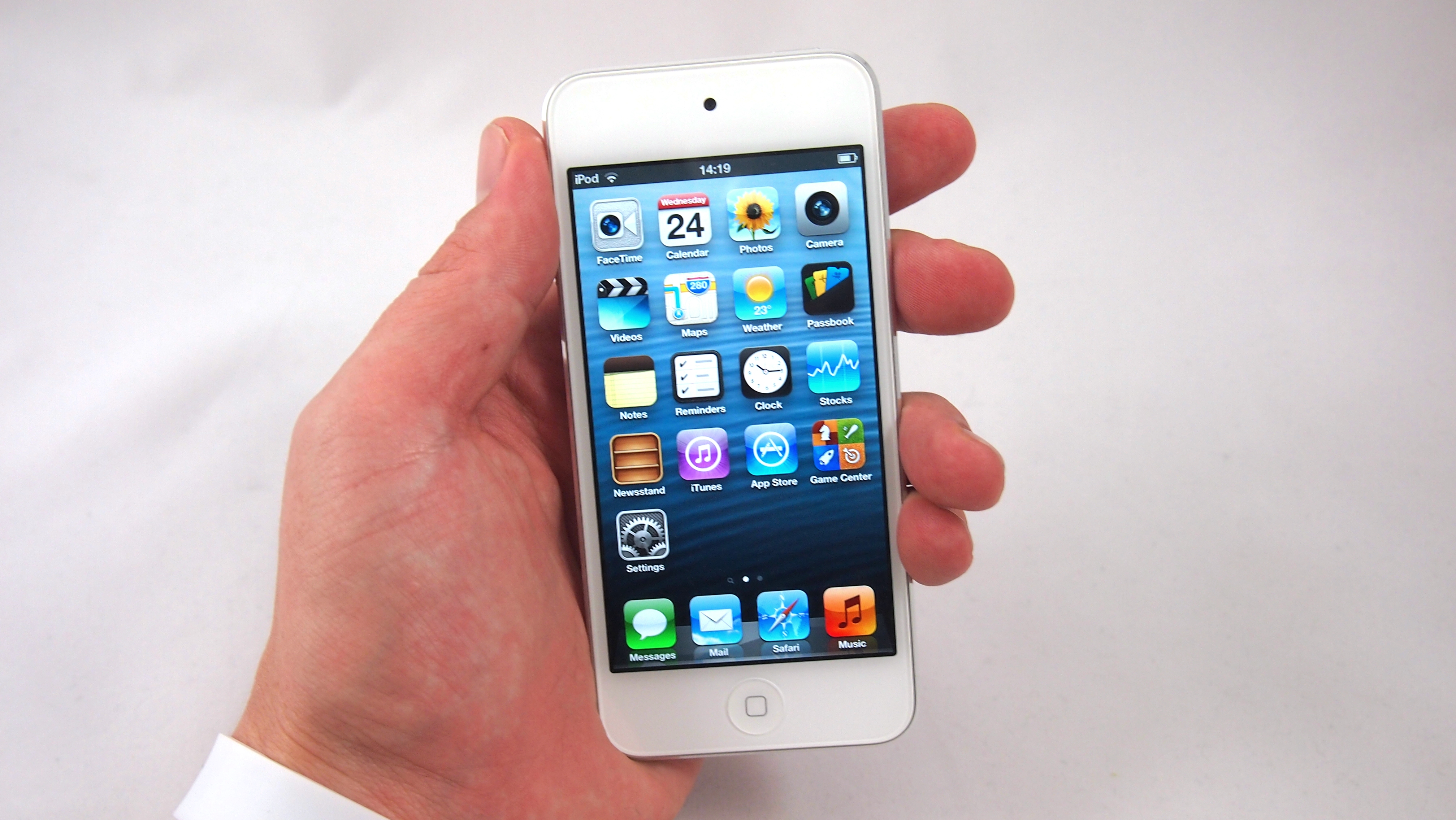
We all know the name “iPod” ... which is probably due to the fact that it changed the game when it comes to consumer audio in the early aughts. All these years later, though, they're still some of the easiest to use, most versatile and best-looking players on the market – especially the iPod Touch.
Why's that? Well, it’s practically an iPhone that’s not a phone. The device is able to run most apps on the app store, making it much more than an MP3 player.
It’s not as audiophile-targeted as most other MP3 players, for example, it doesn’t support FLAC or DSD formats, either. But it does support WAV, MP3, AAC, and so on. It also tops out at 44.1kHz – though for most people that will be more than enough considering it’s CD-level audio.
The iPod Touch is probably the easiest MP3 player on the market to use. It’s controlled using a touch screen, which is ultra-responsive, and boasts a colorful look and bright display. Of course, you probably didn’t need us to tell you that. The device starts at $199 (£209, AU$299) for the 32GB version, or $299 (£299, AU$449) for the 128GB version.
As mentioned, the iPod Touch does cap out at 44.1kHz audio, but it still sounds pretty good – and if you really want it to it can provide an audiophile experience through an external DAC connected to the Lightning port. Of course, if you’re going to go to all that trouble, why not just buy an audiophile player?
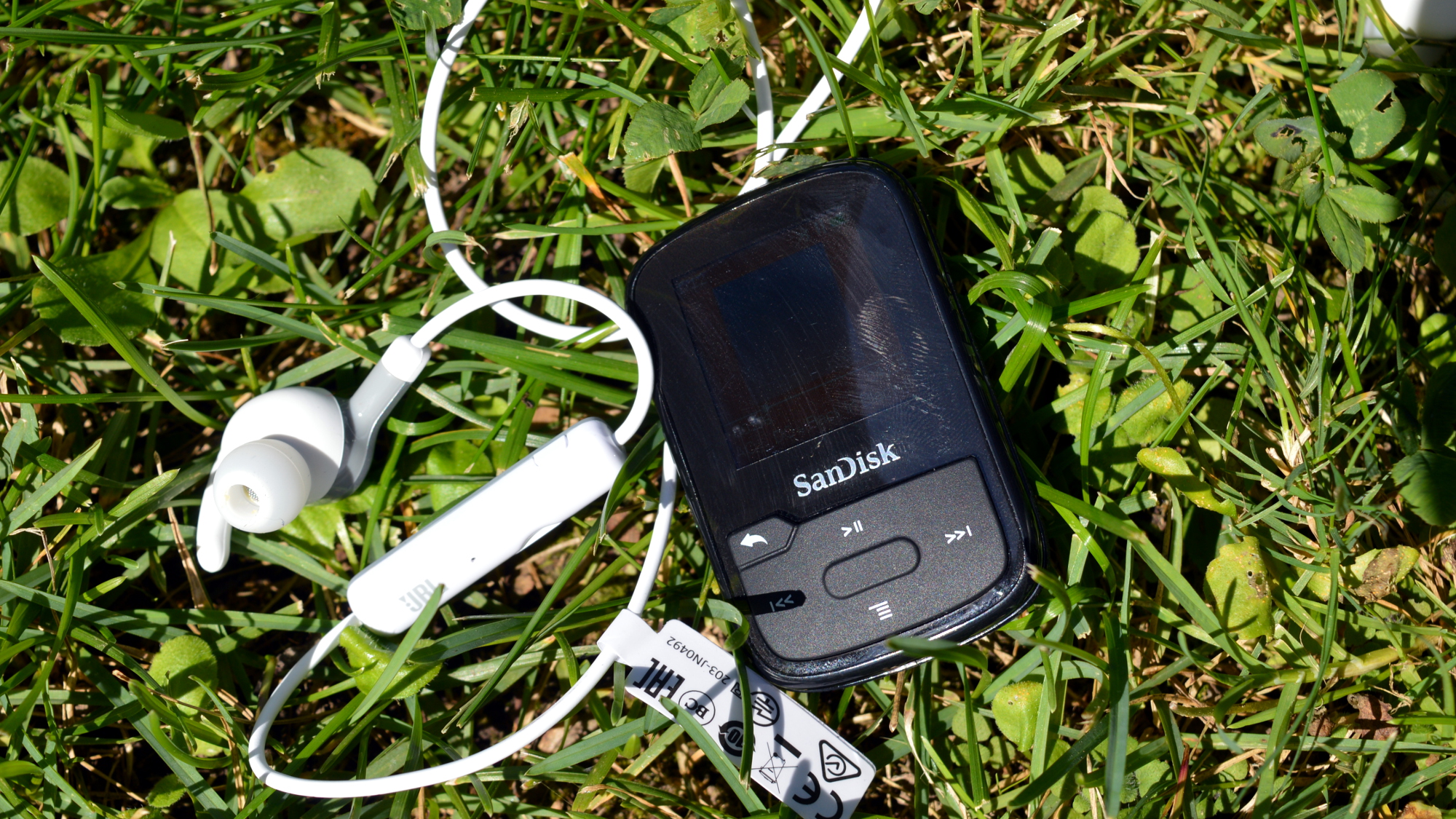
Looking for an MP3 player to take running with you? If so, you probably want something small and light – it probably doesn’t need to hold day’s worth of music, and it probably doesn’t need to offer the highest audio quality out there. Most of all, you probably don’t want to fork out a ton of cash for it.
If that’s you, in our view, the SanDisk Clip Sport Plus is the best option.
For starters, the device offers 16GB of storage, and while that may not be much for your phone, 16GB can hold a ton of songs. On top of that, despite being built for sport, it actually supports a pretty wide range of audio formats – including MP3, AAC, FLAC, WAV, and WMA. Perhaps most important for a device like this is the battery life, and it’ll last you a good 20 hours. You’ll even get Bluetooth, which is a huge deal for many who will be using this while running or performing other activities and don’t want cables to get in the way.
The interface is relatively easy to use too. Sure, it’s a little dated, and isn’t as powerful as what you’ll find on your smartphone, but it’s still capable as a music player. It’s not touch-sensitive, though. Instead, you’ll navigate through hardware buttons that also serve as playback controls when music is playing – but we didn’t have any issue with that.
As for the sound, as long as you don’t expect full audiophile-level quality here (you won’t get it), we think you'll find the sound very capable. Overall it's slightly muddy with a small dip in clarity, but for most that won’t matter – especially when you're out on a run or hitting the weights at the gym.
Looking for a something to listen to on your new MP3 player? Check out our list of the best podcasts around.
Way back in 1964, Bob Dylan sang a line that still rings true today, “the times, they are a-changin’.”
These days, simple MP3 players are just not at the top of the portable music listening world like they used to be. Today, the smartphone is the most popular listening device, and with good reason. Even unlocked smartphones simply have the ability to save you a ton of space without having to carry an MP3 player, phone and camera as separate devices.
MP3 players still absolutely have a purpose, however. A lot of people actually love the things for their rugged durability and their unparalleled sound fidelity. That’s not to mention the biggest audience for the best MP3 players – audiophiles (aspiring or otherwise).
Why would you want to get an MP3 player if you already have a smartphone though? It’s actually pretty simple, phones have to make some compromises in order to include all the features that customers demand, so they simply can’t support the same level of audio fidelity (The exception being the LG V20). smartphones also have limited and expensive storage, and while music streaming services somewhat fix that issue, most streaming platforms are still limited to offering relatively low fidelity audio. Audiophile-grade MP3 players, though, are built to include high quality DACs, guaranteeing that you can always get a sublime music listening experience.
Though, if you are an audiophile (even if you’re still on the way to becoming one), it’s imperative to keep in mind that the device, like an MP3 player, is only one part in a long series. You’ll also need to think about what audio codec your library is in, and you will obviously also need an amazing set of headphones, (high-fidelity DACs will mean nothing if you’re using a $10 pair of earbuds),you can check out the best ones here: Best Headphones 2017.
What MP3 players does TechRadar recommend?
So, what should you be considering if you’re thinking about buying an MP3 player? The most important thing you’ll need to take into account is what audio codec your music library is in.
If you’re using iTunes, your music library is probably in Apple’s AAC codec – and, luckily, most MP3 players support that codec. If you’re an audiophile though, you’ll likely need support for FLAC, WAV and ALAC, hi-fi lossless audio formats that don’t use the compression methods used on lossy codecs like AAC and MP3.
You’ll also need to consider how large your music collection is and then how much storage you’ll need. This is especially the case when you’re using codecs like FLAC, which just devour space. Often MP3 players also have an included microSD card slot, which allows you to expand upon the included storage as your library expands – but normally only up to a certain size, normally around 512GB.
Here's the best part though: unlike smartphones, MP3 players are built to last, so there’s no need to go on an sisyphean two-year upgrade-cycle like you might with a smartphone. This means it’s probably in your best interests to take some time and find the one that’s right for you, as you will probably be using it for a few years to come.
We’ve arranged our list of the best MP3 players by use case. Looking for portability? Check. What about something with enough space to archive your entire library? Easy! Here are some of the best MP3 players on the market right now.

Onkyo has been a well-known and esteemed name in audio for years, and for good reason. The Onkyo DP-X1A may not be the most compact player on this list, but it is the best all-around, offering huge customizability, an intuitive interface, and an fantastic sound quality.
Let’s start with the design, which is pretty nice. In general, the DP-X1A looks a little bit like a phone, but much thicker, and is completely optimized for audio use. How so? Well, for starters, it has two audio ports – one headphone jack and one balanced output for those interested in a cleaner and overall better quality sound. Additionally, the device has an easy-to-use volume wheel, as well as physical playback buttons and two microSD card slots for those with a sizable collection of music.
It’s a very nice setup, and while it may take you a minute or two to get accustomed to the button placement, once it clicks it’ll feel as natural as breathing.
Then there’s the software and interface, which again, is simple to use.
The player is built with a full version of Android 5.1, complete with features like Wi-Fi connectivity and the Google Play Store. Which results in an MP3 Player that is to Android what the iPod Touch is to iOS.
Unlike the iPod, however, the Onkyo DP-X1A is built for super-high-quality audio – but the overall experience of owning a player that can go far beyond simply playing music is the same. The Android experience is pretty stock, though there is an Onkyo-built music app, which gives more control over things like EQ, DSP features, and so on.
Then there’s the sound quality, which is an absolute dream.It supports a range of music formats, including FLAC, OGG, WAV, MP3, ALAC, and more. In terms of hardware, the device has two chipsets, one to power the overall device, and one to handle the DAC and amplifier – resulting in a noise-free experience.
We tested the player with multiple pairs of headphones across multiple price ranges, and were stunned with the clarity and exceptional quality of the audio. There’s a reason the Onkyo DP-X1A sits atop this list – it’s a beast in the portable audio world.
Read our full review: Onkyo DP-X1A Digital Audio Player

HiFiMan is perhaps best known for its headphones, but it makes some pretty great MP3 players, too. For an example, look no further than the SuperMini.
The SuperMini, as the name suggests, is a little smaller than most of the other players on this list, but that doesn’t seem to come at a huge cost – it’ll still deliver excellent audio quality and it’s pretty easy to use, too.
The device, which has a price tag of $399 (£400, AU$399), doesn’t have any onboard storage – you’ll have to buy a microSD card separately. It does, however, support a pretty huge range of audio formats, including FLAC, DSD, WAV, MP3, and AIFF, and audio with a sample rate of up to 192kHz.
The user interface may not be as flashy as some others on this list, but it’s still pretty easy to use. It’s a monochrome display, and is controlled via three buttons located under the screen. The tradeoff to using a monochrome display, however, is that the battery life is pretty long, sitting in at a hefty 22 hours.
Then on to sound, which, as you would expect from a company like HiFiMan, is great. The high-end on this player is nice and crisp, without being too aggressive by any means. On top of that, there are plenty of mids to go around, without the player at all straying into inaccurate territory. We were a little skeptical of the idea of a player from a company that offers players well into the multi-thousands dollar range, but the SuperMini holds its own, and at a decent price.
Read the full review: HiFiMan SuperMini

Astell & Kern is known for building top-notch audio devices at reasonable prices, and for that reason we think the Astell & Kern AK Jr is the best mid-range MP3 player. In fact, after spending some time using it, we would argue that it’s a pretty serious contender against even much more expensive players.
Before diving into the player’s capabilities, you’ll notice how well-designed it is. The sleek, metallic look is very classy, and using it gives you a similar “status symbol” feel you’ll get with the iPhone.
The AK Jr comes in at $259 (£250, AU$399), which is a very reasonable price for a device of this calibre. For that price, you’ll get 64GB of onboard storage, though there is a microSD card slot in case you want to expand upon that storage. On top of that, it supports all major audio formats, including FLAC, WAV, MP3, AAC, AIFF, and more – and it’s able to play at sample rates of up to 192kHz.
The interface of the device is relatively easy to control, too. The home screen simply gives you options for songs, albums, artists, and so on.
Tap through using the touchscreen, and you’ll be able to select the music you want to listen to. It would be nice if that touchscreen was a little more responsive, but you will get used to it. Battery life sits in at around nine hours, which is not amazing, but not terrible either.
So how does it sound? In one word: beautiful.
Music is dynamic and crisp, with a nice and powerful sound in every aspect. The soundstage on these, when paired with a great pair of headphones, is huge – that’s to say the left and right are clearly defined, while instruments placed at the center of a mix are given plenty of room to breathe. We particularly enjoyed the guitar solo on AC/DC’s Back in Black, while Eminem’s rap on Lose Yourself cut straight through the mix – exactly the way it was supposed to.

We all know the name “iPod” ... which is probably due to the fact that it changed the game when it comes to consumer audio in the early aughts. All these years later, though, they're still some of the easiest to use, most versatile and best-looking players on the market – especially the iPod Touch.
Why's that? Well, it’s practically an iPhone that’s not a phone. The device is able to run most apps on the app store, making it much more than an MP3 player.
It’s not as audiophile-targeted as most other MP3 players, for example, it doesn’t support FLAC or DSD formats, either. But it does support WAV, MP3, AAC, and so on. It also tops out at 44.1kHz – though for most people that will be more than enough considering it’s CD-level audio.
The iPod Touch is probably the easiest MP3 player on the market to use. It’s controlled using a touch screen, which is ultra-responsive, and boasts a colorful look and bright display. Of course, you probably didn’t need us to tell you that. The device starts at $199 (£209, AU$299) for the 32GB version, or $299 (£299, AU$449) for the 128GB version.
As mentioned, the iPod Touch does cap out at 44.1kHz audio, but it still sounds pretty good – and if you really want it to it can provide an audiophile experience through an external DAC connected to the Lightning port. Of course, if you’re going to go to all that trouble, why not just buy an audiophile player?

Looking for an MP3 player to take running with you? If so, you probably want something small and light – it probably doesn’t need to hold day’s worth of music, and it probably doesn’t need to offer the highest audio quality out there. Most of all, you probably don’t want to fork out a ton of cash for it.
If that’s you, in our view, the SanDisk Clip Sport Plus is the best option.
For starters, the device offers 16GB of storage, and while that may not be much for your phone, 16GB can hold a ton of songs. On top of that, despite being built for sport, it actually supports a pretty wide range of audio formats – including MP3, AAC, FLAC, WAV, and WMA. Perhaps most important for a device like this is the battery life, and it’ll last you a good 20 hours. You’ll even get Bluetooth, which is a huge deal for many who will be using this while running or performing other activities and don’t want cables to get in the way.
The interface is relatively easy to use too. Sure, it’s a little dated, and isn’t as powerful as what you’ll find on your smartphone, but it’s still capable as a music player. It’s not touch-sensitive, though. Instead, you’ll navigate through hardware buttons that also serve as playback controls when music is playing – but we didn’t have any issue with that.
As for the sound, as long as you don’t expect full audiophile-level quality here (you won’t get it), we think you'll find the sound very capable. Overall it's slightly muddy with a small dip in clarity, but for most that won’t matter – especially when you're out on a run or hitting the weights at the gym.
Looking for a something to listen to on your new MP3 player? Check out our list of the best podcasts around.
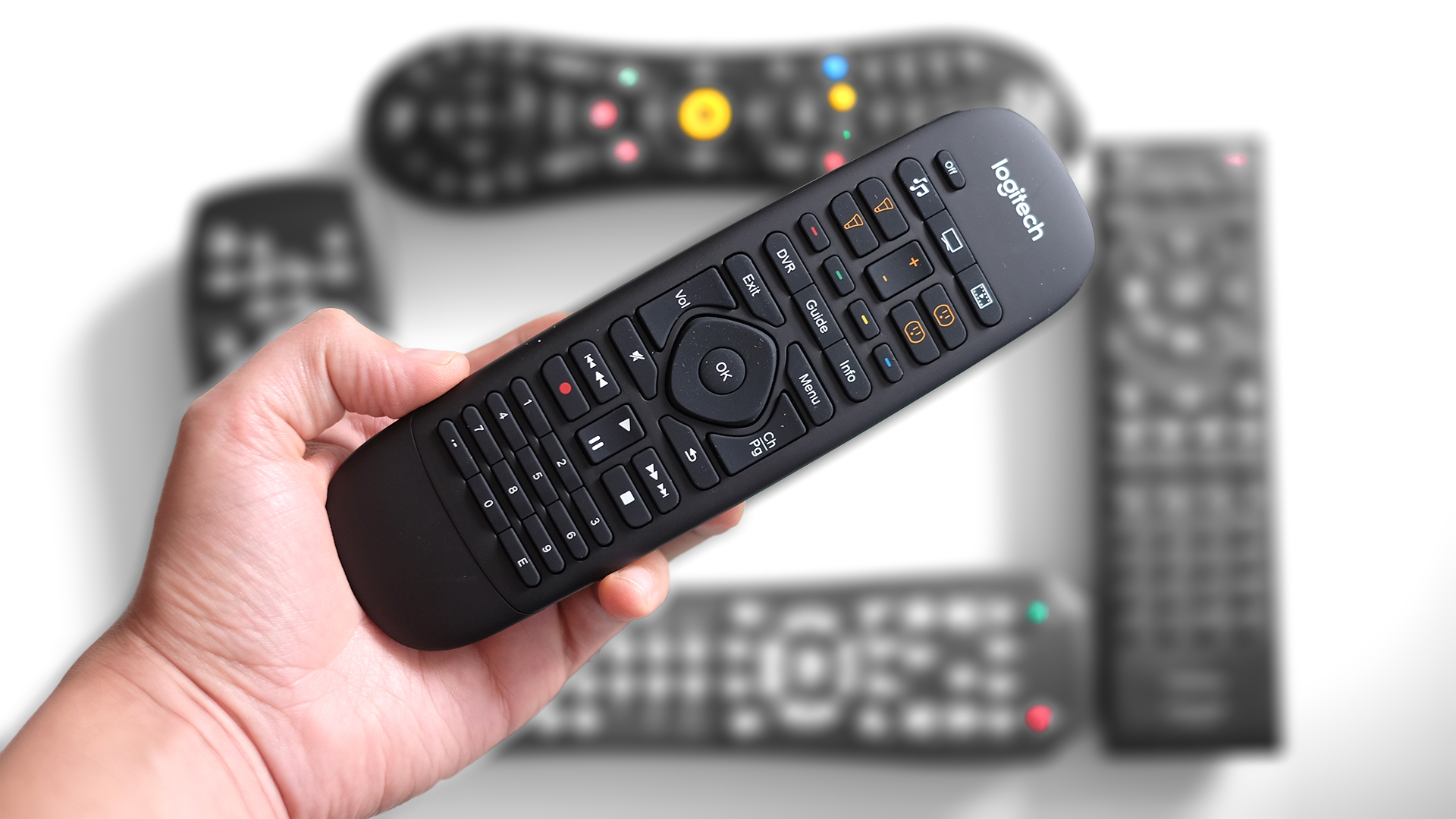
Best universal remotes: the ultimate beginner’s guide
Today there is really no limit on what we can do with technology. You can interact with hundreds of devices that run your home you can visit a new virtual reality,and you can even monitor your heart rate every hour of every day, if you really want.
But there’s still one issue that technology hasn’t remedied: the inconvenience of losing your TV remote. We’ve all done it, spending an entire afternoon to find a remote control that somehow inexplicably found its way inside your couch. Anyone with a decent home AV setup, however, still has to deal with dozens of the things.
The best solution available is a universal remote. They are not just a great replacement for a lost remote, but they can also help you keep your living room less cluttered and more organized. So, let's take a look at exactly what today’s best universal remotes can do, and how they operate.
What is a universal remote?
The main idea of a universal remote is simple enough. It’s a remote control that can imitate the signals produced by the remote that was included with your television, your home audio receiver and whatever other hardware you have that uses an IR signal.
But why should you get one? Well, either you’ve lost an original remote, and don’t want to pay the often insane cost of a manufacturer replacement. Or, maybe you are looking to have less remote controls because you want a more organized, and less cluttered living room.
Almost every universal remote uses IR, or, infrared. It’s the same signal used by single-device remotes.
Cheap vs expensive
If you’re thinking about buying a cheap universal remote, such as the One For All Essence (only available in the UK), you’ll use a series of button pushes to program the remote, locating the correct set of instructions for your device. Companies like Sony and Panasonic have only used a few different patterns of instructions over the last decade or so for most of their TVs. You can just cycle through them until you find the set of instructions that turns the TV in question off and on.
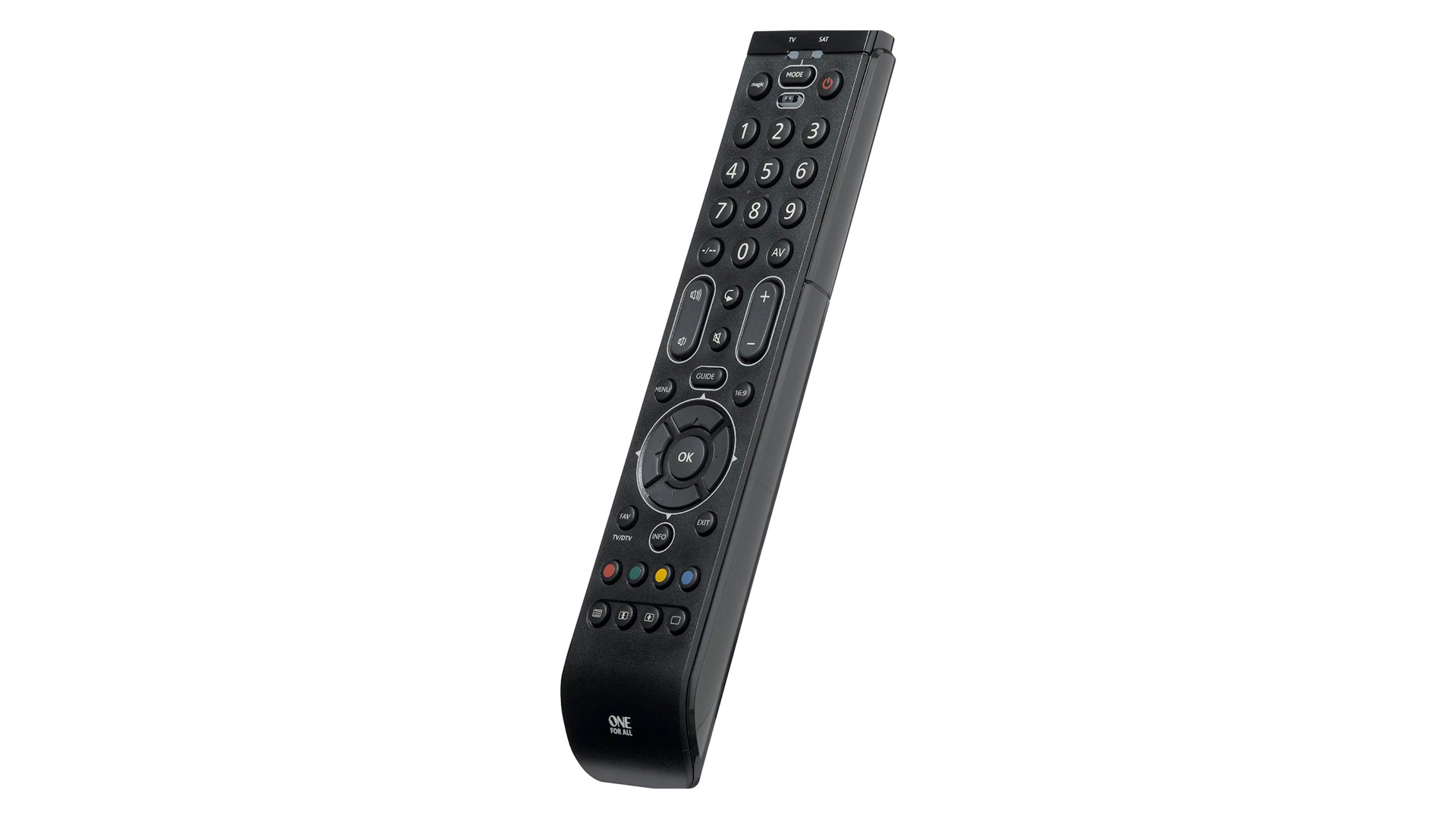
The low-cost One for All Essence can replace two remotes
Many mid-tier universal remotes feature large databases and companion apps that let you simply choose the equipment you have on your mobile device. It’s faster, simpler and less of a headache to add new devices, in case your entertainment setup changes.
Let’s be blunt, the more money you spend, the more devices a universal remote will be able to support. Logitech’s Harmony Elite has support for up to 15 devices with just the one remote, while low-end models, like the One for All Simple, only support one. It will always just boil down to that classic use-case question: are you replacing a lost remote or do you just want to use just one remote instead of a half dozen unique ones?
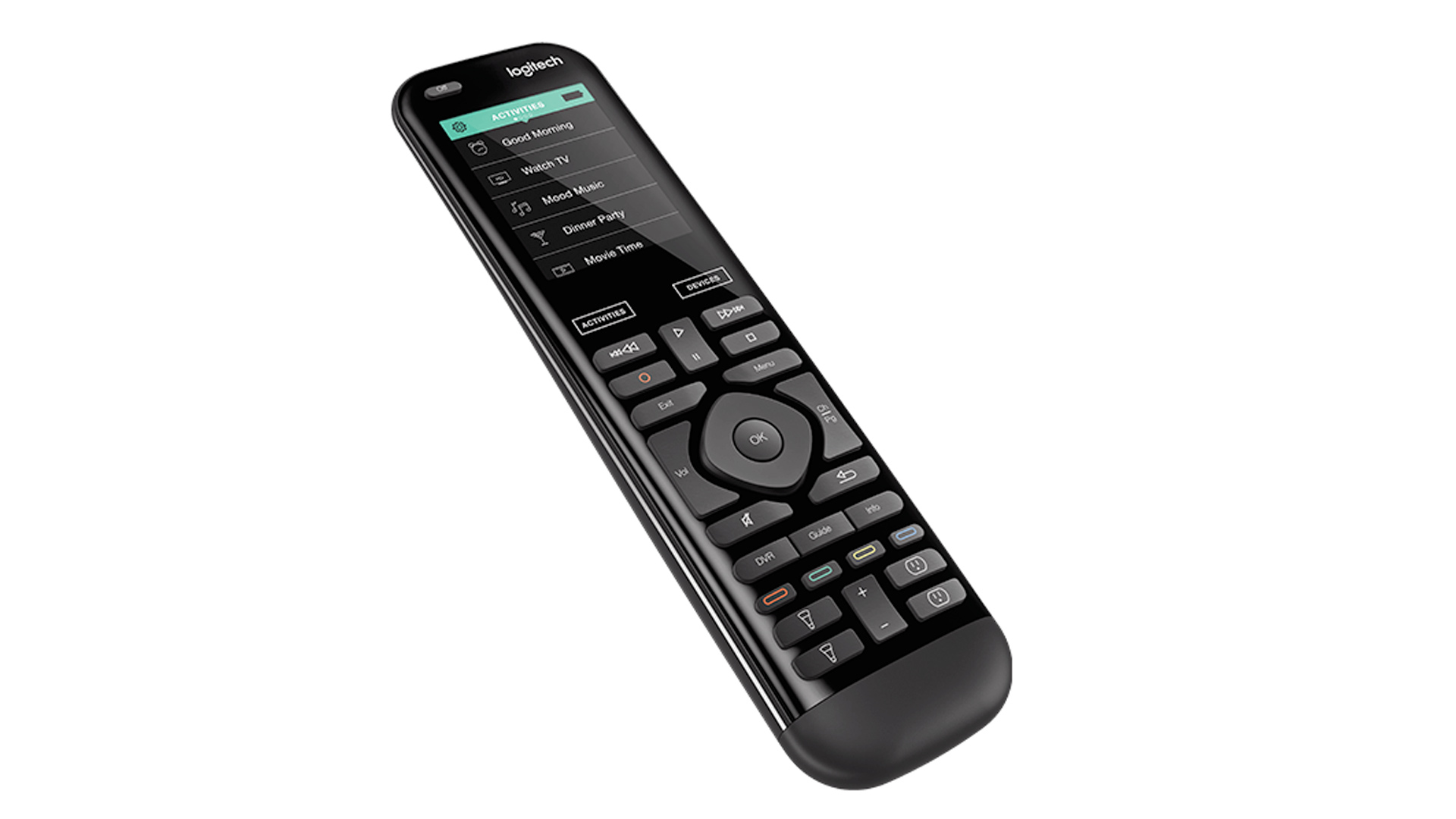
The Logitech Harmony Elite is one of the top-end universal remotes
When you start getting to the High end of the spectrum, you’ll start seeing remotes that allow you to set up custom macros, or ‘activities’. These ‘activities’ will let you make a single button or touch screen press send off several commands.
One remote, called 'Watch TV,' for example, may turn on your cable box, audio receiver and TV, change the receiver to the right channel and switch your TV to the right HDMI input. Another classic is to turn all of your equipment off with a single press of a button.
Who makes universal remotes?
There are two main players in the universal remote control game, and they’re the ones we’ve listed out thus far. Logitech makes all the best high-end remotes, in the shape of its Harmony models, while One for All is the best brand for more inexpensive remotes.
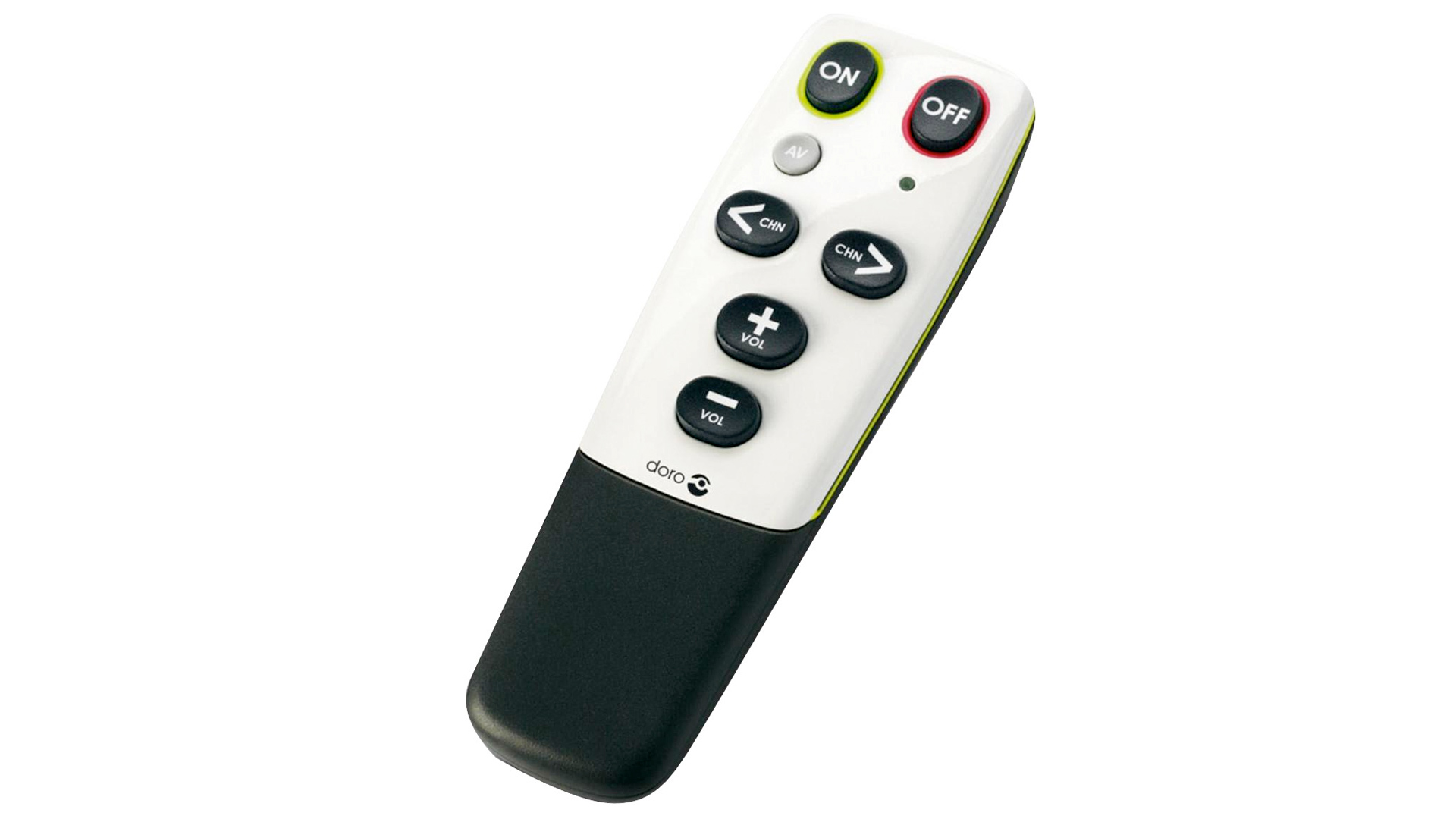
The Doro HandleEasy is as basic as universal remotes get
In the US, you’ll also see a plethora of low-price remote controls from RCA. And if you’re buying for an elderly relative, or want a super-simple remote that only covers the TV basics, the Doro HandleEasy only allows you to change volume and channels; it's been around for years, but it's a great lo-fi gadget.
Phones that are universal remotes
Some phones will also function as universal remotes, although perhaps not the models you may think. They need to have a feature called an IR blaster, which enables them to transmit the same signals as a normal remote control.
These used to be somewhat common, but have become quite rare, with the feature regarded as unloved and generally useless in the phones that had it. Current phones with an IR blaster include the Honor 9 and Huawei P10 Plus. Some Xiaomi phones have one too. The common thread? These are Chinese companies.
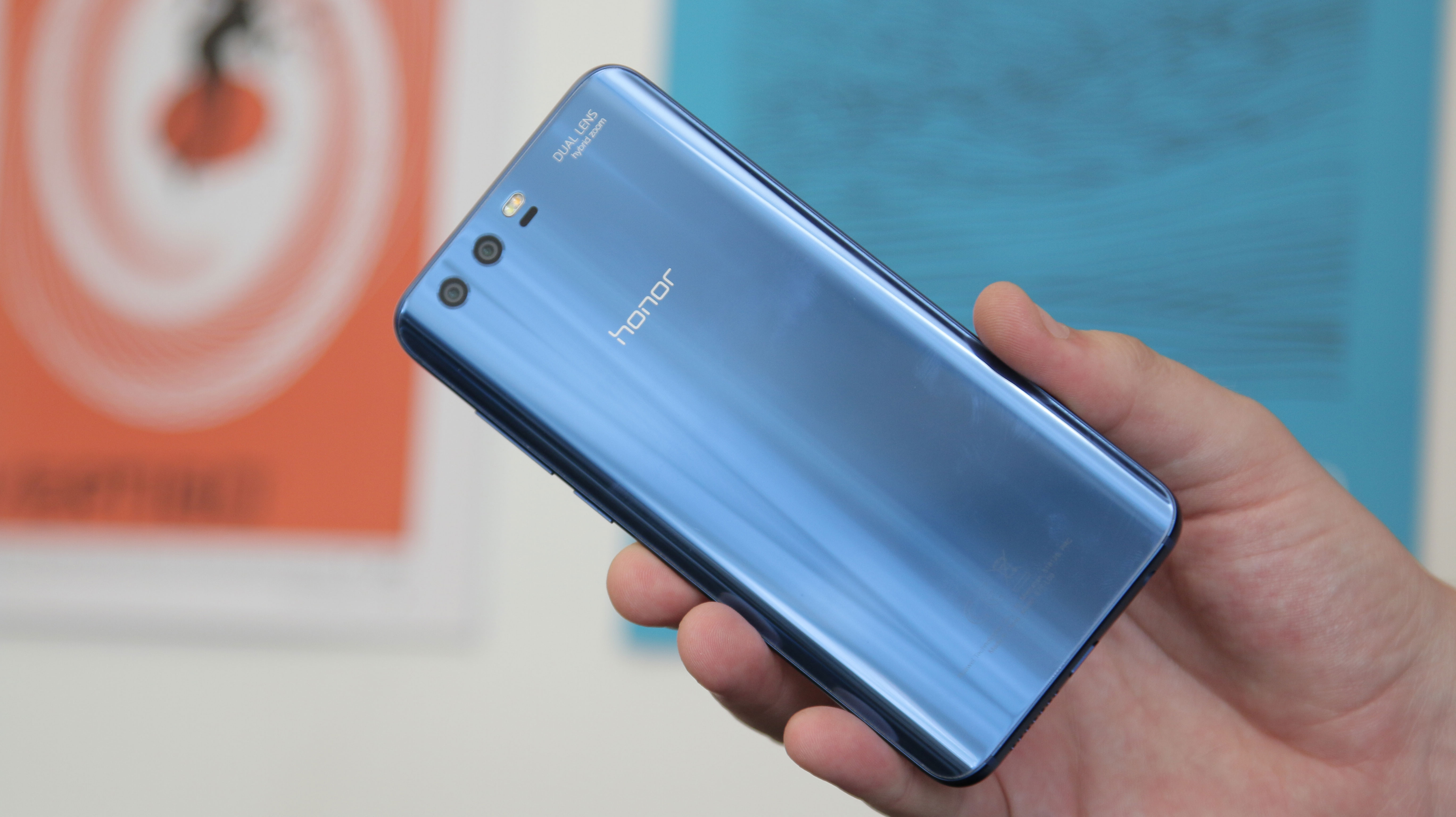
The Honor 9 is one of the few new phones to have an IR blaster
The last high-profile phone to have an IR blaster was the LG G5, while the last flagship Samsungs with IR were the Galaxy S6 and S6 Edge back in 2015. These phones have apps that enable you to configure your own setup, with on-screen buttons for (almost) all your remotes’ functions.
We actually know people who owned phones with IR blasters a few years ago, but who ended up spending a significant amount of cash on a universal remote, oblivious to their phone’s abilities.
Have a phone with an IR blaster? You might want to check out a third-party remote control app like Peel or Sure, as these have a smarter interface than most built-in apps.
Controlling consoles and smart homes
A weakness that the vast majority of universal remotes share is that they can't control most smart home devices, or Sony’s PS3 and PS4. This is because they use either Bluetooth, RF or Wi-Fi instead of IR. The answer is a hub that supports these other standards, and right now you have two major options.
Logitech offers the best, and the most popular one. The Logitech Home Hub is compatible with Microsoft and Sony game consoles, and a wide range of smart home gadgets including Philips Hue lights. It connects to your home Wi-Fi network, and can be controlled either by a mobile app or one of Logitech’s higher-end remotes.
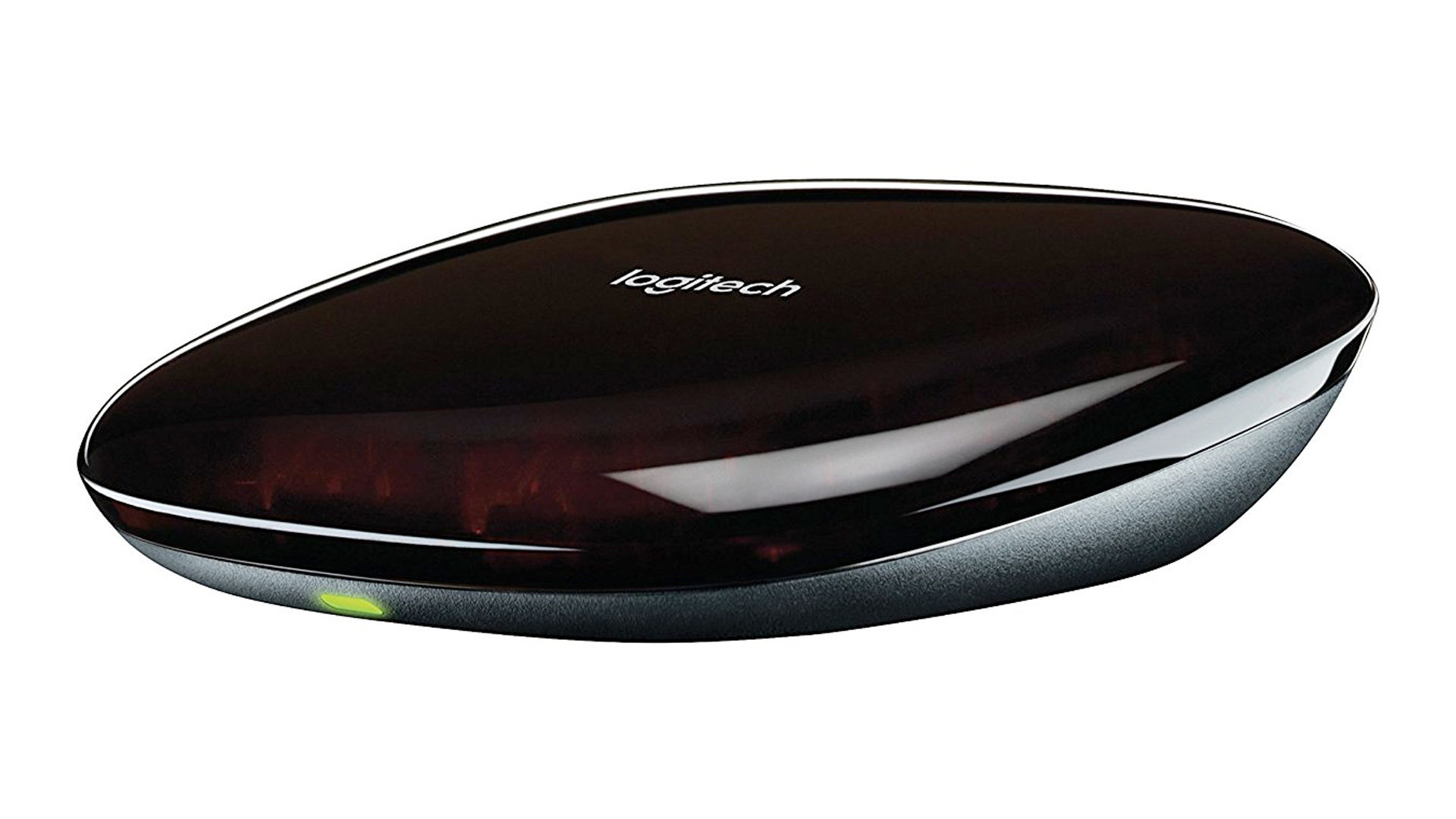
Logitech’s Harmony Hub levels-up the abilities of universal remotes
Using one of the Harmony series’ tasty macro activities, you could therefore set the lighting level for movie night, as well as turning on your AV setup, with a single press.
Elsewhere, the Broadlink RM and RM Pro are hubs that can control IR and RF (Pro model) devices through a mobile phone app. They're significantly cheaper than the Logitech Home Hub, although as they don't use Bluetooth you can’t use them to control a Sony PS4.
It is a low-cost way to make up for the lack of an IR blaster, though.
Voice control
One additional benefit of the Logitech Home Hub system is that you can already control it through Amazon’s digital assistant Alexa.
If you have an Amazon Echo or Echo Dot you can add a Harmony ‘skill’ to it, and using this you can say “Alexa, tell Harmony to turn on the TV”, and it’ll do so. We’ve tried it out as part of our research for this guide, and it works rather well.
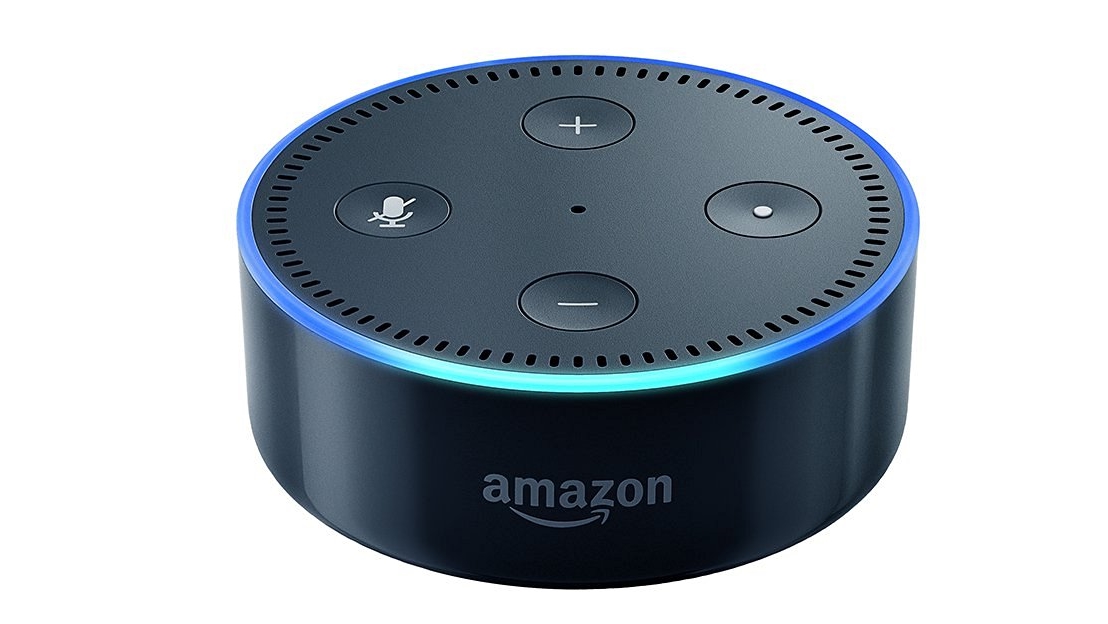
You can now use your voice as a universal remote, with the right hardware
One day we'll be able to control everything over Wi-Fi, but until that day it's reassuring to see that universal remotes aren’t content to become ‘retro’ gadgets; they’re keeping up with the times.
Logitech Harmony at a glance
As the Logitech Harmony series is easily the most important range of universal remotes for people looking for an experience to suit a high-end setup, let’s take a quick look at what’s on offer.
The Harmony family has two main lines – there are newer remotes that work with the Harmony Hub, and older pure IR remotes that don’t.

The Harmony Ultimate is one of Logitech’s full-fat universal remotes
The newer kind includes the Elite, Ultimate, Touch, Ultimate One and 950 models, all of which have screens. Logitech’s Companion remote supports the hub but doesn’t have a display, making it a little more affordable.
Those after something even less pocket-draining should check out the Harmony 650, which has a display but no Hub support, and the Harmony 350, a basic £35/$38 remote that's a classic universal remote but can still combine the functions of eight remotes.
Upgraded your remote? Now check out our best TVs of 2017
But there’s still one issue that technology hasn’t remedied: the inconvenience of losing your TV remote. We’ve all done it, spending an entire afternoon to find a remote control that somehow inexplicably found its way inside your couch. Anyone with a decent home AV setup, however, still has to deal with dozens of the things.
The best solution available is a universal remote. They are not just a great replacement for a lost remote, but they can also help you keep your living room less cluttered and more organized. So, let's take a look at exactly what today’s best universal remotes can do, and how they operate.
What is a universal remote?
The main idea of a universal remote is simple enough. It’s a remote control that can imitate the signals produced by the remote that was included with your television, your home audio receiver and whatever other hardware you have that uses an IR signal.
But why should you get one? Well, either you’ve lost an original remote, and don’t want to pay the often insane cost of a manufacturer replacement. Or, maybe you are looking to have less remote controls because you want a more organized, and less cluttered living room.
Almost every universal remote uses IR, or, infrared. It’s the same signal used by single-device remotes.
Cheap vs expensive
If you’re thinking about buying a cheap universal remote, such as the One For All Essence (only available in the UK), you’ll use a series of button pushes to program the remote, locating the correct set of instructions for your device. Companies like Sony and Panasonic have only used a few different patterns of instructions over the last decade or so for most of their TVs. You can just cycle through them until you find the set of instructions that turns the TV in question off and on.

The low-cost One for All Essence can replace two remotes
Many mid-tier universal remotes feature large databases and companion apps that let you simply choose the equipment you have on your mobile device. It’s faster, simpler and less of a headache to add new devices, in case your entertainment setup changes.
Let’s be blunt, the more money you spend, the more devices a universal remote will be able to support. Logitech’s Harmony Elite has support for up to 15 devices with just the one remote, while low-end models, like the One for All Simple, only support one. It will always just boil down to that classic use-case question: are you replacing a lost remote or do you just want to use just one remote instead of a half dozen unique ones?

The Logitech Harmony Elite is one of the top-end universal remotes
When you start getting to the High end of the spectrum, you’ll start seeing remotes that allow you to set up custom macros, or ‘activities’. These ‘activities’ will let you make a single button or touch screen press send off several commands.
One remote, called 'Watch TV,' for example, may turn on your cable box, audio receiver and TV, change the receiver to the right channel and switch your TV to the right HDMI input. Another classic is to turn all of your equipment off with a single press of a button.
Who makes universal remotes?
There are two main players in the universal remote control game, and they’re the ones we’ve listed out thus far. Logitech makes all the best high-end remotes, in the shape of its Harmony models, while One for All is the best brand for more inexpensive remotes.

The Doro HandleEasy is as basic as universal remotes get
In the US, you’ll also see a plethora of low-price remote controls from RCA. And if you’re buying for an elderly relative, or want a super-simple remote that only covers the TV basics, the Doro HandleEasy only allows you to change volume and channels; it's been around for years, but it's a great lo-fi gadget.
Phones that are universal remotes
Some phones will also function as universal remotes, although perhaps not the models you may think. They need to have a feature called an IR blaster, which enables them to transmit the same signals as a normal remote control.
These used to be somewhat common, but have become quite rare, with the feature regarded as unloved and generally useless in the phones that had it. Current phones with an IR blaster include the Honor 9 and Huawei P10 Plus. Some Xiaomi phones have one too. The common thread? These are Chinese companies.

The Honor 9 is one of the few new phones to have an IR blaster
The last high-profile phone to have an IR blaster was the LG G5, while the last flagship Samsungs with IR were the Galaxy S6 and S6 Edge back in 2015. These phones have apps that enable you to configure your own setup, with on-screen buttons for (almost) all your remotes’ functions.
We actually know people who owned phones with IR blasters a few years ago, but who ended up spending a significant amount of cash on a universal remote, oblivious to their phone’s abilities.
Have a phone with an IR blaster? You might want to check out a third-party remote control app like Peel or Sure, as these have a smarter interface than most built-in apps.
Controlling consoles and smart homes
A weakness that the vast majority of universal remotes share is that they can't control most smart home devices, or Sony’s PS3 and PS4. This is because they use either Bluetooth, RF or Wi-Fi instead of IR. The answer is a hub that supports these other standards, and right now you have two major options.
Logitech offers the best, and the most popular one. The Logitech Home Hub is compatible with Microsoft and Sony game consoles, and a wide range of smart home gadgets including Philips Hue lights. It connects to your home Wi-Fi network, and can be controlled either by a mobile app or one of Logitech’s higher-end remotes.

Logitech’s Harmony Hub levels-up the abilities of universal remotes
Using one of the Harmony series’ tasty macro activities, you could therefore set the lighting level for movie night, as well as turning on your AV setup, with a single press.
Elsewhere, the Broadlink RM and RM Pro are hubs that can control IR and RF (Pro model) devices through a mobile phone app. They're significantly cheaper than the Logitech Home Hub, although as they don't use Bluetooth you can’t use them to control a Sony PS4.
It is a low-cost way to make up for the lack of an IR blaster, though.
Voice control
One additional benefit of the Logitech Home Hub system is that you can already control it through Amazon’s digital assistant Alexa.
If you have an Amazon Echo or Echo Dot you can add a Harmony ‘skill’ to it, and using this you can say “Alexa, tell Harmony to turn on the TV”, and it’ll do so. We’ve tried it out as part of our research for this guide, and it works rather well.

You can now use your voice as a universal remote, with the right hardware
One day we'll be able to control everything over Wi-Fi, but until that day it's reassuring to see that universal remotes aren’t content to become ‘retro’ gadgets; they’re keeping up with the times.
Logitech Harmony at a glance
As the Logitech Harmony series is easily the most important range of universal remotes for people looking for an experience to suit a high-end setup, let’s take a quick look at what’s on offer.
The Harmony family has two main lines – there are newer remotes that work with the Harmony Hub, and older pure IR remotes that don’t.

The Harmony Ultimate is one of Logitech’s full-fat universal remotes
The newer kind includes the Elite, Ultimate, Touch, Ultimate One and 950 models, all of which have screens. Logitech’s Companion remote supports the hub but doesn’t have a display, making it a little more affordable.
Those after something even less pocket-draining should check out the Harmony 650, which has a display but no Hub support, and the Harmony 350, a basic £35/$38 remote that's a classic universal remote but can still combine the functions of eight remotes.
Upgraded your remote? Now check out our best TVs of 2017
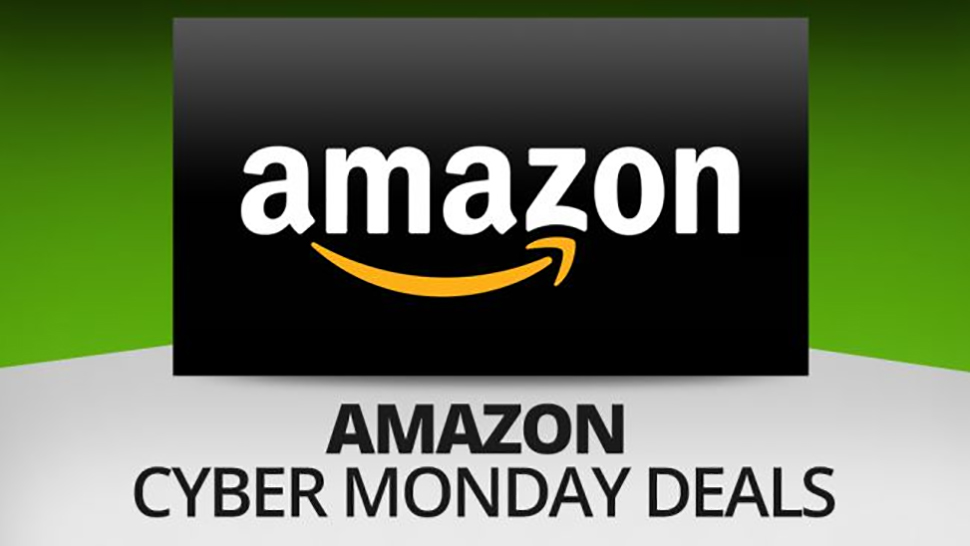
The best Amazon Cyber Monday deals 2017: Get the lowest prices in the US
Amazon’s Cyber Monday deals are just next month, and that means some of the best deals on electronics and software are inbound. Cyber Monday is becoming an even bigger shopping day than Black Friday, and Amazon has a center seat in the insane online sales that come.
With Amazon’s strength in online retailing, you can bet it will have just about anything you could want on sale or discounted in some fashion on Cyber Monday. Some deals will last the whole day, some may only last an hour. Finding the best deals will require a bit of concentration, but we’re going to help make it easier on you.
For gamers, Amazon’s Cyber Monday deals are likely to include discounts or bundles for the PS4 Pro, Xbox One X, and Nintendo Switch. If supplies last, there could even be deals on the SNES Classic Mini.
4K TVs, new laptops, and smartphones are also likely to be on sale. Expect the discounts and bundles on the latest Samsung devices, and potential price cuts on some of Apple’s iPhones. Cyber Monday may be a little too soon to expect killer deals on the new iPhone 8 and iPhone X.
Best of all, if you're looking for Amazon devices for the cheapest price all year, the retailer is expected offer a price drop on the Amazon Echo, Kindle, Fire TV and Fire Tablets, while also offering deals for its services like Prime and Kindle Unlimited.
There's a lot of savings to be had during Amazon Cyber Monday sale. How can you best prepare and what deals are likely to show up on November 27? We have the full rundown of what to expect next month.
Cyber Monday deals quick link Amazon's deals homepage Amazon Prime and Cyber Monday
One way to get ahead of the pack on Cyber Monday is to sign up for an Amazon Prime subscription, or make use of the one you already have: some of the bargains you'll see are exclusive to Prime members, or exclusive to Prime members for a limited time.
As we're not privy to Amazon's exact plans, we can't be any more specific than to say that in general you're going to be at an advantage if you sign up for Amazon Prime before Cyber Monday arrives - the company is always looking to boost its subscriber numbers as high as it can, so expect it to have some incentives in store. You might get extra discounts on existing savings, or even deals that are exclusive to Prime members.
You need to stump up $99 a year at the moment for an Amazon Prime subscription (slightly more if you go month-to-month), which gets you a ton of benefits besides putting you at the head of the queue when it comes to Cyber Monday offers: Amazon Prime Video, Amazon Prime Music, cloud storage space for your photos and of course a ticket to the Amazon Prime deals day every summer.
Amazon Lightning Deals
Amazon Lightning Deals are special, time-limited offers that pop up on Black Friday and Cyber Monday, giving you the opportunity to grab a bargain in double-quick time. Stock is usually low and time is usually short, so if you don't jump in when you've got the chance, you run the risk of losing out completely.
As they're limited by time and stock, you often see some hefty discounts on offer with these Lightning Deals, so they're a great option for the savvy Cyber Monday 2017 shopper. Of course, we don't recommend jumping into anything you're not sure about, but seize the opportunity if you are.
A Lightning Deal is "a promotion in which a limited number of discounts are offered on an item for a short period of time" according to Amazon, and they can be found on the Today's Deals page. If you're a Prime member then you get access even earlier too.
Amazon Cyber Monday deals
With Cyber Monday 2017 rapidly approaching, we used insights from Cyber Monday 2016 to give you an idea of what products you can expect to be on sale this coming November.
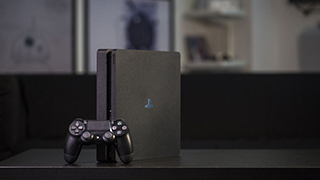
Gaming Cyber Monday deals - Amazon is always offering PS4 and Xbox One discounts during the holiday sales period, and you could easily save $50 on either console for Cyber Monday – and these console bundles came with games. Expect the PS4 Pro and Xbox One X to be big when the deals come around. Deals on the SNES and NES Classic should also pop up.

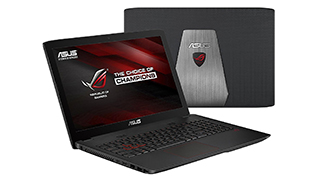
Computing Cyber Monday deals - Dell, HP and, of course, Apple have always been the big winners on Amazon Cyber Monday for both laptops and desktops. We found the 12-inch MacBook Retina for just now $1,199 ($100 off) and the 14-inch HP 14-an013nr notebook for as low as $199.

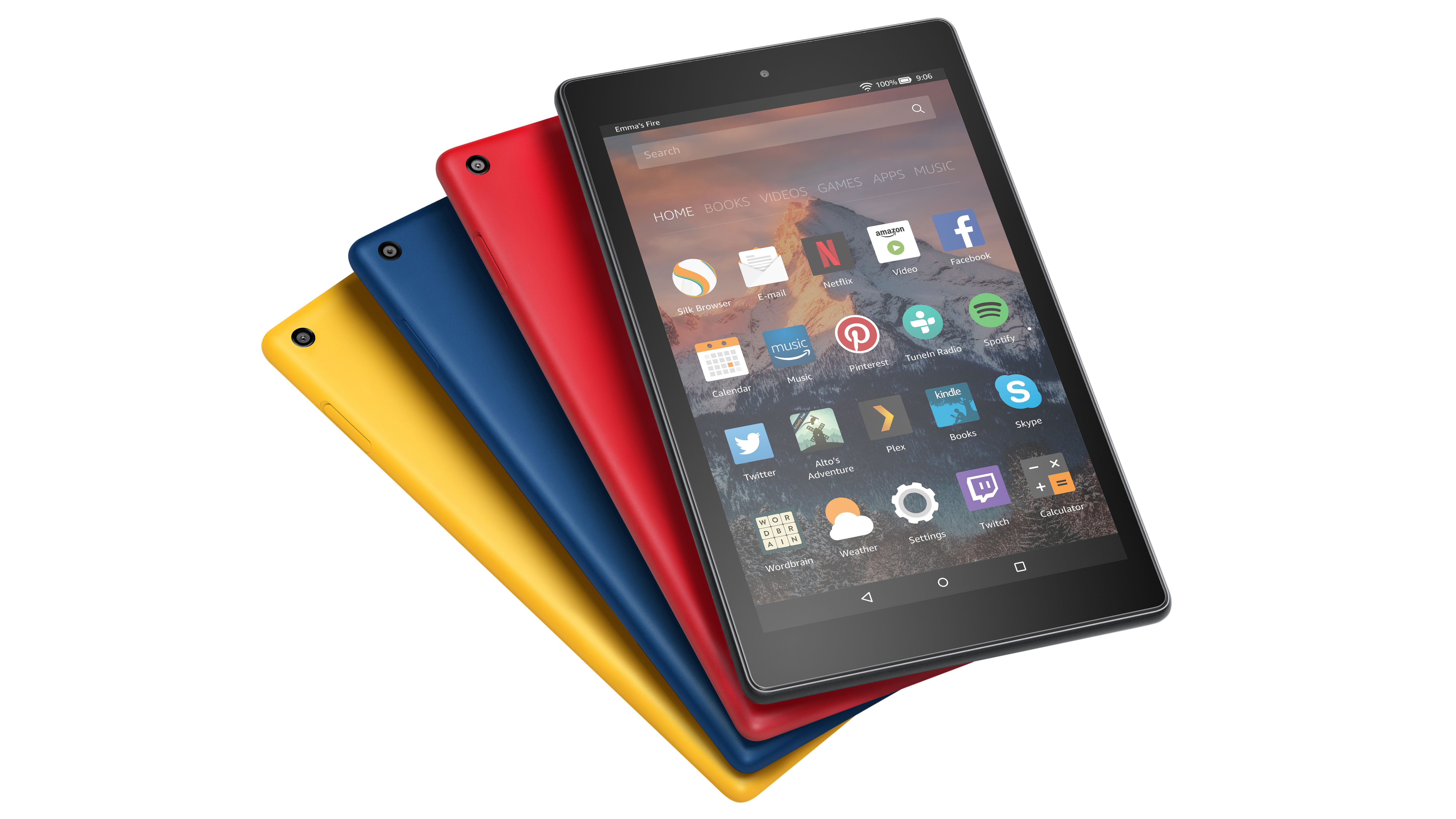
Tablet Cyber Monday deals - Amazon discounts on tablets usually favor the Fire HD tablets, and we fully expect the new Amazon Fire HD 8 to be this year's big winner. Last year, the previous-gen model was $59, down from $89. Don't be surprised if we get a similar deal this November.

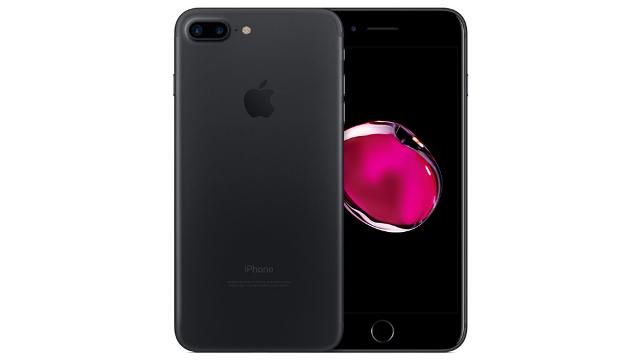
Phone Cyber Monday deals - It's hard to find the new iPhone on sale, but we were able to find a few iPhone deals on Cyber Monday through Amazon. The savings was an average of $25 on the handset compared to the Apple Store. Every little bit counts. iPhone 8 and iPhone X deals may be harder to come by.

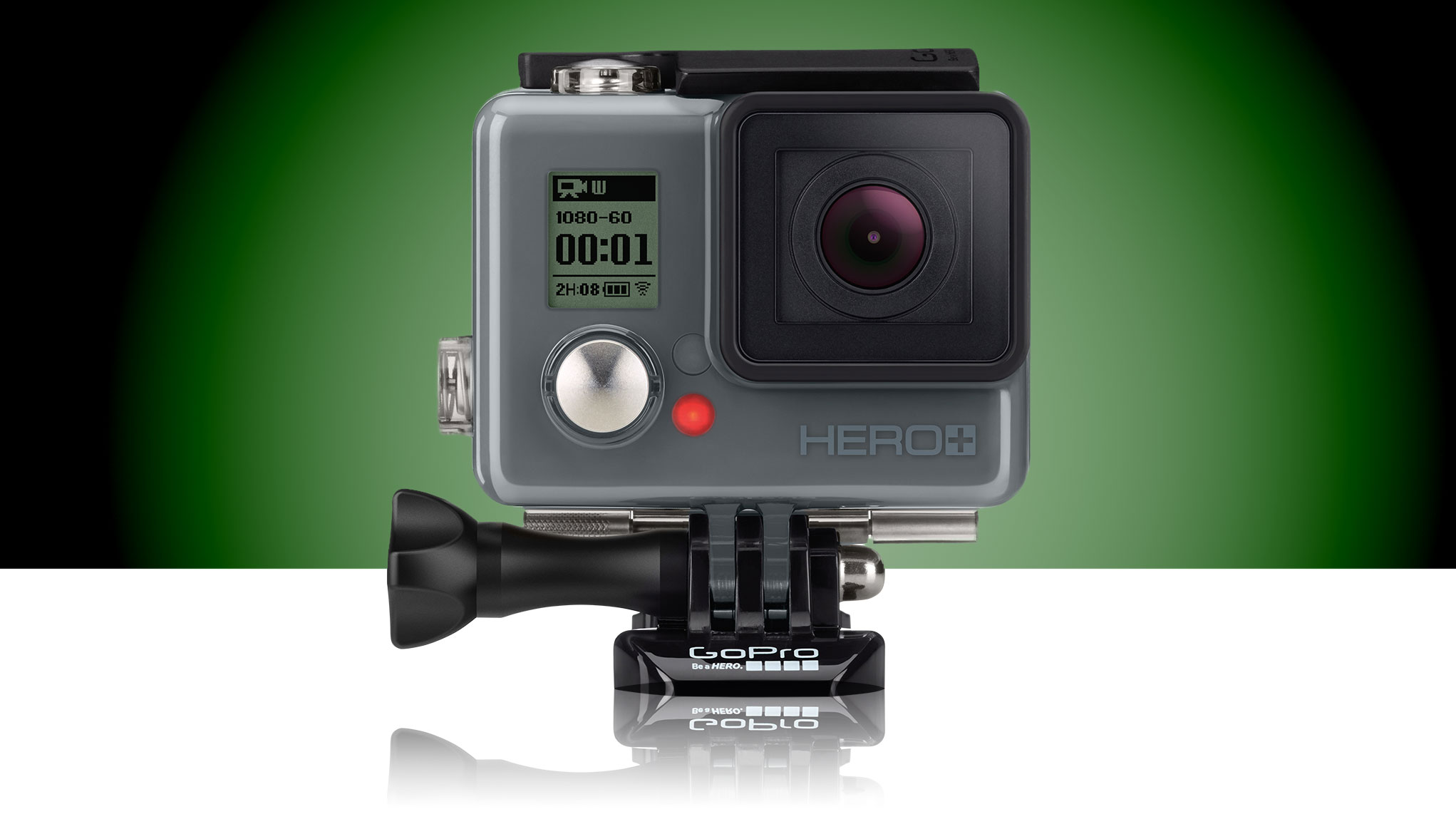
Camera Cyber Monday deals - Canon, Nikon and Sony fans can find cheap DSLR and point-and-shoot cameras discounts throughout Cyber Monday, and you shouldn't forget to snag a GoPro (or two). Last year, the entry-level GoPro Hero cost just $97.48 on Amazon. With a GoPro Hero 6 inbound, expect even better prices on past models.


Smart home Cyber Monday deals - Amazon's Alexa-enabled devices have an opportunity to play a central role in smart home systems. That means the more smart home devices that are out there, the more appealing Amazon's devices become, so you can expect to see plenty of smart locks, thermostats and light bulbs on sale during Cyber Monday.
Amazon on Cyber Monday 2017: what you need to know
Everything you usually associate with Amazon - speedy delivery, a wide choice of gadgets, competitive prices - still applies on Cyber Monday, making it one of the best places to do your shopping amidst the bedlam of tumbling prices and limited time offers.
You're going to save yourself some time if you've already got your details all set up and registered with Amazon, including your delivery address, your delivery preferences, and a default payment method you can use. Of course keeping this page open and refreshing it regularly is going to save you some time too, as we'll bring you the best deals right here.
Cyber Monday actually kicks off a whole week of special offers on Amazon, called Cyber Deals Week, so you can carry on saving money on Tuesday, Wednesday, Thursday and Friday too - get those Christmas presents in early (whether for yourself or others) and at bargain prices too.
The top 5 Amazon deals on Cyber Monday 2016
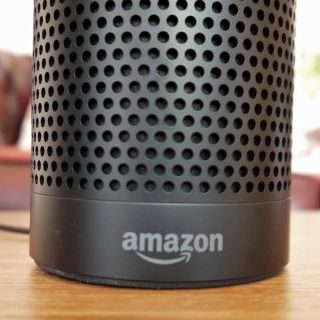
1. Amazon Echo
Amazon loves discounting its own hardware during special events, and for Cyber Monday last year it knocked down the price of the biggest Amazon Echo from $179 to only $139.

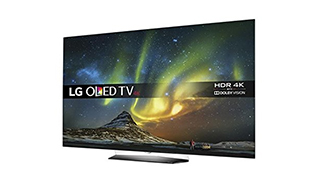
2. LG OLED55B6P 55-inch 4K TV
LG's flagship television just came out last year, but it was almost instantly on sale for a very brief period of time during Cyber Monday. The price went from $2,002 down to $1,797 through Amazon.

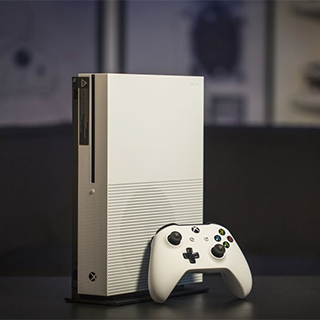
3. Xbox One S bundle
You could find an Xbox One S bundle during Cyber Monday 2016 with two free games attached: Battlefield 1 and Elder Scrolls V: Skyrim for only $288. That was a steal at the time.

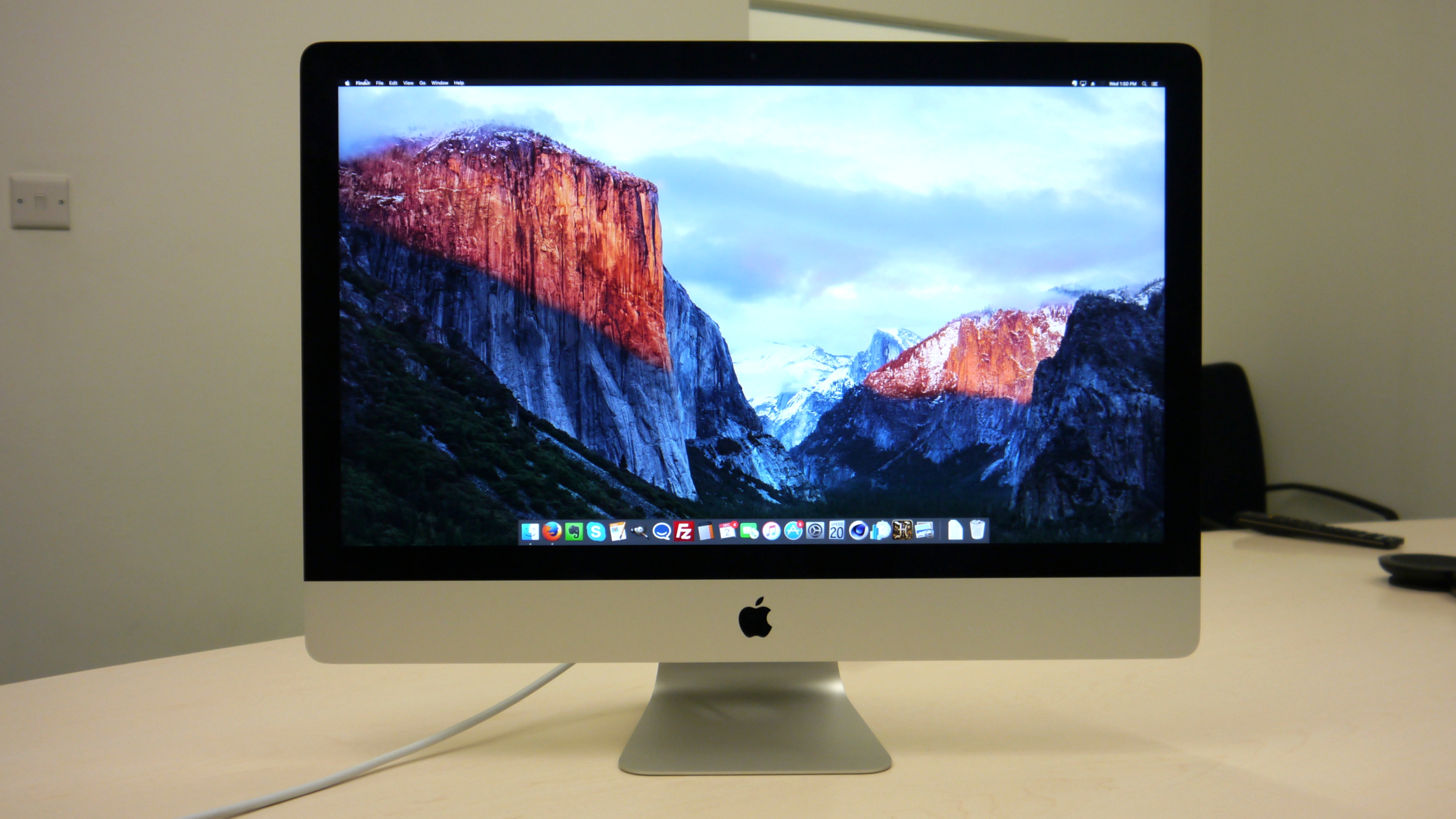
4. Apple iMac 27-inch 5K Retina Desktop
We're not used to seeing deep Apple discounts, and when we do it's usually $50 or $100 off. Well, Amazon Cyber Monday brought out the rollback prices, saving everyone who bought into it $200, going from $1,799 to just, now $1,599.

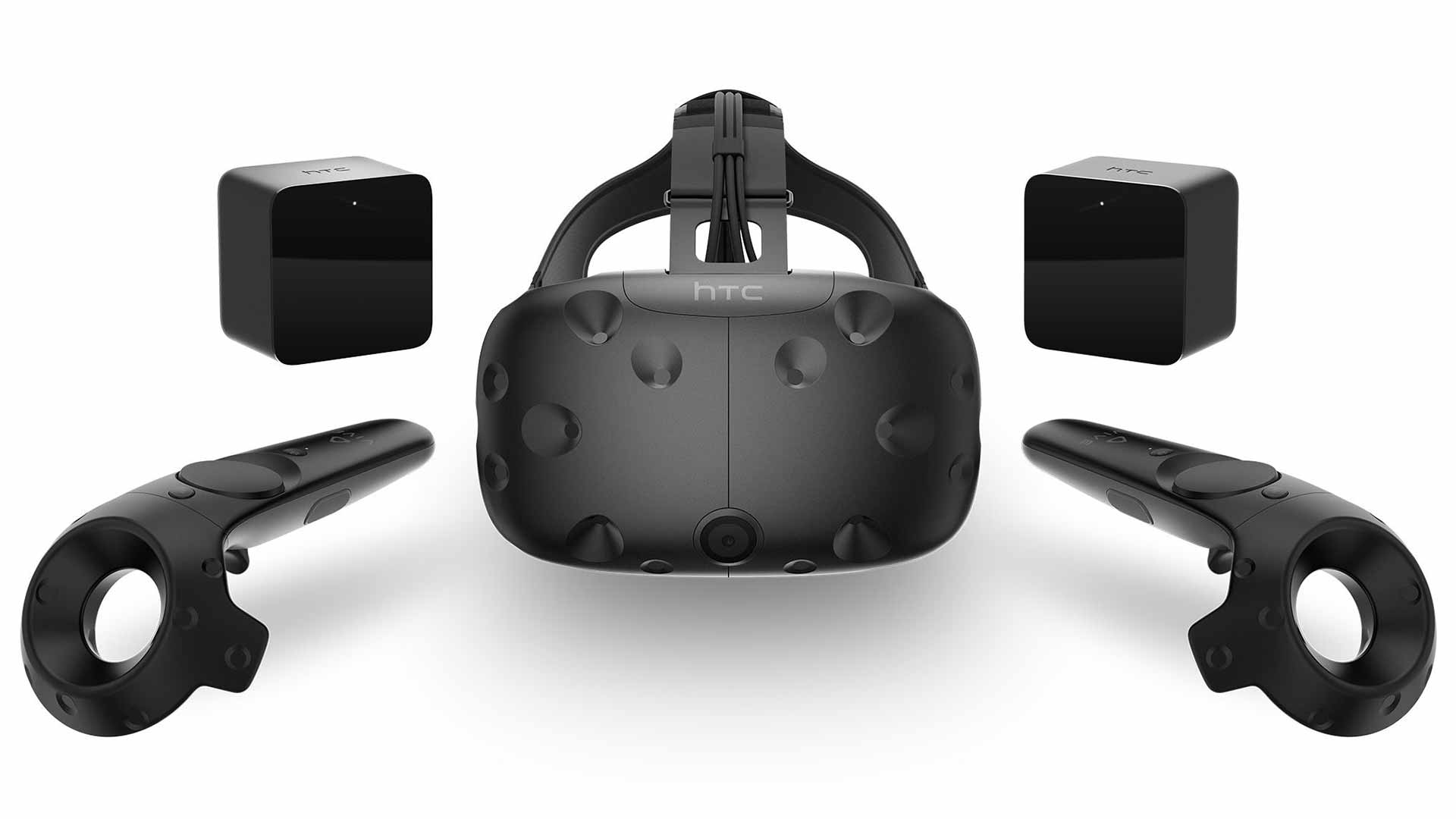
5. HTC Vive
Cyber Monday did have VR discounts, even though the tech behind it is so new. The best deal was for the HTC Vive, which was $100 off, landing a $699 price tag that quickly went back up to $799 after Cyber Monday.
With Amazon’s strength in online retailing, you can bet it will have just about anything you could want on sale or discounted in some fashion on Cyber Monday. Some deals will last the whole day, some may only last an hour. Finding the best deals will require a bit of concentration, but we’re going to help make it easier on you.
For gamers, Amazon’s Cyber Monday deals are likely to include discounts or bundles for the PS4 Pro, Xbox One X, and Nintendo Switch. If supplies last, there could even be deals on the SNES Classic Mini.
4K TVs, new laptops, and smartphones are also likely to be on sale. Expect the discounts and bundles on the latest Samsung devices, and potential price cuts on some of Apple’s iPhones. Cyber Monday may be a little too soon to expect killer deals on the new iPhone 8 and iPhone X.
Best of all, if you're looking for Amazon devices for the cheapest price all year, the retailer is expected offer a price drop on the Amazon Echo, Kindle, Fire TV and Fire Tablets, while also offering deals for its services like Prime and Kindle Unlimited.
There's a lot of savings to be had during Amazon Cyber Monday sale. How can you best prepare and what deals are likely to show up on November 27? We have the full rundown of what to expect next month.
Cyber Monday deals quick link Amazon's deals homepage Amazon Prime and Cyber Monday
One way to get ahead of the pack on Cyber Monday is to sign up for an Amazon Prime subscription, or make use of the one you already have: some of the bargains you'll see are exclusive to Prime members, or exclusive to Prime members for a limited time.
As we're not privy to Amazon's exact plans, we can't be any more specific than to say that in general you're going to be at an advantage if you sign up for Amazon Prime before Cyber Monday arrives - the company is always looking to boost its subscriber numbers as high as it can, so expect it to have some incentives in store. You might get extra discounts on existing savings, or even deals that are exclusive to Prime members.
You need to stump up $99 a year at the moment for an Amazon Prime subscription (slightly more if you go month-to-month), which gets you a ton of benefits besides putting you at the head of the queue when it comes to Cyber Monday offers: Amazon Prime Video, Amazon Prime Music, cloud storage space for your photos and of course a ticket to the Amazon Prime deals day every summer.
Amazon Lightning Deals
Amazon Lightning Deals are special, time-limited offers that pop up on Black Friday and Cyber Monday, giving you the opportunity to grab a bargain in double-quick time. Stock is usually low and time is usually short, so if you don't jump in when you've got the chance, you run the risk of losing out completely.
As they're limited by time and stock, you often see some hefty discounts on offer with these Lightning Deals, so they're a great option for the savvy Cyber Monday 2017 shopper. Of course, we don't recommend jumping into anything you're not sure about, but seize the opportunity if you are.
A Lightning Deal is "a promotion in which a limited number of discounts are offered on an item for a short period of time" according to Amazon, and they can be found on the Today's Deals page. If you're a Prime member then you get access even earlier too.
Amazon Cyber Monday deals
With Cyber Monday 2017 rapidly approaching, we used insights from Cyber Monday 2016 to give you an idea of what products you can expect to be on sale this coming November.

Gaming Cyber Monday deals - Amazon is always offering PS4 and Xbox One discounts during the holiday sales period, and you could easily save $50 on either console for Cyber Monday – and these console bundles came with games. Expect the PS4 Pro and Xbox One X to be big when the deals come around. Deals on the SNES and NES Classic should also pop up.


Computing Cyber Monday deals - Dell, HP and, of course, Apple have always been the big winners on Amazon Cyber Monday for both laptops and desktops. We found the 12-inch MacBook Retina for just now $1,199 ($100 off) and the 14-inch HP 14-an013nr notebook for as low as $199.


Tablet Cyber Monday deals - Amazon discounts on tablets usually favor the Fire HD tablets, and we fully expect the new Amazon Fire HD 8 to be this year's big winner. Last year, the previous-gen model was $59, down from $89. Don't be surprised if we get a similar deal this November.


Phone Cyber Monday deals - It's hard to find the new iPhone on sale, but we were able to find a few iPhone deals on Cyber Monday through Amazon. The savings was an average of $25 on the handset compared to the Apple Store. Every little bit counts. iPhone 8 and iPhone X deals may be harder to come by.


Camera Cyber Monday deals - Canon, Nikon and Sony fans can find cheap DSLR and point-and-shoot cameras discounts throughout Cyber Monday, and you shouldn't forget to snag a GoPro (or two). Last year, the entry-level GoPro Hero cost just $97.48 on Amazon. With a GoPro Hero 6 inbound, expect even better prices on past models.


Smart home Cyber Monday deals - Amazon's Alexa-enabled devices have an opportunity to play a central role in smart home systems. That means the more smart home devices that are out there, the more appealing Amazon's devices become, so you can expect to see plenty of smart locks, thermostats and light bulbs on sale during Cyber Monday.
Amazon on Cyber Monday 2017: what you need to know
Everything you usually associate with Amazon - speedy delivery, a wide choice of gadgets, competitive prices - still applies on Cyber Monday, making it one of the best places to do your shopping amidst the bedlam of tumbling prices and limited time offers.
You're going to save yourself some time if you've already got your details all set up and registered with Amazon, including your delivery address, your delivery preferences, and a default payment method you can use. Of course keeping this page open and refreshing it regularly is going to save you some time too, as we'll bring you the best deals right here.
Cyber Monday actually kicks off a whole week of special offers on Amazon, called Cyber Deals Week, so you can carry on saving money on Tuesday, Wednesday, Thursday and Friday too - get those Christmas presents in early (whether for yourself or others) and at bargain prices too.
The top 5 Amazon deals on Cyber Monday 2016

1. Amazon Echo
Amazon loves discounting its own hardware during special events, and for Cyber Monday last year it knocked down the price of the biggest Amazon Echo from $179 to only $139.


2. LG OLED55B6P 55-inch 4K TV
LG's flagship television just came out last year, but it was almost instantly on sale for a very brief period of time during Cyber Monday. The price went from $2,002 down to $1,797 through Amazon.


3. Xbox One S bundle
You could find an Xbox One S bundle during Cyber Monday 2016 with two free games attached: Battlefield 1 and Elder Scrolls V: Skyrim for only $288. That was a steal at the time.


4. Apple iMac 27-inch 5K Retina Desktop
We're not used to seeing deep Apple discounts, and when we do it's usually $50 or $100 off. Well, Amazon Cyber Monday brought out the rollback prices, saving everyone who bought into it $200, going from $1,799 to just, now $1,599.


5. HTC Vive
Cyber Monday did have VR discounts, even though the tech behind it is so new. The best deal was for the HTC Vive, which was $100 off, landing a $699 price tag that quickly went back up to $799 after Cyber Monday.

Best travel apps 2017: make traveling a joy
Best travel apps 2017
Travel season may be ‘officially’ over, but soon it will be that time of year again when we start booking flights and buying all of the sunscreen that we can carry. (Plus, when has that stopped anyone?) It's exciting, but traveling brings with it a number of inherent issues. Luckily, thanks to the magic of technology, many of these problems are easily remedied with apps for your mobile device.
With cheap and easy flights to pretty much any country you can think of, it's never been so easy to travel the globe. Still, traveling brings with it many inevitable headaches that can drive you crazy. To help make the whole experience of traveling less of a hassle we have collected the best travel apps available on the market today.
This list includes a wide range of different kinds of apps to cover every facet of travel, from how to get there, to activities you can enjoy once you arrive, how to communicate with the locals and even apps that take the hassle out of paying for stuff. It couldn’t hurt to get some games downloaded on your device as well.
So, before you pack your bags and wait in line for your passport, make sure you've got one or more of these installed on your iOS or Android device.
Check out some of the best podcasts while you travel. Airbnb FreeiOS, Android
Even just a few years ago, if you were going on vacation, you basically had to stay at a hotel. But over the past couple years, that has thankfully been changing. Airbnb has become immensely popular, and it has completely changed the way that people book their accommodations when they travel.
Thanks to Airbnb’s meteoric rise in prevalence, you can now you could stay in a beautiful house in the center of a city or a quaint little cottage out in the beautiful countryside.
Airbnb makes booking your accommodations simple, and also includes guides for local sightseeing and a section for booking activities.
Netflix Free to download, requires subscriptioniOS, Android
Netflix has always been one of the best travel apps, but now they’ve added the ability to download all of your favorites straight to your mobile device for offline viewing. This makes it the quintessential app to bring with you on those lengthy trips. If you've got hours to pass waiting in departure, or even if you'd rather just watch your movie in-flight without having it interrupted by annoying announcements from the flight crew, this is a must-have app.
Just remember to throw it into airplane mode when flying, and get those movies downloaded at home over Wi-Fi in advance of your trip in order to save on those absurd data roaming charges.
App in the Air FreeiOS, Android
Don’t let App in the Air’s odd choice in name throw you off, there’s a reason this app is an Editor's Choice on the App Store. App in the Air gives you real-time flight updates, gate changes, airport navigation maps and tips – meaning you will never find yourself desperately rushing through an airport terminal again.
But wait, there’s more! You can even still receive updates offline, so you'll get no roaming charges when using the app abroad.
Booking.com FreeiOS, Android
Booking.com is one of the world's most popular hotel booking websites. The Booking.com mobile app builds on its already solid model, permitting you to search for the best booking deals on over 1 million hotels and homes all over the world. If you're still trying to decide where you want to book, there are over 100 million user reviews to help you figure it out.
Plus, once you have finished your booking, you will receive an instant confirmation of your booking, complete with paperless check-in and offline maps of the surrounding area.
XE Currency FreeiOS, Android
With more than 55 million downloads, XE Currency is the most renowned currency exchange rate app on the market, and not without reason.
It gives precise conversion rates for every currency you can think of, updated every minute and stored offline so that even if you lose internet connection or want to avoid roaming charges, you can still use the app.
British Airways FreeiOS, Android
The British Airways app, plainly, is the companion app to British Airways. What is surprising, however, is how useful it is.
It allows you to book flights, check in, select seats and download a digital boarding pass so you don't have to inconvenience yourself by having to print one out or wait in line for a check-in desk when you only have hand luggage.
The British Airways app has live departure gate and in-flight info, meaning you can decide which movies you want to watch while waiting for your flight to board.
Cleartrip FreeiOS, Android
Cleartrip is useful for booking flights, hotels and trains. Cleartrip was initially created in India, and while its success means that it now has well over 10 million users around the world, there are still areas it doesn't support, so make sure to double check to make sure you're in a supported location.
Now, with the ability to safely store card information, you can do 1-click purchases of plane tickets, meaning you can scroll through deals and purchase tickets – all within 60 seconds.
Cleartrip can shop for the best bargains on hotel rooms in over 15,000 cities worldwide, as well.
Citymapper FreeiOS, Android
Citymapper is indispensable if you want to be able to navigate around like a local while abroad. Supporting many major cities around the world, Citymapper is a map app that you can use to chart a route using any kind of transport the city has. It gives live updates on delays and closures, and it’s very easy to use.
You can save maps offline and can access the maps for transport services like Tube maps, so if you want to find your own way, you can do that too.
iTranslate Free to download, requires subscriptioniOS, Android
If you're anything like us, traveling to a country where that speaks a language other than yours makes you yearn for the Babel Fish from Hitchhiker's Guide to the Galaxy; a little mechanical device that you put into your ear that immediately translates any language you hear.
While iTranslate isn't quite there, it is a step in the right direction. With the simple push of a button you can speak into your phone and it'll translate into your choice of 90 different languages. The person you're speaking to then talks into the phone and it translates into your language. Easy!
The implementation is still a long way off being perfect, but it does allow you to converse in another language, which is very useful. What's even better is that the most frequently used languages have a downloadable pack so you can use them offline.
Duolingo FreeiOS, Android
If you're not happy letting an app do all of your translation work for you, you may want to give Duolingo a try.
Duolingo is a language education app that makes learning a new language simple and fun. If you want to be able to communicate with the locals, there are few ways of learning that will get you there as quickly as Duolingo. The simple layout and game feel of the app makes learning a new language a pleasure.
The list of languages that Duolingo offers is continuously growing. Right now you can choose from 23, including Spanish, German, Swahili, and Vietnamese. What's more, it's completely free.
Expedia FreeiOS, Android
The Expedia app is one of the world's most well known all-in-one-place booking apps. You can reserve flights, hotels, rent a car, even book tickets to tourist attractions and theme parks all with the one app.
Expedia has recently rolled out the ability to book bundle deals, so your hotel and flights are all included in the booking, possibly saving you even more money.
Guides by Lonely Planet FreeiOS, Android
Lonely Planet made its name making in-depth travel guides. With Guides, you can now get a concentrated version of what they’re best at, on your phone.
In the app, you can download the guide for the city that you are going to be visiting, then select what category you want information on. These include things to see, restaurants, bars, places to sleep, places to shop and places to play.
Crucial information, including maps and explanations are all stored offline on your device, so you don't have to worry about roaming charges while you're traveling. What's more, there are even phrasebooks included so you can speak with the locals. There are over 100 cities covered with Guides.
Google Trips FreeiOS, Android
Google Trips is the travel planning app from the search titan. Where Google Trips is different from the other travel planners is that you don't actually book through Trips – this is the app you use to parse through all of the information about your trip, and being Google, it provides plenty of suggestions of things to add once you're there.
The app pulls in all of your bookings for your trip from your Gmail account and brings them together, meaning if you find deals from a number of different places, rather than having to have a number of different apps, emails and print-outs all giving you separate information, you always have your entire itinerary in one app.
What's more, Google has recently announced that they are introducing a feature allowing you share your itinerary.
Google Translate FreeiOS, Android
Google Translate is fairly phenomenal if you haven't used it before. There are a few different methods of translation that it offers: text translation, where you type a phrase and it is translated into whichever language you choose, Conversation Mode, where you can actually talk to someone in a different language with the app translating as you speak, and camera translation, where you point your camera at text (like signs) and the translation appears on your screen.
This technology has been around for a while now, but still feels magical somehow.
It is a given that most places you go in the world people speak English, but this is an incredibly useful app for overcoming language barriers.
KAYAK FreeiOS, Android
KAYAK is an app that fishes through travel sites to get you the best deals on flights, hotels and car rentals. Once all of your bookings are finished, it pulls all of the information into an easy to manage itinerary.
Where KAYAK really comes into its own is its knack for tracking not only where the best deals come from, but even changes in the price over time, sending you notifications when the deal you are looking for becomes even better.
There is even a function where you can enter in your budget and it tells you places you can afford to visit.
PackPoint FreeiOS, Android
PackPoint simply helps you pack. You tell PackPoint where you're going, when you're going, and what you plan to do there and PackPoint compiles a list of things to pack. You can add or remove items from the list, then check them off once you have them packed.
It works with TripIt too, so you can get suggestions based on your travel schedule automatically imported from that app.
You won’t ever have to deal with those 'Did I pack my...' feelings ever again.
Splittr $1.99 (£1.99)iOS
Splittr allows you to easily split costs between a group, meaning if you are travelling with a group of people, you no longer need to squabble over who paid for what.
You simply add expenses to the app as you go, then at the end of the holiday Splittr divides the bill and sends a PDF to all parties involved.
Skyscanner FreeiOS, Android
Skyscanner is a booking app for flights, hotels and car hire.
The Skyscanner website's calling card has always been easy customisation and the app is no different, allowing you to adjust your trip using flight duration, airline, stop-overs, flight class, and arrival and departure times. It even has a color-coded calendar that shows you when the best time to book your trip is to get the best deal.
Time Out FreeiOS, Android
Time Out is an app that helps you figure out what to do in a city. With restaurants, art galleries, night clubs, and pretty much everything in between this app is hard to beat if you're in a strange city at a loss for something to do.
Time Out has been helping people discover hidden gems since the 1960's so it knows what it's doing. Once a magazine that focussed on London, the app now covers 30 cities worldwide, with more being added soon.
TripAdvisor FreeiOS, Android
TripAdvisor is the app of choice if user reviews are important to you. The app has over 500 million user reviews for hotels, restaurants, and events. Consumers can rate, review and even include photos, so if you want the full story before you decide to book something, this is the app for you.
Once you've waded through all those reviews, you can reserve a table, a concert, a plane ticket, all with the app.
You can also download maps, saved destinations, and reviews so that if you want to wait until you're already there to make final decisions, you can do so without incurring roaming charges.
TripIt FreeiOS, Android
TripIt is a travel itinerary app that makes it easy to see your whole trip in one place. You simply forward all of your booking emails to TripIt and the app collates all of your information. The information is available offline so you don't have to worry about roaming charges.
What's more, TripIt works with App in the Air and PackPoint (also in this list) so you can get flight notifications and packing advice based on your itinerary.
In order to use all of the functions TripIt has to offer you will have to upgrade to TripIt Pro for $49 per year (about £37, AU$65) but the free version does include all the basics you need like manual changing of plans, syncing with your calendar, compiling travel documents in one place, and sharing of your itinerary.
Momondo FreeiOS / Android
We're big fans of being meta here - providing comparisons of flight comparison engines. Momondo is one we've used regularly and would recommend to anyone looking to get a good deal - it's got a huge database to trawl through and often comes up trumps with good deals as well as options on hotels.
There's a neat graph that shows you the cheapest times to go, and it can also help you work out if direct flights or layovers can be the smartest way to travel. The app also dovetails nicely with the online portal if you fancy getting a bit more power into your searches.
Travel season may be ‘officially’ over, but soon it will be that time of year again when we start booking flights and buying all of the sunscreen that we can carry. (Plus, when has that stopped anyone?) It's exciting, but traveling brings with it a number of inherent issues. Luckily, thanks to the magic of technology, many of these problems are easily remedied with apps for your mobile device.
With cheap and easy flights to pretty much any country you can think of, it's never been so easy to travel the globe. Still, traveling brings with it many inevitable headaches that can drive you crazy. To help make the whole experience of traveling less of a hassle we have collected the best travel apps available on the market today.
This list includes a wide range of different kinds of apps to cover every facet of travel, from how to get there, to activities you can enjoy once you arrive, how to communicate with the locals and even apps that take the hassle out of paying for stuff. It couldn’t hurt to get some games downloaded on your device as well.
So, before you pack your bags and wait in line for your passport, make sure you've got one or more of these installed on your iOS or Android device.
Check out some of the best podcasts while you travel. Airbnb FreeiOS, Android
Even just a few years ago, if you were going on vacation, you basically had to stay at a hotel. But over the past couple years, that has thankfully been changing. Airbnb has become immensely popular, and it has completely changed the way that people book their accommodations when they travel.
Thanks to Airbnb’s meteoric rise in prevalence, you can now you could stay in a beautiful house in the center of a city or a quaint little cottage out in the beautiful countryside.
Airbnb makes booking your accommodations simple, and also includes guides for local sightseeing and a section for booking activities.
Netflix Free to download, requires subscriptioniOS, Android
Netflix has always been one of the best travel apps, but now they’ve added the ability to download all of your favorites straight to your mobile device for offline viewing. This makes it the quintessential app to bring with you on those lengthy trips. If you've got hours to pass waiting in departure, or even if you'd rather just watch your movie in-flight without having it interrupted by annoying announcements from the flight crew, this is a must-have app.
Just remember to throw it into airplane mode when flying, and get those movies downloaded at home over Wi-Fi in advance of your trip in order to save on those absurd data roaming charges.
App in the Air FreeiOS, Android
Don’t let App in the Air’s odd choice in name throw you off, there’s a reason this app is an Editor's Choice on the App Store. App in the Air gives you real-time flight updates, gate changes, airport navigation maps and tips – meaning you will never find yourself desperately rushing through an airport terminal again.
But wait, there’s more! You can even still receive updates offline, so you'll get no roaming charges when using the app abroad.
Booking.com FreeiOS, Android
Booking.com is one of the world's most popular hotel booking websites. The Booking.com mobile app builds on its already solid model, permitting you to search for the best booking deals on over 1 million hotels and homes all over the world. If you're still trying to decide where you want to book, there are over 100 million user reviews to help you figure it out.
Plus, once you have finished your booking, you will receive an instant confirmation of your booking, complete with paperless check-in and offline maps of the surrounding area.
XE Currency FreeiOS, Android
With more than 55 million downloads, XE Currency is the most renowned currency exchange rate app on the market, and not without reason.
It gives precise conversion rates for every currency you can think of, updated every minute and stored offline so that even if you lose internet connection or want to avoid roaming charges, you can still use the app.
British Airways FreeiOS, Android
The British Airways app, plainly, is the companion app to British Airways. What is surprising, however, is how useful it is.
It allows you to book flights, check in, select seats and download a digital boarding pass so you don't have to inconvenience yourself by having to print one out or wait in line for a check-in desk when you only have hand luggage.
The British Airways app has live departure gate and in-flight info, meaning you can decide which movies you want to watch while waiting for your flight to board.
Cleartrip FreeiOS, Android
Cleartrip is useful for booking flights, hotels and trains. Cleartrip was initially created in India, and while its success means that it now has well over 10 million users around the world, there are still areas it doesn't support, so make sure to double check to make sure you're in a supported location.
Now, with the ability to safely store card information, you can do 1-click purchases of plane tickets, meaning you can scroll through deals and purchase tickets – all within 60 seconds.
Cleartrip can shop for the best bargains on hotel rooms in over 15,000 cities worldwide, as well.
Citymapper FreeiOS, Android
Citymapper is indispensable if you want to be able to navigate around like a local while abroad. Supporting many major cities around the world, Citymapper is a map app that you can use to chart a route using any kind of transport the city has. It gives live updates on delays and closures, and it’s very easy to use.
You can save maps offline and can access the maps for transport services like Tube maps, so if you want to find your own way, you can do that too.
iTranslate Free to download, requires subscriptioniOS, Android
If you're anything like us, traveling to a country where that speaks a language other than yours makes you yearn for the Babel Fish from Hitchhiker's Guide to the Galaxy; a little mechanical device that you put into your ear that immediately translates any language you hear.
While iTranslate isn't quite there, it is a step in the right direction. With the simple push of a button you can speak into your phone and it'll translate into your choice of 90 different languages. The person you're speaking to then talks into the phone and it translates into your language. Easy!
The implementation is still a long way off being perfect, but it does allow you to converse in another language, which is very useful. What's even better is that the most frequently used languages have a downloadable pack so you can use them offline.
Duolingo FreeiOS, Android
If you're not happy letting an app do all of your translation work for you, you may want to give Duolingo a try.
Duolingo is a language education app that makes learning a new language simple and fun. If you want to be able to communicate with the locals, there are few ways of learning that will get you there as quickly as Duolingo. The simple layout and game feel of the app makes learning a new language a pleasure.
The list of languages that Duolingo offers is continuously growing. Right now you can choose from 23, including Spanish, German, Swahili, and Vietnamese. What's more, it's completely free.
Expedia FreeiOS, Android
The Expedia app is one of the world's most well known all-in-one-place booking apps. You can reserve flights, hotels, rent a car, even book tickets to tourist attractions and theme parks all with the one app.
Expedia has recently rolled out the ability to book bundle deals, so your hotel and flights are all included in the booking, possibly saving you even more money.
Guides by Lonely Planet FreeiOS, Android
Lonely Planet made its name making in-depth travel guides. With Guides, you can now get a concentrated version of what they’re best at, on your phone.
In the app, you can download the guide for the city that you are going to be visiting, then select what category you want information on. These include things to see, restaurants, bars, places to sleep, places to shop and places to play.
Crucial information, including maps and explanations are all stored offline on your device, so you don't have to worry about roaming charges while you're traveling. What's more, there are even phrasebooks included so you can speak with the locals. There are over 100 cities covered with Guides.
Google Trips FreeiOS, Android
Google Trips is the travel planning app from the search titan. Where Google Trips is different from the other travel planners is that you don't actually book through Trips – this is the app you use to parse through all of the information about your trip, and being Google, it provides plenty of suggestions of things to add once you're there.
The app pulls in all of your bookings for your trip from your Gmail account and brings them together, meaning if you find deals from a number of different places, rather than having to have a number of different apps, emails and print-outs all giving you separate information, you always have your entire itinerary in one app.
What's more, Google has recently announced that they are introducing a feature allowing you share your itinerary.
Google Translate FreeiOS, Android
Google Translate is fairly phenomenal if you haven't used it before. There are a few different methods of translation that it offers: text translation, where you type a phrase and it is translated into whichever language you choose, Conversation Mode, where you can actually talk to someone in a different language with the app translating as you speak, and camera translation, where you point your camera at text (like signs) and the translation appears on your screen.
This technology has been around for a while now, but still feels magical somehow.
It is a given that most places you go in the world people speak English, but this is an incredibly useful app for overcoming language barriers.
KAYAK FreeiOS, Android
KAYAK is an app that fishes through travel sites to get you the best deals on flights, hotels and car rentals. Once all of your bookings are finished, it pulls all of the information into an easy to manage itinerary.
Where KAYAK really comes into its own is its knack for tracking not only where the best deals come from, but even changes in the price over time, sending you notifications when the deal you are looking for becomes even better.
There is even a function where you can enter in your budget and it tells you places you can afford to visit.
PackPoint FreeiOS, Android
PackPoint simply helps you pack. You tell PackPoint where you're going, when you're going, and what you plan to do there and PackPoint compiles a list of things to pack. You can add or remove items from the list, then check them off once you have them packed.
It works with TripIt too, so you can get suggestions based on your travel schedule automatically imported from that app.
You won’t ever have to deal with those 'Did I pack my...' feelings ever again.
Splittr $1.99 (£1.99)iOS
Splittr allows you to easily split costs between a group, meaning if you are travelling with a group of people, you no longer need to squabble over who paid for what.
You simply add expenses to the app as you go, then at the end of the holiday Splittr divides the bill and sends a PDF to all parties involved.
Skyscanner FreeiOS, Android
Skyscanner is a booking app for flights, hotels and car hire.
The Skyscanner website's calling card has always been easy customisation and the app is no different, allowing you to adjust your trip using flight duration, airline, stop-overs, flight class, and arrival and departure times. It even has a color-coded calendar that shows you when the best time to book your trip is to get the best deal.
Time Out FreeiOS, Android
Time Out is an app that helps you figure out what to do in a city. With restaurants, art galleries, night clubs, and pretty much everything in between this app is hard to beat if you're in a strange city at a loss for something to do.
Time Out has been helping people discover hidden gems since the 1960's so it knows what it's doing. Once a magazine that focussed on London, the app now covers 30 cities worldwide, with more being added soon.
TripAdvisor FreeiOS, Android
TripAdvisor is the app of choice if user reviews are important to you. The app has over 500 million user reviews for hotels, restaurants, and events. Consumers can rate, review and even include photos, so if you want the full story before you decide to book something, this is the app for you.
Once you've waded through all those reviews, you can reserve a table, a concert, a plane ticket, all with the app.
You can also download maps, saved destinations, and reviews so that if you want to wait until you're already there to make final decisions, you can do so without incurring roaming charges.
TripIt FreeiOS, Android
TripIt is a travel itinerary app that makes it easy to see your whole trip in one place. You simply forward all of your booking emails to TripIt and the app collates all of your information. The information is available offline so you don't have to worry about roaming charges.
What's more, TripIt works with App in the Air and PackPoint (also in this list) so you can get flight notifications and packing advice based on your itinerary.
In order to use all of the functions TripIt has to offer you will have to upgrade to TripIt Pro for $49 per year (about £37, AU$65) but the free version does include all the basics you need like manual changing of plans, syncing with your calendar, compiling travel documents in one place, and sharing of your itinerary.
Momondo FreeiOS / Android
We're big fans of being meta here - providing comparisons of flight comparison engines. Momondo is one we've used regularly and would recommend to anyone looking to get a good deal - it's got a huge database to trawl through and often comes up trumps with good deals as well as options on hotels.
There's a neat graph that shows you the cheapest times to go, and it can also help you work out if direct flights or layovers can be the smartest way to travel. The app also dovetails nicely with the online portal if you fancy getting a bit more power into your searches.
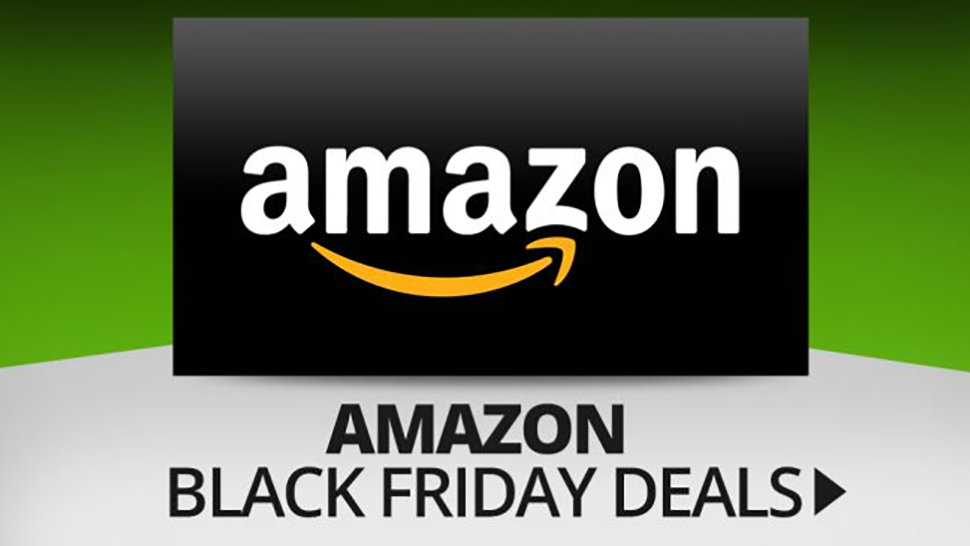
The best Amazon Black Friday deals 2017
Amazon’s Black Friday 2017 is just next month, and that means it’s time for anyone waiting on the best TV deals, cheap laptops or game consoles with slashed prices and free games to wake up. Whether you want the PS4 Pro, Xbox One X, SNES Mini, or just a 65-inch 4K TV to run them on, Amazon’s Black Friday deals will make it easier to muster enough money to make these otherwise hefty purchases.
The latest and greatest smartphones won’t be left out of Amazon’s Black Friday party either, and Amazon’s own tablets and Alexa devices are all but guaranteed to make a showing in the top deals.
The hardest part of Amazon’s Black Friday is that there are so many products and so many prices, making it hard to distinguish a killer deal from a minor price drop. But, we’re here to help.
We have tips to help you identify great Amazon Black Friday deals, and we're assembling an epic Amazon Black Friday deals list for 2017, one that will offer our recommendations for everything from phones, Kindle e-readers and cameras, to PS4 Pro, Xbox One X and even toys.
You'll still have to be fast to claim these on sale gadgets. Amazon often sells out of its most popular deeply discounted electronics, with limited Deal of the Day and Lightning deals. The same thing will happen on Cyber Monday 2017.
Amazon Prime and Black Friday
Amazon Prime is always a must-have on Black Friday. It has major perks, like free two-day shipping, and members sometimes get exclusive deals tailored for Prime users.
You can get early access to the Lightning Deals on Amazon that don't stick around for very long. In other cases you might get extra discounts on prices that have dropped already, or you might get deals that don't apply to non-Prime members.
It's hard to make Amazon Black Friday predictions, but generally speaking you're at an advantage if you sign up for Amazon Prime (the retailer always wants to boost those subscription numbers after all).
At the moment a subscription costs you $99 a year, or slightly more if you go month-to-month, and of course there are a host of other benefits besides improved access to the Black Friday deals. Amazon even runs its own deals day exclusively for Prime members every summer.
You get access to the Netflix-style Amazon Prime Video, the Spotify-style Amazon Prime Music, and a ton of cloud space to store your digital photos as well. All that and more, and faster delivery times throughout the year as well.
Amazon Lightning Deals
Amazon loves its Lightning Deals: as the name suggests, these are very short-lived offers that usually involve items where the stock is low, so if you don't jump in when you've got the chance, you might miss out.
Don't feel pressured into deals you don't feel sure about - just be aware that Lightning Deals aren't going to stick around. As they're only available for a short amount of time, they often offer some very tasty discounts.
In the words of Amazon, a Lightning Deal is "a promotion in which a limited number of discounts are offered on an item for a short period of time", and you can usually find them on the Today's Deals page. As we mentioned above, Prime members get early access to the Lightning Deals on Amazon.
Here's everything you need to know about Amazon Black Friday 2017.
Amazon Black Friday 2017 predictions and ads
We don't have an Amazon Black Friday 2017 ad just yet, but we're ready to make predictions for what this year's deal will be.
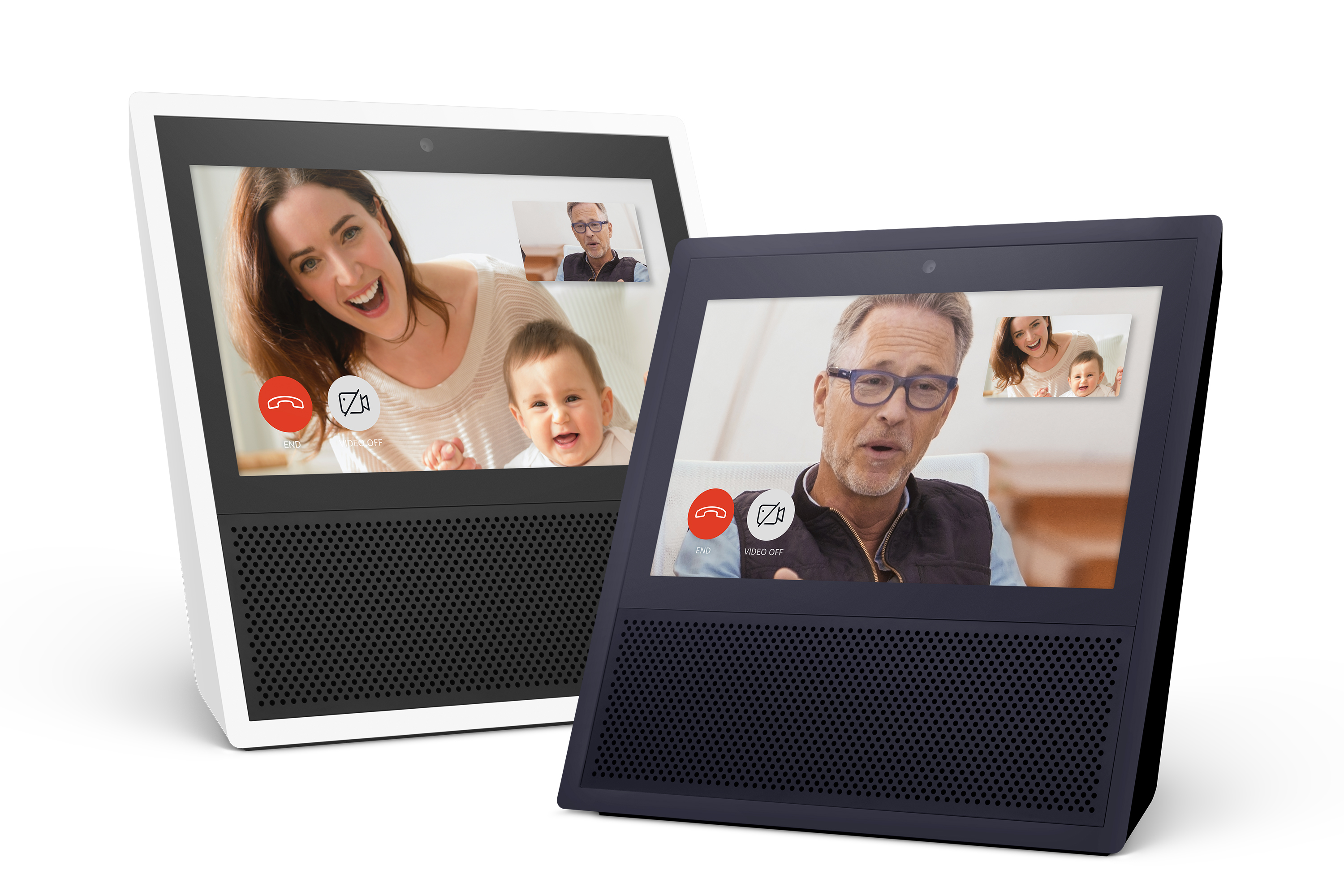
1. Amazon Echo Show
We expect major Amazon Echo deals, and there'll be no bigger item than the new Amazon Echo Show during Black Friday 2017. It's already offered discounts as much as $100 off in the past when purchased in pairs. With more Echo devices hitting the market, there will be plenty of deals on these and other Alexa-enabled gadgets.

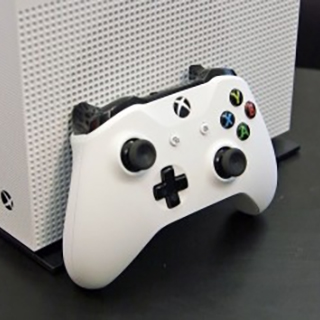
2. Xbox One S bundle
Xbox One X will be the popular new console, so we fully expect the Xbox One S to see deep discounts and bundled with free games during Black Friday. It's more than Amazon just wanting to offload its inventory. Microsoft wants to keep making the system because it allows the company to have an entry-level video game console on sale. More Xbox One systems in buyers hands means more game sales, where the real money is made.

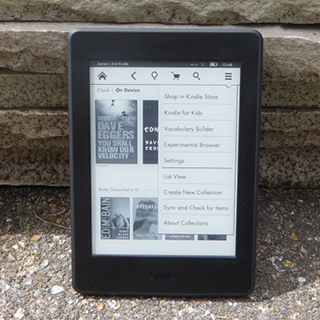
3. Amazon Kindle Paperwhite
Amazon Kindle Paperwhite is the e-ink reader that impresses us the most, and it's almost always on sale during the holidays. It's currently on sale for $119.99 today, so you should see be able to get one even cheaper – if you want to wait.


4. 4K TVs
We can't get enough of Amazon Black Friday TV deals, and it's where we predict that you'll see price cuts by hundreds of dollars. It happened last year, and we fully expect better specs via deeply discount 4K TV sets with HDR.
We'll continue to update our Amazon Black Friday guide, as the date approaches.

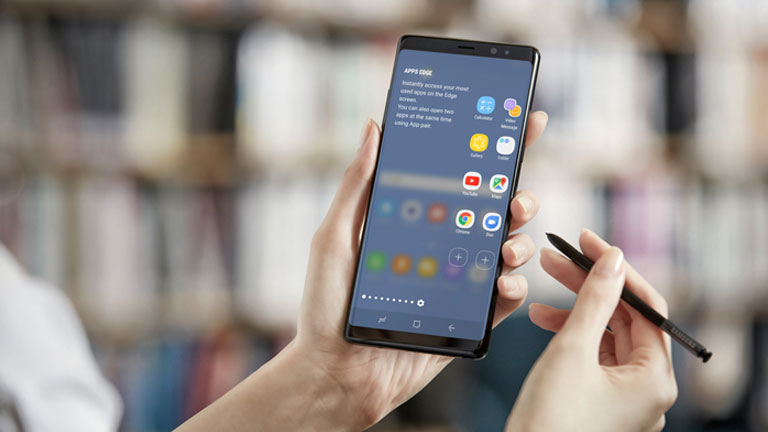
5. Galaxy S8 and Note 8
Samsung’s Galaxy S8 and Galaxy Note 8 sit atop the throne of the Android market. Though the Galaxy S8 has regularly gotten killer deals since it launched, the Note 8 hasn’t seen any serious price drops to make it a less painful purchase. But Black Friday may be an opportunity for both to get great discounts, especially as Amazon has previously offered some of the best prices on the Galaxy S8 so far.

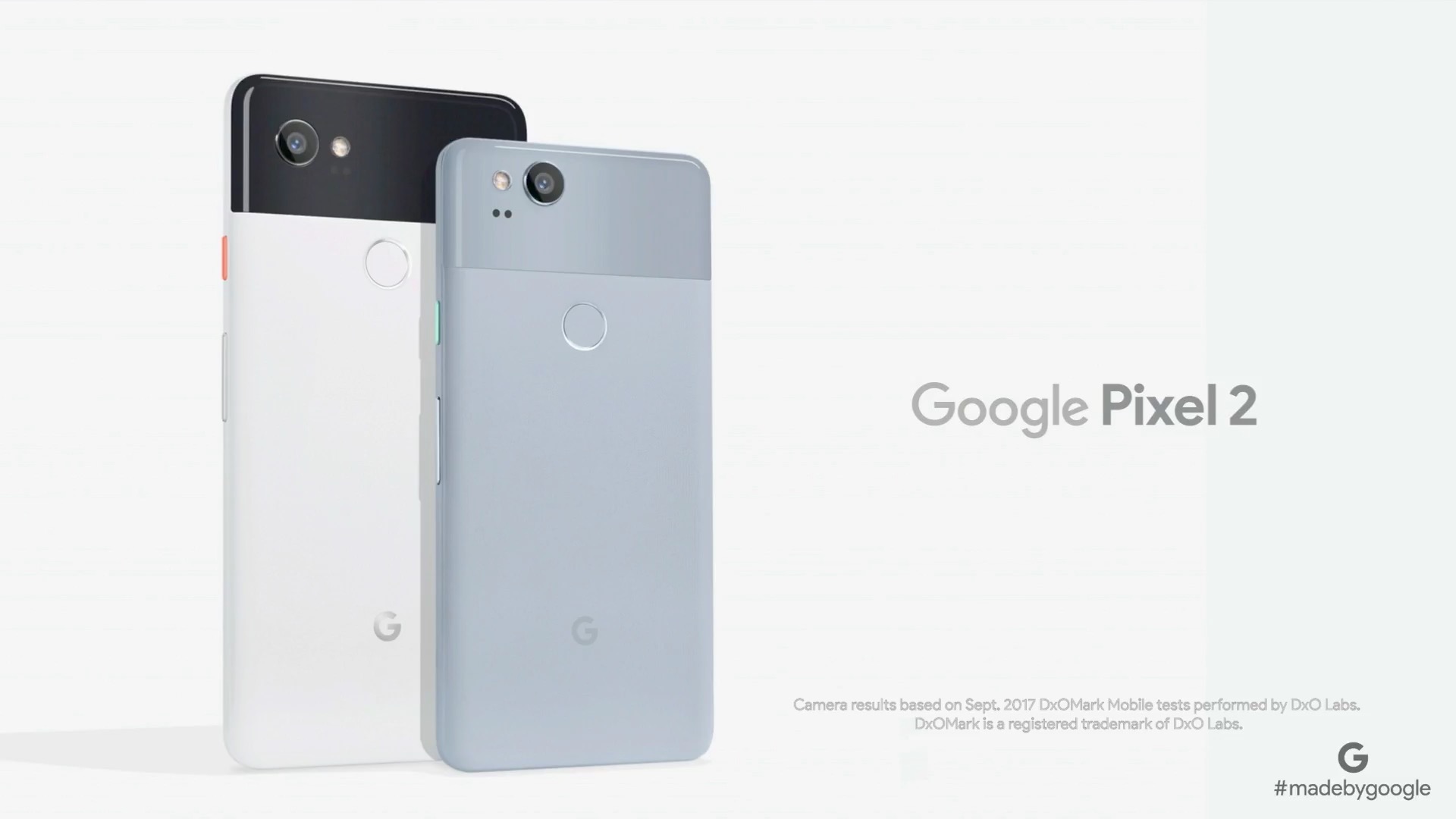
6. Google Pixel 2 and Pixel 2 XL
Google's new Pixel 2 and Pixel 2 XL won't have been on the market for long when Black Friday rolls around, but it will be no surprise for some small discounts or bundle deals to show up on Amazon.

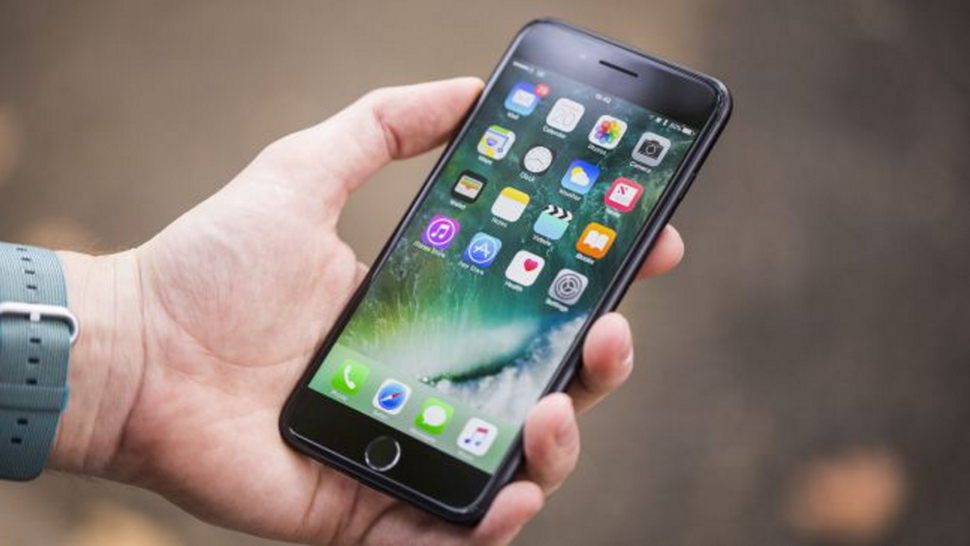
7. iPhone 7
It's too soon to expect insane deals on the iPhone 8 and iPhone X, but the previous generation of iPhones is fair game for Black Friday. Dropped prices will make it easier than ever to pick up an iPhone 7.

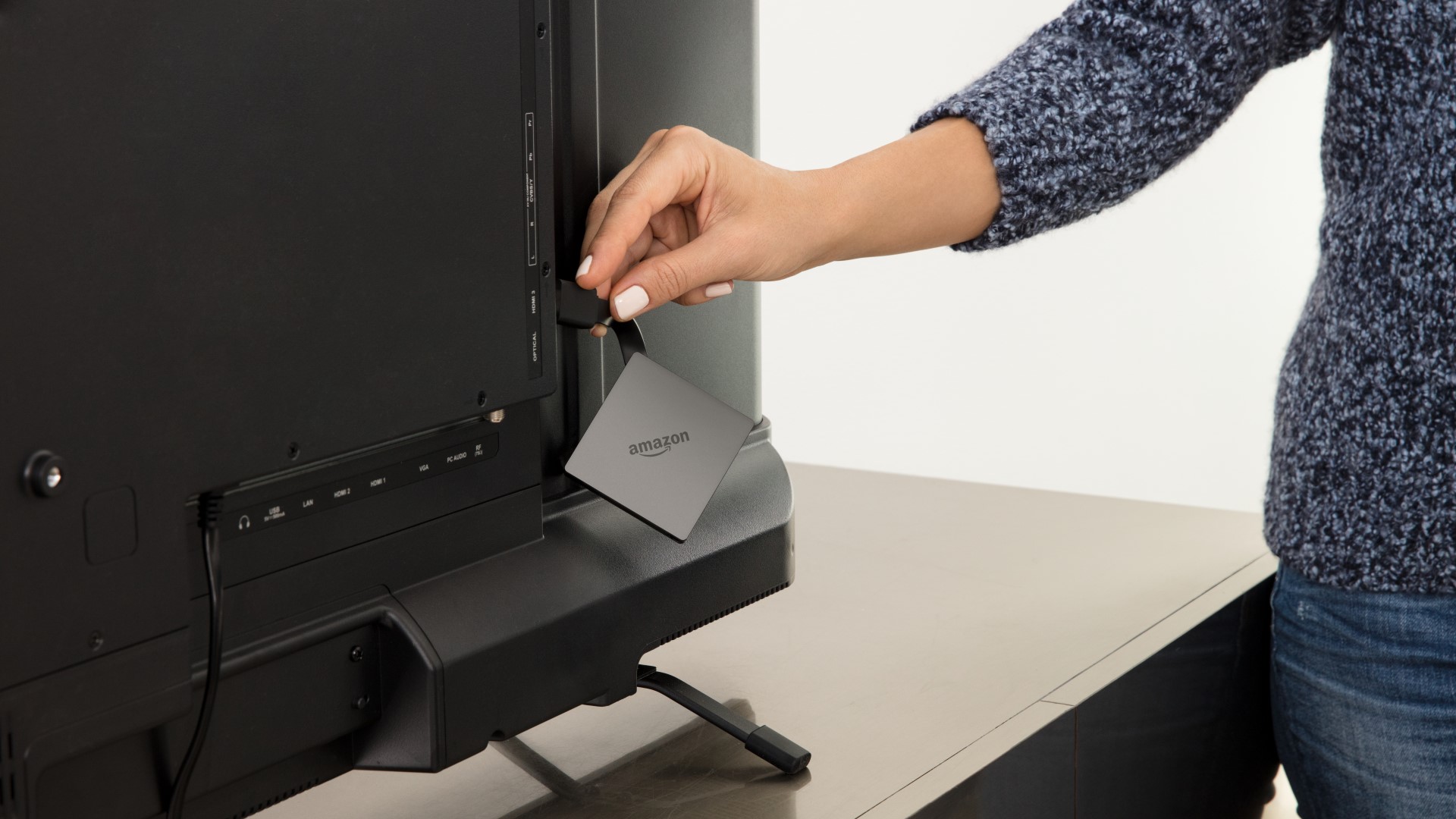
8. Fire TV with 4K Ultra HD and Alexa Voice Remote
Black Friday is an incredibly popular time to pick up a new TV, and 4K is the current craze. It's likely Amazon will use the shopping day as an opportunity to push it's 4K-ready Fire TV streaming device, either with discounts or bundled with new 4K TVs.

Amazon Black Friday deals from last year
Ahead of Black Friday 2017, here are the best deals we saw during Black Friday last year, just to whet your appetite for this year's extravaganza.

PS4 Black Friday deals - we didn't have the supercharged PS4 Pro to drool over a year ago, but we did have the newer PS4 Slim console bundled with Uncharted 4. The Sony's video game system with a 500GB hard drive and free game cost $250.


Xbox One/One S Black Friday deals - last year the Xbox One X was just a rumor, but Amazon treated buyers to the 1TB Xbox One S console bundled with Gear of War 4 for just $250. That made it $50 than it normally was.

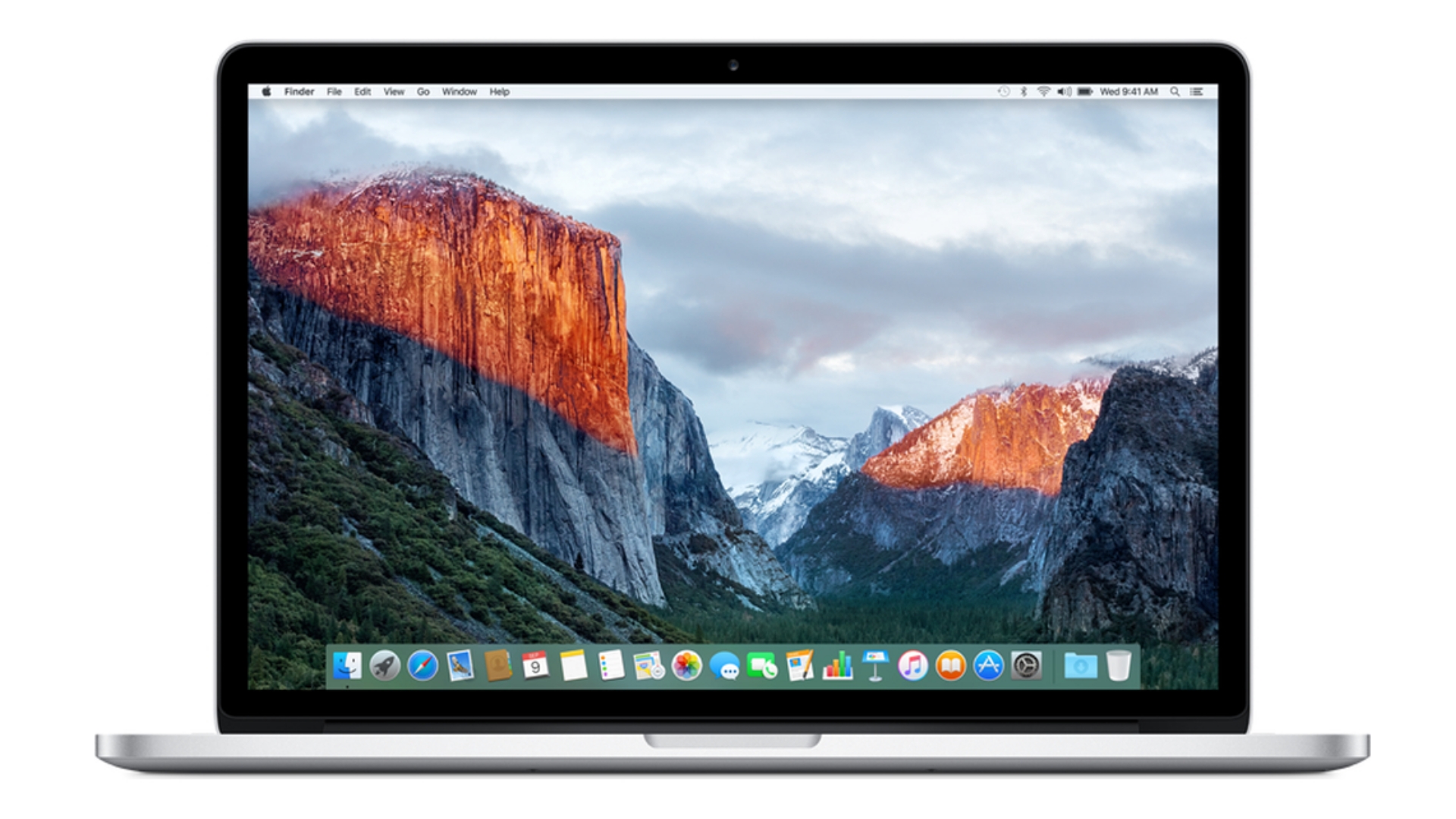
Amazon Black Friday laptop deals - there were a host of computing deals last year, including $100 off the prior year's MacBook Pro, whether you wanted the 15-inch or 13-inch versions with a Retina display. The 12-inch MacBook saw a $100 price cut, starting at just $1,199 during Black Friday.

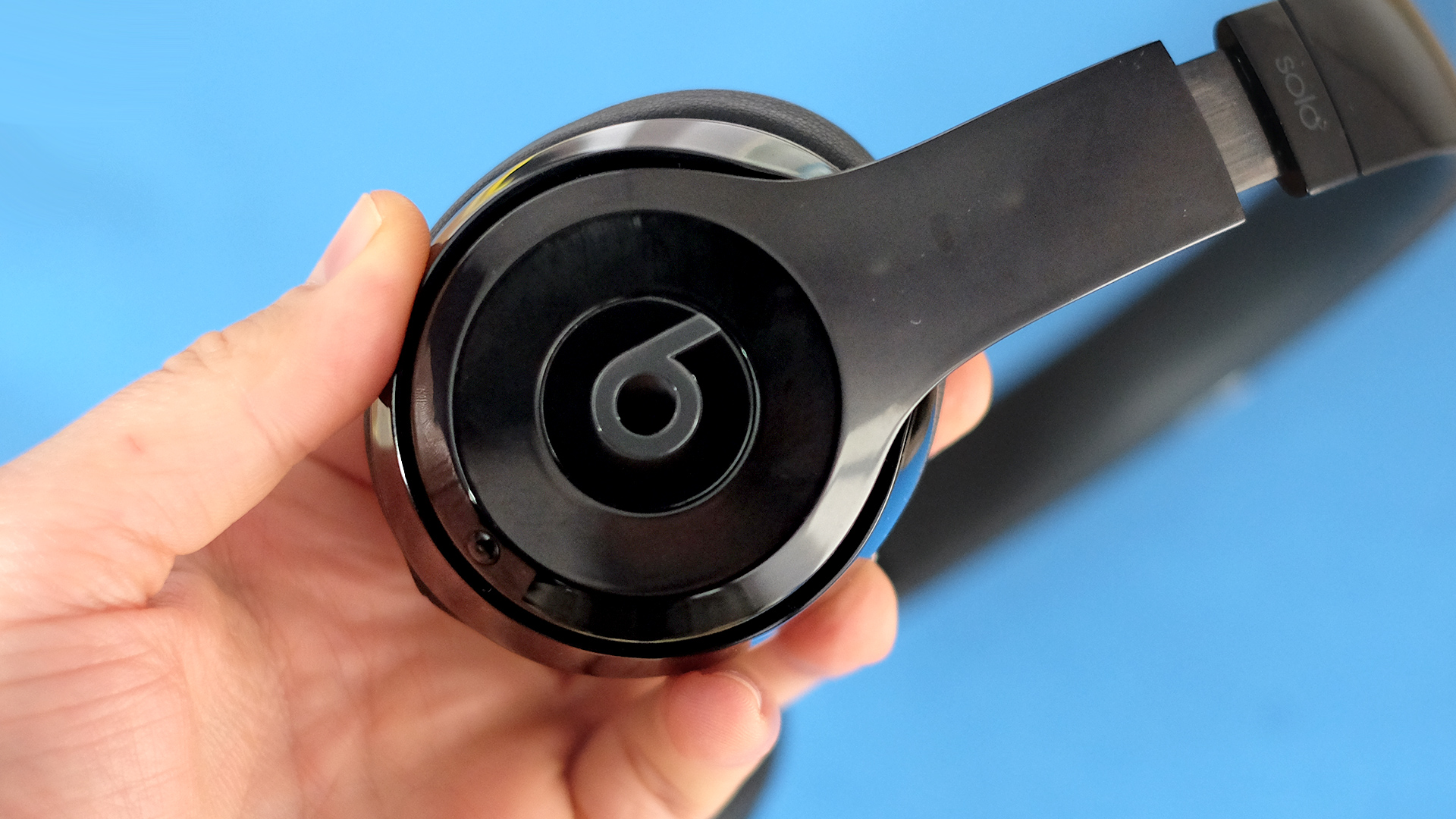
Amazon Black Friday headphone deals - audiophiles were certainly spoiled during Black Friday a few months ago, with $80 off of the Beats Solo3 headphones. Although Beats is a now an Apple company, their headphones were on sale for Black Friday. Maybe that will happen again in 2017.

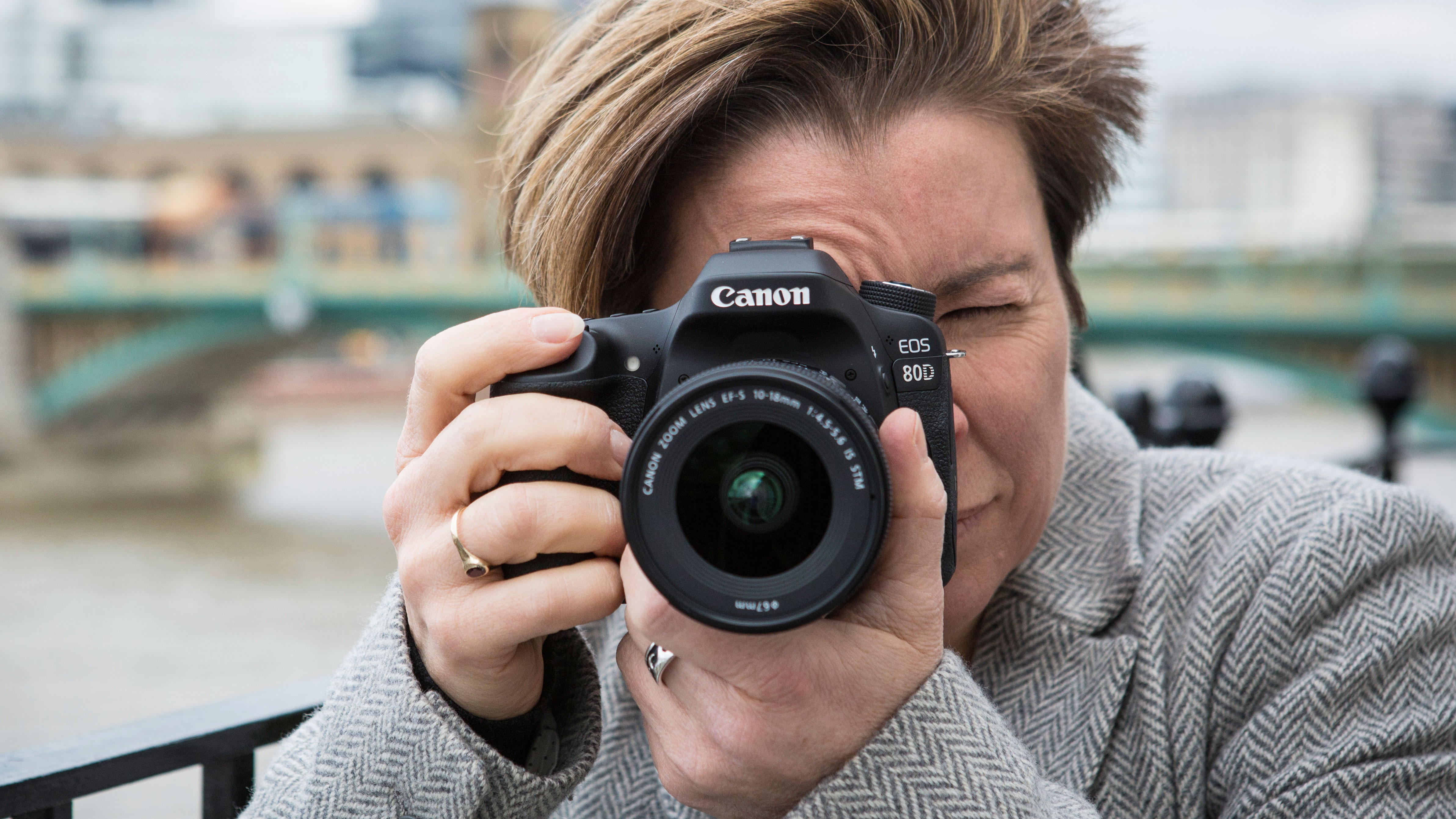
Camera Black Friday deals - You were a winner if you wanted Canon DSLR or GoPro action camera discounts on Black Friday. The Canon 80D EOS camera experienced a $400 price cut to just $1,399 on Amazon, and GoPro Hero deals were plentiful, with the entry-level version starting at under $100 for the first time.

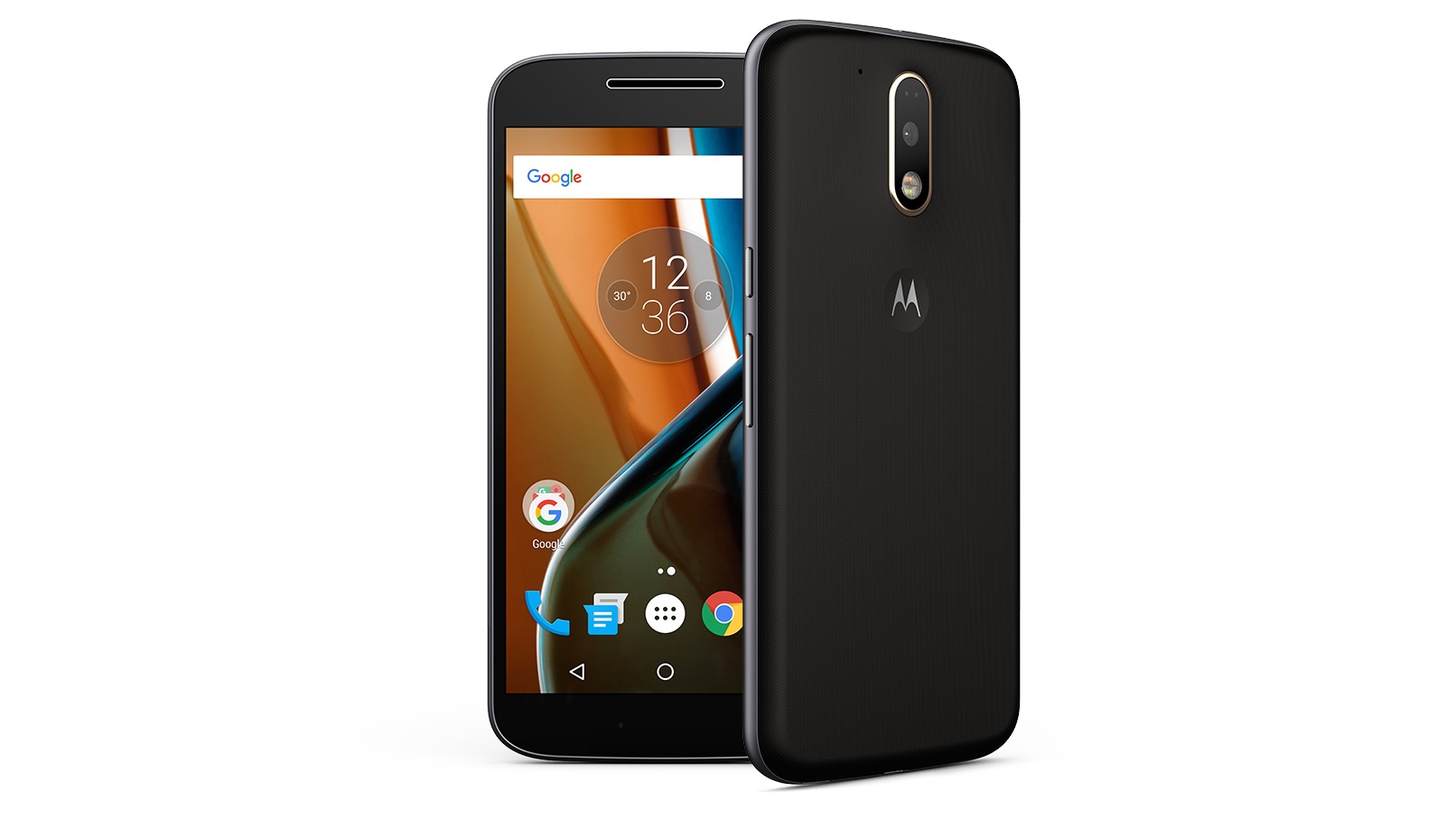
Phone Black Friday deals - Amazon is just getting started with Amazon Prime Phone deals, and that made things cheap if you were looking for a budget Android phone. The Moto G4 with 32GB of storage – our favorite affordable phone last year – for just $139.


Smart Home Black Friday deals - Amazon Echo deals were popular for Black Friday, with the new product category for many buyers seeing a $40 discount. Instead of paying full price for the flagship smart speaker with Alexa, Amazon was asking for a mere $139.99 in the US. This year, we expect Amazon Echo Show to go on sale with specs that include a helpful display.

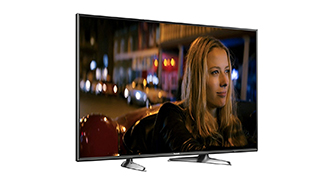
Amazon Black Friday TV deals - There's no bigger big ticket item on Amazon during Black Friday than a brand new flat-screen TV. Forgot HDTVs, we're talking about 4K televisions with HDR. We really liked the LG 55-inch 4K OLED set for $1,797 and the Samsung 40-inch UN40KU6300 at a very affordable $347 – a great value for any budget.


Wearable Black Friday deals - Fitbit and Apple Watch deals are hot on Black Friday through Amazon, with the retailer rivaling the sales at Target last year. You were able to save the most money (more than $70) if you went with the older Apple Watch Series 1. We're hoping the year-old Apple Watch 2 will be on sale via Amazon for Black Friday 2017.
Amazon on Black Friday 2017: what you need to know
Even though it has its own Prime discount day of sales, Amazon still goes all-in when it comes to Black Friday, and few retailers can match it for the breath or size of its discounts. If you're looking for Black Friday deals, you need to include Amazon on your list.
While the deals are great, sometimes it's hard to get to them, thanks to Amazon's notoriously cluttered interface - and hopefully, that's where we come in. We'll highlight the best offers for you to save you a lot of clicking and scrolling around.
We've been given a sneak preview of some of the Black Friday 2017 discounts that Amazon's planning, and while we can't share them with you yet, there are some treats in store - from short-term Lightning Deals to major discounts on hot gadgets that will run through Black Friday and beyond.
The latest and greatest smartphones won’t be left out of Amazon’s Black Friday party either, and Amazon’s own tablets and Alexa devices are all but guaranteed to make a showing in the top deals.
The hardest part of Amazon’s Black Friday is that there are so many products and so many prices, making it hard to distinguish a killer deal from a minor price drop. But, we’re here to help.
We have tips to help you identify great Amazon Black Friday deals, and we're assembling an epic Amazon Black Friday deals list for 2017, one that will offer our recommendations for everything from phones, Kindle e-readers and cameras, to PS4 Pro, Xbox One X and even toys.
You'll still have to be fast to claim these on sale gadgets. Amazon often sells out of its most popular deeply discounted electronics, with limited Deal of the Day and Lightning deals. The same thing will happen on Cyber Monday 2017.
Amazon Prime and Black Friday
Amazon Prime is always a must-have on Black Friday. It has major perks, like free two-day shipping, and members sometimes get exclusive deals tailored for Prime users.
You can get early access to the Lightning Deals on Amazon that don't stick around for very long. In other cases you might get extra discounts on prices that have dropped already, or you might get deals that don't apply to non-Prime members.
It's hard to make Amazon Black Friday predictions, but generally speaking you're at an advantage if you sign up for Amazon Prime (the retailer always wants to boost those subscription numbers after all).
At the moment a subscription costs you $99 a year, or slightly more if you go month-to-month, and of course there are a host of other benefits besides improved access to the Black Friday deals. Amazon even runs its own deals day exclusively for Prime members every summer.
You get access to the Netflix-style Amazon Prime Video, the Spotify-style Amazon Prime Music, and a ton of cloud space to store your digital photos as well. All that and more, and faster delivery times throughout the year as well.
Amazon Lightning Deals
Amazon loves its Lightning Deals: as the name suggests, these are very short-lived offers that usually involve items where the stock is low, so if you don't jump in when you've got the chance, you might miss out.
Don't feel pressured into deals you don't feel sure about - just be aware that Lightning Deals aren't going to stick around. As they're only available for a short amount of time, they often offer some very tasty discounts.
In the words of Amazon, a Lightning Deal is "a promotion in which a limited number of discounts are offered on an item for a short period of time", and you can usually find them on the Today's Deals page. As we mentioned above, Prime members get early access to the Lightning Deals on Amazon.
Here's everything you need to know about Amazon Black Friday 2017.
Amazon Black Friday 2017 predictions and ads
We don't have an Amazon Black Friday 2017 ad just yet, but we're ready to make predictions for what this year's deal will be.

1. Amazon Echo Show
We expect major Amazon Echo deals, and there'll be no bigger item than the new Amazon Echo Show during Black Friday 2017. It's already offered discounts as much as $100 off in the past when purchased in pairs. With more Echo devices hitting the market, there will be plenty of deals on these and other Alexa-enabled gadgets.


2. Xbox One S bundle
Xbox One X will be the popular new console, so we fully expect the Xbox One S to see deep discounts and bundled with free games during Black Friday. It's more than Amazon just wanting to offload its inventory. Microsoft wants to keep making the system because it allows the company to have an entry-level video game console on sale. More Xbox One systems in buyers hands means more game sales, where the real money is made.


3. Amazon Kindle Paperwhite
Amazon Kindle Paperwhite is the e-ink reader that impresses us the most, and it's almost always on sale during the holidays. It's currently on sale for $119.99 today, so you should see be able to get one even cheaper – if you want to wait.


4. 4K TVs
We can't get enough of Amazon Black Friday TV deals, and it's where we predict that you'll see price cuts by hundreds of dollars. It happened last year, and we fully expect better specs via deeply discount 4K TV sets with HDR.
We'll continue to update our Amazon Black Friday guide, as the date approaches.


5. Galaxy S8 and Note 8
Samsung’s Galaxy S8 and Galaxy Note 8 sit atop the throne of the Android market. Though the Galaxy S8 has regularly gotten killer deals since it launched, the Note 8 hasn’t seen any serious price drops to make it a less painful purchase. But Black Friday may be an opportunity for both to get great discounts, especially as Amazon has previously offered some of the best prices on the Galaxy S8 so far.


6. Google Pixel 2 and Pixel 2 XL
Google's new Pixel 2 and Pixel 2 XL won't have been on the market for long when Black Friday rolls around, but it will be no surprise for some small discounts or bundle deals to show up on Amazon.


7. iPhone 7
It's too soon to expect insane deals on the iPhone 8 and iPhone X, but the previous generation of iPhones is fair game for Black Friday. Dropped prices will make it easier than ever to pick up an iPhone 7.


8. Fire TV with 4K Ultra HD and Alexa Voice Remote
Black Friday is an incredibly popular time to pick up a new TV, and 4K is the current craze. It's likely Amazon will use the shopping day as an opportunity to push it's 4K-ready Fire TV streaming device, either with discounts or bundled with new 4K TVs.

Amazon Black Friday deals from last year
Ahead of Black Friday 2017, here are the best deals we saw during Black Friday last year, just to whet your appetite for this year's extravaganza.

PS4 Black Friday deals - we didn't have the supercharged PS4 Pro to drool over a year ago, but we did have the newer PS4 Slim console bundled with Uncharted 4. The Sony's video game system with a 500GB hard drive and free game cost $250.


Xbox One/One S Black Friday deals - last year the Xbox One X was just a rumor, but Amazon treated buyers to the 1TB Xbox One S console bundled with Gear of War 4 for just $250. That made it $50 than it normally was.


Amazon Black Friday laptop deals - there were a host of computing deals last year, including $100 off the prior year's MacBook Pro, whether you wanted the 15-inch or 13-inch versions with a Retina display. The 12-inch MacBook saw a $100 price cut, starting at just $1,199 during Black Friday.


Amazon Black Friday headphone deals - audiophiles were certainly spoiled during Black Friday a few months ago, with $80 off of the Beats Solo3 headphones. Although Beats is a now an Apple company, their headphones were on sale for Black Friday. Maybe that will happen again in 2017.


Camera Black Friday deals - You were a winner if you wanted Canon DSLR or GoPro action camera discounts on Black Friday. The Canon 80D EOS camera experienced a $400 price cut to just $1,399 on Amazon, and GoPro Hero deals were plentiful, with the entry-level version starting at under $100 for the first time.


Phone Black Friday deals - Amazon is just getting started with Amazon Prime Phone deals, and that made things cheap if you were looking for a budget Android phone. The Moto G4 with 32GB of storage – our favorite affordable phone last year – for just $139.


Smart Home Black Friday deals - Amazon Echo deals were popular for Black Friday, with the new product category for many buyers seeing a $40 discount. Instead of paying full price for the flagship smart speaker with Alexa, Amazon was asking for a mere $139.99 in the US. This year, we expect Amazon Echo Show to go on sale with specs that include a helpful display.


Amazon Black Friday TV deals - There's no bigger big ticket item on Amazon during Black Friday than a brand new flat-screen TV. Forgot HDTVs, we're talking about 4K televisions with HDR. We really liked the LG 55-inch 4K OLED set for $1,797 and the Samsung 40-inch UN40KU6300 at a very affordable $347 – a great value for any budget.


Wearable Black Friday deals - Fitbit and Apple Watch deals are hot on Black Friday through Amazon, with the retailer rivaling the sales at Target last year. You were able to save the most money (more than $70) if you went with the older Apple Watch Series 1. We're hoping the year-old Apple Watch 2 will be on sale via Amazon for Black Friday 2017.
Amazon on Black Friday 2017: what you need to know
Even though it has its own Prime discount day of sales, Amazon still goes all-in when it comes to Black Friday, and few retailers can match it for the breath or size of its discounts. If you're looking for Black Friday deals, you need to include Amazon on your list.
While the deals are great, sometimes it's hard to get to them, thanks to Amazon's notoriously cluttered interface - and hopefully, that's where we come in. We'll highlight the best offers for you to save you a lot of clicking and scrolling around.
We've been given a sneak preview of some of the Black Friday 2017 discounts that Amazon's planning, and while we can't share them with you yet, there are some treats in store - from short-term Lightning Deals to major discounts on hot gadgets that will run through Black Friday and beyond.

Steve Wozniak launches online university aimed at making tech ed more affordable
Apple co-founder Steve Wozniak believes it’s currently too expensive to earn a degree in tech, and so he recently announced the opening of Woz U, an online university that aims to make tech education more affordable.
You’ll currently only find the Arizona-based Woz U online, but Wozniak hopes he’ll eventually see physical campuses in over 30 cities in the US and throughout the world.
Woz U’s current programs only include software development and training to be computer support specialists, but additional programs for data science, mobile applications, and cybersecurity programs are reportedly “coming soon.”
"Our goal is to educate and train people in employable digital skills without putting them into years of debt," Wozniak said in a prepared statement. "People often are afraid to choose a technology-based career because they think they can't do it. I know they can, and I want to show them how."
Woz U also provides K-12 schools with STEAM programs that help ease kids into a career in tech. Businesses can benefit from his “Woz U Enterprise” program, which helps companies train their employees to handle new technology.
In 2019, Wozniak aims to launch Woz U Accelerator, a program that’s meant to “identify and develop elite tech talent.”
You can currently find the Woz U app on the Apple App Store, and it chiefly acts as a 10-question aptitude test of sorts. When I tried it myself, it claimed my strengths were deductive reasoning and logic, and that I should study to become a software developer with a focus on Java. Apparently a representative from Woz U will be calling me soon to speak more about my options.
We’ll see how that goes. Right now, there’s no word on pricing, so hopefully this call will reveal more about that.
Education toys and tech should see discounts with Amazon deals this Black Friday
You’ll currently only find the Arizona-based Woz U online, but Wozniak hopes he’ll eventually see physical campuses in over 30 cities in the US and throughout the world.
Woz U’s current programs only include software development and training to be computer support specialists, but additional programs for data science, mobile applications, and cybersecurity programs are reportedly “coming soon.”
"Our goal is to educate and train people in employable digital skills without putting them into years of debt," Wozniak said in a prepared statement. "People often are afraid to choose a technology-based career because they think they can't do it. I know they can, and I want to show them how."
Woz U also provides K-12 schools with STEAM programs that help ease kids into a career in tech. Businesses can benefit from his “Woz U Enterprise” program, which helps companies train their employees to handle new technology.
In 2019, Wozniak aims to launch Woz U Accelerator, a program that’s meant to “identify and develop elite tech talent.”
You can currently find the Woz U app on the Apple App Store, and it chiefly acts as a 10-question aptitude test of sorts. When I tried it myself, it claimed my strengths were deductive reasoning and logic, and that I should study to become a software developer with a focus on Java. Apparently a representative from Woz U will be calling me soon to speak more about my options.
We’ll see how that goes. Right now, there’s no word on pricing, so hopefully this call will reveal more about that.
Education toys and tech should see discounts with Amazon deals this Black Friday

The 30 best indie games on PC and consoles
When you’ve grown tired of the predatory antics demonstrated by the more prominent triple-A game studios, perhaps the best indie games will calm your nerves. Nowadays, you don’t need a massive, multi-million dollar budget to have a good time. Instead, our studies show that the best indie games are just as fun, if not more so than, their blockbuster counterparts.
As such, we should praise the best indie games. Whether they’ve earned that title because they tell compelling stories or impress with their various styles of gameplay, there’s no denying that every now and then, we should take our attention away from the blinding light of Destiny 2 raids in favor of spending a modest hundred hours or so in Stardew Valley on the Nintendo Switch.
You'll want only the best PC to run these indie paragons
However, things tend to get tricky when anyone can publish a game. Valve’s Steam marketplace, for instance, is littered with shovelware, resulting in our mission to filter out all the trash – sifting through heaps of indie darlings to uncover only the most noteworthy gems. From the inspired Braid to the competitive Nidhogg 2, these are all the best indie games you can buy.
Joe Osborne, Kane Fulton and Gabe Carey have also contributed to this article
As a mostly faithful homage to the original X-COM: UFO Defense, the first Xenonauts game drew our attention in spite of the fact that Firaxis Games would resurrect the series properly not two years later. Leveraging a controversial 2D art style, however, Xenonauts was seemingly hoisted by its own petard.
With Xenonauts 2, the mildly anticipated sequel still slated to come out sometime this year, indie studio Goldhawk Interactive is aiming higher with full 3D graphics made possible by the Unity engine. The turn-based strategy game has some big shoes to fill, however, considering it’s now up against Ubisoft’s Mario + Rabbids: Kingdom Battle as much as it is XCOM.
Still, you can take Xenonauts 2 for a test drive via the free demo available now on GOG. Do note that this demo requires the download and installation of CD Projekt’s GOG Galaxy software to play and will be deleted upon Xenonauts 2’s paid alpha launch.
Expected: 2017
Jonathan Blow's masterpiece first appears to be a simple pastiche of Super Mario Bros, with a middle-aged curmudgeon replacing the titular plumber but still seeking to rescue a princess.
But as you spend time with it, it reveals more of itself, moving from a series of time-bending puzzles to quiet reflective texts – which doesn't stop it being the smartest puzzle game until SpaceChem. Blow himself has hinted that the ultimate story might be something to do with the atomic bomb.
First released as PC freeware by Japanese designer Daisuke "Pixel" Amaya back in 2004 after five years of 100% solo development, Cave Story predates the recent indie renaissance by a few years. Because of when and how it was first released, it's often forgotten in discussions of indie gaming.
But this classic deserves to be on every best-of list for its loving homage to the classic action platforming games of the Super Nintendo era, its incredible music and its incredibly vibrant world. Oh, and don't forget the hugely intuitive controls, gobs of secrets and weapons that are entirely too fun to use. If you've yet to enjoy this one, just put it on your backlog already.
Most mainstream games are escapist power fantasies, where the player grows their capabilities until they dominate the game's universe - and then the game ends. Yet many indie games are dis-empowerment fantasies - like the IGF award winner and misery sim Cart Life.
Papers Please is similar to Cart Life - it's also an IGF winner with elements of misery about it - but it's better, being a smart, weird sim about the compromised life of a border guard under a totalitarian regime. It's ugly and desperate, but also innovative, uproariously funny and terribly smart.
Among the hardcore gamers of my acquaintance, Spelunky is the go-to drug. Even today, several years after its release, some of them still play it every day, despite having completed it many times over. That's because Spelunky, an ostensibly rogue-like platformer with a definite end, is tough, varied and highly randomized.
It also has more dark secrets than a presidential candidate, meaning there are many, many ways to finish it, and its daily challenges are a sure-fire way to public humiliation.
Humor is often something absent from games, mostly being restricted to slapstick comedy or crude one-liners. The Stanley Parable, by contrast, is hilarious without dumbing down. Players follow (or don't) a very English narrative voice who changes the world around you, depending on your decision.
No decision is punished, every play-through throws up new humor and weirdness. Being trapped in the closet in the Stanley Parable is more moving and funny than 9/10 other games.
Further reading: Retro-me-do! Digitiser's Mr Biffo on his top PC games of all time
Nine years in the making, Owlboy was well worth the wait. Originally contrived for PCs and released in late 2016, the clever masterpiece of an indie game is now available to experience on Mac and Linux as well. Owlboy centers around a race of owl-human hybrid characters called Owls. Of them, you helm control of an Otis, an Owl who is censured by his mentor for his inept flying abilities.
The story sees Otis’ village dismantled by pirates who clearly have conflict with the Owls. As a result, Otis has to work with an assortment of villagers in-game to take out enemies. Of course, when boss battles arise, you’ll need to manage allies accordingly, as each character comes with their own set of unique skillsets to use in conjunction with one another. If you’ve ever played and enjoyed a Kid Icarus game, this is one for the books. Otherwise, play it anyway.
Like The Stanley Parable, Gone Home falls into the unofficially deemed "walking simulator" genre. Unlike the simultaneously clever and philosophical Stanley Parable, however, Gone Home is less fixated on the lighter issues and more concerned with some of life's more difficult realities.
After getting home from a stay overseas, you play as 21-year-old Kaitlin Greenbriar who is greeted by a vacant residency. While gameplay in Gone Home is mainly limited to scavenging through notes to find out where the protagonist's family has ventured off to, the gripping story exhibits a rollercoaster of emotions, if you keep an open mind.
Only SpaceChem has mingled education with entertainment as successfully as The Kerbal Space Program. The game is simple - design and build spacecraft to take the cutesy Kerbals to the Mun and beyond.
Yet its focused use of real physics means that you'll find yourself following NASA in building multi-stage rockets, space stations and exploring the Kerbal's strange universe on EVAs, before bringing your discoveries back to research on the Kerbal planet - that's if you can get off the ground at all. It's a huge, complex, challenging and fun game, that's smart without being preachy.
The exact opposite of the Kerbal Space Program, The Binding of Isaac is an action roguelike par excellence. Matched only by the equally visceral Nuclear Throne for replayability, you play as a young boy attempting to kill his damned siblings, his Mom, and possibly the Devil, using only his tears. Which he shoots from his eyes, of course.
With hundreds of weird modifiers to discover, endlessly touch procedurally-generated levels, and secrets galore, Isaac is a very dark take on the exploratory model established by Spelunky.
Though you may be turned off by the pixel art graphics, Undertale isn't a game that could easily have run on the Nintendo Super NES. That's because, in Undertale, your personal decisions play a huge role in how the game ends, and moreover, how it continues in New Game Plus.
One of the first things you'll notice about Undertale is how much freedom the game gives you. Despite its cleverly integrated boss matches, you can play through the entire 9 or so hours of Undertale without executing a single kill. Plus, when you complete the game, you'll be pleased to discover that you can play through Undertale again, this time bearing the weight of your consequences from the previous run.
From developer Playdead, Inside is comparable to its predecessor, Limbo, in some ways but with an added layer of depth that inspires frequent wonder. This is mostly a result of the unspoken narrative, which revolves around yet another nameless boy. In Inside, however, the boy in the story is running away from a group of men who – if you fail to stay out of their sights – will try to mercilessly kill you.
Though it isn't quite clear why the boy is running from these men or why you should even care since you don't know who he is, Inside will leave you begging for answers. The bleak, lifeless setting of Inside is more than worth the price of admission. Its minimalist art style alone is avant-garde enough to feel right at home in a museum. Add in a game that's both fun to play and dripping with curiosity, though, and Inside is one of the best indie games money can buy.
Developed single-handedly by Eric Barone, Stardew Valley is undoubtedly a technical feat for that little facet alone. If you’ve ever played a Harvest Moon game, you’re already familiar with the premise of Stardew Valley – you may just not know it yet. Stardew Valley is an addictive farming simulator which sees you interact with townees to the point where you can literally marry them.
Stardew Valley isn’t just one thing; it’s a whole bunch of things at once. You can engage in crafting, fishing, cooking and even exploring procedurally-generated caves to mine for items and even take on monstrous enemies. However, do keep in mind your health and energy as you’ll need to make sure your character is in tip-top shape in order to avoid suffering from exhaustion. Lose health and you lose a considerable amount of money and items you’ve worked hard to attained. Stardew Valley will have you hooked for hours on end, for better or worse. (Better, definitely better.)
From Canadian game developer Alec Holowka, the creator of the award-winning Aquaria (also featured on this list) and independent artist/animator Scott Benson, Night in the Woods is an unconventional side-scrolling adventure game centering around a 20-year-old protagonist named Mae who drops out of college to move back in with her parents.
Featuring a story largely based around dialog choices and mini games that put a spin on mundane tasks like carrying boxes up the stairs and eating perogies, Night in the Woods is a timeless coming-of-age tale. Not only get to experience middle class America through the eyes of a personified cat, but virtually every interaction in-game will have you laughing aloud.
Finally, the man responsible for the incredible orchestral arrangement in the hit PlayStation game Journey is back with Abzu, the first game ever from indie developer Giant Squid Studios. Founded by former thatgamecompany art director Matt Nava, Giant Squid had little to lose with its video game debut on both PC and PS4.
Abzu is described as a "stylized swimming simulator" that accurately depicts the relationship between ocean life and its interactions with humans. Like Journey, the game is told linearly with a silent protagonist. Abzu manages to hold its own, though, drawing influence from popular role-playing games with the ability to upgrade equipment.
Though newcomers may be offput by its clearly retro-inspired, twin-stick shoot ‘em up design, Nex Machina is a gem for fans of the classics. Featuring a play-style that’s heavily influenced by arcade cabinets Robotron (1982) and Smash TV (1990), Nex Machina will feel familiar to anyone versed in the products of games industry veteran Eugene Jarvis.
That’s because Jarvis served as a creative consultant on this project, whose creation was helmed primarily by Super Stardust and Resogun developer Housemarque. Similar to Jarvis’ previous works, Nex Machina is played from a top-down perspective, with players taking out waves of enemies in order to protect human allies.
Introversions was one of the earliest 'indie' companies, releasing games like Uplink, Defcon and Darwinia whilst Vlambeer were still in short pants. After years of struggling, they've finally hit a huge success with Prison Architect, a game where you build, staff, outfit and manage a maximum security prison.
With smart prisoners who are willing to do anything to escape, you'll struggle to keep them all inside - or keep them from rioting - and turn a profit. It's still in alpha, but it's eminently playable right now..
While The Kerbal Space Program might actually take you (or at least those poor doomed Kerbals) to the moon, To The Moon is a game about wish fulfillment, and thrives on narrative. In terms of movies, Kerbal is Gravity and Isaac is Saw, To The Moon is Eternal Sunshine of the Spotless Mind.
You control two doctors who are exploring a dying man's memories to implant a false memory so he can die in peace. Which is all depicted in a classic 16-bit Zelda style. It's a rare, brave, adult game.
Dwarf Fortress is its own genre, its own industry. This is a game that, before you've even set foot in it, has to generate the entire geography, mythology and history of its massive world. Then it tracks every single one of the dwarfs you're managing down to the hairs on their legs and the particular horrible elephant murder that they witnessed and they're now carving on an ornamental chair.
Your task is to keep the dwarves alive as they carve out their subterranean kingdom - given that insanity, monsters, and starvation plague are thrown at them at every stage that's not easy. And dwarves, always, always mine too deep.
Run. Jump. Die. Repeat. That's the basic premise of Super Meat Boy, a fiendishly addictive 2D platformer that's also bloody hard, with an emphasis on bloody. Pints of the red stuff is spilled as the game's eponymous meaty hero leap over deadly drops, spinning blades and walking chainsaws in a bid to rescue his girlfriend, Bandage Girl, from the evil Dr Foetus. Obviously. Boasting tight controls, plenty of humor and color graphics, Super Meat Boy leapt onto the PS4 and Vita this year in style.
Limbo is a platformer with a difference. Five years after its initial release, the game's haunting storyline still affects us. You play The Boy, a child with glowing eyes who's cast into Limbo to find his sister. Making your way through a bleak and dangerous world full of hostile silhouettes, giant spiders and deadly gravitational fields, you'll need to think on your feet and time your movements to perfection to survive.
But Limbo is much more than a simple platformer: it's an experience, and one that has you pondering the very essence of life by the time it's over. Deep, profound and absorbing, it's one indie game everybody should take time out to play.
If you're yearning for a retro-styled multiplayer archery combat game (aren't we all?), TowerFall: Ascension is the pick of the lot. Fast, frenetic and teeth-gnashingly hard in hardcore mode, the game's mechanics are simple: fire arrows at enemies or jump on their heads to stay alive until the round ends.
Arrows that don't hit are embedded in walls, making for tense scenarios when you have to traverse the map while dodging enemies to retrieve them. As such, practicing until you achieve Robin Hood-esque levels of accuracy is recommended. Ascension is best experienced with friends in local multiplayer mode, which recalls Super Smash Bros' most manic moments.
Serving as a spiritual successor to a pair of staples in PC gaming history, namely Myst and Riven, Obduction carries on the legacy of traditional point-and-click adventure games focused on advanced puzzle-solving techniques. Unlike most modern adventure games, Obduction is the kind of game you'll have to take notes to complete, being hyperaware of everything in your surroundings to extract subtle hints from its environments.
Obduction has a gripping story that you'll have to exert a lot of brainpower to get through. It's not a game that'll hold your hand if you get stuck. Au contraire! Obduction isn't bottlenecked by the typical UI practices of conventional video games. No, you just have to go for it with no instruction at all, leaving it up to you to figure out how to get to the next point. Until you do, Obduction will mock you with its beautifully rendered HDR environments and Nvidia Ansel support.
This gorgeous, underwater world was created by independent studio Bit Blot and released way back in 2007, and it absolutely still holds up. Think of Aquaria as a cross between the old Metroid games and the Ecco the Dolphin games – in all the best, and most challenging, ways.
You are Naija, a humanoid sea creature (not a mermaid!) that is exploring a new world to her after awakening from a life-long dream. She soon gains the ability to manipulate The Verse, a supernatural force that pervades all of Aquaria, which gradually unlocks new abilities and locations to explore.
After the raging success that was the original Nidhogg, it’s a shame to see the superior sequel get thrown under the bus. Nevertheless, in spite of its controversial art style, Nidhogg 2 packs a refined, gorgeous look that the first version, a cult-classic, couldn’t even think to compete with. In still frames, we can see how this could get misconstrued, but fortunately, it’s the fun and addictive local multiplayer gameplay that makes Nidhogg, well, Nidhogg. And it’s all there in Nidhogg 2. Plus, every time you respawn, you get one of four unique weapons that only bolster the challenge.
Esteemed indie designer Jon Blow's follow up to Braid may look like an entirely different adventure, being 3D and all, but the two are more thematically alike than you might think. The Witness, at its core, is another puzzle game that tells an interesting story through said puzzles.
This puzzler takes place in an almost equally impressionist – albeit heavily Myst-inspired – world, but it's story is far more nuanced and mysterious than Blow's previous. At almost every corner of this island that you've simply woken up on (or beneath), there is a clue as to how you got onto this island and why you're here.
A 2D action RPG based on the best 8- and 16-bit classics, Hyper Light Drifter was a big Kickstarter success. Now, we know that's because of its glorious pixel graphics and combat that's halfway between SuperGiant's seminal Bastion and an edgy Legend of Zelda revamp.
Despite appearances, it's a combat-focused game wherein you explore the unknown, ruined world of Buried Time, inspired by nightmares and dreams, where your Drifter is searching for the cure for a fatal disease that he or she is clearly suffering.
If you remember games like Contra or Jackal even a little bit, then BroForce will immediately speak to you. This four-player, side-scrolling cooperative shoot-em-up combines modern action game features, like destructible environments, with an obvious respect for the nostalgia many of us hold for these games.
Every level in BroForce is a race to the rendezvous point, and you're one of countless "Bros", goofy characters inspired by the real-life action heroes of today. Complete with a rescue system for Bros that have lost one too many lives, BroForce both parodies the bro-tastic action flicks that rake in millions and instills a fun level of camaraderie through clever mechanics.
Exploring a surreal wilderness seems like quite the trend these days in gaming, and developer Campo Santo's debut only serves to keep it going strong. Set in the wilderness of 1989 Wyoming, you're Henry, a fire lookout that's all alone in the woods after exploring something strange in the distance.
That is, save for your partner on the other line of a walkie-talkie: Delilah. She's your only point of contact as you explore the wilderness. Will you make it back alive? Will the decisions you make help or harm the relationship with your only lifeline to the outside world, your boss? Don't worry about those questions just yet – just look at those forestscapes!
Rust is one of the more successful indie titles of recent times. By the end of 2015 it had sold more than 3 million copies, which isn't too shabby considering it isn't even finished — the game has been on Steam's Early Access scheme since launching in December 2013.
Still, it seems people can't get enough of the Day Z-inspired survival sim. It sees you use your wits and bearings to survive its harsh open world, starting off with nothing but a rock. After gathering resources needed to build a house and weapons to fend off attackers (other online players, in other words), Rust gradually becomes more intense as you defend your growing base — or attempt to breach others'.
The latest from Supergiant Games, Pyre is an action role-playing sports game whose combat mechanics feel like an oddly sensational blend of Dota 2 and NBA Jam. Taking place in a high fantasy setting, Pyre won’t appeal to everyone, but if you like the idea of being exiled from society and teaming up with other exiles to take down your own kind, then you might enjoy Pyre.
Using on-screen passages to tell its narrative, Pyre is heavily based around choice and implements its morality systems in a way that is unusually intertwined with the gameplay. You can make the choice to release a member of your party for the sake of their own contentment or keep dragging them along and complete the game more efficiently on your end.
As such, we should praise the best indie games. Whether they’ve earned that title because they tell compelling stories or impress with their various styles of gameplay, there’s no denying that every now and then, we should take our attention away from the blinding light of Destiny 2 raids in favor of spending a modest hundred hours or so in Stardew Valley on the Nintendo Switch.
You'll want only the best PC to run these indie paragons
However, things tend to get tricky when anyone can publish a game. Valve’s Steam marketplace, for instance, is littered with shovelware, resulting in our mission to filter out all the trash – sifting through heaps of indie darlings to uncover only the most noteworthy gems. From the inspired Braid to the competitive Nidhogg 2, these are all the best indie games you can buy.
Joe Osborne, Kane Fulton and Gabe Carey have also contributed to this article
As a mostly faithful homage to the original X-COM: UFO Defense, the first Xenonauts game drew our attention in spite of the fact that Firaxis Games would resurrect the series properly not two years later. Leveraging a controversial 2D art style, however, Xenonauts was seemingly hoisted by its own petard.
With Xenonauts 2, the mildly anticipated sequel still slated to come out sometime this year, indie studio Goldhawk Interactive is aiming higher with full 3D graphics made possible by the Unity engine. The turn-based strategy game has some big shoes to fill, however, considering it’s now up against Ubisoft’s Mario + Rabbids: Kingdom Battle as much as it is XCOM.
Still, you can take Xenonauts 2 for a test drive via the free demo available now on GOG. Do note that this demo requires the download and installation of CD Projekt’s GOG Galaxy software to play and will be deleted upon Xenonauts 2’s paid alpha launch.
Expected: 2017
Jonathan Blow's masterpiece first appears to be a simple pastiche of Super Mario Bros, with a middle-aged curmudgeon replacing the titular plumber but still seeking to rescue a princess.
But as you spend time with it, it reveals more of itself, moving from a series of time-bending puzzles to quiet reflective texts – which doesn't stop it being the smartest puzzle game until SpaceChem. Blow himself has hinted that the ultimate story might be something to do with the atomic bomb.
First released as PC freeware by Japanese designer Daisuke "Pixel" Amaya back in 2004 after five years of 100% solo development, Cave Story predates the recent indie renaissance by a few years. Because of when and how it was first released, it's often forgotten in discussions of indie gaming.
But this classic deserves to be on every best-of list for its loving homage to the classic action platforming games of the Super Nintendo era, its incredible music and its incredibly vibrant world. Oh, and don't forget the hugely intuitive controls, gobs of secrets and weapons that are entirely too fun to use. If you've yet to enjoy this one, just put it on your backlog already.
Most mainstream games are escapist power fantasies, where the player grows their capabilities until they dominate the game's universe - and then the game ends. Yet many indie games are dis-empowerment fantasies - like the IGF award winner and misery sim Cart Life.
Papers Please is similar to Cart Life - it's also an IGF winner with elements of misery about it - but it's better, being a smart, weird sim about the compromised life of a border guard under a totalitarian regime. It's ugly and desperate, but also innovative, uproariously funny and terribly smart.
Among the hardcore gamers of my acquaintance, Spelunky is the go-to drug. Even today, several years after its release, some of them still play it every day, despite having completed it many times over. That's because Spelunky, an ostensibly rogue-like platformer with a definite end, is tough, varied and highly randomized.
It also has more dark secrets than a presidential candidate, meaning there are many, many ways to finish it, and its daily challenges are a sure-fire way to public humiliation.
Humor is often something absent from games, mostly being restricted to slapstick comedy or crude one-liners. The Stanley Parable, by contrast, is hilarious without dumbing down. Players follow (or don't) a very English narrative voice who changes the world around you, depending on your decision.
No decision is punished, every play-through throws up new humor and weirdness. Being trapped in the closet in the Stanley Parable is more moving and funny than 9/10 other games.
Further reading: Retro-me-do! Digitiser's Mr Biffo on his top PC games of all time
Nine years in the making, Owlboy was well worth the wait. Originally contrived for PCs and released in late 2016, the clever masterpiece of an indie game is now available to experience on Mac and Linux as well. Owlboy centers around a race of owl-human hybrid characters called Owls. Of them, you helm control of an Otis, an Owl who is censured by his mentor for his inept flying abilities.
The story sees Otis’ village dismantled by pirates who clearly have conflict with the Owls. As a result, Otis has to work with an assortment of villagers in-game to take out enemies. Of course, when boss battles arise, you’ll need to manage allies accordingly, as each character comes with their own set of unique skillsets to use in conjunction with one another. If you’ve ever played and enjoyed a Kid Icarus game, this is one for the books. Otherwise, play it anyway.
Like The Stanley Parable, Gone Home falls into the unofficially deemed "walking simulator" genre. Unlike the simultaneously clever and philosophical Stanley Parable, however, Gone Home is less fixated on the lighter issues and more concerned with some of life's more difficult realities.
After getting home from a stay overseas, you play as 21-year-old Kaitlin Greenbriar who is greeted by a vacant residency. While gameplay in Gone Home is mainly limited to scavenging through notes to find out where the protagonist's family has ventured off to, the gripping story exhibits a rollercoaster of emotions, if you keep an open mind.
Only SpaceChem has mingled education with entertainment as successfully as The Kerbal Space Program. The game is simple - design and build spacecraft to take the cutesy Kerbals to the Mun and beyond.
Yet its focused use of real physics means that you'll find yourself following NASA in building multi-stage rockets, space stations and exploring the Kerbal's strange universe on EVAs, before bringing your discoveries back to research on the Kerbal planet - that's if you can get off the ground at all. It's a huge, complex, challenging and fun game, that's smart without being preachy.
The exact opposite of the Kerbal Space Program, The Binding of Isaac is an action roguelike par excellence. Matched only by the equally visceral Nuclear Throne for replayability, you play as a young boy attempting to kill his damned siblings, his Mom, and possibly the Devil, using only his tears. Which he shoots from his eyes, of course.
With hundreds of weird modifiers to discover, endlessly touch procedurally-generated levels, and secrets galore, Isaac is a very dark take on the exploratory model established by Spelunky.
Though you may be turned off by the pixel art graphics, Undertale isn't a game that could easily have run on the Nintendo Super NES. That's because, in Undertale, your personal decisions play a huge role in how the game ends, and moreover, how it continues in New Game Plus.
One of the first things you'll notice about Undertale is how much freedom the game gives you. Despite its cleverly integrated boss matches, you can play through the entire 9 or so hours of Undertale without executing a single kill. Plus, when you complete the game, you'll be pleased to discover that you can play through Undertale again, this time bearing the weight of your consequences from the previous run.
From developer Playdead, Inside is comparable to its predecessor, Limbo, in some ways but with an added layer of depth that inspires frequent wonder. This is mostly a result of the unspoken narrative, which revolves around yet another nameless boy. In Inside, however, the boy in the story is running away from a group of men who – if you fail to stay out of their sights – will try to mercilessly kill you.
Though it isn't quite clear why the boy is running from these men or why you should even care since you don't know who he is, Inside will leave you begging for answers. The bleak, lifeless setting of Inside is more than worth the price of admission. Its minimalist art style alone is avant-garde enough to feel right at home in a museum. Add in a game that's both fun to play and dripping with curiosity, though, and Inside is one of the best indie games money can buy.
Developed single-handedly by Eric Barone, Stardew Valley is undoubtedly a technical feat for that little facet alone. If you’ve ever played a Harvest Moon game, you’re already familiar with the premise of Stardew Valley – you may just not know it yet. Stardew Valley is an addictive farming simulator which sees you interact with townees to the point where you can literally marry them.
Stardew Valley isn’t just one thing; it’s a whole bunch of things at once. You can engage in crafting, fishing, cooking and even exploring procedurally-generated caves to mine for items and even take on monstrous enemies. However, do keep in mind your health and energy as you’ll need to make sure your character is in tip-top shape in order to avoid suffering from exhaustion. Lose health and you lose a considerable amount of money and items you’ve worked hard to attained. Stardew Valley will have you hooked for hours on end, for better or worse. (Better, definitely better.)
From Canadian game developer Alec Holowka, the creator of the award-winning Aquaria (also featured on this list) and independent artist/animator Scott Benson, Night in the Woods is an unconventional side-scrolling adventure game centering around a 20-year-old protagonist named Mae who drops out of college to move back in with her parents.
Featuring a story largely based around dialog choices and mini games that put a spin on mundane tasks like carrying boxes up the stairs and eating perogies, Night in the Woods is a timeless coming-of-age tale. Not only get to experience middle class America through the eyes of a personified cat, but virtually every interaction in-game will have you laughing aloud.
Finally, the man responsible for the incredible orchestral arrangement in the hit PlayStation game Journey is back with Abzu, the first game ever from indie developer Giant Squid Studios. Founded by former thatgamecompany art director Matt Nava, Giant Squid had little to lose with its video game debut on both PC and PS4.
Abzu is described as a "stylized swimming simulator" that accurately depicts the relationship between ocean life and its interactions with humans. Like Journey, the game is told linearly with a silent protagonist. Abzu manages to hold its own, though, drawing influence from popular role-playing games with the ability to upgrade equipment.
Though newcomers may be offput by its clearly retro-inspired, twin-stick shoot ‘em up design, Nex Machina is a gem for fans of the classics. Featuring a play-style that’s heavily influenced by arcade cabinets Robotron (1982) and Smash TV (1990), Nex Machina will feel familiar to anyone versed in the products of games industry veteran Eugene Jarvis.
That’s because Jarvis served as a creative consultant on this project, whose creation was helmed primarily by Super Stardust and Resogun developer Housemarque. Similar to Jarvis’ previous works, Nex Machina is played from a top-down perspective, with players taking out waves of enemies in order to protect human allies.
Introversions was one of the earliest 'indie' companies, releasing games like Uplink, Defcon and Darwinia whilst Vlambeer were still in short pants. After years of struggling, they've finally hit a huge success with Prison Architect, a game where you build, staff, outfit and manage a maximum security prison.
With smart prisoners who are willing to do anything to escape, you'll struggle to keep them all inside - or keep them from rioting - and turn a profit. It's still in alpha, but it's eminently playable right now..
While The Kerbal Space Program might actually take you (or at least those poor doomed Kerbals) to the moon, To The Moon is a game about wish fulfillment, and thrives on narrative. In terms of movies, Kerbal is Gravity and Isaac is Saw, To The Moon is Eternal Sunshine of the Spotless Mind.
You control two doctors who are exploring a dying man's memories to implant a false memory so he can die in peace. Which is all depicted in a classic 16-bit Zelda style. It's a rare, brave, adult game.
Dwarf Fortress is its own genre, its own industry. This is a game that, before you've even set foot in it, has to generate the entire geography, mythology and history of its massive world. Then it tracks every single one of the dwarfs you're managing down to the hairs on their legs and the particular horrible elephant murder that they witnessed and they're now carving on an ornamental chair.
Your task is to keep the dwarves alive as they carve out their subterranean kingdom - given that insanity, monsters, and starvation plague are thrown at them at every stage that's not easy. And dwarves, always, always mine too deep.
Run. Jump. Die. Repeat. That's the basic premise of Super Meat Boy, a fiendishly addictive 2D platformer that's also bloody hard, with an emphasis on bloody. Pints of the red stuff is spilled as the game's eponymous meaty hero leap over deadly drops, spinning blades and walking chainsaws in a bid to rescue his girlfriend, Bandage Girl, from the evil Dr Foetus. Obviously. Boasting tight controls, plenty of humor and color graphics, Super Meat Boy leapt onto the PS4 and Vita this year in style.
Limbo is a platformer with a difference. Five years after its initial release, the game's haunting storyline still affects us. You play The Boy, a child with glowing eyes who's cast into Limbo to find his sister. Making your way through a bleak and dangerous world full of hostile silhouettes, giant spiders and deadly gravitational fields, you'll need to think on your feet and time your movements to perfection to survive.
But Limbo is much more than a simple platformer: it's an experience, and one that has you pondering the very essence of life by the time it's over. Deep, profound and absorbing, it's one indie game everybody should take time out to play.
If you're yearning for a retro-styled multiplayer archery combat game (aren't we all?), TowerFall: Ascension is the pick of the lot. Fast, frenetic and teeth-gnashingly hard in hardcore mode, the game's mechanics are simple: fire arrows at enemies or jump on their heads to stay alive until the round ends.
Arrows that don't hit are embedded in walls, making for tense scenarios when you have to traverse the map while dodging enemies to retrieve them. As such, practicing until you achieve Robin Hood-esque levels of accuracy is recommended. Ascension is best experienced with friends in local multiplayer mode, which recalls Super Smash Bros' most manic moments.
Serving as a spiritual successor to a pair of staples in PC gaming history, namely Myst and Riven, Obduction carries on the legacy of traditional point-and-click adventure games focused on advanced puzzle-solving techniques. Unlike most modern adventure games, Obduction is the kind of game you'll have to take notes to complete, being hyperaware of everything in your surroundings to extract subtle hints from its environments.
Obduction has a gripping story that you'll have to exert a lot of brainpower to get through. It's not a game that'll hold your hand if you get stuck. Au contraire! Obduction isn't bottlenecked by the typical UI practices of conventional video games. No, you just have to go for it with no instruction at all, leaving it up to you to figure out how to get to the next point. Until you do, Obduction will mock you with its beautifully rendered HDR environments and Nvidia Ansel support.
This gorgeous, underwater world was created by independent studio Bit Blot and released way back in 2007, and it absolutely still holds up. Think of Aquaria as a cross between the old Metroid games and the Ecco the Dolphin games – in all the best, and most challenging, ways.
You are Naija, a humanoid sea creature (not a mermaid!) that is exploring a new world to her after awakening from a life-long dream. She soon gains the ability to manipulate The Verse, a supernatural force that pervades all of Aquaria, which gradually unlocks new abilities and locations to explore.
After the raging success that was the original Nidhogg, it’s a shame to see the superior sequel get thrown under the bus. Nevertheless, in spite of its controversial art style, Nidhogg 2 packs a refined, gorgeous look that the first version, a cult-classic, couldn’t even think to compete with. In still frames, we can see how this could get misconstrued, but fortunately, it’s the fun and addictive local multiplayer gameplay that makes Nidhogg, well, Nidhogg. And it’s all there in Nidhogg 2. Plus, every time you respawn, you get one of four unique weapons that only bolster the challenge.
Esteemed indie designer Jon Blow's follow up to Braid may look like an entirely different adventure, being 3D and all, but the two are more thematically alike than you might think. The Witness, at its core, is another puzzle game that tells an interesting story through said puzzles.
This puzzler takes place in an almost equally impressionist – albeit heavily Myst-inspired – world, but it's story is far more nuanced and mysterious than Blow's previous. At almost every corner of this island that you've simply woken up on (or beneath), there is a clue as to how you got onto this island and why you're here.
A 2D action RPG based on the best 8- and 16-bit classics, Hyper Light Drifter was a big Kickstarter success. Now, we know that's because of its glorious pixel graphics and combat that's halfway between SuperGiant's seminal Bastion and an edgy Legend of Zelda revamp.
Despite appearances, it's a combat-focused game wherein you explore the unknown, ruined world of Buried Time, inspired by nightmares and dreams, where your Drifter is searching for the cure for a fatal disease that he or she is clearly suffering.
If you remember games like Contra or Jackal even a little bit, then BroForce will immediately speak to you. This four-player, side-scrolling cooperative shoot-em-up combines modern action game features, like destructible environments, with an obvious respect for the nostalgia many of us hold for these games.
Every level in BroForce is a race to the rendezvous point, and you're one of countless "Bros", goofy characters inspired by the real-life action heroes of today. Complete with a rescue system for Bros that have lost one too many lives, BroForce both parodies the bro-tastic action flicks that rake in millions and instills a fun level of camaraderie through clever mechanics.
Exploring a surreal wilderness seems like quite the trend these days in gaming, and developer Campo Santo's debut only serves to keep it going strong. Set in the wilderness of 1989 Wyoming, you're Henry, a fire lookout that's all alone in the woods after exploring something strange in the distance.
That is, save for your partner on the other line of a walkie-talkie: Delilah. She's your only point of contact as you explore the wilderness. Will you make it back alive? Will the decisions you make help or harm the relationship with your only lifeline to the outside world, your boss? Don't worry about those questions just yet – just look at those forestscapes!
Rust is one of the more successful indie titles of recent times. By the end of 2015 it had sold more than 3 million copies, which isn't too shabby considering it isn't even finished — the game has been on Steam's Early Access scheme since launching in December 2013.
Still, it seems people can't get enough of the Day Z-inspired survival sim. It sees you use your wits and bearings to survive its harsh open world, starting off with nothing but a rock. After gathering resources needed to build a house and weapons to fend off attackers (other online players, in other words), Rust gradually becomes more intense as you defend your growing base — or attempt to breach others'.
The latest from Supergiant Games, Pyre is an action role-playing sports game whose combat mechanics feel like an oddly sensational blend of Dota 2 and NBA Jam. Taking place in a high fantasy setting, Pyre won’t appeal to everyone, but if you like the idea of being exiled from society and teaming up with other exiles to take down your own kind, then you might enjoy Pyre.
Using on-screen passages to tell its narrative, Pyre is heavily based around choice and implements its morality systems in a way that is unusually intertwined with the gameplay. You can make the choice to release a member of your party for the sake of their own contentment or keep dragging them along and complete the game more efficiently on your end.
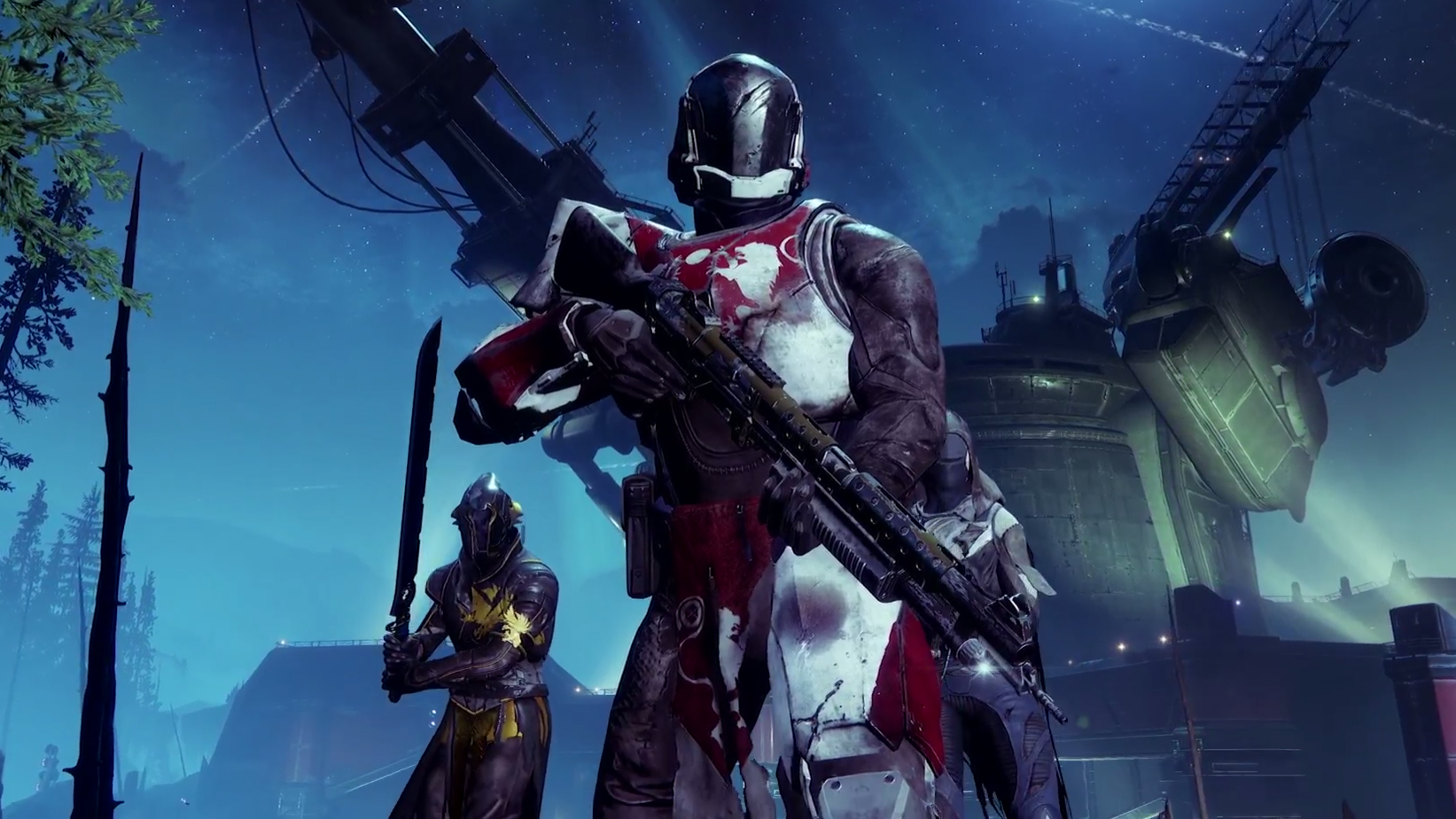
40 best PC games: the must-play titles you can't afford to miss
Are you ready for the best PC games? Then buckle your seatbelt because you’re in for a 4K, 60 frames-per-second ride free of bumps and stutters. What follows is a list full of wonderful, life-changing experiences that you can get by looking at a screen, hands resting on your choice of a mouse and keyboard or the buttons of a plush gamepad controller.
Don’t be discouraged, though, if all you have is a cheap laptop. We recognize that not everyone has thousands of dollars to invest in what should fill a hobby-sized hole in their hearts. Rather, many of the best PC games, such as Minecraft, Inside and Overwatch can run on a tablet the size of the HP Spectre x2. PC gaming isn’t as exclusive as many would lead you to believe.
Then again, also on our list are several options you’ll need a discrete graphics card to enjoy. While admittedly our list doesn’t include every great game you can buy right now (the newly reviewed Middle Earth: Shadow of War is notably absent), here we’ve compiled and ranked the top PC games that we feel you shouldn’t dare miss out on. Here are our 40 picks.
Most of the best online games in the browser are free, too
Gabe Carey has also contributed to this article
Now is the perfect time to get excited for Destiny 2. We mean, you can pre-load the whole thing onto your hard drive now – so, you basically own it already. For those in the dark about Destiny 2, this is the much-anticipated sequel to Halo creator Bungie’s wildly popular, MMO-influenced first-person shooter.
For anyone who skipped on the first Destiny, either because it wasn’t on PC or because of the lackluster storytelling, there’s some good news. Not only has it been confirmed that Destiny 2 is coming to Windows on October 24, but as far as story concerns go, Bungie’s cinematic lead has gone on record saying he hopes people “complain about how much story” Destiny 2 has.
Expected: October 24, 2017
Cities: Skylines is SimCity updated for the modern era (and for those dissuaded by always-online DRM), proving a breath of fresh air for would-be mayors. Its core gameplay lets you dig deep into the various aspects of running a sprawling virtual city - from economics to macro and micro management and land planning. But Cities: Skylines really shines when it comes to mods, which allow you to create custom maps, assets and tools to share with other online players.
Dragon Age: Inquisition places you in the heart of a huge, vibrant world on a far greater scale than its predecessors, and it does an excellent job of making you feel in command. Packing in a huge 90 hours (and the rest) of game play into its story line, Inquisition's smart dialogue, compelling plot, savvy progression system and massive sandbox world will have you engrossed for months on end. Think the Elder Scrolls games meets the Diablo franchise and you're halfway there.
From the makers (and universe) of World of Warcraft, Hearthstone is easy to learn, but hard to master. Like the MMO its inspired by, Hearthstone combines classes, characters and a bit of random fortune when pitting you against either computerized or online opponents. Stick with and you'll not only be rewarded by improved skill, but by in-game rewards as well. Keep in mind that, though, that while its accessibility might lead to addiction, don't expect to be a world-class Hearthstone champion right off the bat. Practice makes perfect, right?
Read: Hearthstone arrives on iPad, but it is better on tablet or PC?
Though it's arguably not as difficult as previous entries in the series, From Software's Dark Souls 3 takes everything you like about the Souls series and combines it with elements found in Bloodborne, the developer's more recent game for PS4.
Don't get us wrong -- Dark Souls 3 is no walk in the park. It still takes skill to master its complex combat system, but it plays fair too, inviting more casual gamers to take part in its bleak, fantastical world. Plus, on the bright side, it brings remarkably better PC optimization than that of the first game.
Pillars of Eternity is a sprawling RPG in the vein of Baldaur's Gate or Icewind Dale that combines highly detailed technical combat with hundreds of hours of gameplay. It has refreshingly low system requirements on the PC but still looks incredible thanks to its simple but effective art style, which harks back to those aforementioned isometric fantasy RPGs of the 2000s. But it's not all about nostalgia: Pillars of Eternity has enough interesting characters, baddies and clever writing to make it a modern classic of its own.
Grand Theft Auto V is one of the most anticipated console ports to ever hit the PC. You probably didn't need telling twice to head back into Los Santos's hugely detailed and interactive world, but it's ten times more fun with the PC's richer graphics and smooth 60 frames per second gameplay. Once you're done with its 31-hour storyline or had your fill blazing around the city causing chaos, an ever expanding list of GTA V mods - from fine tuning cars or throwing vehicles around with a Gravity Gun - are bound to keep you entertained for some time.
Read: This is what GTA 5 looks like through an Oculus Rift
BioShock is a first-person shooter that takes concepts from Ayn Rand's Atlast Shrugged and tosses them underseas. To be exact, BioShock takes place in an underwater city called Rapture, free from government regulation, designed for artists and entrepreneurs to thrive. Of course, not all goes well in a city where the residents have all the power and, well, stop what you're doing and play it right now if you haven't already.
You're in for one of the great games if you play BioShock, one that balances story elements with horror nigh-perfectly. There's a remastered version out there now, too, which is free of charge if you own the original.
Set 15 years after the events of the first Alien film from 1979, Alien: Isolation is the suspense-packed game that fans of the franchise have been crying out for. Playing the role of Amanda Ripley, daughter of Alien protagonist Ellen Ripley, your mission is to track down and recover the flight recorder of the Nostromo spacecraft from the first Alien film which has been located aboard the Sevastopol space station. First and foremost a stealth game, Isolation ramps up the tension by providing you with minimal weaponry. Its excellent graphics shine on high-end PCs and clever AI helps ramp up the dread, leaving you to quiver when turning every corner.
Read: How the tech of Alien Isolation will scare you back into the 1970s
If nothing else, Overwatch breaks the norm of gray-ish cover shooters competitive gaming year after year. Its bright, vibrant colors are complemented by likeable characters, each decorated with their own interesting backstories which, although they aren’t present in the game, make for fun web comics nevertheless.
Overwatch is also a technical feat in that it can run smoothly even on older PCs. What’s more, the PC version is cheaper than on consoles, so long as you don’t opt for the Origins Edition. That goes without mentioning its astounding community of players. By now, there’s no excuse to sign into your Battle.net account and take every character – from Ana to Zenyatta – for a test run in Overwatch today.
Counter-Strike: Global Offensive remains a fantastic update to a timeless classic that continues to live on thanks to its vast online communities. A well-rounded tactical shooter that builds on the simple Terrorists vs Counter-Terrorists gameplay mechanics of Counter-Strike 1.6 and Counter-Strike: Source, CS: GO updates classic maps such as Italy and Dust while keeping adding new modes in Arms Race and Demolition. Simpler than Battlefield but more nuanced than the Call of Duty franchise, it's a shooter for those who like to run, gun and think - if only a little bit.
Read: 9 games that are far better on PC than consoles
Ubisoft's latest shooter marks Far Cry's most beautiful outing yet. Its graphically-rich world is eye-popping on high-end PCs, and you'll see plenty of it thanks to a 30+ hour-long campaign. Aside from the main campaign, there are plenty of things to do in Kyrat - from hostage rescue and assassination missions to escort quests, resource collecting and, of course, avoiding being killed by bullets or rampaging animals. Whether you're tearing across the savanna in a rickety car or slinging grenades around like tennis balls, survival has never been such a blast.
Read: Far Cry 4: Building the anecdote factory
FTL (Faster Than Light) puts you command of running a spaceship and looking after its crew. Featuring a complex game mechanism that involves maintaining weapons, engines, shields and other areas, in addition to tactical combat, FTL can get extremely in-depth over time. Whether you're ordering your crew to quite literally put out fires on deck in the heat of battle, or are navigating through asteroid fields, FTL is as much about long-term progression and satisfaction as it is quick fixes. Don't let its indie stylings fool you: this is game with untold depth and scary levels of addictiveness.
A 90s classic brought back to life (unlike its main protagonist), Grim Fandango Remastered is a successful attempt at reviving one of the PC's best adventure games of all time. Combining writing that matches the funniest dark comedies with clever puzzles and a still-impressive art style, Grim Fandango was the most entertaining work of art to take place in a Mexican setting for years until Breaking Bad came along. Now with updated graphics, sound and better controls, Manna Calavera's adventure has never looked so good.
Read: Grim Fandango is headed to the PS4 and Vita
Four years after its initial release, Skyrim is going as strong as ever thanks to a vast selection of mods and high-resolution texture packs. Even if you're only interested in playing the vanilla version of the RPG, it offers more than 100 hours of gameplay.
Throw in three action packs DLC expansion packs (Dawnguard, Hearthfire and Dragonborn), and it lasts even longer. That Skyrim has been compared to graphically superior but similar RPG blockbuster The Witcher 3 is testament to its enduring popularity. Step into Skyrim and you too can be an adventurer - just try not to take an arrow in the knee.
Read: 9 games that are far better on PC than consoles
Originally launched as an Arma II mod, DayZ is a standalone zombie shooter with a difference. Not only do you have to mind the undead when wandering around its sprawling maps, but other online players too. Armed with a lead pipe and carrying nothing but a backpack and a flashlight, you'll need wits and guile to survive.
Pretty much the opposite of adrenaline-packed zombie fests such as Left4Dead, you'll spent half of the time evading the undead and the other using a shovel to fend off any humans who are bent on trying to steal your last box of matches. And take it from us - they will try.
Read: Is the MMORPG on the verge of extinction?
The phrase "build it, and they will come" quite literally rings true when it comes to Minecraft, the game that has been bought by more than 19 million people. The survival-themed sandbox RPG lets players build their own worlds or explore others, using the game's multiple block types to construct anything from small huts to extravagant castles and beyond.
Minecraft's ultimate appeal revolves around its open-ended nature. Creative types can build and destroy to their hearts' content, while solo players can concentrate on not being eaten by the zombie hordes that emerge at night. A modern-day classic that has spawned its own genre, it's not to be missed.
Read: How Minecraft is helping kids learn to code
The Orange Box may be showing its age, but it remains a must-play collection of games - particularly for FPS fans. Half-Life 2, technically still the most recent game in Valve's franchise (excluding its Episode 1 and 2 add-ons), remains a modern masterpiece and is famed for being the first game to intelligently apply physics to its puzzles and combat set-pieces.
The collection's other titles aren't too shabby either: Portal takes gravity-based puzzles to the extreme by equipping the player with the Aperture Science Handheld Portal Device (also known as the Portal Gun), which places two portals for objects to pass through, while Team Fortress 2 continues to go from strength-to-strength thanks to the introduction of custom gear and well-balanced team combat.
Read: 9 games that are far better on PC than consoles
Gorgeous graphics? Check. Huge explorable environments? Check. Enthralling combat? Of course. The Witcher 3 stands tall as one of the most ambitious open-world RPGs yet, combining Skyrim's unrestrained epicness with Grand Theft Auto 5's scale. While the game has been criticised for its inventory niggles, less-than-enthralling plot and not quite matching the graphics shown in its promo materials, it's so ambitious and jam-packed with detail that the package lives up to the hype. Huge, beautiful and an absolute time-sink, you'll want to scour every inch of The Witcher 3's glorious world.
Read: Consoles held The Witcher 3's graphics back, but PC gaming is far from cursed
Id Software's Doom was a phenomena for PC gamers in the 90s. The crudely rendered first-person shooter series was as controversial as it was beloved, largely thanks to its cutting-edge depictions of gore and violence that only a computer could deliver. Parents be damned, the franchise has made a comeback in 2016 with a fresh restart, appropriately titled Doom. Although the multiplayer might not appeal to shooter fans regardless of age, the single player campaign will pit you against demons in Hell for a lengthy experience that's as bloody as it is satisfying.
If Forza Horizon 3 is the racing game for newcomers to the genre, Assetto Corsa is one for the veterans. Its obtuse handling and asinine difficulty straight from the get-go make it a toss-up for one of the most realistic racing simulators of all-time. Though you can get it on consoles, unlike Project Cars, this is a game that was developed specifically with PC in mind. Everything about Assetto Corsa, from its demanding career mode to its deep-seated driving mechanics make it a joy for die-hard petrol heads, even if it’s difficulty curve is often just backbreaking.
Read: Why realistic PC racer Project Cars is the torque of the town
Modelled after the 1984 game Elite, Elite: Dangerous is one of the most ambitious space sims around. Featuring an in-game galaxy based on the real Milky Way (how's 400 billion stars for depth?), the ultimate goal is to advance your rankings to Elite status by levelling up combat, trading and exploration.
Starting out with a rickety ship and 1,000 credits in your space suit's back pocket, you'll need to turn to piracy, trading, exploring, mining or bounty hunting to rise through the intergalactic ranks. Doing so takes time and requires serious graft, but the experience provides a level of satisfaction that few other titles can match. And then there's the Oculus Rift...
From developer Playdead, the same team that devised the acclaimed (and platform ubiquitous) Limbo, comes another eerie tale. Like Limbo, Inside follows another nameless boy in a bleak world that's apparently out to get you. Only, this time, there's at least a few shades of color to keep you from complete despair. It's not clear why, but the mute protagonist in Inside is being chased down by what appears to a group of shadowy men.
Nothing is explained in either spoken dialogue or text, so for the most part you're on your own when it comes to figuring out the story. Nonetheless, Inside is bound to be an instant classic; although, revealing anything about it would inch into spoiler territory.
Want more games like this? Check out our best indie games list
Described as "achingly beautiful" by Unity Engine boss John Riccitiello, Ori and the Blind Forest borrows its game mechanics from old-school 2D games such as Metroid and Castlevania while adding a modern twist. If any word can describe Ori's atmospheric world, it's alive. You'll have to think fast and use new abilities gained along the way to bash, stop and manoeuvre your way through its gorgeous locations, and with no automatic saving system or easy difficulty level, it's no walk in the park. As satisfying to master as it is to look at, Ori and the Blind Forest will re-open your eyes to what 2D games still have to offer.
Unity CEO argues games are at, wants Jurassic Park in VR
Grow Home is an experimental PC platformer that looks like an "indie" game but is in fact the latest release from Rayman developer Ubisoft. Similarly charming thanks to its distinctive 3D art style, you play as BUD, the game's robot protagonist, whose main job is harvest seeds and grow a beanstalk-like 'Star Plant' by grabbing its branches and connecting them to nearby floating islands in the sky.
There's a fair bit of trial-and-error involved, and while having to climb all the way back up again after a fall is frustrating, grabbing a passing vine at the last minute by the tips of your fingers can be equally as exhilarating. The ability to move BUD's arms and legs independently helps put you in control - just try not to get them tangled up. Because you will - a lot.
Unity CEO argues games are at, wants Jurassic Park in VR
A 2D exploration game set on a boat can't be that creepy, right? Wrong. More gothic than a Cradle of Filth concert, Sunless Sea throws all manners of joyless themes your way: death, insanity and cannibalism to name a few. Sailing from port-to-port in the monster-filled underworld of Fallen London, you'll have to manage fuel and supplies while battling sentient icebergs, Zee-beasts and other water-dwelling nasties to remain afloat. Top-notch writing gives Sunless Sea an absorbing storyline that's up there with history's best text-based adventures.
Already familiar to millions before they've played a played a second of it, Rocket League turns the age old game of football (or soccer, depending) on its head. Played with rocket-propelled cars in futuristic low-gravity environments, the aim is simple: knock the ball into the opposing team's goal. Doing so is harder said than done because there could be up to three cars on the opposing team trying to steal the ball off you - or ram you into submission - at any one time. Gorgeous to look, simple to learn but difficult to master, Rocket League is the surprise smash hit of 2015 - and a wonderfully addictive one at that.
Read: 8 real-life footballers in Rocket League: which one are you?
As inevitable as sandals in summer, Blizzard finally launched its first MOBA (Multiplayer Online Battle Arena) game in June. Featuring a ton of characters from Blizzard games such as Warcraft, World of Warcraft and Starcraft 2, Heroes of the Storm sees two teams of five attempt to destroy the other's base. When not sounding out enemy units to destroy, its expansive maps give you room to take on secondary objectives such as finding skulls or unlocking special siege units to help your team.
Accessible to newcomers while packing plenty of depth, Heroes' finely balanced gameplay mechanics, shorter matches (compared to League of Legends) and ability-based levelling system make it a refreshing alternative to established MOBA titles and a fine game in its own right.
The new Metal Gear, which is likely Hideo Kojima's final game in the series, is a hugely ambitious title. Its massive open world setting lets you tackle missions using stealth, but it won't punish you for going in guns blazing - which is often the most tempting option.
Set nine years after the events of Ground Zeroes, The Phantom Pain's story unravels through its main missions and more than 100 Side Ops tasks. The action is interspersed with gorgeous cutscenes, and while you sometimes have to decode annoying military-babble to understand what's going on, TPP's fast pacing and gorgeous Afghanistan settings never make the game feel like a chore.
A gripping horror game in the vein of Amnesia: The Dark Descent (it's from the same developer), SOMA has its fair share of "NOPE!" moments. But it's not really about jump scares; the game's most compelling aspect is its philosophical story arc, which unravels as you encounter a series of confused robots. Suffering from existential stress, the decaying machines believe they are human.
The tension builds as you venture deeper into the underwater research facility that you wake up aboard, avoiding murderous creatures, solving clever puzzles and checking voice memos to unravel the mystery. Expertly weaving elements of survival and psychological Sci-Fi horror, SOMA is a little less action packed than Alien: Isolation but engages more of the old grey matter. If that's what you're looking for in a fright-fest, SOMA doesn't disappoint.
if you think you've learnt a thing or two about prison life watching films like The Green Mile and The Shawshank Redemption over the years, cuff-em-up Prison Architect lets you put your knowledge to the test. Playing as wardens, you're tasked with keeping prisoners in check, preventing riots from boiling over and foiling The Great Escape-style plots. And yes: it does involve sending men to the electric chair. Gnarly. Alternatively, a second mode called Escape lets you unleash your inner Bronson by hatching a plot to lead your fellow inmates to freedom. (Until you get arrested again, anyway.)
Five heroes, many Skaven. That's the basic premise of Warhammer: End Times - Vermintide, a hack-and-slash fest that plays - and feels - a lot like Valve's Left 4 Dead series. With a deep focus on co-operative gameplay, Vermintide's melee-focused combat, random loot, level-based progression system and humanoid rat enemies make for a refreshing alternative to gunning down endless hordes of zombies.
Although it's fun attempting to talk tactics over voice chat with players online, Vermintide is often too chaotic to try anything other than bashing or shooting the nearest Skaven between the eyes — and that's fine — from giant Ogre Rats to stealth Gutter Runners, there's enough variation to keep things interesting. And if you do start to get get bored, unlike the Skaven, ratcheting up the difficulty makes sure Vermintide won't get long in the tooth any time soon.
It's official: Fallout 4 has lived up to the hype. Despite feeling a little bit like Fallout 3 but with nicer graphics at times, its tighter shooting, in-depth crafting system and well-thought out story make it a wholly more enticing affair.
As the Sole Survivor (the first fully-voiced protagonist in the Fallout series) in Boston's post-apocalypse wasteland, you'll take on Feral Ghouls, Raiders, Syths and Bloodbugs and more with high-powered weaponry that includes the Fat Man mini nuke cannon and the fusion cell-powered Laser Musket.
Fallout 4: the good, the bad and the ugly of the Boston Wastelands
If the Call of Duty series is the poison that dumbed down the FPS genre with its run-and-gun gameplay, then Rainbow Six: Siege is the antidote. Working as a team to out-wit the enemy, Siege plays out like a thinking man (or woman's) Counter-Strike that doesn't simply encourage cooperation if you want to win - it requires it.
When you're not peering down your gun's iron sights, you'll be laying traps, scouting ahead using drones, strategising with your teammates and building walls that could keep a herd of demented bulls at bay. While Siege's heavy reliance on tactical team-based gameplay can prove its biggest weakness if you're hoisted into a server with a particularly uncooperative bunch, when it does click, it provides a level of satisfaction rarely found in online multiplayer games.
"Console port" is no longer a dirty phrase thanks to efforts like Rise of the Tomb Raider, which gets the treatment it deserves on PC. Featuring stunning and varied locations, exciting combat and effective stealth mechanics, Lara's epic outing often feels movie-like in its execution and scope.
Crystal Dynamics has kept the soul of the original games intact too – there's pistols aplenty, amazing architecture and angry animals that would quite like to gobble you up – meaning you'll never get bored once you've soaked up Siberia's amazing architecture. If you're into adventures, it's easily one of the best PC games around.
Imagine a survival-based shooter where every match starts with your avatar being ejected from a cargo plane alongside 99 other players with no weapons or items. That’s PlayerUnknown’s Battlegrounds, or at least the solo, free for all mode. After spending the early minutes of the game digging for resources, you’ll soon be forced to reckon with your own mortality as the body count ticker at the top of the screen descends into desolation.
Abbreviated PUBG, PlayerUnknown’s Battlegrounds is based on another “last man standing” game released back in 2013: PlayerUnknown’s Battle Royale. It doesn’t require a copy of Arma III or H1Z1 to run, but you’ll need to keep your wits about you. There’s no respawning in PUBG, so it’s less about the precision of your aim as it is about your ability to scavenge quickly for weapons, first aid kits and clothing.
Picking up two years after the events of Deus Ex: Human Revolution, released back in 2011, Mankind Divided centers once again around the story's protagonist Adam Jensen who is now outfitted with augmentations that allow him to turn invisible, punch through walls and hack stuff.
Like a more refined Watch Dogs, Deus Ex: Mankind Divided proposes a strikingly realistic cyberpunk alternate reality, but doesn't go so far as to make a statement about it. Fortunately, the savory (and stealthy) gameplay makes Deus Ex: Mankind Divided's campaign well worth the 30 hour campaign. For more insight, you can read our review here.
Originally created as an entry to the 7 Day FPS Challenge, Superhot's Polish developers were inspired by a top-down game called Time4Cat where time only moves when the player does. They took this concept one step further and turned it into a FPS. Falling somewhere between Portal and Max Payne, nifty reflexes, patience and an eye for puzzle solving is required.
The aim is to defeat a finite number of enemies by dodging bullets and returning a few yourself. The game is now available to buy and download on Steam, but you can head back to where it all began by playing the flash version of Superhot online for free. You'll need the Unity Web Player plugin which is currently not supported by Chrome.
X-Com 2 is one addictive game, and we still can't put it down. Following up from 2012's XCOM: Enemy Unknown, which reimagined the 1994 cult classic UFO: Enemy Unknown, XCOM 2 has delivered everything we wanted in a sequel. Bigger, deeper, faster and even easier on the eyes, the turn-based tactics game takes place 20 years after its predecessor.
It pits you in control of the Avenger, a converted alien ship that serves as your mobile base of operations used to devise strategy and execute fight plans against otherworldly enemies. With a greater focus of stealth, more intelligent alien AI and deeper customization options, XCOM 2 is bound to end up one of our games of the year.
Anyone familiar with World of Warcraft knows that it's among the most successful and influential massively multiplayer online role-playing games (or MMORPGs) of all-time. Comprising over 12 years of content, with over thousands of hours just waiting to be invested, there are few better games to spend your money on than World of Warcraft.
With the new expansion pack, however, dubbed "Legion," you'll not only get access to an entirely new continent, but Blizzard has completely overturned its leveling system as well. Instead of each zone having a predetermined level, zones actually adapt dynamically to the level of your character. This way, no matter where you are in the game, you'll be able to incur new challenges without the endless grinding required by the World of Warcraft of yesteryear.
From PlatinumGames and Square Enix, Nier: Automata is a sequel to the 2010 cult classic Nier, which itself is a spin-off of the Drakengard series. Technically an action role-playing game, Nier: Automata’s most gripping quality is that it never truly adheres to one particular genre. At times, it’s a 2.5D platformer and, at others, it’s a twin-stick shooter. It’s unpredictable and a breath of fresh air when compared to other PC games out on the market.
The story centers around a femme android by the name of 2B who is aided by a survey android called 9S, or Nines. With many questions being asked along the way, both of these characters are tasked with extricating Earth from alien machines that have engulfed the planet. Just be conscious of how you play because not only does Nier: Automata feature different endings, but with each new path comes vastly different gameplay.
Don’t be discouraged, though, if all you have is a cheap laptop. We recognize that not everyone has thousands of dollars to invest in what should fill a hobby-sized hole in their hearts. Rather, many of the best PC games, such as Minecraft, Inside and Overwatch can run on a tablet the size of the HP Spectre x2. PC gaming isn’t as exclusive as many would lead you to believe.
Then again, also on our list are several options you’ll need a discrete graphics card to enjoy. While admittedly our list doesn’t include every great game you can buy right now (the newly reviewed Middle Earth: Shadow of War is notably absent), here we’ve compiled and ranked the top PC games that we feel you shouldn’t dare miss out on. Here are our 40 picks.
Most of the best online games in the browser are free, too
Gabe Carey has also contributed to this article
Now is the perfect time to get excited for Destiny 2. We mean, you can pre-load the whole thing onto your hard drive now – so, you basically own it already. For those in the dark about Destiny 2, this is the much-anticipated sequel to Halo creator Bungie’s wildly popular, MMO-influenced first-person shooter.
For anyone who skipped on the first Destiny, either because it wasn’t on PC or because of the lackluster storytelling, there’s some good news. Not only has it been confirmed that Destiny 2 is coming to Windows on October 24, but as far as story concerns go, Bungie’s cinematic lead has gone on record saying he hopes people “complain about how much story” Destiny 2 has.
Expected: October 24, 2017
Cities: Skylines is SimCity updated for the modern era (and for those dissuaded by always-online DRM), proving a breath of fresh air for would-be mayors. Its core gameplay lets you dig deep into the various aspects of running a sprawling virtual city - from economics to macro and micro management and land planning. But Cities: Skylines really shines when it comes to mods, which allow you to create custom maps, assets and tools to share with other online players.
Dragon Age: Inquisition places you in the heart of a huge, vibrant world on a far greater scale than its predecessors, and it does an excellent job of making you feel in command. Packing in a huge 90 hours (and the rest) of game play into its story line, Inquisition's smart dialogue, compelling plot, savvy progression system and massive sandbox world will have you engrossed for months on end. Think the Elder Scrolls games meets the Diablo franchise and you're halfway there.
From the makers (and universe) of World of Warcraft, Hearthstone is easy to learn, but hard to master. Like the MMO its inspired by, Hearthstone combines classes, characters and a bit of random fortune when pitting you against either computerized or online opponents. Stick with and you'll not only be rewarded by improved skill, but by in-game rewards as well. Keep in mind that, though, that while its accessibility might lead to addiction, don't expect to be a world-class Hearthstone champion right off the bat. Practice makes perfect, right?
Read: Hearthstone arrives on iPad, but it is better on tablet or PC?
Though it's arguably not as difficult as previous entries in the series, From Software's Dark Souls 3 takes everything you like about the Souls series and combines it with elements found in Bloodborne, the developer's more recent game for PS4.
Don't get us wrong -- Dark Souls 3 is no walk in the park. It still takes skill to master its complex combat system, but it plays fair too, inviting more casual gamers to take part in its bleak, fantastical world. Plus, on the bright side, it brings remarkably better PC optimization than that of the first game.
Pillars of Eternity is a sprawling RPG in the vein of Baldaur's Gate or Icewind Dale that combines highly detailed technical combat with hundreds of hours of gameplay. It has refreshingly low system requirements on the PC but still looks incredible thanks to its simple but effective art style, which harks back to those aforementioned isometric fantasy RPGs of the 2000s. But it's not all about nostalgia: Pillars of Eternity has enough interesting characters, baddies and clever writing to make it a modern classic of its own.
Grand Theft Auto V is one of the most anticipated console ports to ever hit the PC. You probably didn't need telling twice to head back into Los Santos's hugely detailed and interactive world, but it's ten times more fun with the PC's richer graphics and smooth 60 frames per second gameplay. Once you're done with its 31-hour storyline or had your fill blazing around the city causing chaos, an ever expanding list of GTA V mods - from fine tuning cars or throwing vehicles around with a Gravity Gun - are bound to keep you entertained for some time.
Read: This is what GTA 5 looks like through an Oculus Rift
BioShock is a first-person shooter that takes concepts from Ayn Rand's Atlast Shrugged and tosses them underseas. To be exact, BioShock takes place in an underwater city called Rapture, free from government regulation, designed for artists and entrepreneurs to thrive. Of course, not all goes well in a city where the residents have all the power and, well, stop what you're doing and play it right now if you haven't already.
You're in for one of the great games if you play BioShock, one that balances story elements with horror nigh-perfectly. There's a remastered version out there now, too, which is free of charge if you own the original.
Set 15 years after the events of the first Alien film from 1979, Alien: Isolation is the suspense-packed game that fans of the franchise have been crying out for. Playing the role of Amanda Ripley, daughter of Alien protagonist Ellen Ripley, your mission is to track down and recover the flight recorder of the Nostromo spacecraft from the first Alien film which has been located aboard the Sevastopol space station. First and foremost a stealth game, Isolation ramps up the tension by providing you with minimal weaponry. Its excellent graphics shine on high-end PCs and clever AI helps ramp up the dread, leaving you to quiver when turning every corner.
Read: How the tech of Alien Isolation will scare you back into the 1970s
If nothing else, Overwatch breaks the norm of gray-ish cover shooters competitive gaming year after year. Its bright, vibrant colors are complemented by likeable characters, each decorated with their own interesting backstories which, although they aren’t present in the game, make for fun web comics nevertheless.
Overwatch is also a technical feat in that it can run smoothly even on older PCs. What’s more, the PC version is cheaper than on consoles, so long as you don’t opt for the Origins Edition. That goes without mentioning its astounding community of players. By now, there’s no excuse to sign into your Battle.net account and take every character – from Ana to Zenyatta – for a test run in Overwatch today.
Counter-Strike: Global Offensive remains a fantastic update to a timeless classic that continues to live on thanks to its vast online communities. A well-rounded tactical shooter that builds on the simple Terrorists vs Counter-Terrorists gameplay mechanics of Counter-Strike 1.6 and Counter-Strike: Source, CS: GO updates classic maps such as Italy and Dust while keeping adding new modes in Arms Race and Demolition. Simpler than Battlefield but more nuanced than the Call of Duty franchise, it's a shooter for those who like to run, gun and think - if only a little bit.
Read: 9 games that are far better on PC than consoles
Ubisoft's latest shooter marks Far Cry's most beautiful outing yet. Its graphically-rich world is eye-popping on high-end PCs, and you'll see plenty of it thanks to a 30+ hour-long campaign. Aside from the main campaign, there are plenty of things to do in Kyrat - from hostage rescue and assassination missions to escort quests, resource collecting and, of course, avoiding being killed by bullets or rampaging animals. Whether you're tearing across the savanna in a rickety car or slinging grenades around like tennis balls, survival has never been such a blast.
Read: Far Cry 4: Building the anecdote factory
FTL (Faster Than Light) puts you command of running a spaceship and looking after its crew. Featuring a complex game mechanism that involves maintaining weapons, engines, shields and other areas, in addition to tactical combat, FTL can get extremely in-depth over time. Whether you're ordering your crew to quite literally put out fires on deck in the heat of battle, or are navigating through asteroid fields, FTL is as much about long-term progression and satisfaction as it is quick fixes. Don't let its indie stylings fool you: this is game with untold depth and scary levels of addictiveness.
A 90s classic brought back to life (unlike its main protagonist), Grim Fandango Remastered is a successful attempt at reviving one of the PC's best adventure games of all time. Combining writing that matches the funniest dark comedies with clever puzzles and a still-impressive art style, Grim Fandango was the most entertaining work of art to take place in a Mexican setting for years until Breaking Bad came along. Now with updated graphics, sound and better controls, Manna Calavera's adventure has never looked so good.
Read: Grim Fandango is headed to the PS4 and Vita
Four years after its initial release, Skyrim is going as strong as ever thanks to a vast selection of mods and high-resolution texture packs. Even if you're only interested in playing the vanilla version of the RPG, it offers more than 100 hours of gameplay.
Throw in three action packs DLC expansion packs (Dawnguard, Hearthfire and Dragonborn), and it lasts even longer. That Skyrim has been compared to graphically superior but similar RPG blockbuster The Witcher 3 is testament to its enduring popularity. Step into Skyrim and you too can be an adventurer - just try not to take an arrow in the knee.
Read: 9 games that are far better on PC than consoles
Originally launched as an Arma II mod, DayZ is a standalone zombie shooter with a difference. Not only do you have to mind the undead when wandering around its sprawling maps, but other online players too. Armed with a lead pipe and carrying nothing but a backpack and a flashlight, you'll need wits and guile to survive.
Pretty much the opposite of adrenaline-packed zombie fests such as Left4Dead, you'll spent half of the time evading the undead and the other using a shovel to fend off any humans who are bent on trying to steal your last box of matches. And take it from us - they will try.
Read: Is the MMORPG on the verge of extinction?
The phrase "build it, and they will come" quite literally rings true when it comes to Minecraft, the game that has been bought by more than 19 million people. The survival-themed sandbox RPG lets players build their own worlds or explore others, using the game's multiple block types to construct anything from small huts to extravagant castles and beyond.
Minecraft's ultimate appeal revolves around its open-ended nature. Creative types can build and destroy to their hearts' content, while solo players can concentrate on not being eaten by the zombie hordes that emerge at night. A modern-day classic that has spawned its own genre, it's not to be missed.
Read: How Minecraft is helping kids learn to code
The Orange Box may be showing its age, but it remains a must-play collection of games - particularly for FPS fans. Half-Life 2, technically still the most recent game in Valve's franchise (excluding its Episode 1 and 2 add-ons), remains a modern masterpiece and is famed for being the first game to intelligently apply physics to its puzzles and combat set-pieces.
The collection's other titles aren't too shabby either: Portal takes gravity-based puzzles to the extreme by equipping the player with the Aperture Science Handheld Portal Device (also known as the Portal Gun), which places two portals for objects to pass through, while Team Fortress 2 continues to go from strength-to-strength thanks to the introduction of custom gear and well-balanced team combat.
Read: 9 games that are far better on PC than consoles
Gorgeous graphics? Check. Huge explorable environments? Check. Enthralling combat? Of course. The Witcher 3 stands tall as one of the most ambitious open-world RPGs yet, combining Skyrim's unrestrained epicness with Grand Theft Auto 5's scale. While the game has been criticised for its inventory niggles, less-than-enthralling plot and not quite matching the graphics shown in its promo materials, it's so ambitious and jam-packed with detail that the package lives up to the hype. Huge, beautiful and an absolute time-sink, you'll want to scour every inch of The Witcher 3's glorious world.
Read: Consoles held The Witcher 3's graphics back, but PC gaming is far from cursed
Id Software's Doom was a phenomena for PC gamers in the 90s. The crudely rendered first-person shooter series was as controversial as it was beloved, largely thanks to its cutting-edge depictions of gore and violence that only a computer could deliver. Parents be damned, the franchise has made a comeback in 2016 with a fresh restart, appropriately titled Doom. Although the multiplayer might not appeal to shooter fans regardless of age, the single player campaign will pit you against demons in Hell for a lengthy experience that's as bloody as it is satisfying.
If Forza Horizon 3 is the racing game for newcomers to the genre, Assetto Corsa is one for the veterans. Its obtuse handling and asinine difficulty straight from the get-go make it a toss-up for one of the most realistic racing simulators of all-time. Though you can get it on consoles, unlike Project Cars, this is a game that was developed specifically with PC in mind. Everything about Assetto Corsa, from its demanding career mode to its deep-seated driving mechanics make it a joy for die-hard petrol heads, even if it’s difficulty curve is often just backbreaking.
Read: Why realistic PC racer Project Cars is the torque of the town
Modelled after the 1984 game Elite, Elite: Dangerous is one of the most ambitious space sims around. Featuring an in-game galaxy based on the real Milky Way (how's 400 billion stars for depth?), the ultimate goal is to advance your rankings to Elite status by levelling up combat, trading and exploration.
Starting out with a rickety ship and 1,000 credits in your space suit's back pocket, you'll need to turn to piracy, trading, exploring, mining or bounty hunting to rise through the intergalactic ranks. Doing so takes time and requires serious graft, but the experience provides a level of satisfaction that few other titles can match. And then there's the Oculus Rift...
From developer Playdead, the same team that devised the acclaimed (and platform ubiquitous) Limbo, comes another eerie tale. Like Limbo, Inside follows another nameless boy in a bleak world that's apparently out to get you. Only, this time, there's at least a few shades of color to keep you from complete despair. It's not clear why, but the mute protagonist in Inside is being chased down by what appears to a group of shadowy men.
Nothing is explained in either spoken dialogue or text, so for the most part you're on your own when it comes to figuring out the story. Nonetheless, Inside is bound to be an instant classic; although, revealing anything about it would inch into spoiler territory.
Want more games like this? Check out our best indie games list
Described as "achingly beautiful" by Unity Engine boss John Riccitiello, Ori and the Blind Forest borrows its game mechanics from old-school 2D games such as Metroid and Castlevania while adding a modern twist. If any word can describe Ori's atmospheric world, it's alive. You'll have to think fast and use new abilities gained along the way to bash, stop and manoeuvre your way through its gorgeous locations, and with no automatic saving system or easy difficulty level, it's no walk in the park. As satisfying to master as it is to look at, Ori and the Blind Forest will re-open your eyes to what 2D games still have to offer.
Unity CEO argues games are at, wants Jurassic Park in VR
Grow Home is an experimental PC platformer that looks like an "indie" game but is in fact the latest release from Rayman developer Ubisoft. Similarly charming thanks to its distinctive 3D art style, you play as BUD, the game's robot protagonist, whose main job is harvest seeds and grow a beanstalk-like 'Star Plant' by grabbing its branches and connecting them to nearby floating islands in the sky.
There's a fair bit of trial-and-error involved, and while having to climb all the way back up again after a fall is frustrating, grabbing a passing vine at the last minute by the tips of your fingers can be equally as exhilarating. The ability to move BUD's arms and legs independently helps put you in control - just try not to get them tangled up. Because you will - a lot.
Unity CEO argues games are at, wants Jurassic Park in VR
A 2D exploration game set on a boat can't be that creepy, right? Wrong. More gothic than a Cradle of Filth concert, Sunless Sea throws all manners of joyless themes your way: death, insanity and cannibalism to name a few. Sailing from port-to-port in the monster-filled underworld of Fallen London, you'll have to manage fuel and supplies while battling sentient icebergs, Zee-beasts and other water-dwelling nasties to remain afloat. Top-notch writing gives Sunless Sea an absorbing storyline that's up there with history's best text-based adventures.
Already familiar to millions before they've played a played a second of it, Rocket League turns the age old game of football (or soccer, depending) on its head. Played with rocket-propelled cars in futuristic low-gravity environments, the aim is simple: knock the ball into the opposing team's goal. Doing so is harder said than done because there could be up to three cars on the opposing team trying to steal the ball off you - or ram you into submission - at any one time. Gorgeous to look, simple to learn but difficult to master, Rocket League is the surprise smash hit of 2015 - and a wonderfully addictive one at that.
Read: 8 real-life footballers in Rocket League: which one are you?
As inevitable as sandals in summer, Blizzard finally launched its first MOBA (Multiplayer Online Battle Arena) game in June. Featuring a ton of characters from Blizzard games such as Warcraft, World of Warcraft and Starcraft 2, Heroes of the Storm sees two teams of five attempt to destroy the other's base. When not sounding out enemy units to destroy, its expansive maps give you room to take on secondary objectives such as finding skulls or unlocking special siege units to help your team.
Accessible to newcomers while packing plenty of depth, Heroes' finely balanced gameplay mechanics, shorter matches (compared to League of Legends) and ability-based levelling system make it a refreshing alternative to established MOBA titles and a fine game in its own right.
The new Metal Gear, which is likely Hideo Kojima's final game in the series, is a hugely ambitious title. Its massive open world setting lets you tackle missions using stealth, but it won't punish you for going in guns blazing - which is often the most tempting option.
Set nine years after the events of Ground Zeroes, The Phantom Pain's story unravels through its main missions and more than 100 Side Ops tasks. The action is interspersed with gorgeous cutscenes, and while you sometimes have to decode annoying military-babble to understand what's going on, TPP's fast pacing and gorgeous Afghanistan settings never make the game feel like a chore.
A gripping horror game in the vein of Amnesia: The Dark Descent (it's from the same developer), SOMA has its fair share of "NOPE!" moments. But it's not really about jump scares; the game's most compelling aspect is its philosophical story arc, which unravels as you encounter a series of confused robots. Suffering from existential stress, the decaying machines believe they are human.
The tension builds as you venture deeper into the underwater research facility that you wake up aboard, avoiding murderous creatures, solving clever puzzles and checking voice memos to unravel the mystery. Expertly weaving elements of survival and psychological Sci-Fi horror, SOMA is a little less action packed than Alien: Isolation but engages more of the old grey matter. If that's what you're looking for in a fright-fest, SOMA doesn't disappoint.
if you think you've learnt a thing or two about prison life watching films like The Green Mile and The Shawshank Redemption over the years, cuff-em-up Prison Architect lets you put your knowledge to the test. Playing as wardens, you're tasked with keeping prisoners in check, preventing riots from boiling over and foiling The Great Escape-style plots. And yes: it does involve sending men to the electric chair. Gnarly. Alternatively, a second mode called Escape lets you unleash your inner Bronson by hatching a plot to lead your fellow inmates to freedom. (Until you get arrested again, anyway.)
Five heroes, many Skaven. That's the basic premise of Warhammer: End Times - Vermintide, a hack-and-slash fest that plays - and feels - a lot like Valve's Left 4 Dead series. With a deep focus on co-operative gameplay, Vermintide's melee-focused combat, random loot, level-based progression system and humanoid rat enemies make for a refreshing alternative to gunning down endless hordes of zombies.
Although it's fun attempting to talk tactics over voice chat with players online, Vermintide is often too chaotic to try anything other than bashing or shooting the nearest Skaven between the eyes — and that's fine — from giant Ogre Rats to stealth Gutter Runners, there's enough variation to keep things interesting. And if you do start to get get bored, unlike the Skaven, ratcheting up the difficulty makes sure Vermintide won't get long in the tooth any time soon.
It's official: Fallout 4 has lived up to the hype. Despite feeling a little bit like Fallout 3 but with nicer graphics at times, its tighter shooting, in-depth crafting system and well-thought out story make it a wholly more enticing affair.
As the Sole Survivor (the first fully-voiced protagonist in the Fallout series) in Boston's post-apocalypse wasteland, you'll take on Feral Ghouls, Raiders, Syths and Bloodbugs and more with high-powered weaponry that includes the Fat Man mini nuke cannon and the fusion cell-powered Laser Musket.
Fallout 4: the good, the bad and the ugly of the Boston Wastelands
If the Call of Duty series is the poison that dumbed down the FPS genre with its run-and-gun gameplay, then Rainbow Six: Siege is the antidote. Working as a team to out-wit the enemy, Siege plays out like a thinking man (or woman's) Counter-Strike that doesn't simply encourage cooperation if you want to win - it requires it.
When you're not peering down your gun's iron sights, you'll be laying traps, scouting ahead using drones, strategising with your teammates and building walls that could keep a herd of demented bulls at bay. While Siege's heavy reliance on tactical team-based gameplay can prove its biggest weakness if you're hoisted into a server with a particularly uncooperative bunch, when it does click, it provides a level of satisfaction rarely found in online multiplayer games.
"Console port" is no longer a dirty phrase thanks to efforts like Rise of the Tomb Raider, which gets the treatment it deserves on PC. Featuring stunning and varied locations, exciting combat and effective stealth mechanics, Lara's epic outing often feels movie-like in its execution and scope.
Crystal Dynamics has kept the soul of the original games intact too – there's pistols aplenty, amazing architecture and angry animals that would quite like to gobble you up – meaning you'll never get bored once you've soaked up Siberia's amazing architecture. If you're into adventures, it's easily one of the best PC games around.
Imagine a survival-based shooter where every match starts with your avatar being ejected from a cargo plane alongside 99 other players with no weapons or items. That’s PlayerUnknown’s Battlegrounds, or at least the solo, free for all mode. After spending the early minutes of the game digging for resources, you’ll soon be forced to reckon with your own mortality as the body count ticker at the top of the screen descends into desolation.
Abbreviated PUBG, PlayerUnknown’s Battlegrounds is based on another “last man standing” game released back in 2013: PlayerUnknown’s Battle Royale. It doesn’t require a copy of Arma III or H1Z1 to run, but you’ll need to keep your wits about you. There’s no respawning in PUBG, so it’s less about the precision of your aim as it is about your ability to scavenge quickly for weapons, first aid kits and clothing.
Picking up two years after the events of Deus Ex: Human Revolution, released back in 2011, Mankind Divided centers once again around the story's protagonist Adam Jensen who is now outfitted with augmentations that allow him to turn invisible, punch through walls and hack stuff.
Like a more refined Watch Dogs, Deus Ex: Mankind Divided proposes a strikingly realistic cyberpunk alternate reality, but doesn't go so far as to make a statement about it. Fortunately, the savory (and stealthy) gameplay makes Deus Ex: Mankind Divided's campaign well worth the 30 hour campaign. For more insight, you can read our review here.
Originally created as an entry to the 7 Day FPS Challenge, Superhot's Polish developers were inspired by a top-down game called Time4Cat where time only moves when the player does. They took this concept one step further and turned it into a FPS. Falling somewhere between Portal and Max Payne, nifty reflexes, patience and an eye for puzzle solving is required.
The aim is to defeat a finite number of enemies by dodging bullets and returning a few yourself. The game is now available to buy and download on Steam, but you can head back to where it all began by playing the flash version of Superhot online for free. You'll need the Unity Web Player plugin which is currently not supported by Chrome.
X-Com 2 is one addictive game, and we still can't put it down. Following up from 2012's XCOM: Enemy Unknown, which reimagined the 1994 cult classic UFO: Enemy Unknown, XCOM 2 has delivered everything we wanted in a sequel. Bigger, deeper, faster and even easier on the eyes, the turn-based tactics game takes place 20 years after its predecessor.
It pits you in control of the Avenger, a converted alien ship that serves as your mobile base of operations used to devise strategy and execute fight plans against otherworldly enemies. With a greater focus of stealth, more intelligent alien AI and deeper customization options, XCOM 2 is bound to end up one of our games of the year.
Anyone familiar with World of Warcraft knows that it's among the most successful and influential massively multiplayer online role-playing games (or MMORPGs) of all-time. Comprising over 12 years of content, with over thousands of hours just waiting to be invested, there are few better games to spend your money on than World of Warcraft.
With the new expansion pack, however, dubbed "Legion," you'll not only get access to an entirely new continent, but Blizzard has completely overturned its leveling system as well. Instead of each zone having a predetermined level, zones actually adapt dynamically to the level of your character. This way, no matter where you are in the game, you'll be able to incur new challenges without the endless grinding required by the World of Warcraft of yesteryear.
From PlatinumGames and Square Enix, Nier: Automata is a sequel to the 2010 cult classic Nier, which itself is a spin-off of the Drakengard series. Technically an action role-playing game, Nier: Automata’s most gripping quality is that it never truly adheres to one particular genre. At times, it’s a 2.5D platformer and, at others, it’s a twin-stick shooter. It’s unpredictable and a breath of fresh air when compared to other PC games out on the market.
The story centers around a femme android by the name of 2B who is aided by a survey android called 9S, or Nines. With many questions being asked along the way, both of these characters are tasked with extricating Earth from alien machines that have engulfed the planet. Just be conscious of how you play because not only does Nier: Automata feature different endings, but with each new path comes vastly different gameplay.
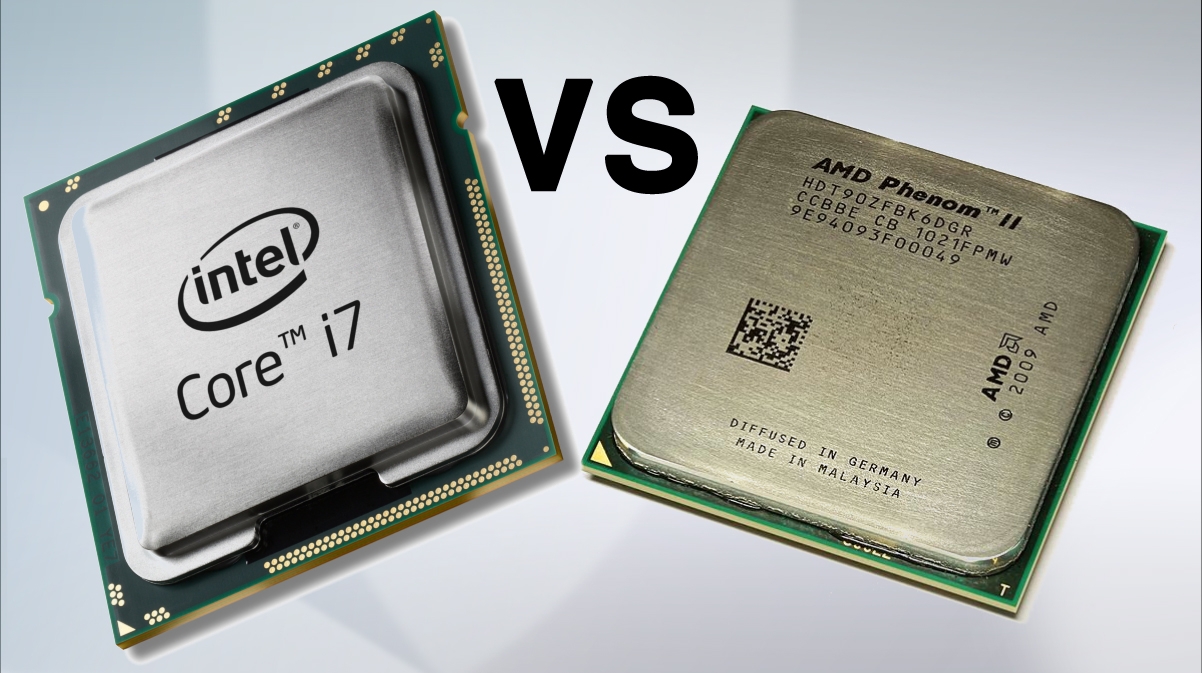
AMD vs Intel: which chipmaker does processors better?
There are a lot of moving parts when it comes to PC upkeep, and it only gets more onerous once you’ve reached the point where it’s time for an upgrade.
On the bright side, building and maintaining a PC comes down to little more than a basic understanding of how one works. Among the most important parts of a computer is the CPU, otherwise known as its processor.
If the motherboard is the PC’s skeleton, the CPU is the brains of the operation. Finding the best processor for your needs is a bit tougher than simply declaring you’re a fan of Intel or AMD.
Because there are stark differences in the chips produced by these two companies, whose efforts combined would dominate the entire computer processor market, it’s important to be aware of the nuances each brings to the table.
Like the war waging in the graphics cards space between Nvidia and AMD, the rivalry of AMD vs Intel is a ruthless competition between two brands that quite honestly have an equal number of perks and disadvantages. It’s just that AMD is playing catch up to Intel – a name that went virtually unchallenged for years.
Despite their lack of widespread availability, Intel’s Coffee Lake processors are thriving in the laptop space. At the same time, AMD has merely just gotten started. On the other hand, AMD’s Ryzen chips for high-performance desktop PCs have been met with overwhelmingly positive reception, both commercially and critically.
For those readers curious as to why that is, keep reading to find out the pros and cons of using AMD vs Intel and vice versa.
Whether you go for Intel or AMD, these are the best PC games
Gary Marshall originally contributed to this article
For bargain shoppers on the prowl for the next hottest deal, it used to be a widely debatable misconception that AMD’s processors were cheaper, but that was only because the red team did its best work at the entry level.
Now that Ryzen processors have proven AMD’s worth on the high-end, the tide has ostensibly turned. Now Intel reigns supreme in the budget CPU space, with its $97 (£80, AU$75) Pentium G4560 offering far better performance than AMD’s $94 (£85, £148) A12-9800.
Much of this is due to the Advanced Micro Device company’s reluctance to move beyond simply iterating on its antiquated Bulldozer architecture and onto adopting the current-generation “Zen” standard it’s already introduced with pricier CPUs.
Still, on the low end, Intel and AMD processors typically retail at about the same price. It’s once you hit that exorbitant $200 mark where things get trickier. High-end Intel chips now range from 4 up to 18 cores, while AMD chips can now be found with up to 16 cores.
While it was long-rumored that AMD’s Ryzen chips would offer cutting-edge performance at a lower price, benchmarks have demonstrated that Intel is remaining strongly competitive.
If you can get your hands on one, the Core i7-8700K is $359 (£265, AU$450), while the still-less capable Ryzen 7 1800X is priced at $499 (about £391, AU$662).
With that in mind, CPU pricing fluctuates constantly. Wait a few months, and you'll soon discover that the Ryzen 5 1600X – which is mysteriously showing up in 8-core variants now – you were eyeing has dropped well below market value. However, we understand patience is a virtue easier said than followed, so we wouldn’t blame you for procuring one right now.
If you want the best of the best performance with little regard for price, then turn your head towards Intel.
Not only does the Santa Clara chipmaker rank consistently (albeit only slightly) better in CPU benchmarks, but Intel's processors draw less heat as well, blessing them with lower TDP (thermal design point) ratings – and thus power consumption – across the board.
Much of this is owed to Intel's implementation of hyper-threading, which has been incorporated in its CPUs since 2002. Hyper-threading keeps existing cores active rather than letting any of them remain unproductive.
Even though AMD has implemented simultaneous multi-threading (SMT) in its Ryzen processors, Intel has – for the most part – maintained its place on top in performance benches.
Historically, however, AMD has taken pride in its focus on increasing the number of cores in its chips. On paper, this would make AMD's chips faster than Intel's, save for the impact on heat dissipation and lower clock speeds.
Luckily, the newer Ryzen chips have mitigated a lot of the overheating concerns of the past, so long as you have a decent cooling rig attached.
While it’s not hard to keep an Intel processor cool, because AMD likes to shove as many cores as possible into its silicon, the chips tend to run hotter, meaning you’ll probably have to invest in one of the best CPU coolers to avoid throttling.
Still, $249 (about £194, $330) for a six-core processor is unparalleled, even if the extra cores are only really beneficial in multi-tasking scenarios like streaming gameplay on Twitch.
There’s a huge pool of Twitch broadcasters alone that might find AMD’s Ryzen-series processors more appealing than Intel’s Kaby Lake, although Coffee Lake presents a compelling counterpoint to that argument.
Now that the Santa Clara company’s own consumer range of desktop-class Core i processors start out with four cores and go all the way up to six, mega-taskers might be tempted by Intel. While it and AMD have loosely achieved performance parity, the battle is now ostensibly over whose chips can do more at once rather than which can do one thing the fastest.
If you're building a gaming PC, truthfully you should be using a discrete graphics card, or GPU (graphics processing unit), rather than relying on a CPU’s integrated graphics to run games as demanding as Middle Earth: Shadow of War.
Still, it’s possible to run less graphics-intensive games, particularly of the free-to-play variety, on a processor’s built-in graphics if it has them. In this area, Intel is the clear winner, considering not a single Ryzen chip on the market will work without a graphics card, either from AMD itself or from its competitor Nvidia.
It doesn’t appear as though this is set to change any time soon, at least on desktops, but with laptops it’s a different story. Not only is AMD going to have onboard Vega graphics soon enough, but Intel might even start using its competitor’s video technology upon the release of its Coffee Lake-H and Cannon Lake-Y processors due next year.
Be that as it may, if all you're looking to do is play League of Legends at modest settings or relive your childhood with a hard drive full of emulators (it's okay, we won't tell), the latest Intel Kaby Lake, Coffee Lake or AMD A-Series APU processors will likely fare just as well as any top-end graphics card.
On the high end, such as in cases where you'll be pairing your CPU with a powerful AMD or Nvidia GPU, Intel’s processors are typically better for gaming due to their higher base and boost clock speeds. At the same time, though, AMD provides better CPUs for multi-tasking as a result of their higher core and thread counts.
While there is no clear winner in the graphics department, survey says AMD is the better option for integrated graphics (for now), while hardcore gamers who don’t mind shelling out the extra cash for a GPU will find that Intel is better for gaming alone, whereas AMD is superior for carrying out numerous tasks at once.
When you buy a new computer or even just a CPU by itself, it's typically locked at a specific clock speed as indicated on the box. Some processors ship unlocked, allowing for higher clock speeds than recommended by the manufacturer, giving users more control over how they use their components (though, it does require you know how to overclock).
AMD is normally more generous than Intel in this regard. With an AMD system, you can expect overclocking capabilities from even the $149 (about £100, AU$160) Ryzen 3 1300X. Meanwhile, you can only overclock an Intel processor if it's graced with the “K” series stamp of approval. Then again, the cheapest of these is the $149 (£133, AU$195) Intel Core i3-7350K.
Both companies will void your warranty if you brick your processor as the result of overclocking, though, so it’s important to watch out for that. Excessive amounts of heat can be generated if you’re not careful, thereby neutralizing the CPU as a result. With that in mind, you’ll be missing out on a few hundred stock megahertz if you skip out on one of the K models.
Intel’s more extravagant K-stamped chips are pretty impressive, too. The i7-8700K, for instance, is capable of maintaining a 4.7GHz turbo frequency in comparison to the 4.2GHz boost frequency of the Ryzen 7 1800X. If you’ve access to liquid nitrogen cooling, you may even be able to reach upwards of 6.1GHz using Intel’s monstrous, 18-core i9-7980XE.
In the end, the biggest problem with AMD processors is the lack of compatibility with other components. Specifically, motherboard (mobo) and cooler options are limited as a result of the differing sockets between AMD and Intel chips.
While a lot of CPU coolers demand that you special order an AM4 bracket to be used with Ryzen, only a handful of the best motherboards are compatible with the AM4 chipset. In that regard, Intel parts are slightly more commonplace and are often accompanied by lower starting costs, too, as a result of the wide variety of kit to choose from.
That said, AMD's chips make a little more sense from a hardware design perspective. With an AMD motherboard, rather than having metal connector pins on the CPU socket, you'll notice those pins are instead on the underside of the CPU itself. In turn, the mobo is less likely to malfunction due to its own faulty pins.
As for processor availability, AMD’s latest are much easier to come by right now than Intel’s, likely because of a manufacturing shortage. The Coffee Lake-S chips that released on October 5 can only be widely found on backorder, as of this writing. Meanwhile, brick-and-mortar retailers like Micro Center are notoriously selling the chips for substantially more than the manufacturer suggests.
Nevertheless, deciding on a CPU is ultimately up to personal preference. Where an Intel processor shines most when married to a graphics card, AMD's chips are surprisingly capable without a discrete GPU. Well, that’s at least the case when we’re referring to its APUs, not the ones called Ryzen.
On the bright side, building and maintaining a PC comes down to little more than a basic understanding of how one works. Among the most important parts of a computer is the CPU, otherwise known as its processor.
If the motherboard is the PC’s skeleton, the CPU is the brains of the operation. Finding the best processor for your needs is a bit tougher than simply declaring you’re a fan of Intel or AMD.
Because there are stark differences in the chips produced by these two companies, whose efforts combined would dominate the entire computer processor market, it’s important to be aware of the nuances each brings to the table.
Like the war waging in the graphics cards space between Nvidia and AMD, the rivalry of AMD vs Intel is a ruthless competition between two brands that quite honestly have an equal number of perks and disadvantages. It’s just that AMD is playing catch up to Intel – a name that went virtually unchallenged for years.
Despite their lack of widespread availability, Intel’s Coffee Lake processors are thriving in the laptop space. At the same time, AMD has merely just gotten started. On the other hand, AMD’s Ryzen chips for high-performance desktop PCs have been met with overwhelmingly positive reception, both commercially and critically.
For those readers curious as to why that is, keep reading to find out the pros and cons of using AMD vs Intel and vice versa.
Whether you go for Intel or AMD, these are the best PC games
Gary Marshall originally contributed to this article
For bargain shoppers on the prowl for the next hottest deal, it used to be a widely debatable misconception that AMD’s processors were cheaper, but that was only because the red team did its best work at the entry level.
Now that Ryzen processors have proven AMD’s worth on the high-end, the tide has ostensibly turned. Now Intel reigns supreme in the budget CPU space, with its $97 (£80, AU$75) Pentium G4560 offering far better performance than AMD’s $94 (£85, £148) A12-9800.
Much of this is due to the Advanced Micro Device company’s reluctance to move beyond simply iterating on its antiquated Bulldozer architecture and onto adopting the current-generation “Zen” standard it’s already introduced with pricier CPUs.
Still, on the low end, Intel and AMD processors typically retail at about the same price. It’s once you hit that exorbitant $200 mark where things get trickier. High-end Intel chips now range from 4 up to 18 cores, while AMD chips can now be found with up to 16 cores.
While it was long-rumored that AMD’s Ryzen chips would offer cutting-edge performance at a lower price, benchmarks have demonstrated that Intel is remaining strongly competitive.
If you can get your hands on one, the Core i7-8700K is $359 (£265, AU$450), while the still-less capable Ryzen 7 1800X is priced at $499 (about £391, AU$662).
With that in mind, CPU pricing fluctuates constantly. Wait a few months, and you'll soon discover that the Ryzen 5 1600X – which is mysteriously showing up in 8-core variants now – you were eyeing has dropped well below market value. However, we understand patience is a virtue easier said than followed, so we wouldn’t blame you for procuring one right now.
If you want the best of the best performance with little regard for price, then turn your head towards Intel.
Not only does the Santa Clara chipmaker rank consistently (albeit only slightly) better in CPU benchmarks, but Intel's processors draw less heat as well, blessing them with lower TDP (thermal design point) ratings – and thus power consumption – across the board.
Much of this is owed to Intel's implementation of hyper-threading, which has been incorporated in its CPUs since 2002. Hyper-threading keeps existing cores active rather than letting any of them remain unproductive.
Even though AMD has implemented simultaneous multi-threading (SMT) in its Ryzen processors, Intel has – for the most part – maintained its place on top in performance benches.
Historically, however, AMD has taken pride in its focus on increasing the number of cores in its chips. On paper, this would make AMD's chips faster than Intel's, save for the impact on heat dissipation and lower clock speeds.
Luckily, the newer Ryzen chips have mitigated a lot of the overheating concerns of the past, so long as you have a decent cooling rig attached.
While it’s not hard to keep an Intel processor cool, because AMD likes to shove as many cores as possible into its silicon, the chips tend to run hotter, meaning you’ll probably have to invest in one of the best CPU coolers to avoid throttling.
Still, $249 (about £194, $330) for a six-core processor is unparalleled, even if the extra cores are only really beneficial in multi-tasking scenarios like streaming gameplay on Twitch.
There’s a huge pool of Twitch broadcasters alone that might find AMD’s Ryzen-series processors more appealing than Intel’s Kaby Lake, although Coffee Lake presents a compelling counterpoint to that argument.
Now that the Santa Clara company’s own consumer range of desktop-class Core i processors start out with four cores and go all the way up to six, mega-taskers might be tempted by Intel. While it and AMD have loosely achieved performance parity, the battle is now ostensibly over whose chips can do more at once rather than which can do one thing the fastest.
If you're building a gaming PC, truthfully you should be using a discrete graphics card, or GPU (graphics processing unit), rather than relying on a CPU’s integrated graphics to run games as demanding as Middle Earth: Shadow of War.
Still, it’s possible to run less graphics-intensive games, particularly of the free-to-play variety, on a processor’s built-in graphics if it has them. In this area, Intel is the clear winner, considering not a single Ryzen chip on the market will work without a graphics card, either from AMD itself or from its competitor Nvidia.
It doesn’t appear as though this is set to change any time soon, at least on desktops, but with laptops it’s a different story. Not only is AMD going to have onboard Vega graphics soon enough, but Intel might even start using its competitor’s video technology upon the release of its Coffee Lake-H and Cannon Lake-Y processors due next year.
Be that as it may, if all you're looking to do is play League of Legends at modest settings or relive your childhood with a hard drive full of emulators (it's okay, we won't tell), the latest Intel Kaby Lake, Coffee Lake or AMD A-Series APU processors will likely fare just as well as any top-end graphics card.
On the high end, such as in cases where you'll be pairing your CPU with a powerful AMD or Nvidia GPU, Intel’s processors are typically better for gaming due to their higher base and boost clock speeds. At the same time, though, AMD provides better CPUs for multi-tasking as a result of their higher core and thread counts.
While there is no clear winner in the graphics department, survey says AMD is the better option for integrated graphics (for now), while hardcore gamers who don’t mind shelling out the extra cash for a GPU will find that Intel is better for gaming alone, whereas AMD is superior for carrying out numerous tasks at once.
When you buy a new computer or even just a CPU by itself, it's typically locked at a specific clock speed as indicated on the box. Some processors ship unlocked, allowing for higher clock speeds than recommended by the manufacturer, giving users more control over how they use their components (though, it does require you know how to overclock).
AMD is normally more generous than Intel in this regard. With an AMD system, you can expect overclocking capabilities from even the $149 (about £100, AU$160) Ryzen 3 1300X. Meanwhile, you can only overclock an Intel processor if it's graced with the “K” series stamp of approval. Then again, the cheapest of these is the $149 (£133, AU$195) Intel Core i3-7350K.
Both companies will void your warranty if you brick your processor as the result of overclocking, though, so it’s important to watch out for that. Excessive amounts of heat can be generated if you’re not careful, thereby neutralizing the CPU as a result. With that in mind, you’ll be missing out on a few hundred stock megahertz if you skip out on one of the K models.
Intel’s more extravagant K-stamped chips are pretty impressive, too. The i7-8700K, for instance, is capable of maintaining a 4.7GHz turbo frequency in comparison to the 4.2GHz boost frequency of the Ryzen 7 1800X. If you’ve access to liquid nitrogen cooling, you may even be able to reach upwards of 6.1GHz using Intel’s monstrous, 18-core i9-7980XE.
In the end, the biggest problem with AMD processors is the lack of compatibility with other components. Specifically, motherboard (mobo) and cooler options are limited as a result of the differing sockets between AMD and Intel chips.
While a lot of CPU coolers demand that you special order an AM4 bracket to be used with Ryzen, only a handful of the best motherboards are compatible with the AM4 chipset. In that regard, Intel parts are slightly more commonplace and are often accompanied by lower starting costs, too, as a result of the wide variety of kit to choose from.
That said, AMD's chips make a little more sense from a hardware design perspective. With an AMD motherboard, rather than having metal connector pins on the CPU socket, you'll notice those pins are instead on the underside of the CPU itself. In turn, the mobo is less likely to malfunction due to its own faulty pins.
As for processor availability, AMD’s latest are much easier to come by right now than Intel’s, likely because of a manufacturing shortage. The Coffee Lake-S chips that released on October 5 can only be widely found on backorder, as of this writing. Meanwhile, brick-and-mortar retailers like Micro Center are notoriously selling the chips for substantially more than the manufacturer suggests.
Nevertheless, deciding on a CPU is ultimately up to personal preference. Where an Intel processor shines most when married to a graphics card, AMD's chips are surprisingly capable without a discrete GPU. Well, that’s at least the case when we’re referring to its APUs, not the ones called Ryzen.
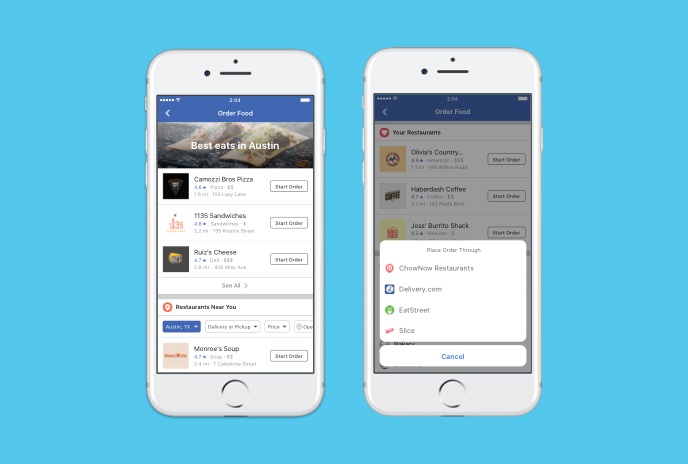
Now you can order food without ever leaving Facebook
Facebook really wants to make sure you never leave its site, and to that end, it’s now offering a service that lets you order food through the app or website itself. This extends to both takeout and delivery.
But rather than competing with similar online services such as GrubHub, it’s merely partnering with some of them, including Delivery.com, DoorDash, ChowNow, Olo, Zuppler, and Slice.
That means that when you click on the new “Order Food” tab under Explore, you’ll find listings for local eateries. Click on “Start Order” for your preferred restaurant, and you’ll then visit your preferred existing service — such as Delivery.com — and order through there.
Nor is Facebook just partnering with delivery and takeout aggregators. If you’re craving something from a nationally recognized chain such as Chipotle, Jimmy John’s, Five Guys, Jack in the Box, Papa John's, Panera, El Pollo Loco, TGI Friday's, Denny's, or Wingstop, you’ll order your food through their own portals.
In essence, Facebook’s main role is cutting out the step of actively visiting another app or website apart from Facebook to make a food order.
It’s still slightly inconvenient because you end up visiting the external site anyway, but at least Facebook isn't just trying to make the concept its own and put its smaller competitors out of business, right?
Facebook already rolled out the service to a limited number of customers earlier this year, but today marks the first time it’s been widely available in the US.
Like and share
“We've been testing this since last year, and after responding to feedback and adding more partners, we're rolling out everywhere in the US on iOS, Android and desktop,” said Alex Himel, Facebook’s VP of local, in the official announcement. “People already go to Facebook to browse restaurants and decide where to eat or where to order food, so we're making that easier.”
Facebook makes no money off of the service, according to TechCrunch. It's apparently an act of sheer goodwill (and keeping you within the app and seeing Facebook's own ads). Facebook charges the partners no fees, and it doesn't receive any profits on orders made through "Order Food."
Get ready to order loads of goods on Black Friday
But rather than competing with similar online services such as GrubHub, it’s merely partnering with some of them, including Delivery.com, DoorDash, ChowNow, Olo, Zuppler, and Slice.
That means that when you click on the new “Order Food” tab under Explore, you’ll find listings for local eateries. Click on “Start Order” for your preferred restaurant, and you’ll then visit your preferred existing service — such as Delivery.com — and order through there.
Nor is Facebook just partnering with delivery and takeout aggregators. If you’re craving something from a nationally recognized chain such as Chipotle, Jimmy John’s, Five Guys, Jack in the Box, Papa John's, Panera, El Pollo Loco, TGI Friday's, Denny's, or Wingstop, you’ll order your food through their own portals.
In essence, Facebook’s main role is cutting out the step of actively visiting another app or website apart from Facebook to make a food order.
It’s still slightly inconvenient because you end up visiting the external site anyway, but at least Facebook isn't just trying to make the concept its own and put its smaller competitors out of business, right?
Facebook already rolled out the service to a limited number of customers earlier this year, but today marks the first time it’s been widely available in the US.
Like and share
“We've been testing this since last year, and after responding to feedback and adding more partners, we're rolling out everywhere in the US on iOS, Android and desktop,” said Alex Himel, Facebook’s VP of local, in the official announcement. “People already go to Facebook to browse restaurants and decide where to eat or where to order food, so we're making that easier.”
Facebook makes no money off of the service, according to TechCrunch. It's apparently an act of sheer goodwill (and keeping you within the app and seeing Facebook's own ads). Facebook charges the partners no fees, and it doesn't receive any profits on orders made through "Order Food."
Get ready to order loads of goods on Black Friday
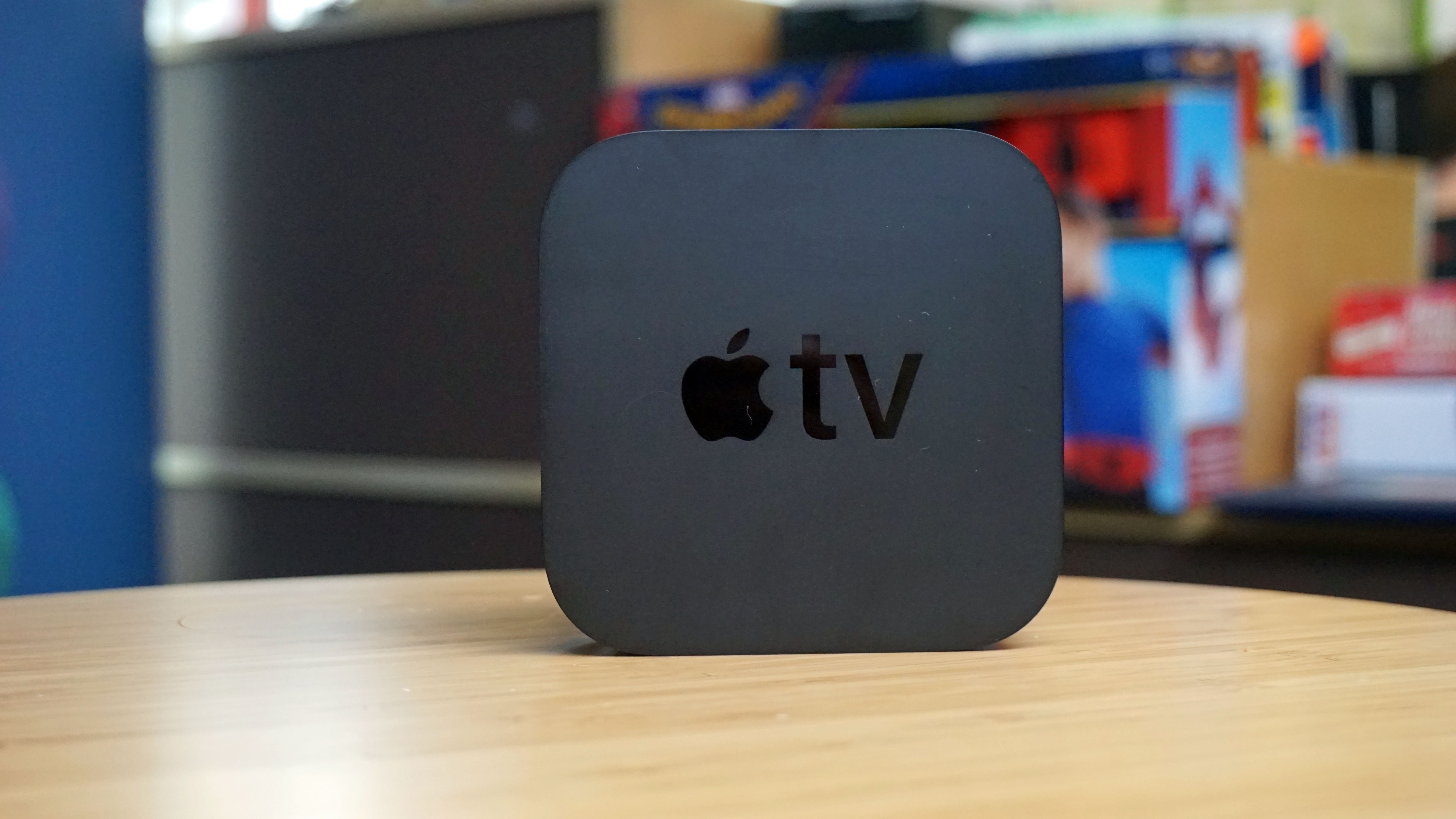
Amazon Prime Video app will come to Apple TV on October 26, rumor claims
Apple said months ago that an Amazon Prime Video app would be coming to the Apple TV “later this year,” but the entire summer went by without it ever showing up.
Now, though, MacRumors has spotted a sketchy rumor that’s being spread by a Reddit commenter going by the name of “AmazonVideoEngineer,” who claims we’ll finally see the Prime Video app hit Apple’s set-top box on October 26.
“Some of you will remember my post a little while back, in which I warned that Amazon would not launch until at least October 26,” AmazonVideoEngineer said. “We're now just about two weeks from the 26th, and the app is still on track to launch that day. In my time at this job, I have never once seen a release slip this close to a scheduled launch. I am very confident in saying that the 26th is finally the day.”
Two weeks ago, the same commenter claimed in his or her first post that Amazon had already finished the app long ago, but that “a lot of politics” between Apple and Amazon were preventing it from getting to us.
Apples and oranges
That scenario seems likely, as Amazon and Apple (and Google) already got into a tussle a couple of years back when Amazon stopped selling the Apple TV (and Google Chromecast) in what it called an effort to prevent “confusion” among customers.
The Apple TV 4K briefly made an appearance on Amazon a couple of weeks ago, but was banished again almost as soon as it appeared.
Even so, it’s still probably wise to take all this with a grain of salt since there’s little proof AmazonVideoEngineer is what he or she claims to be. And, of course, there's a chance those "politics" could still get in the way even if it is true.
The absence of Amazon Prme Video has long been one of the main complaints about the Apple TV from customers, particularly since Amazon now tends to offer a larger library of well-known movies and TV shows than competitor Netflix.
Will Apple put Apple TV 4K on sale for Black Friday 2017? It's possible!
Now, though, MacRumors has spotted a sketchy rumor that’s being spread by a Reddit commenter going by the name of “AmazonVideoEngineer,” who claims we’ll finally see the Prime Video app hit Apple’s set-top box on October 26.
“Some of you will remember my post a little while back, in which I warned that Amazon would not launch until at least October 26,” AmazonVideoEngineer said. “We're now just about two weeks from the 26th, and the app is still on track to launch that day. In my time at this job, I have never once seen a release slip this close to a scheduled launch. I am very confident in saying that the 26th is finally the day.”
Two weeks ago, the same commenter claimed in his or her first post that Amazon had already finished the app long ago, but that “a lot of politics” between Apple and Amazon were preventing it from getting to us.
Apples and oranges
That scenario seems likely, as Amazon and Apple (and Google) already got into a tussle a couple of years back when Amazon stopped selling the Apple TV (and Google Chromecast) in what it called an effort to prevent “confusion” among customers.
The Apple TV 4K briefly made an appearance on Amazon a couple of weeks ago, but was banished again almost as soon as it appeared.
Even so, it’s still probably wise to take all this with a grain of salt since there’s little proof AmazonVideoEngineer is what he or she claims to be. And, of course, there's a chance those "politics" could still get in the way even if it is true.
The absence of Amazon Prme Video has long been one of the main complaints about the Apple TV from customers, particularly since Amazon now tends to offer a larger library of well-known movies and TV shows than competitor Netflix.
Will Apple put Apple TV 4K on sale for Black Friday 2017? It's possible!
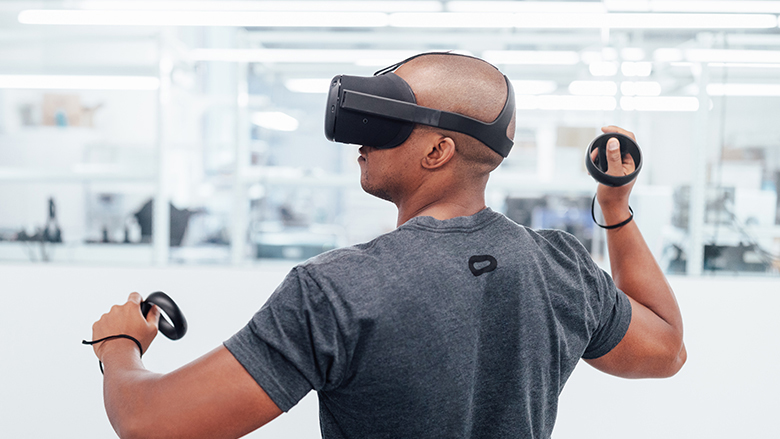
Project Santa Cruz: Everything you need to know about the Oculus standalone headset
Update: We've now gotten a chance to try the Project Santa Cruz prototype for ourselves, and we are quite impressed with its capabilities. We're most taken with the freedom of movement it offers, but price remains a big question mark.
Don't miss our hands on Project Santa Cruz review!
Read on for more on Project Santa Cruz...
Facebook-owned Oculus is pushing the boundaries of virtual reality once again. The company has taken the wraps off of its latest and greatest headset, titled Project Santa Cruz, which is aimed at bringing the experience of PC-quality virtual reality to an untethered headset.
That’s a pretty big deal for VR. While mobile virtual reality experiences like Google Daydream and the Samsung Gear VR bring VR to the masses with smartphones, the best-quality virtual reality remains tethered to a computer of some kind. Project Santa Cruz looks to change that.
There’s some serious tech under the hood that enables for this untethered experience, such as, for example, the sensors and trackers. Project Santa Cruz boasts four wide-angle lenses that track both the controllers and your hands. It tracks everything around your head, and even some stuff behind you - which should allow for much more immersive content.
Oculus has had a long road in developing this headset, and this isn’t actually the first time we’ve heard of it. The company first announced it was working on an untethered headset in 2016, but it wasn’t until Oculus Connect 4 that Facebook CEO Mark Zuckerberg took to the stage to show off a revised and apparently fully-functioning version of the headset.
But when can you get your hands on the standalone headset for yourself? And what should you expect it to be able to do? Here’s everything you need to know about the new Oculus Project Santa Cruz virtual reality headset.
Cut to the chase What is it? A high-end standalone virtual reality headset from OculusWhen is it out? No consumer release date yet, but Project Santa Cruz ships to developers in early 2018How much does it cost? No price yet, but it will likely be more expensive than Oculus Rift Project Santa Cruz release date and price
Unfortunately, it may be a while before the consumer Project Santa Cruz release date, but developers can start tinkering with it in “early 2018.”
There’s no specific ship date beyond that, so it could be six months or so before developers finally get their hands on it.
That doesn’t mean the general consumer will be able to start buying the headset then - it’ll likely be awhile before the headset is released to the public, especially given Oculus’ track record.
The first Oculus Rift developer kit shipped in 2012, with the second coming in 2014. It wasn’t until early January 2016 that pre-orders opened to the general public. Now, that doesn’t mean that we should expect to have to wait four years for consumer availability. Oculus has grown a lot, and is now owned by Facebook. The company is working to make VR accessible, with an aim to get 1 billion people into VR, and it’s possible that we could even see consumer availability before the end of 2018.
But what about price? That’s something we don’t know yet. The also-new, also-standalone Oculus Go costs $199 in the US, while the Oculus Rift is $399.
Given that Project Santa Cruz is the company’s new flagship VR offering, it’s possible that it could simply replace the Rift at the latter's $499 price point. Because of all the new tech, however, it’s also totally possible that Project Santa Cruz will be even more expensive than the Rift - we’ll just have to wait and see.
Project Santa Cruz features
Project Santa Cruz was first unveiled back in 2016, but at the time it was less refined. As you can see from the image below, it basically involved a tiny computer strapped to the back of your head. Now, all that tech has made its way into the headset itself.

Perhaps the biggest new feature is inside-out tracking, which involves putting all the sensors inside the headset rather than having to place cameras and sensors around you. That’s all thanks to the four wide-angle lenses and on-board processing, which can track your hand movements - and controller movements - in real time.
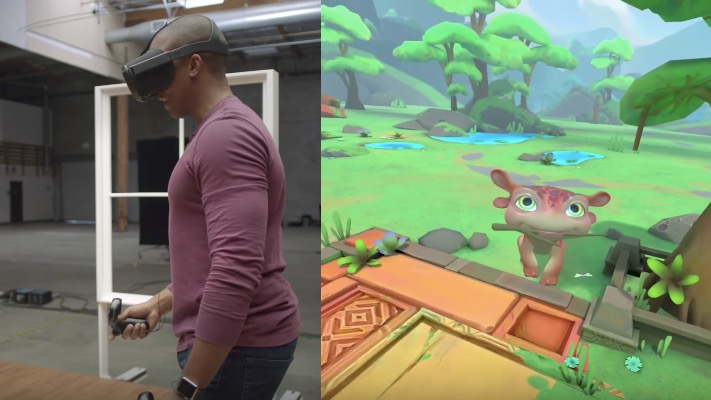
How does the headset track the controllers so accurately? We’ll dive into the hardware inside the controllers in the next section, but it essentially involves the use of tiny infrared LEDs, which is the point controlled by the camera.
Those cameras can continue to track even when the controllers are above the user’s head. This is a notable difference between this headset and Microsoft’s HoloLens design.
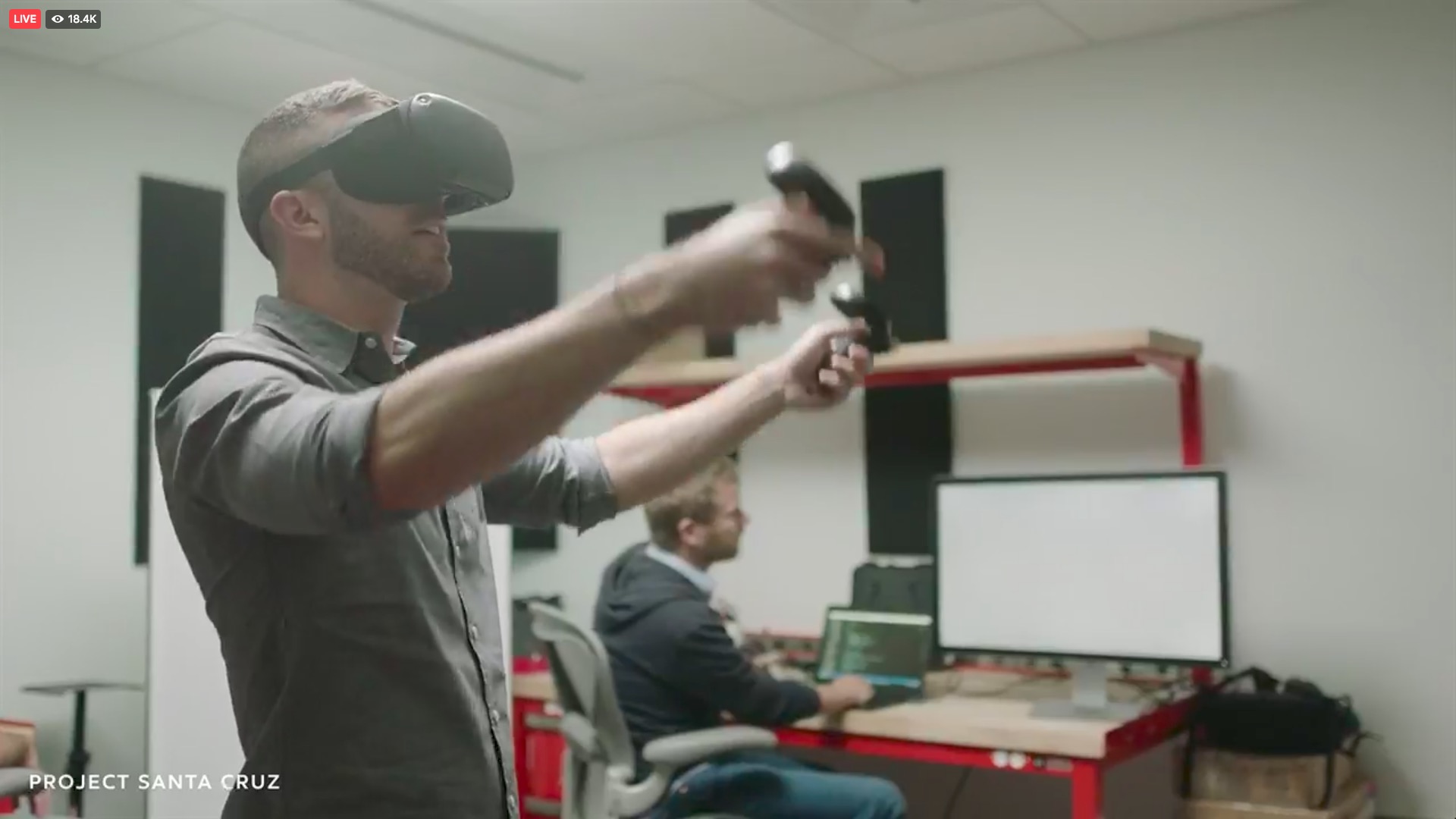
The result of all of this tech is that magic six degrees of freedom (6DOF), or the ability to move forward and back, side to side, and up and down in a virtual space. That’s something not all virtual reality headsets offer - especially mobile offerings like Daydream and Gear VR, which rely on smartphones to work.
A lot about Project Santa Cruz is still unknown. For starters, we don’t know the computing specs of the headset. It's basically a computer in and of itself, so it will need a processor, RAM, and storage,just like any other computer.
Perhaps equally important is battery life. Virtual reality can seriously tax a battery, but with a tethered headset that isn’t a concern. It would be surprising to see an untethered headset that can last more than a few hours, but we’ll obviously have to wait and see what Santa Cruz has to offer.
Project Santa Cruz controllers
A big part of the Oculus Project Santa Cruz puzzle is the controllers, and while they are similar to the current Touch controllers, there are a few notable differences. For starters, the controllers feature tiny infrared LEDs, which are tracked by the cameras in the headset.
Apart from that, the Project Santa Cruz controller experience remains much the same.
The controllers still offer a pointer-accessible trigger button, along with a grip button on the side. That’s good news for those that are used to the existing Touch controllers, as it means that they won’t need to get acquainted with a new layout.
Amazon deals on Black Friday should include plenty of VR savings
Don't miss our hands on Project Santa Cruz review!
Read on for more on Project Santa Cruz...
Facebook-owned Oculus is pushing the boundaries of virtual reality once again. The company has taken the wraps off of its latest and greatest headset, titled Project Santa Cruz, which is aimed at bringing the experience of PC-quality virtual reality to an untethered headset.
That’s a pretty big deal for VR. While mobile virtual reality experiences like Google Daydream and the Samsung Gear VR bring VR to the masses with smartphones, the best-quality virtual reality remains tethered to a computer of some kind. Project Santa Cruz looks to change that.
There’s some serious tech under the hood that enables for this untethered experience, such as, for example, the sensors and trackers. Project Santa Cruz boasts four wide-angle lenses that track both the controllers and your hands. It tracks everything around your head, and even some stuff behind you - which should allow for much more immersive content.
Oculus has had a long road in developing this headset, and this isn’t actually the first time we’ve heard of it. The company first announced it was working on an untethered headset in 2016, but it wasn’t until Oculus Connect 4 that Facebook CEO Mark Zuckerberg took to the stage to show off a revised and apparently fully-functioning version of the headset.
But when can you get your hands on the standalone headset for yourself? And what should you expect it to be able to do? Here’s everything you need to know about the new Oculus Project Santa Cruz virtual reality headset.
Cut to the chase What is it? A high-end standalone virtual reality headset from OculusWhen is it out? No consumer release date yet, but Project Santa Cruz ships to developers in early 2018How much does it cost? No price yet, but it will likely be more expensive than Oculus Rift Project Santa Cruz release date and price
Unfortunately, it may be a while before the consumer Project Santa Cruz release date, but developers can start tinkering with it in “early 2018.”
There’s no specific ship date beyond that, so it could be six months or so before developers finally get their hands on it.
That doesn’t mean the general consumer will be able to start buying the headset then - it’ll likely be awhile before the headset is released to the public, especially given Oculus’ track record.
The first Oculus Rift developer kit shipped in 2012, with the second coming in 2014. It wasn’t until early January 2016 that pre-orders opened to the general public. Now, that doesn’t mean that we should expect to have to wait four years for consumer availability. Oculus has grown a lot, and is now owned by Facebook. The company is working to make VR accessible, with an aim to get 1 billion people into VR, and it’s possible that we could even see consumer availability before the end of 2018.
But what about price? That’s something we don’t know yet. The also-new, also-standalone Oculus Go costs $199 in the US, while the Oculus Rift is $399.
Given that Project Santa Cruz is the company’s new flagship VR offering, it’s possible that it could simply replace the Rift at the latter's $499 price point. Because of all the new tech, however, it’s also totally possible that Project Santa Cruz will be even more expensive than the Rift - we’ll just have to wait and see.
Project Santa Cruz features
Project Santa Cruz was first unveiled back in 2016, but at the time it was less refined. As you can see from the image below, it basically involved a tiny computer strapped to the back of your head. Now, all that tech has made its way into the headset itself.

Perhaps the biggest new feature is inside-out tracking, which involves putting all the sensors inside the headset rather than having to place cameras and sensors around you. That’s all thanks to the four wide-angle lenses and on-board processing, which can track your hand movements - and controller movements - in real time.

How does the headset track the controllers so accurately? We’ll dive into the hardware inside the controllers in the next section, but it essentially involves the use of tiny infrared LEDs, which is the point controlled by the camera.
Those cameras can continue to track even when the controllers are above the user’s head. This is a notable difference between this headset and Microsoft’s HoloLens design.

The result of all of this tech is that magic six degrees of freedom (6DOF), or the ability to move forward and back, side to side, and up and down in a virtual space. That’s something not all virtual reality headsets offer - especially mobile offerings like Daydream and Gear VR, which rely on smartphones to work.
A lot about Project Santa Cruz is still unknown. For starters, we don’t know the computing specs of the headset. It's basically a computer in and of itself, so it will need a processor, RAM, and storage,just like any other computer.
Perhaps equally important is battery life. Virtual reality can seriously tax a battery, but with a tethered headset that isn’t a concern. It would be surprising to see an untethered headset that can last more than a few hours, but we’ll obviously have to wait and see what Santa Cruz has to offer.
Project Santa Cruz controllers
A big part of the Oculus Project Santa Cruz puzzle is the controllers, and while they are similar to the current Touch controllers, there are a few notable differences. For starters, the controllers feature tiny infrared LEDs, which are tracked by the cameras in the headset.
Apart from that, the Project Santa Cruz controller experience remains much the same.
The controllers still offer a pointer-accessible trigger button, along with a grip button on the side. That’s good news for those that are used to the existing Touch controllers, as it means that they won’t need to get acquainted with a new layout.
Amazon deals on Black Friday should include plenty of VR savings
Your article is very helpful. you can visit my website .
ReplyDeletexe currency apk
Nintendo switch Kuwait price
ReplyDeleteWelcome To AlFuhod Net game store, we are the best game store in Kuwait that provide the best game accessories in Kuwait, Saudi, Bahrain, Oman, Qatar and UAE. Now check our Nintendo switch game price and buy online.
to get more - https://alfuhod.com/
gaming pc price in Kuwait
ReplyDeleteWelcome To AlFuhod Net game store, we are the best game store in Kuwait that provide the best game accessories in Kuwait, Saudi, Bahrain, Oman, Qatar and UAE. Now check our Nintendo switch game price and buy online.
to get more - https://alfuhod.com/
wow fantastic app you can try USB Audio Player PRO Apk
ReplyDeleteDo you need an urgent loan of any kind? Loans to liquidate debts or need to loan to improve your business have you been rejected by any other banks and financial institutions? Do you need a loan or a mortgage? This is the place to look, we are here to solve all your financial problems. We borrow money for the public. Need financial help with a bad credit in need of money. To pay for a commercial investment at a reasonable rate of 3%, let me use this method to inform you that we are providing reliable and helpful assistance and we will be ready to lend you. Contact us today by email: daveloganloanfirm@gmail.com Call/Text: +1(501)800-0690 And whatsapp: +1 (315) 640-3560
ReplyDeleteNEED A LOAN?
Ask Me.
ReplyDeleteSimply put, Roku allows you to watch free and paid video content on your TV via the Internet.Roku is the number 1 streaming device that is popular in the United Kingdom and the United States.
roku.com/link
Must-Try This:-
ReplyDeleteAll Kinds Of VPN are Available Here:
TunnelBear VPN Crack
Hotspot Shield VPN
VPN Unlimited
HMA VPN Pro
Excellent post. I was checking constantly this blog and I’m impressed! Very useful information particularly the ultimate phase.I handle such info a lot. I used to be looking for this particular information for a very long time. Thanks and best of luck.…Comfy Partition Recovery Crack
ReplyDeleteYour style is so unique compared to other people I have read stuff from. Many thanks forposting when you have the opportunity, Guess I will just bookmark this site VovSoft Hide Files
ReplyDeleteI am very impressed with your post because this post is very beneficial for me and provide a new knowledge to me
ReplyDeletesoftcrack
softcrack
softcrack
softcrack
softcrack
gurucrack
gurucrack
gurucrack
gurucrack
gurucrack
I like your all post. You have done really good work. Thank you for the information you provide.
ReplyDeleteGetcrack.co
PhpStorm Crack
NordVPN Crack
PassFab For RAR Crack
FlixGrab Premium Crack
Drip Fx VST Crack
Wow, amazing block structure! How long
ReplyDeleteHave you written a blog before? Working on a blog seems easy.
The overview of your website is pretty good, not to mention what it does.
In the content!
vstpatch.net
VovSoft SEO Checker Crack
DVDFab Crack
Netflix Crack
Minitube Crack
Eventide Anthology XI Bundle Crack